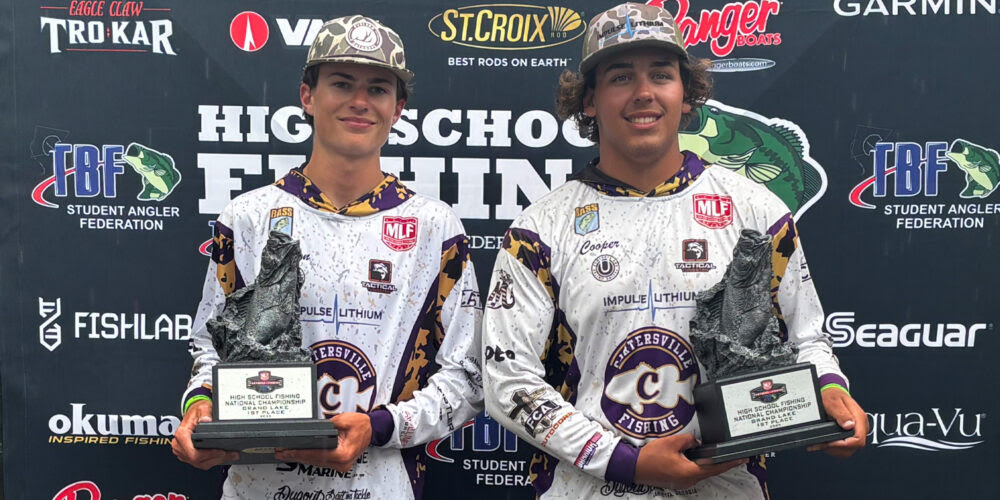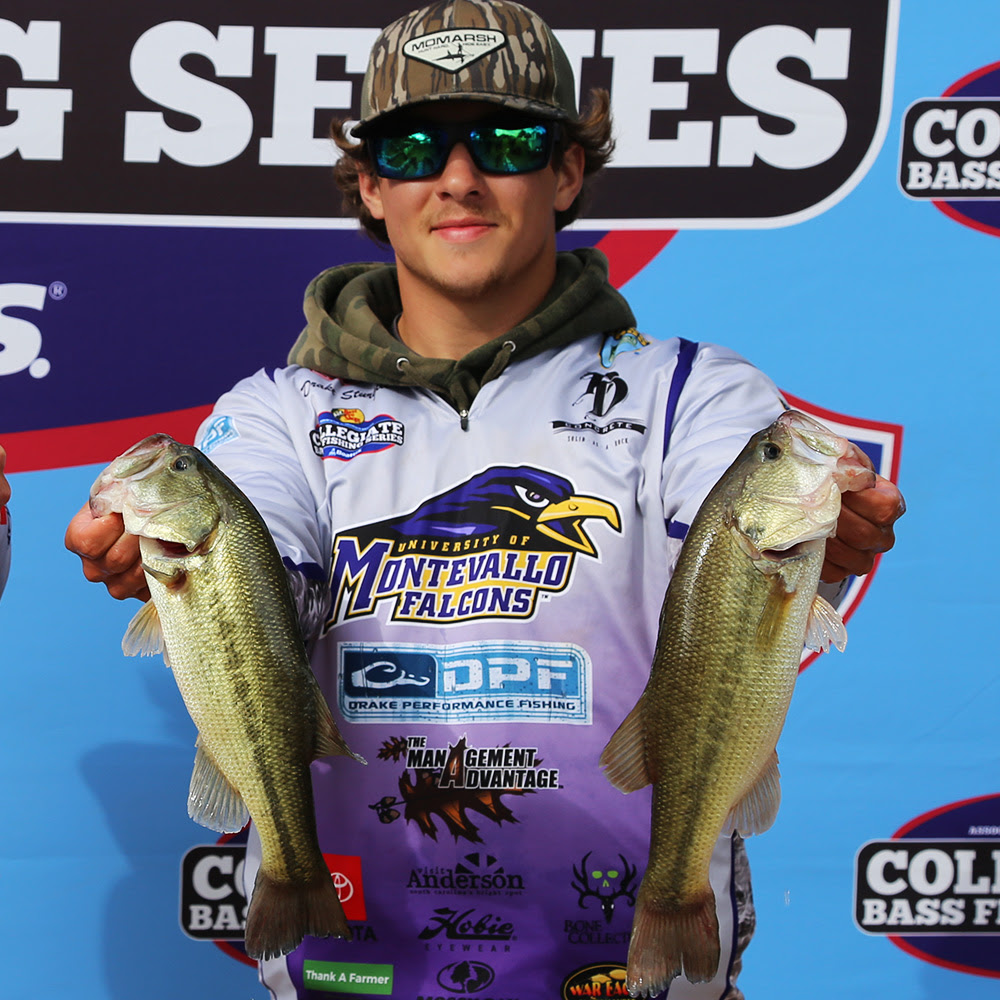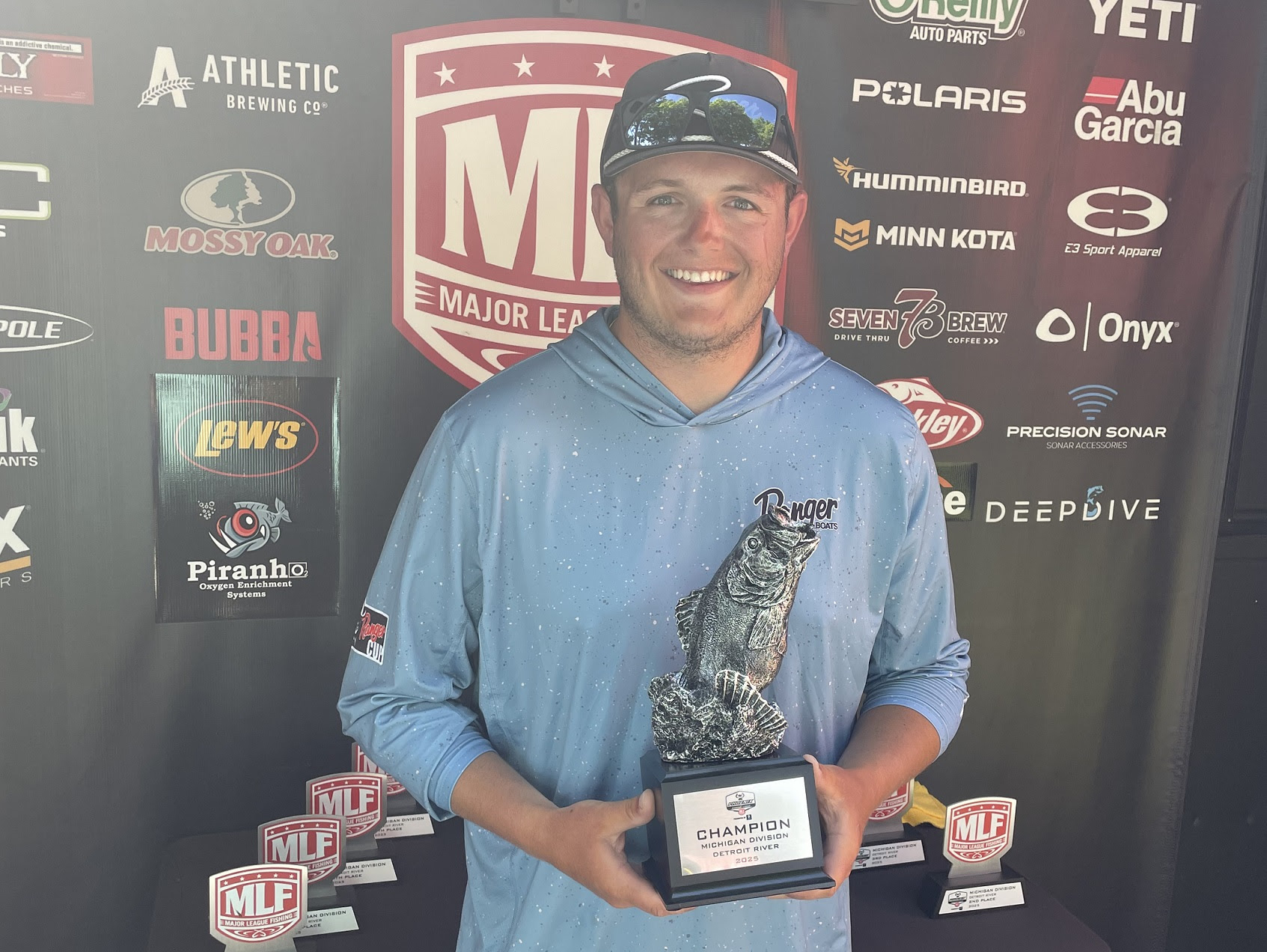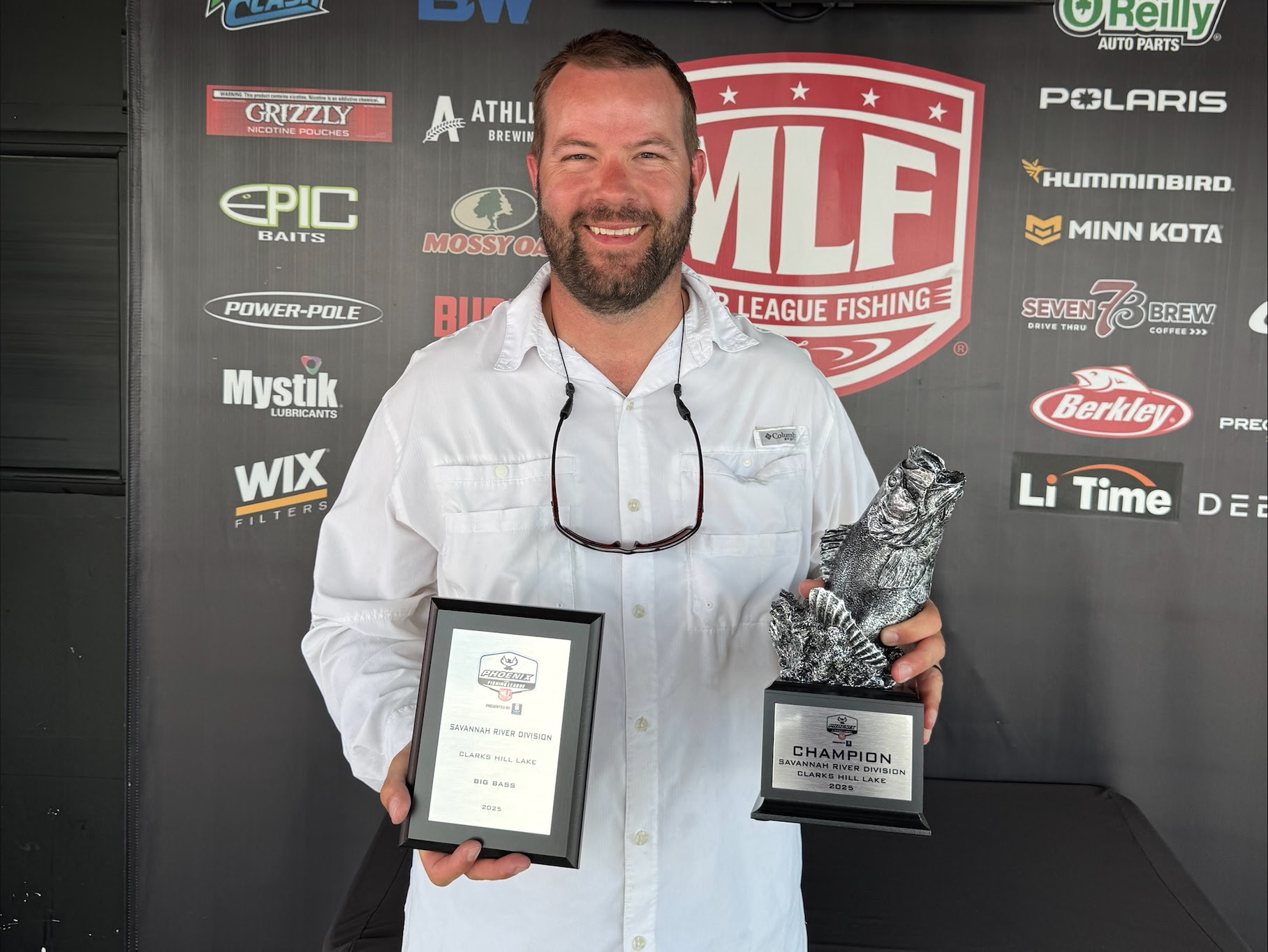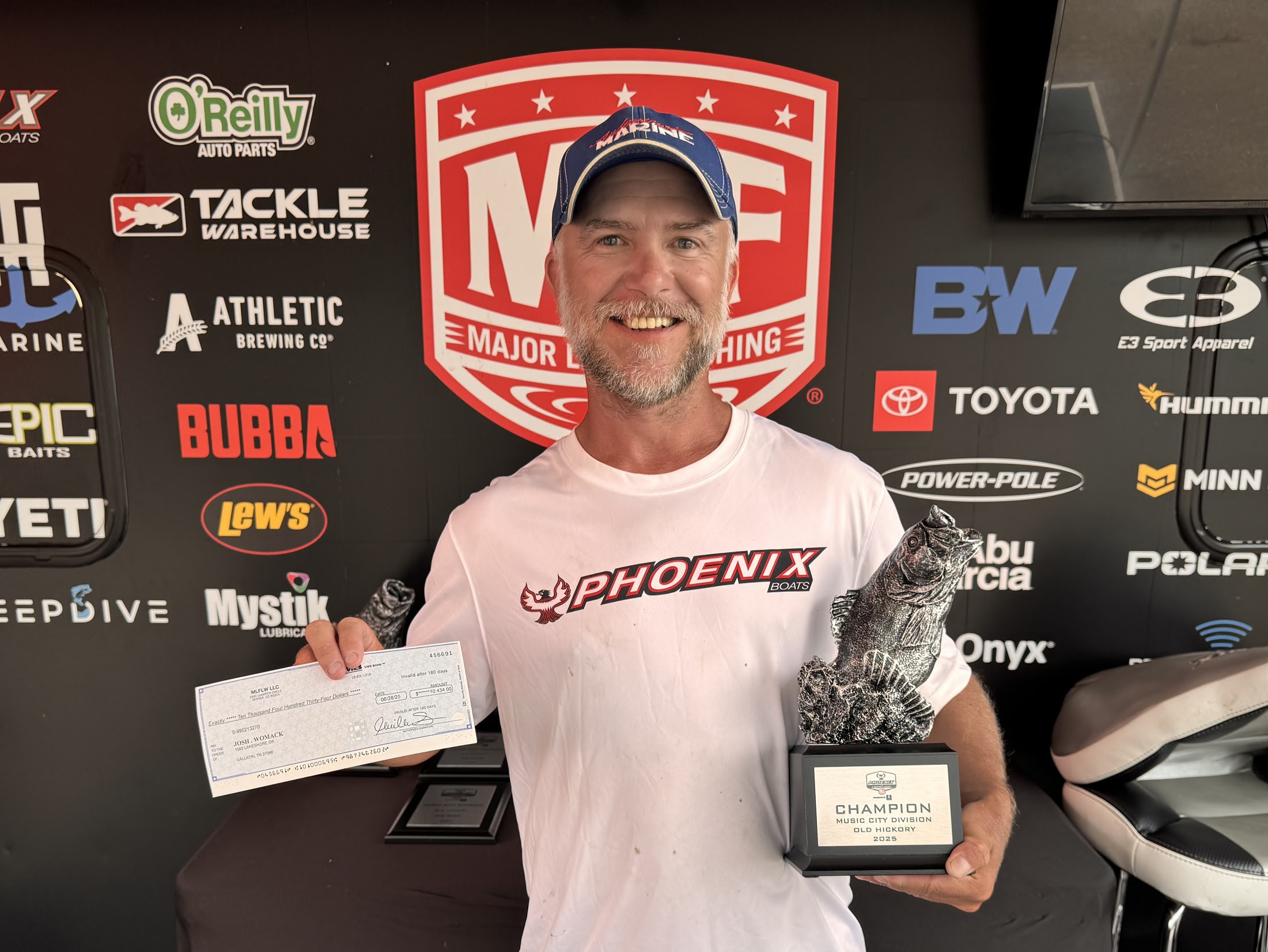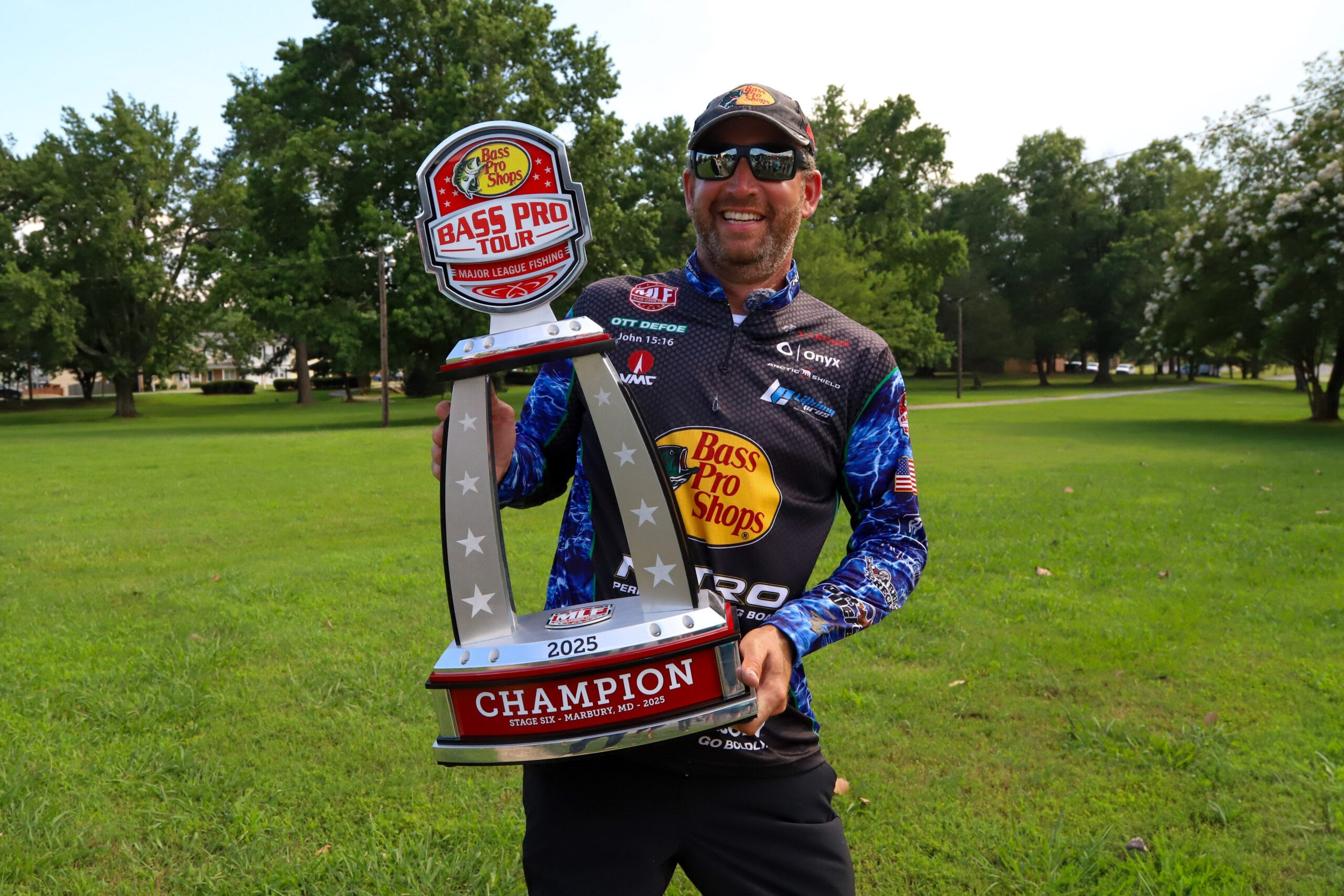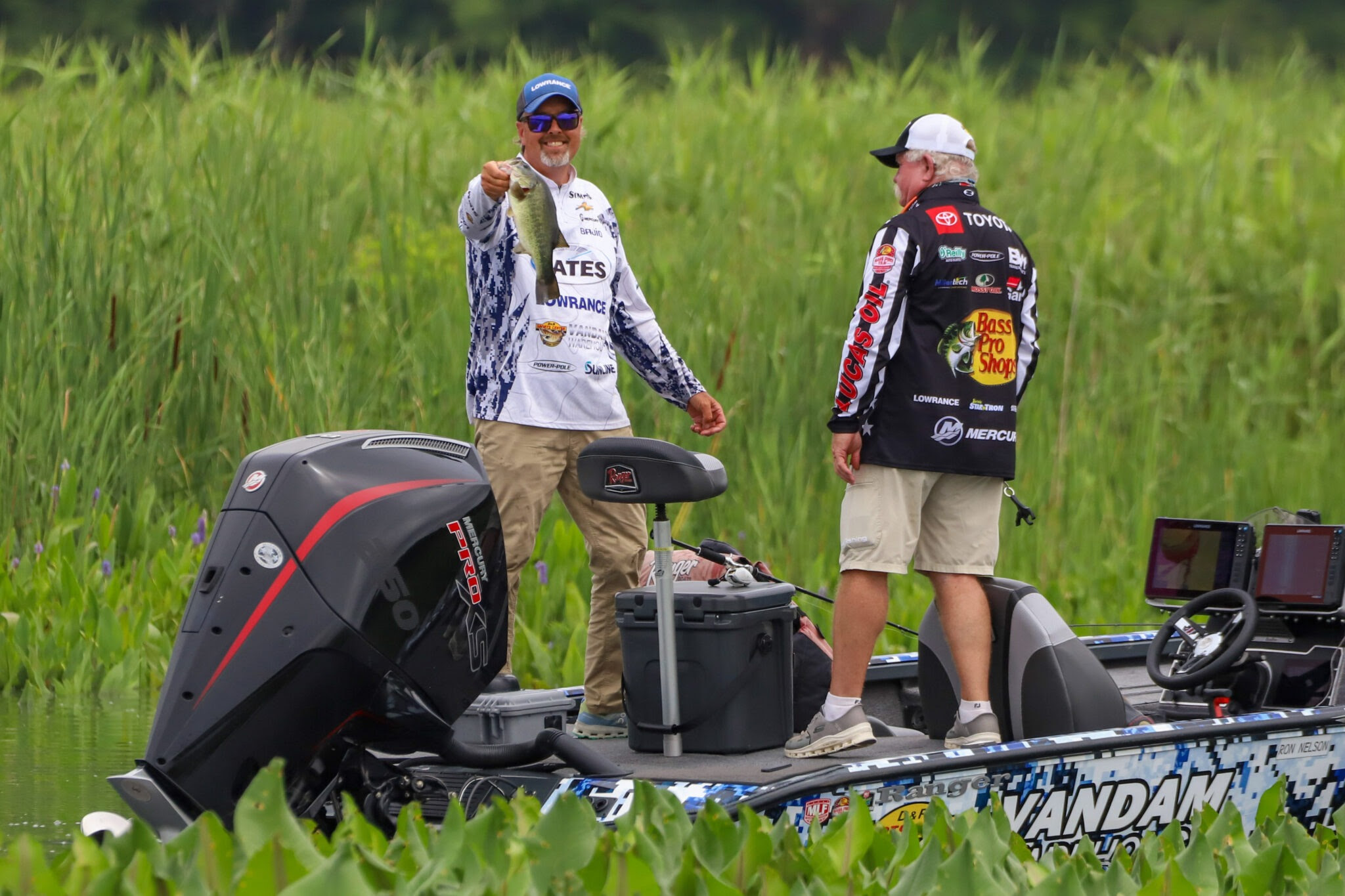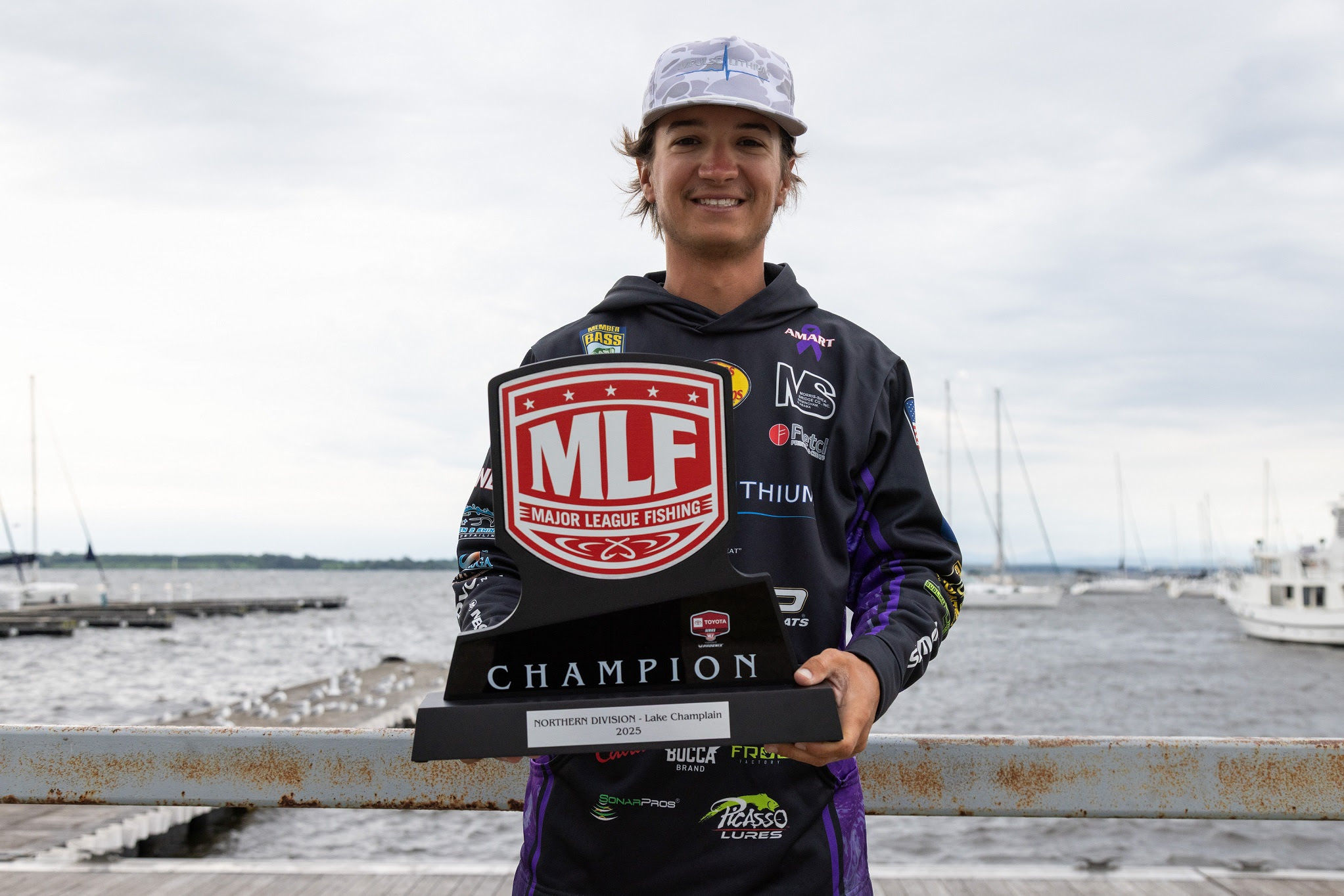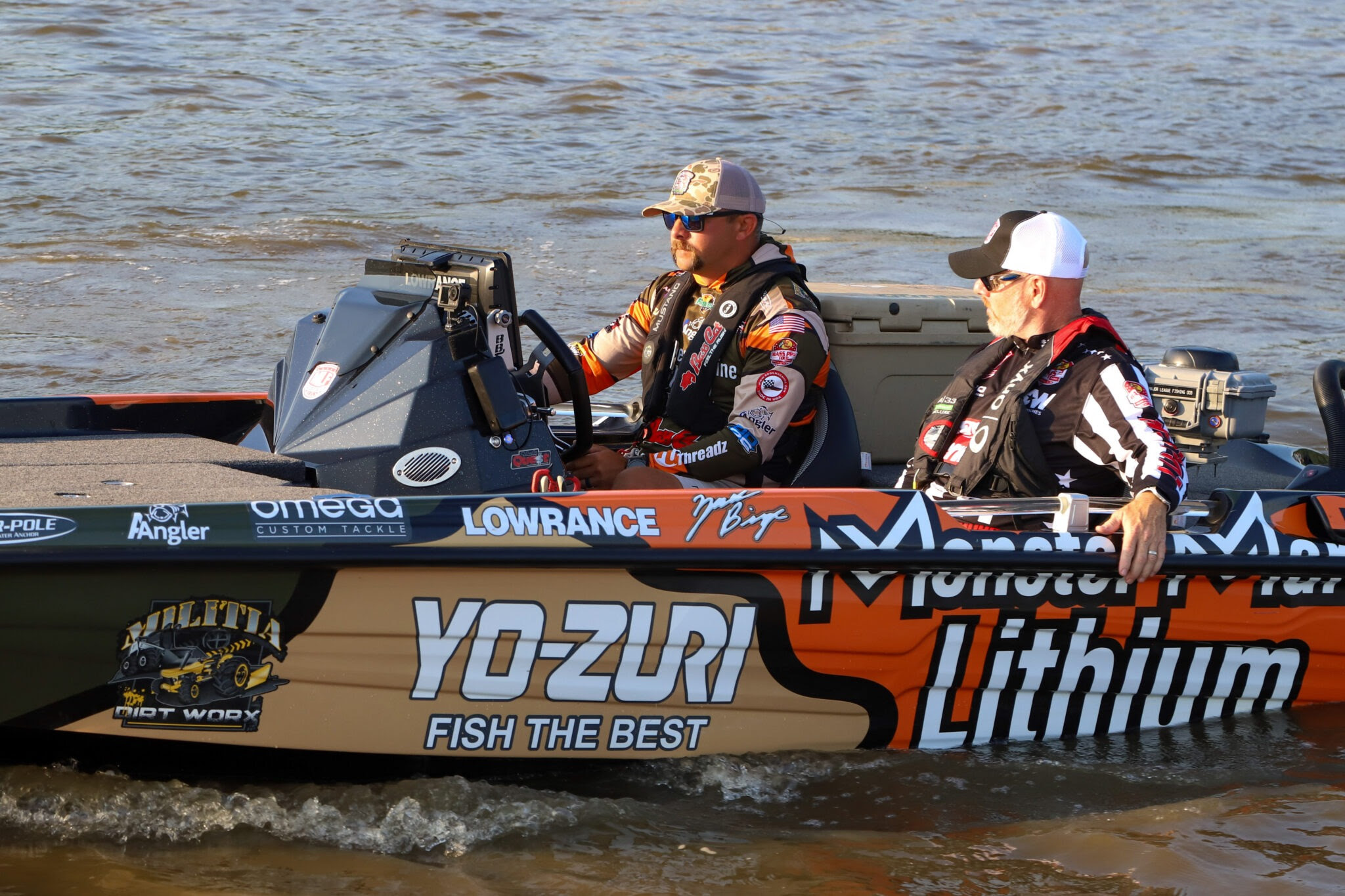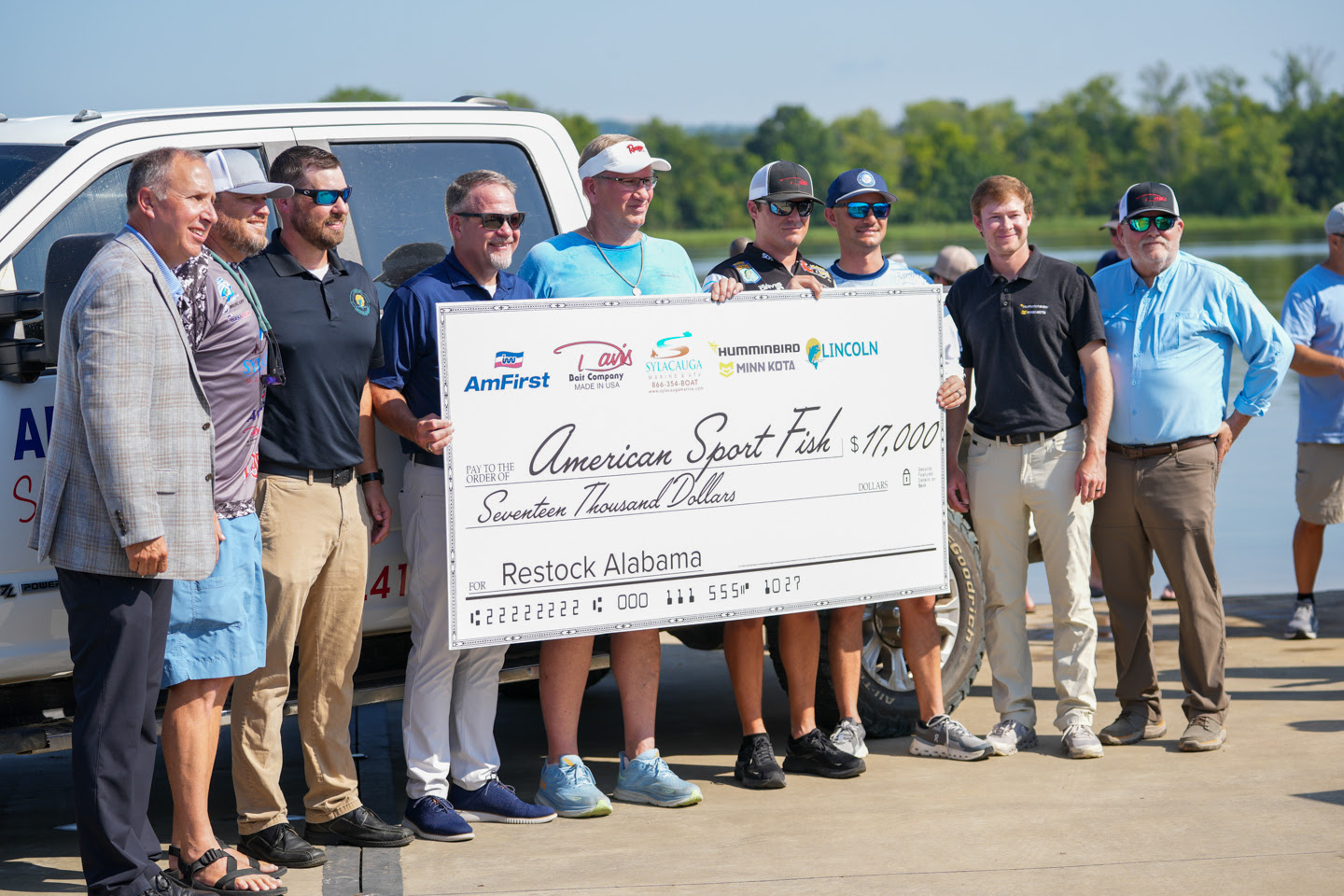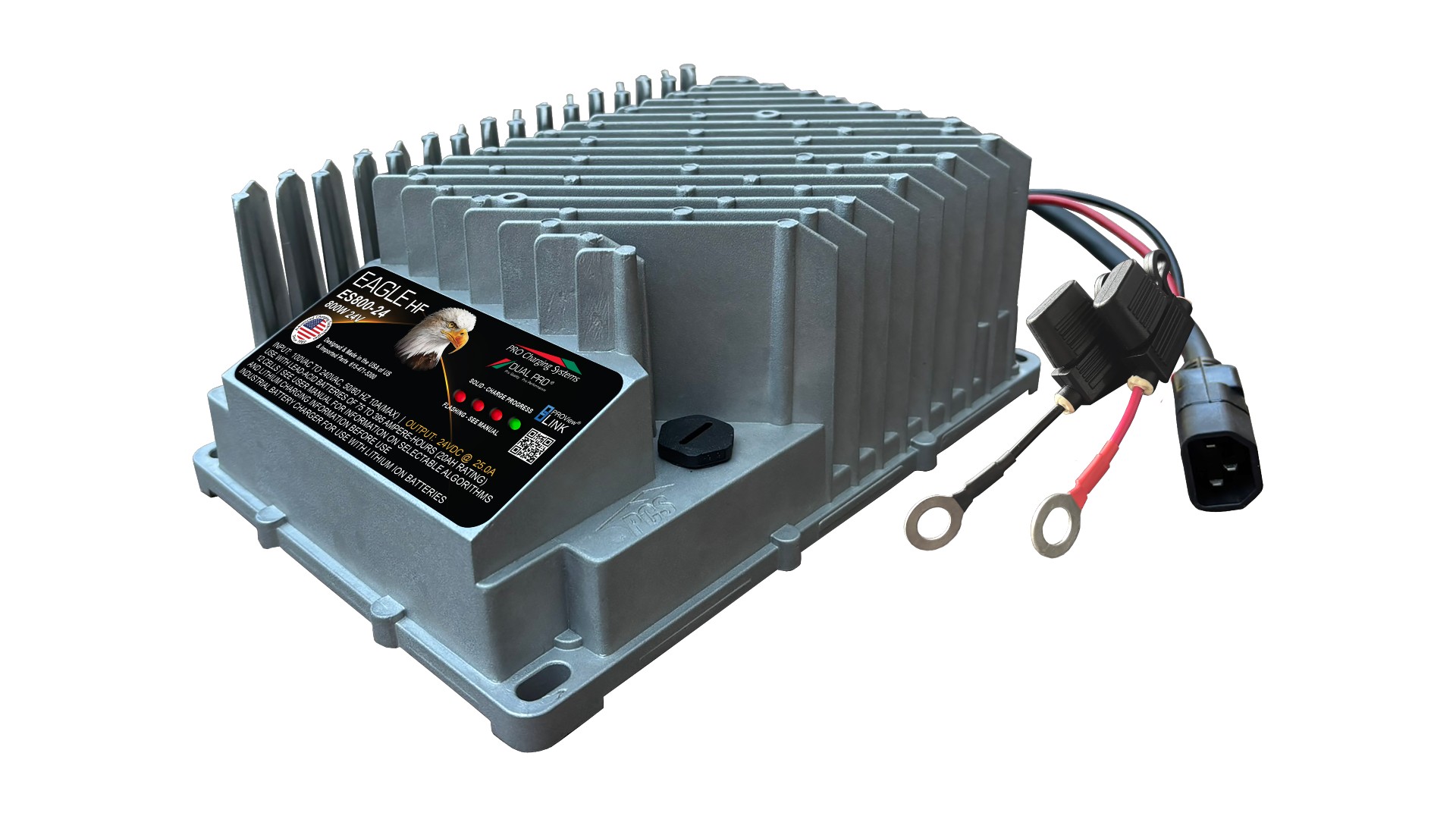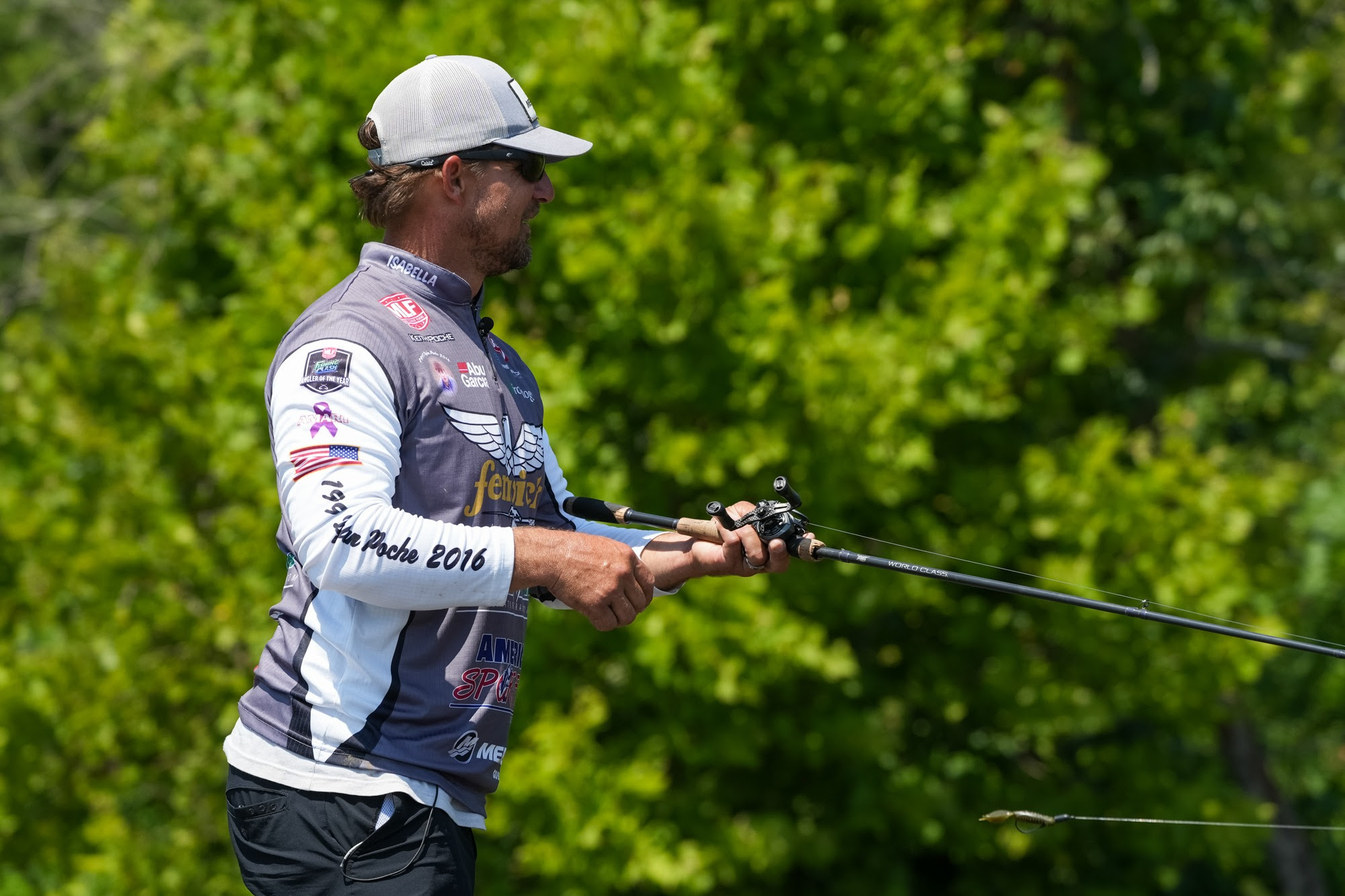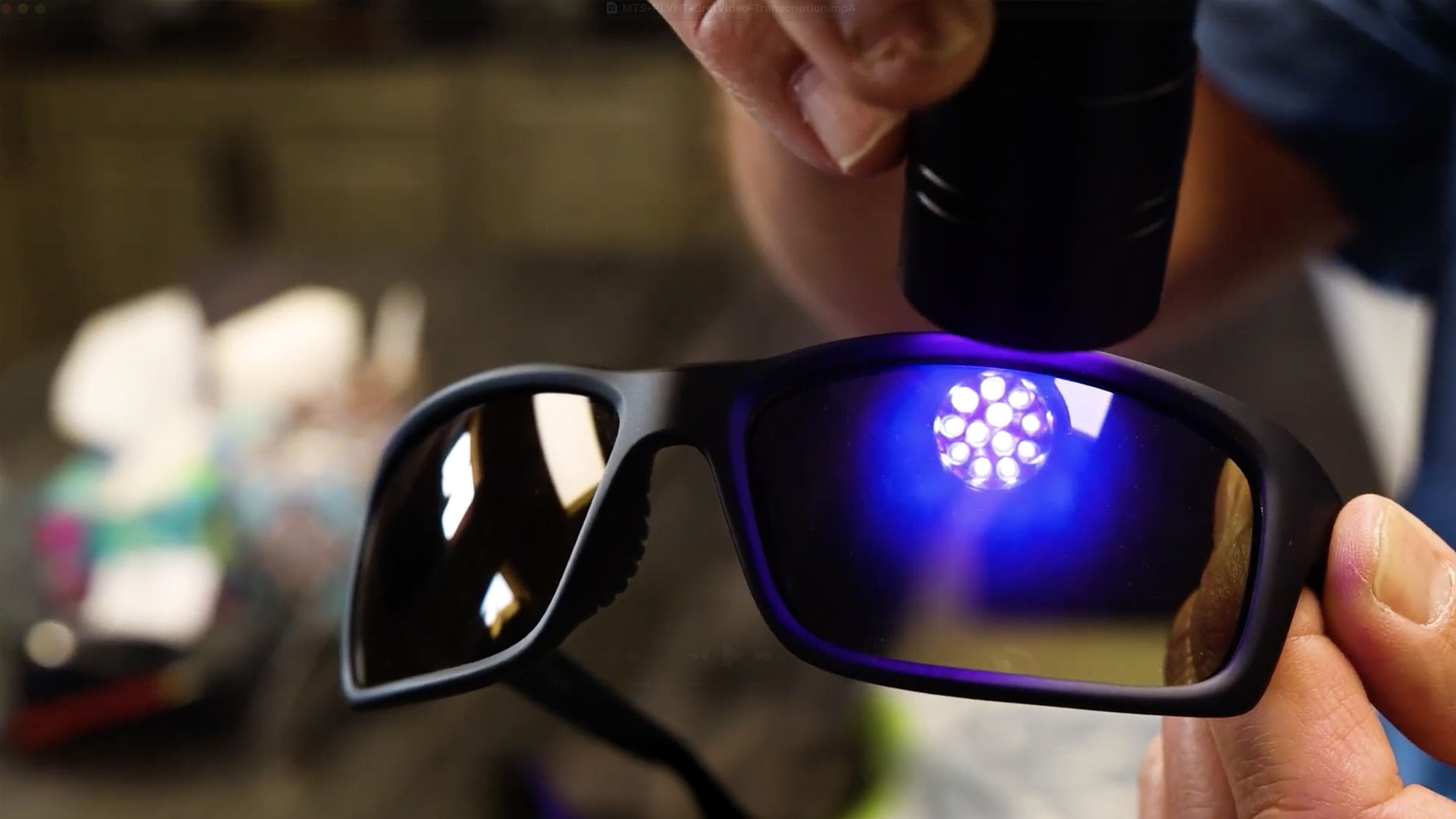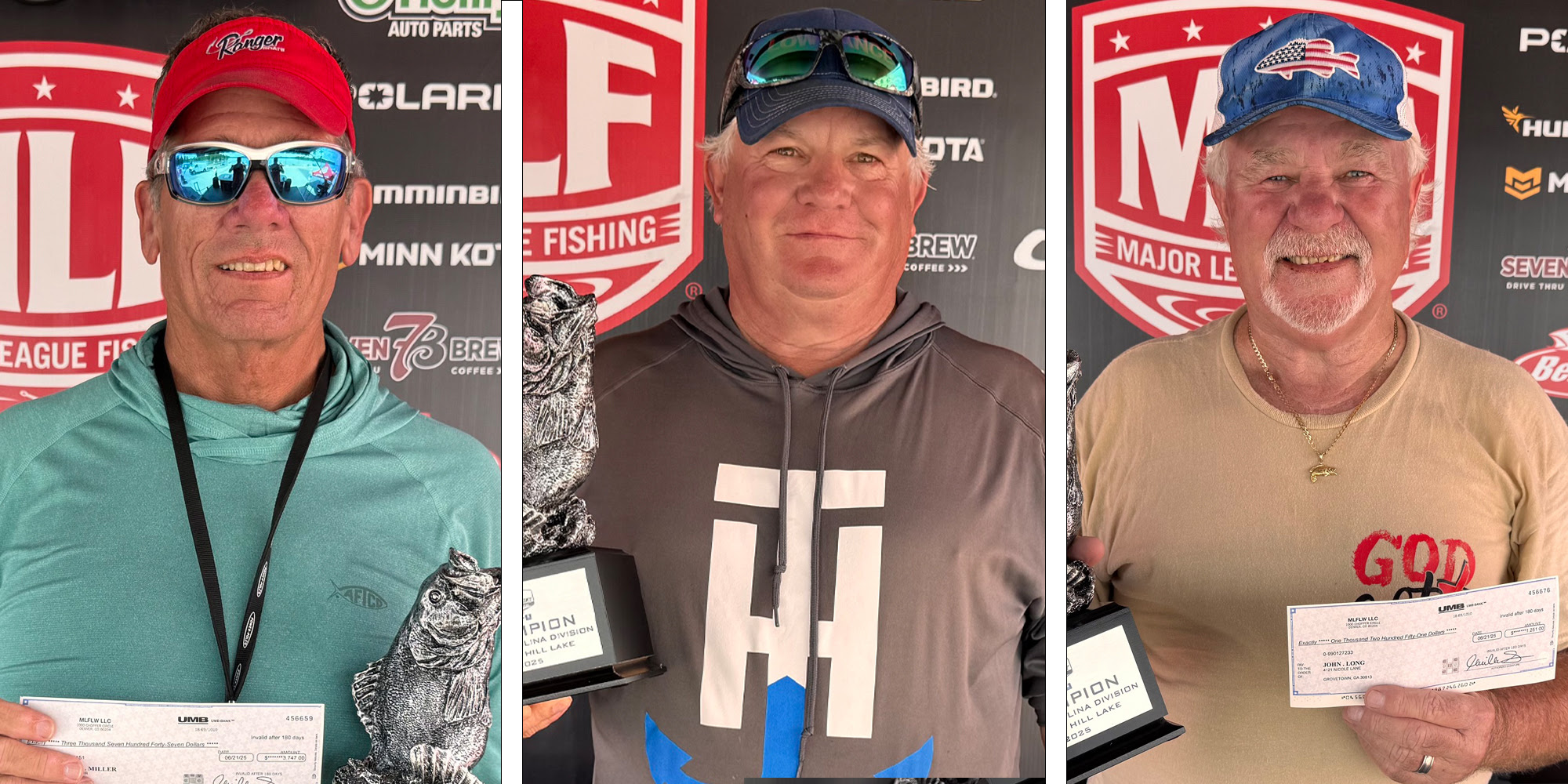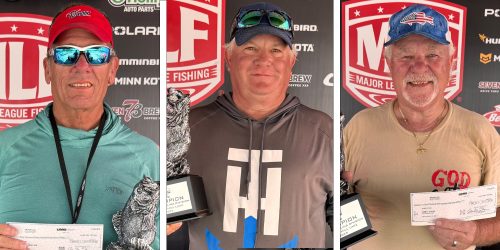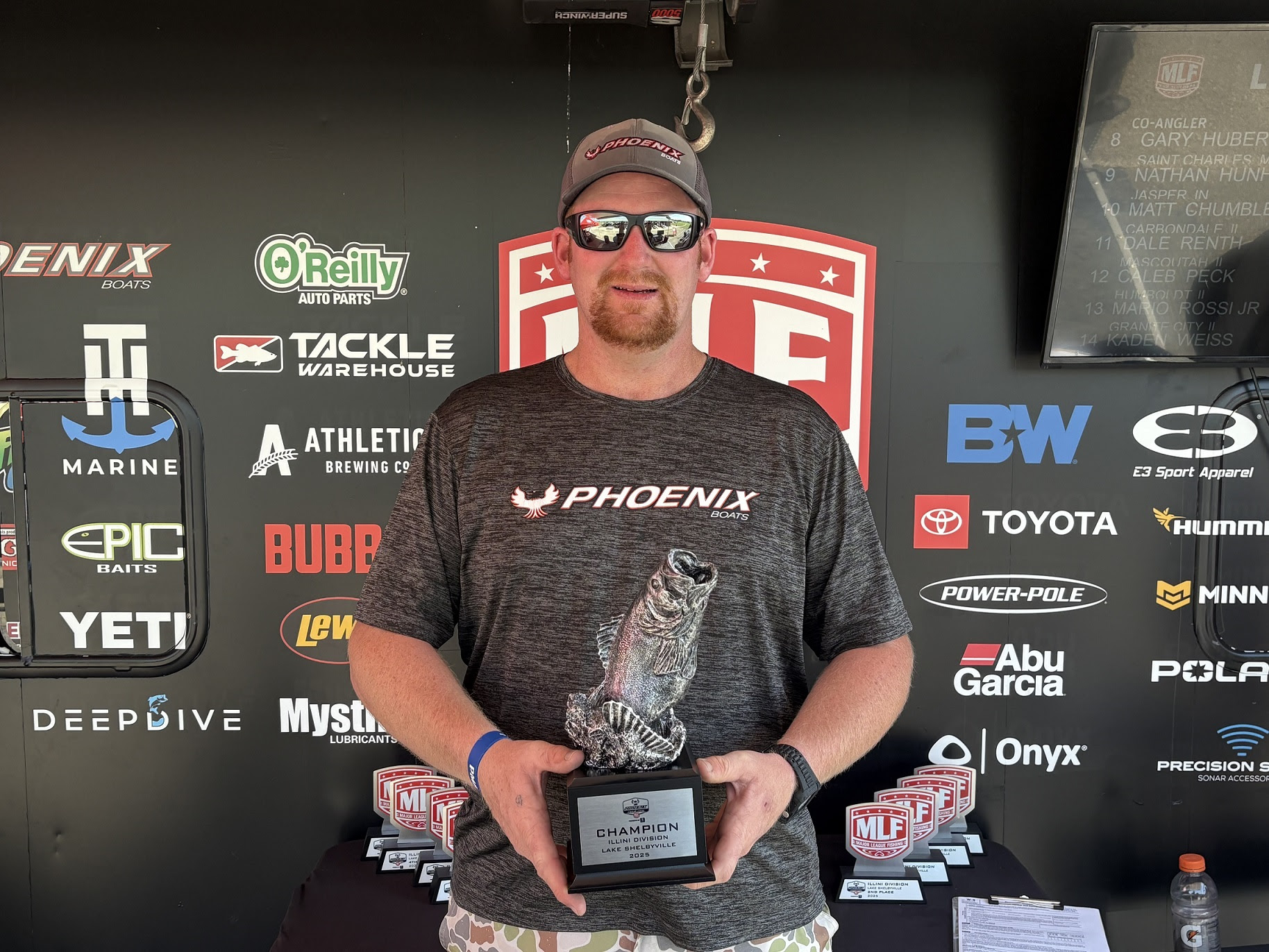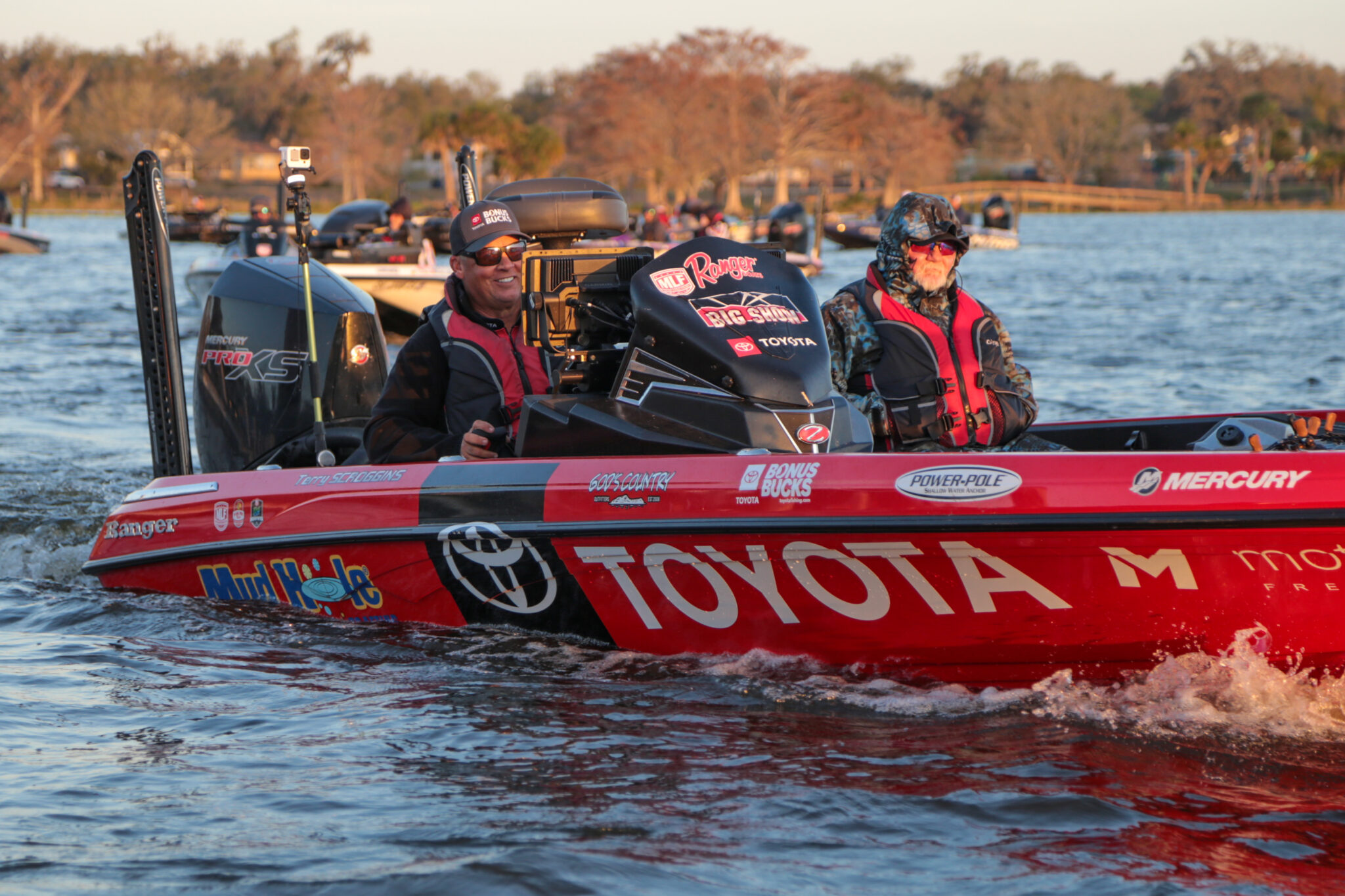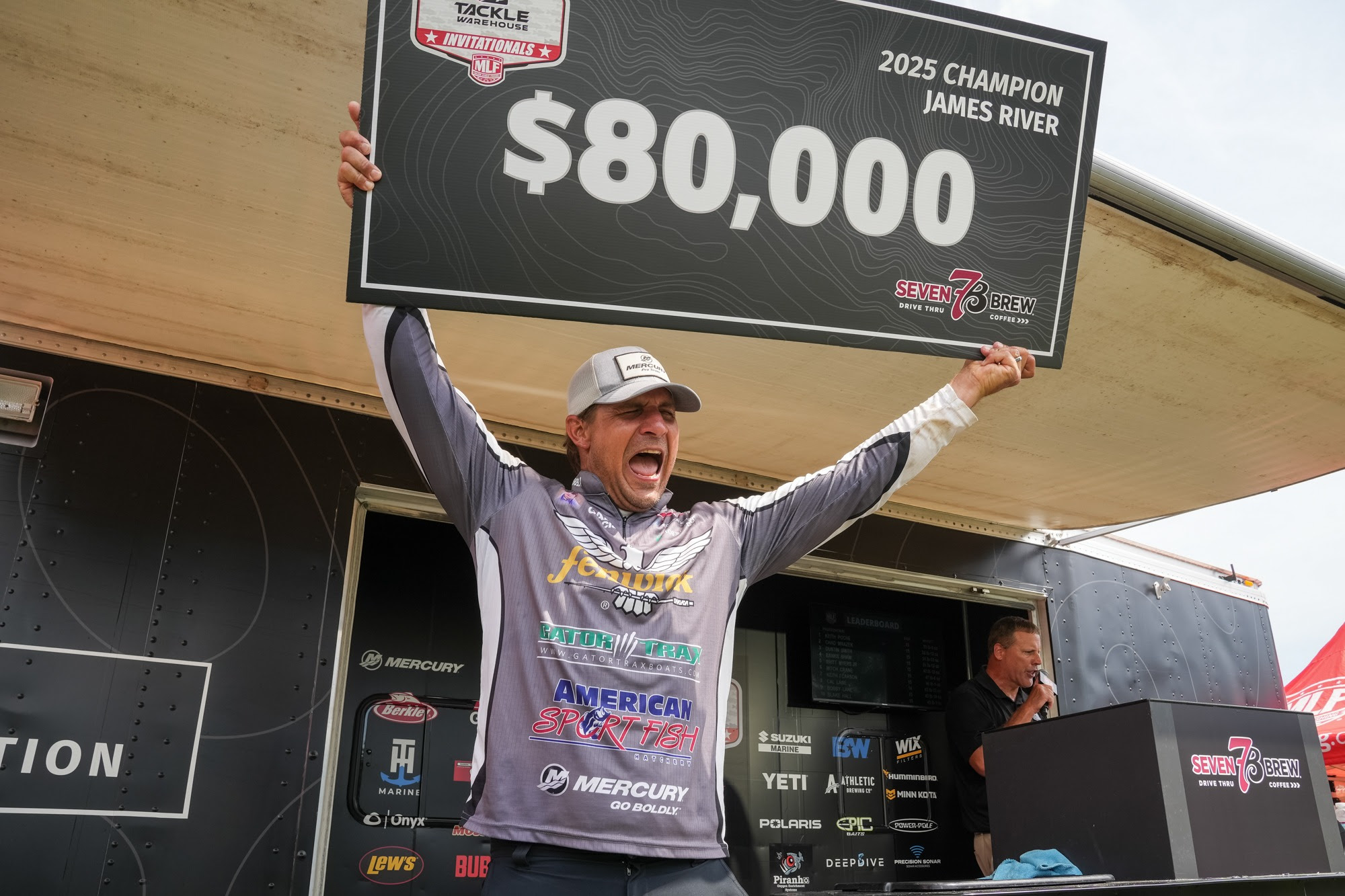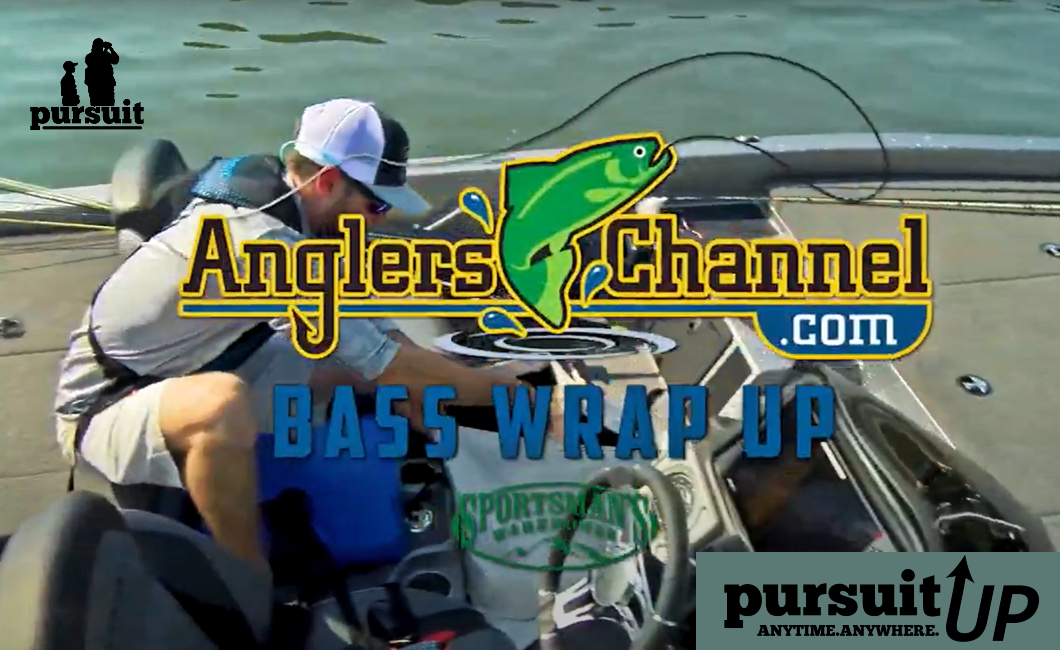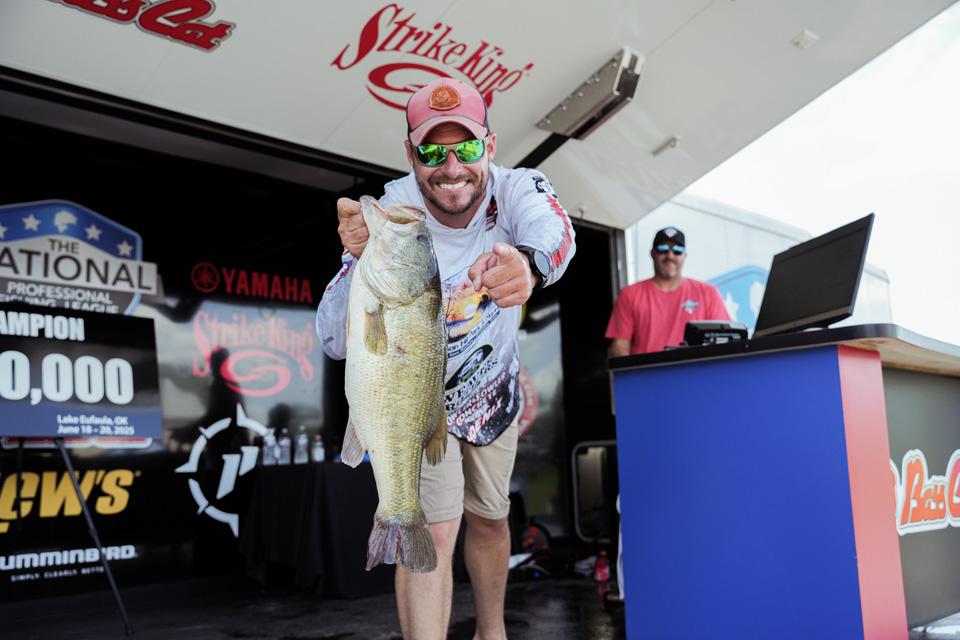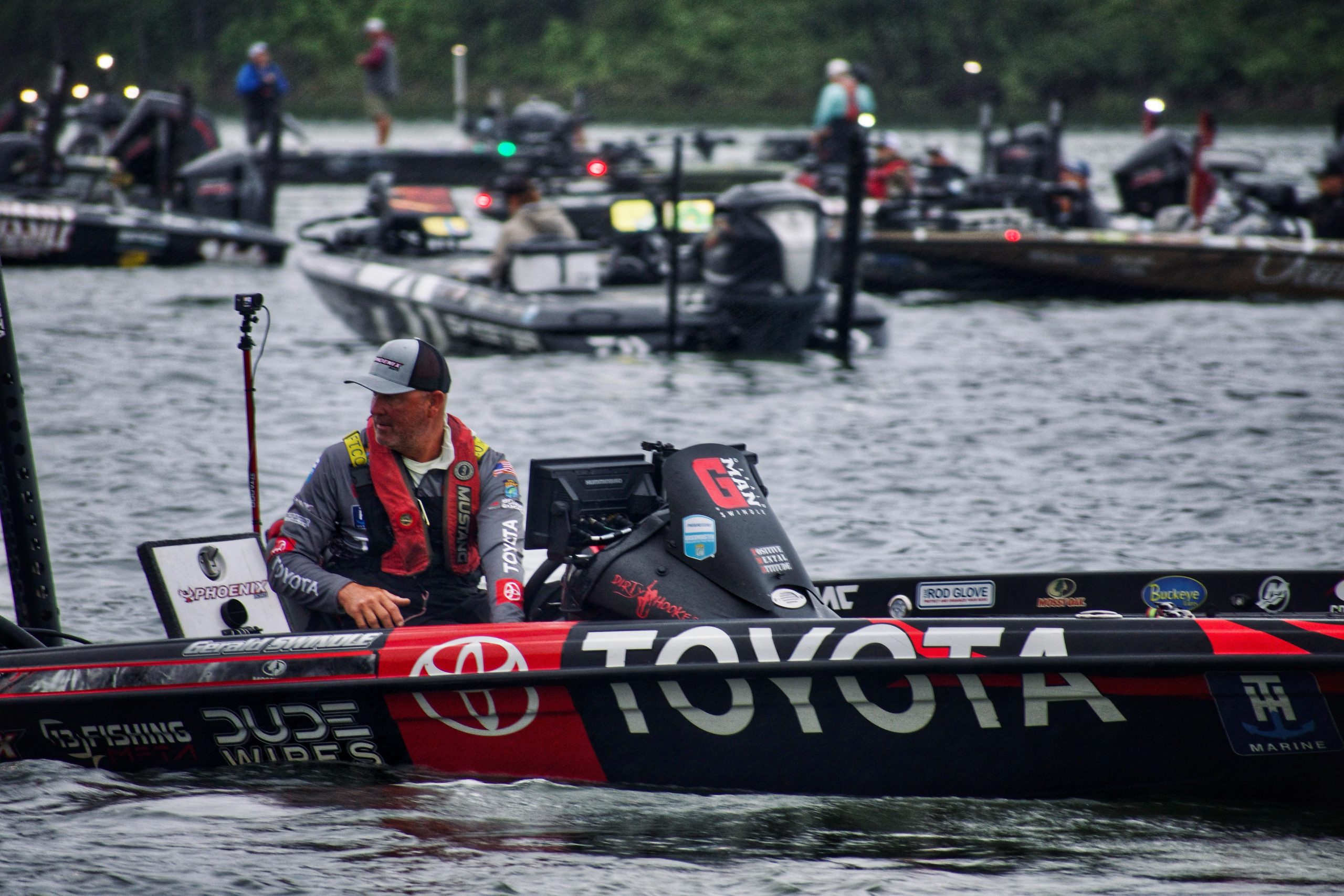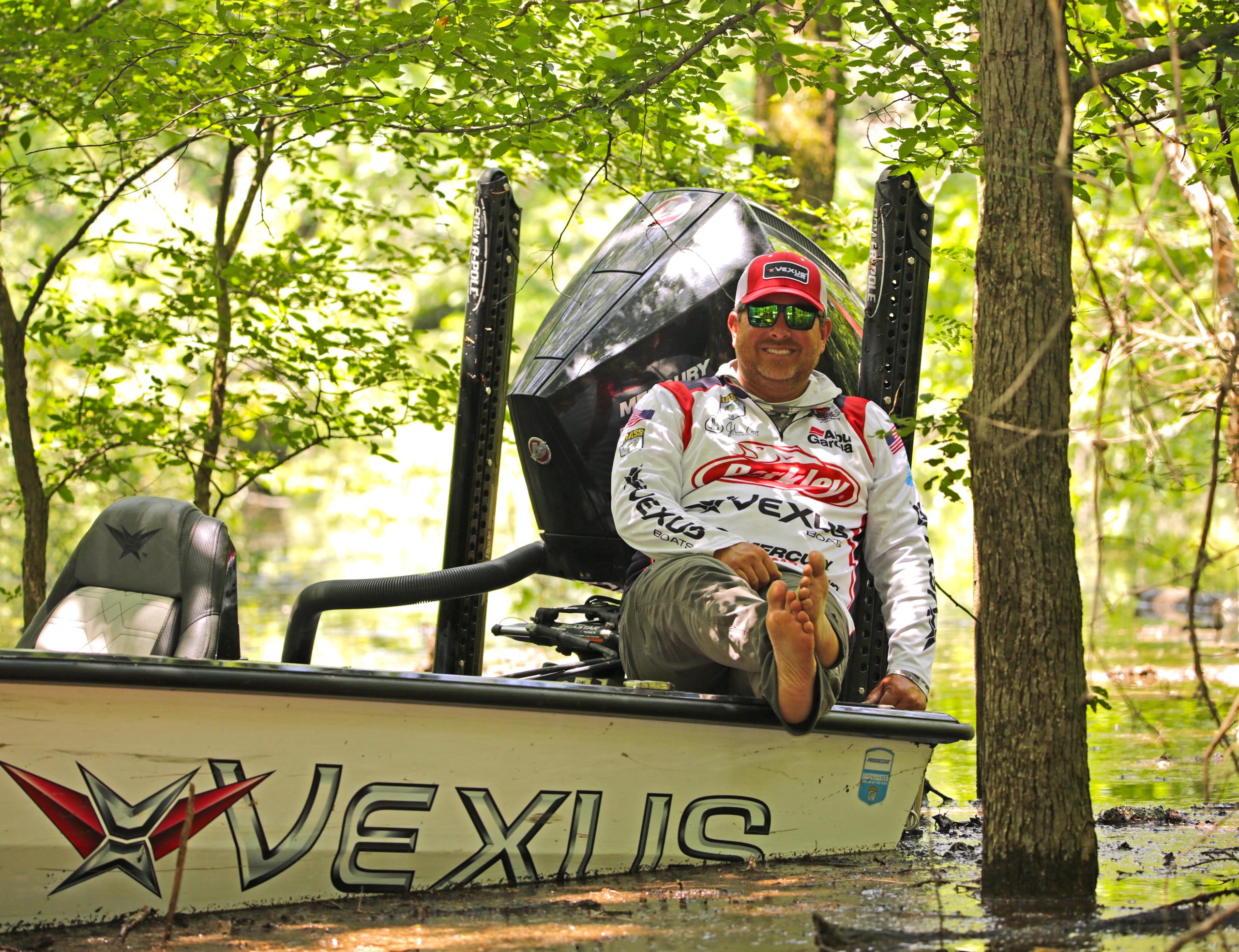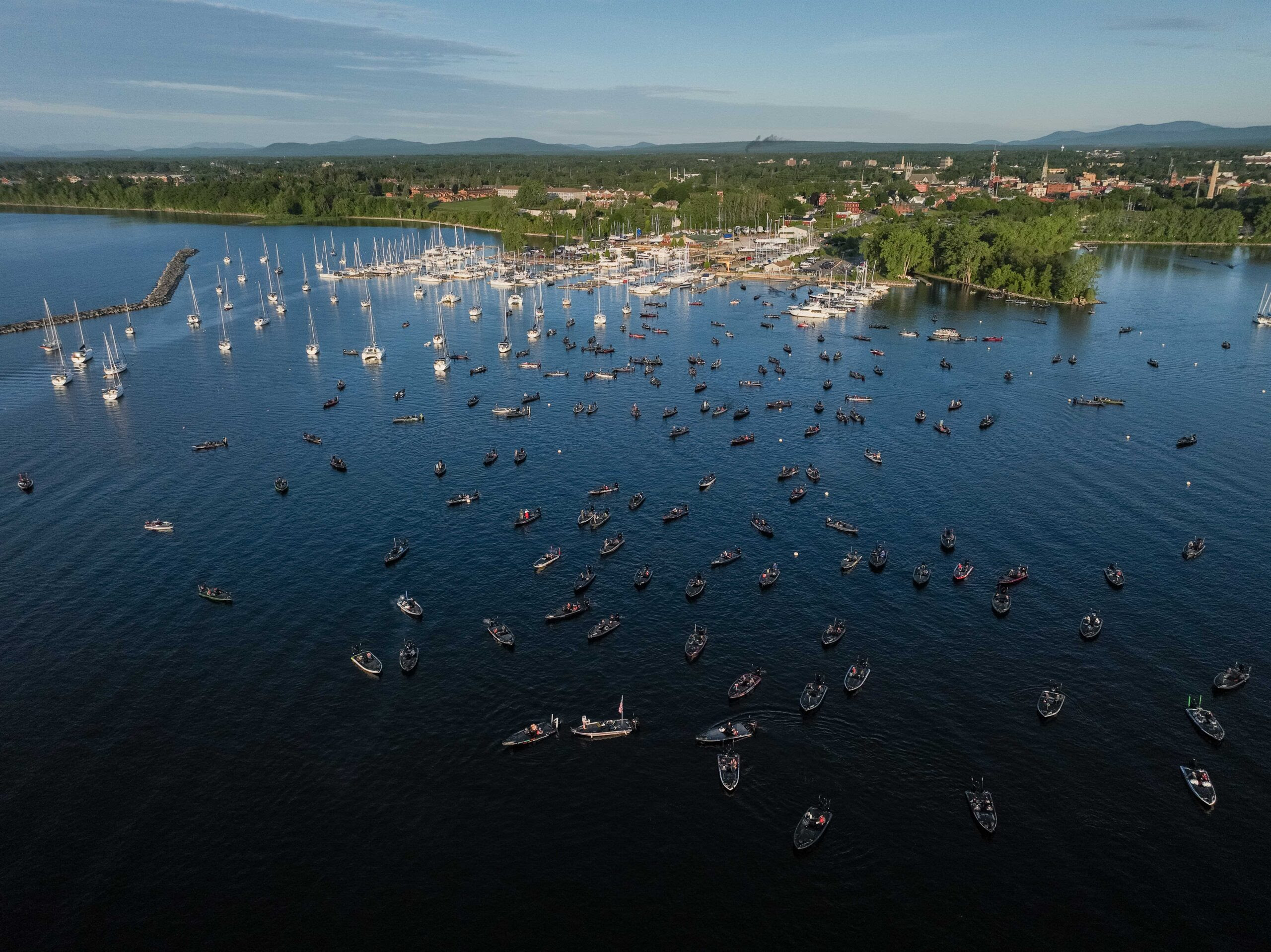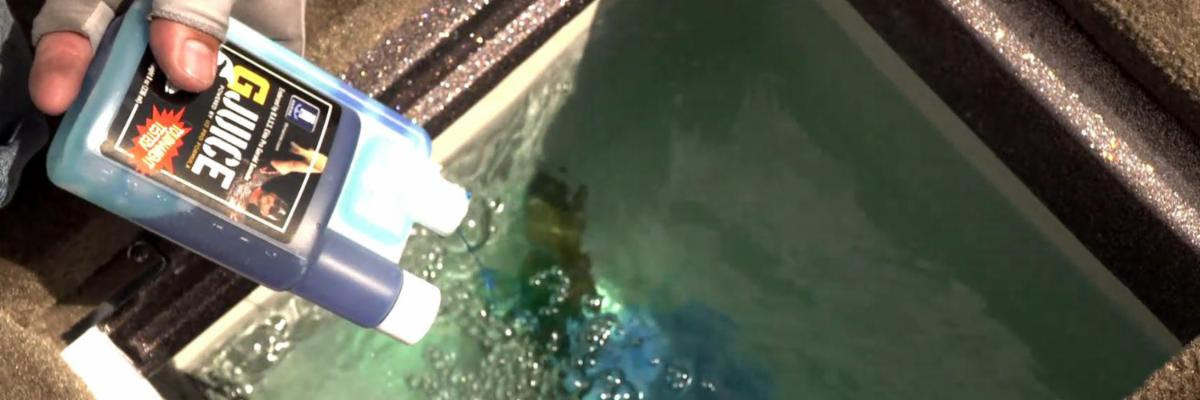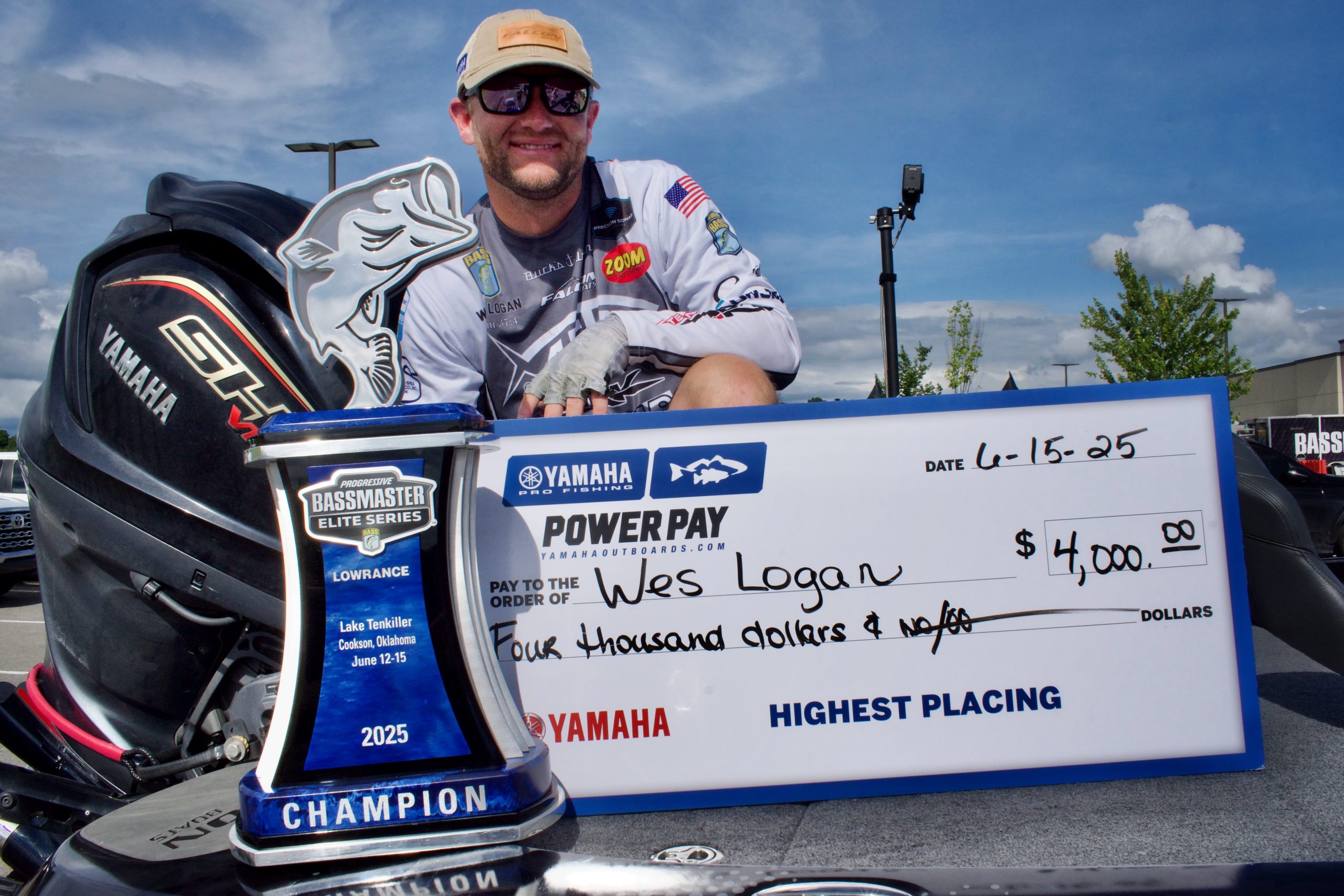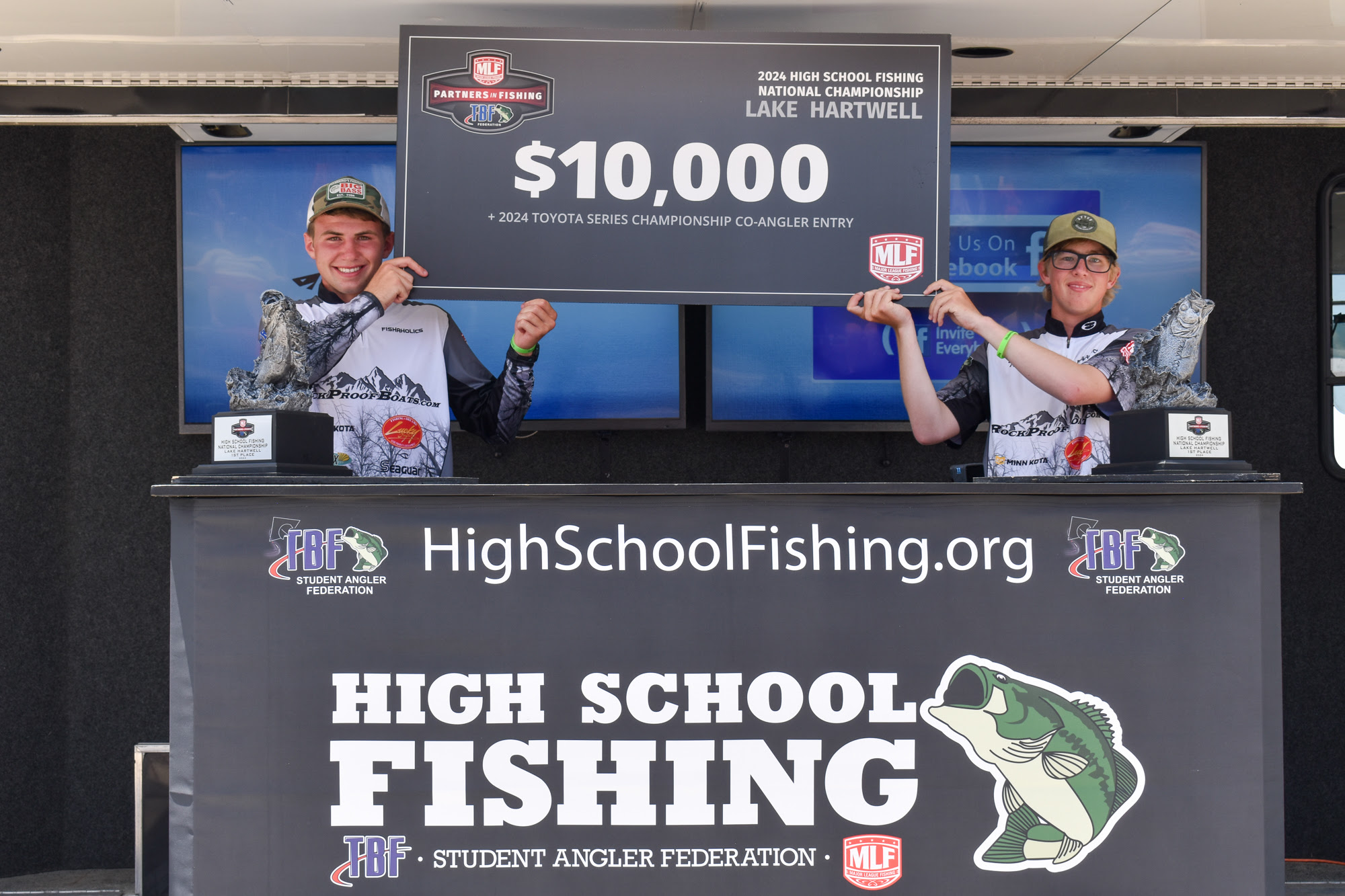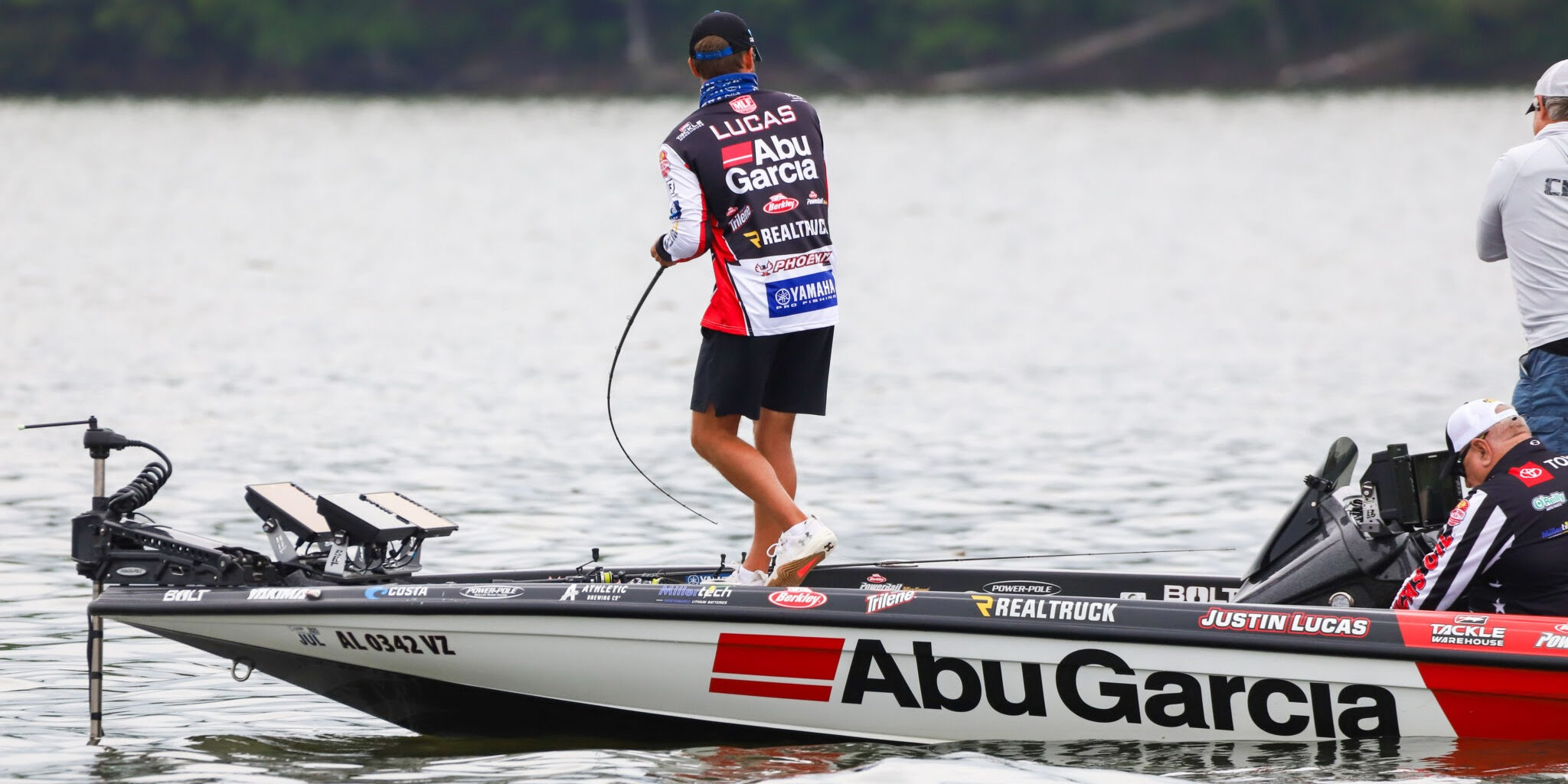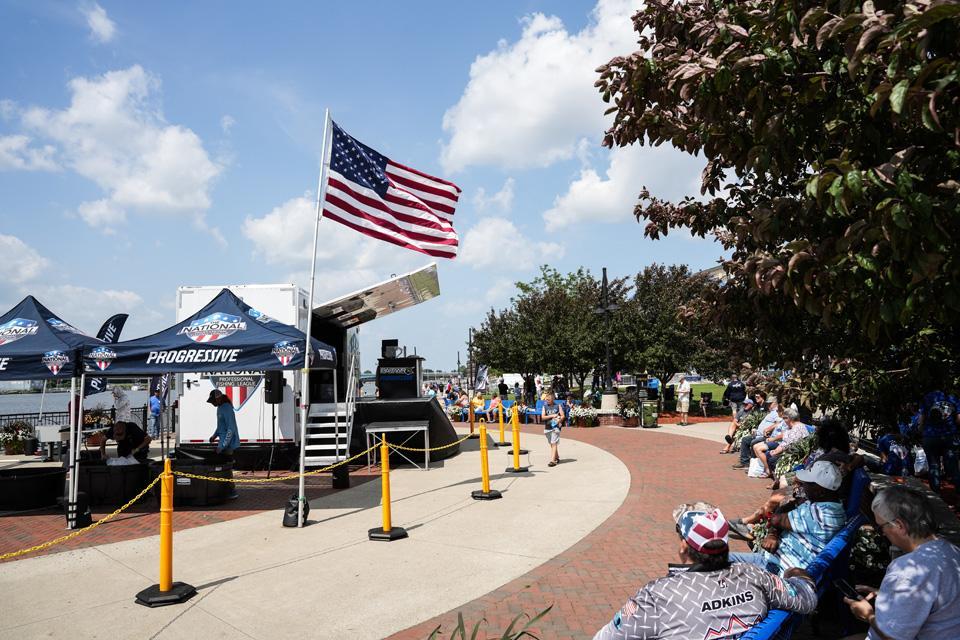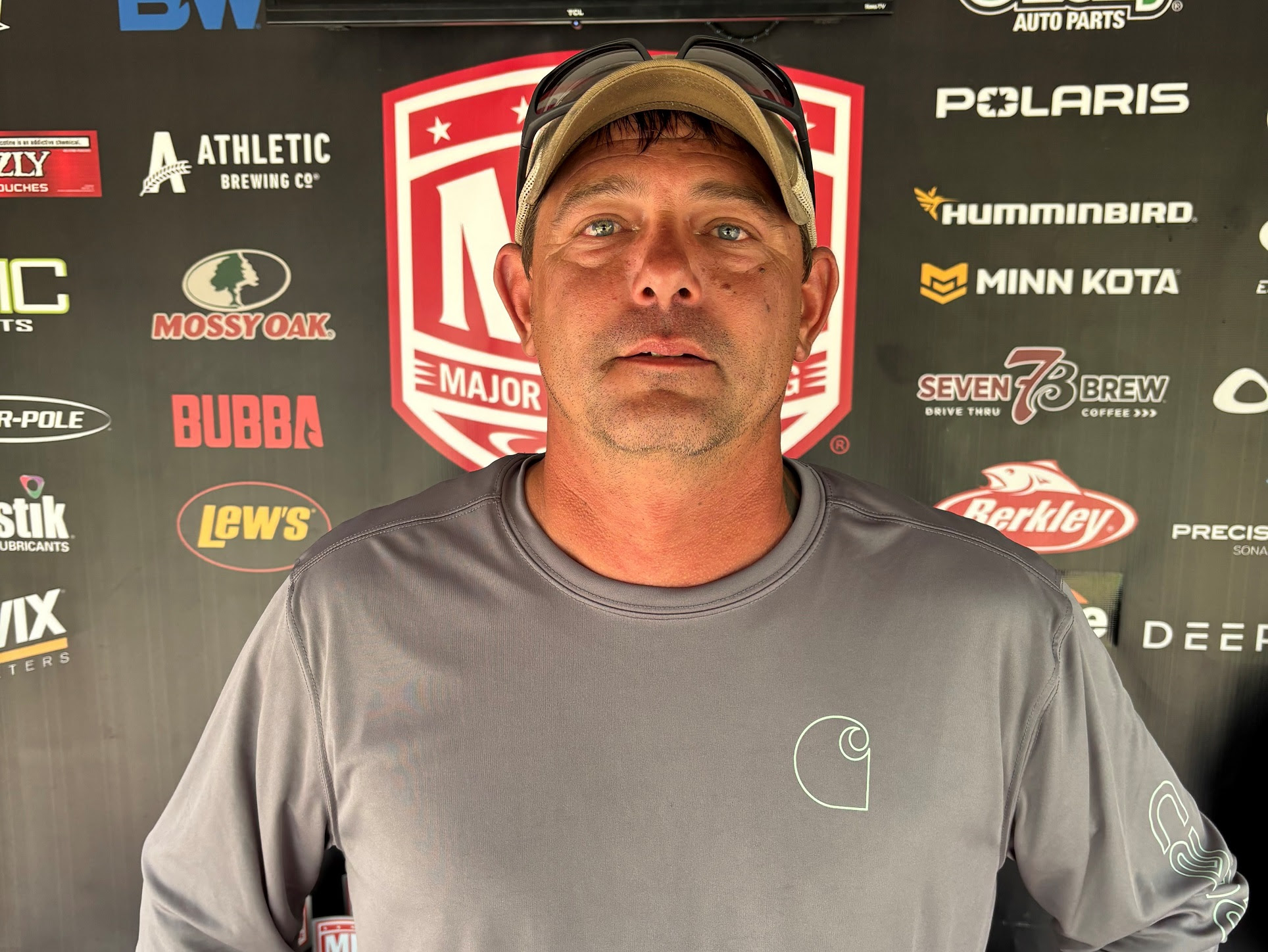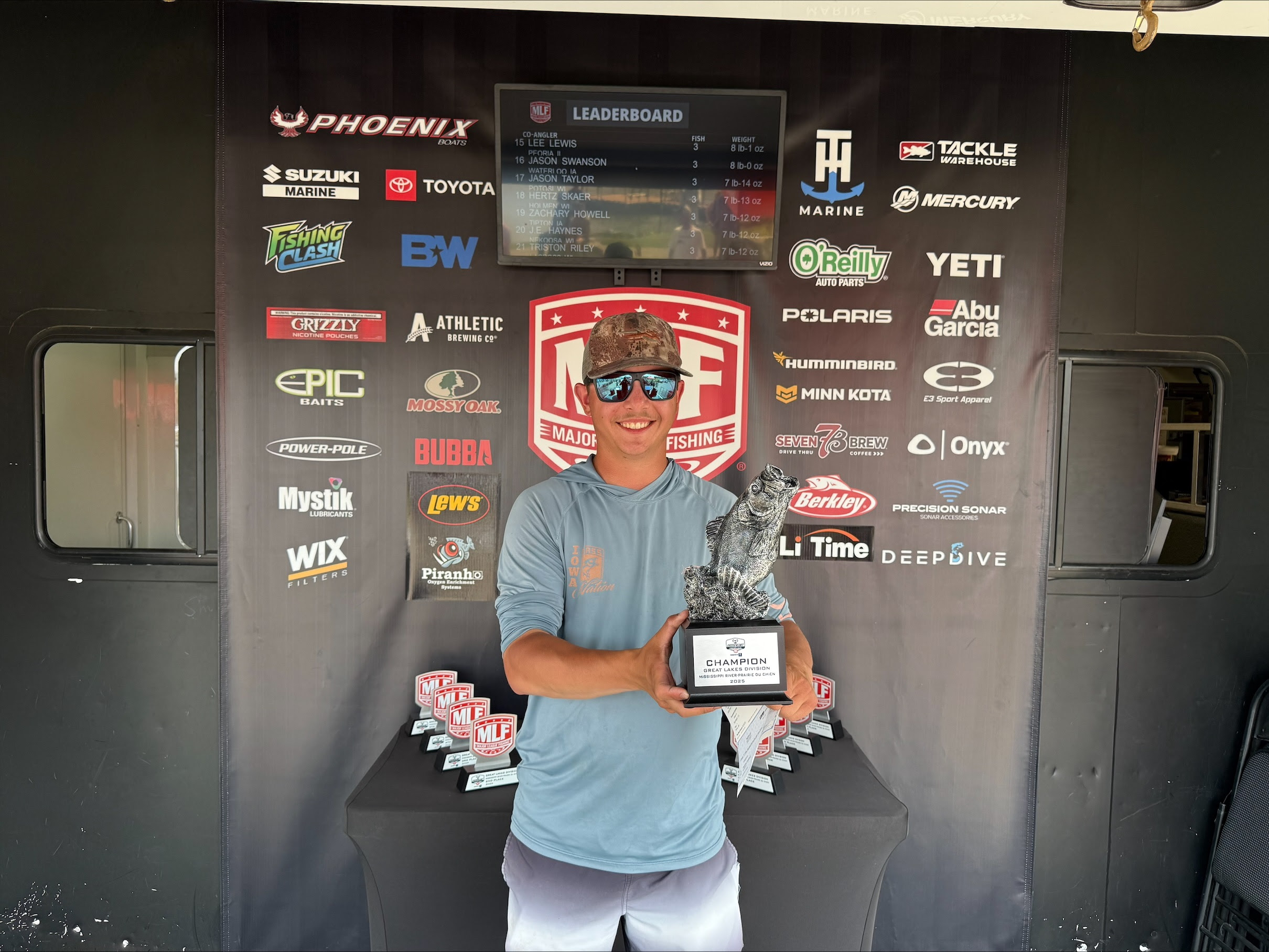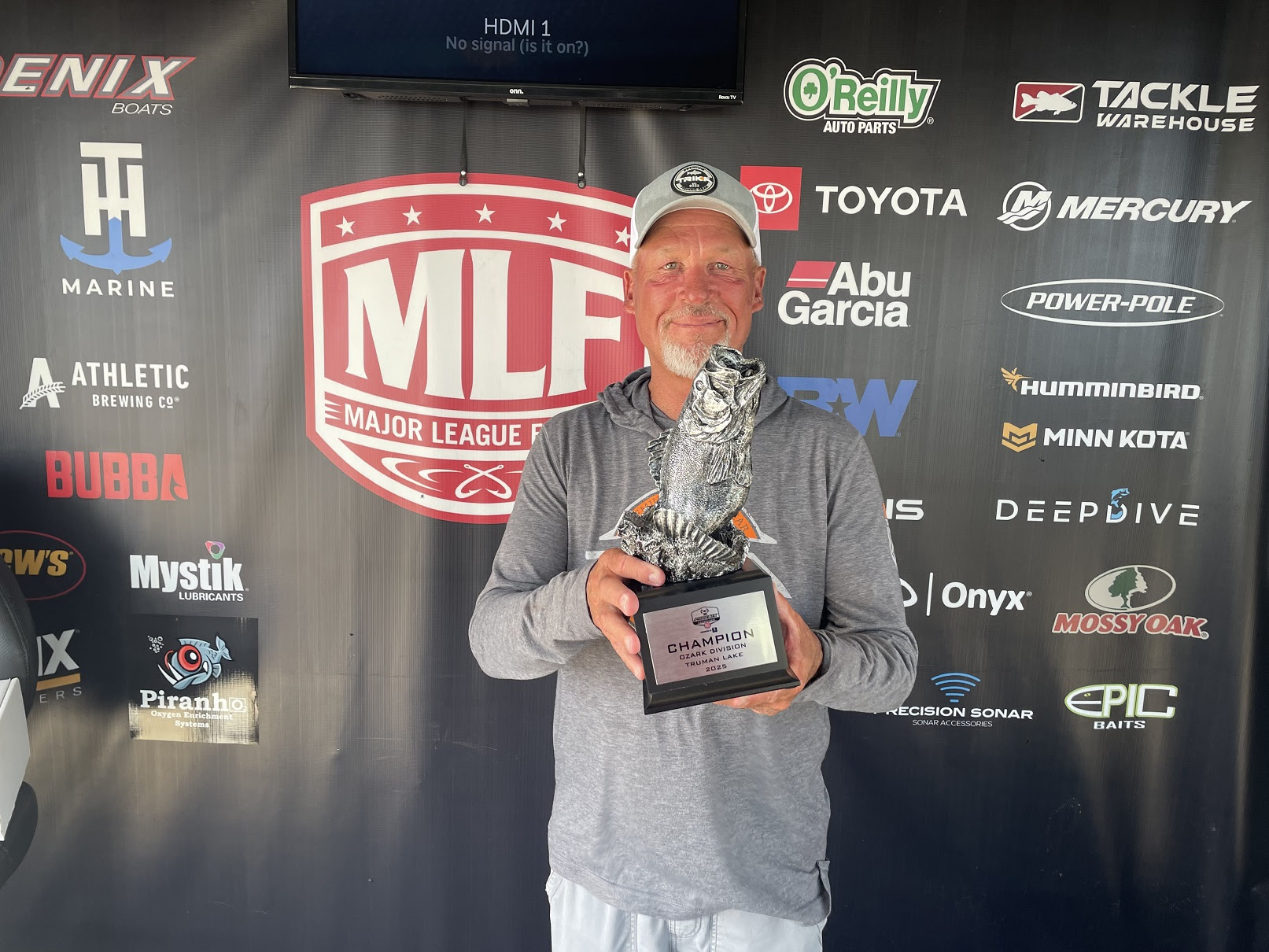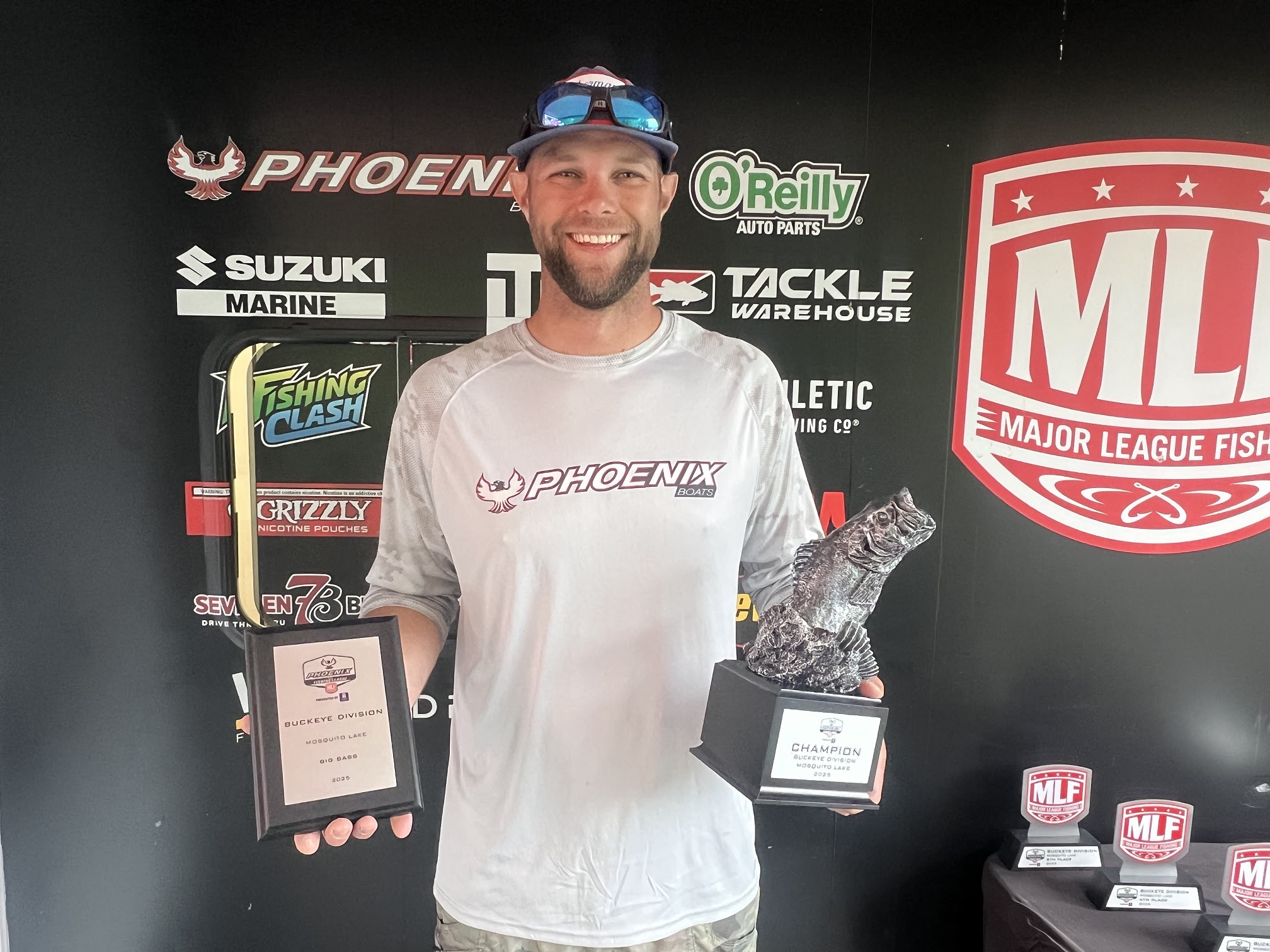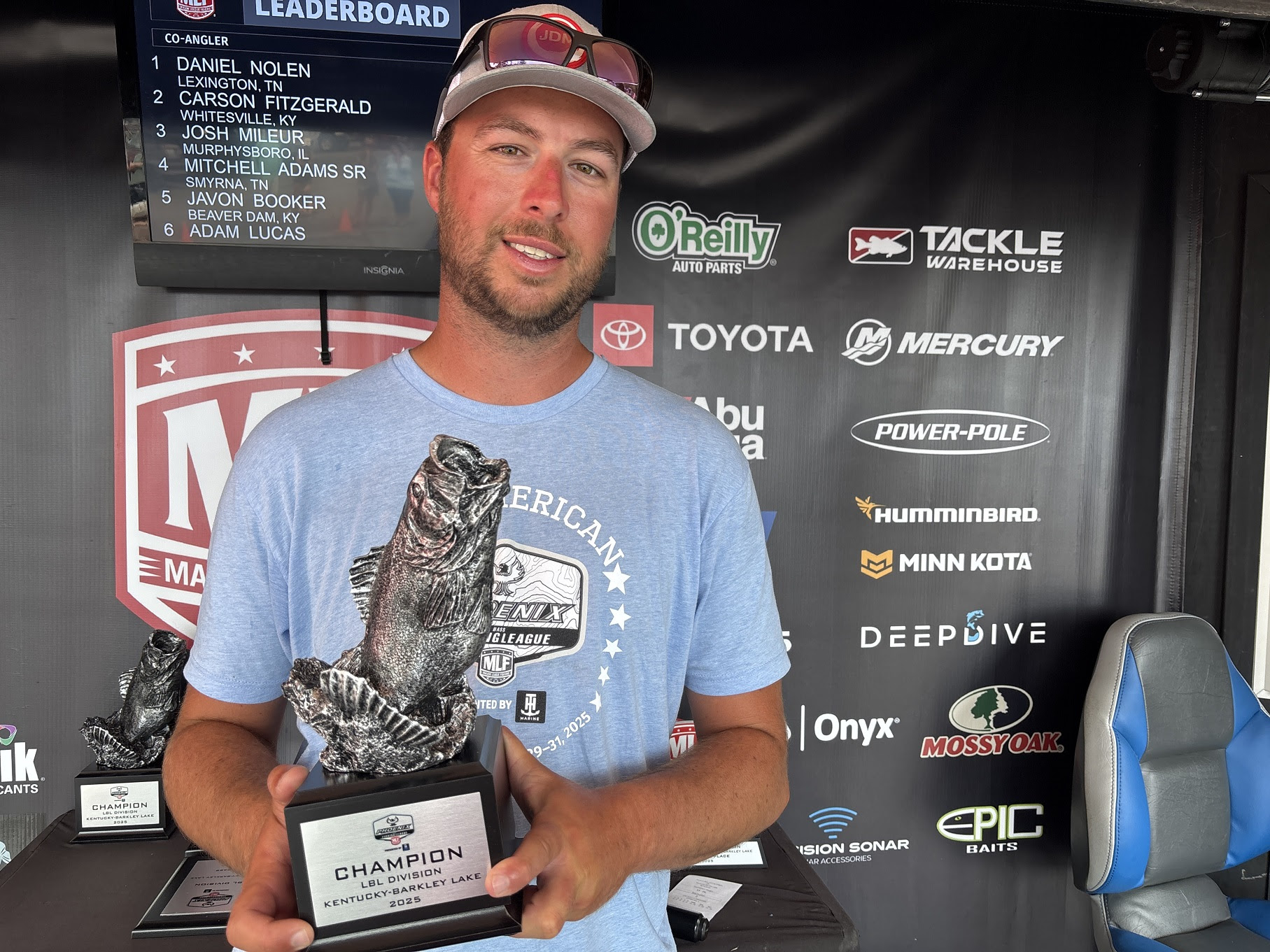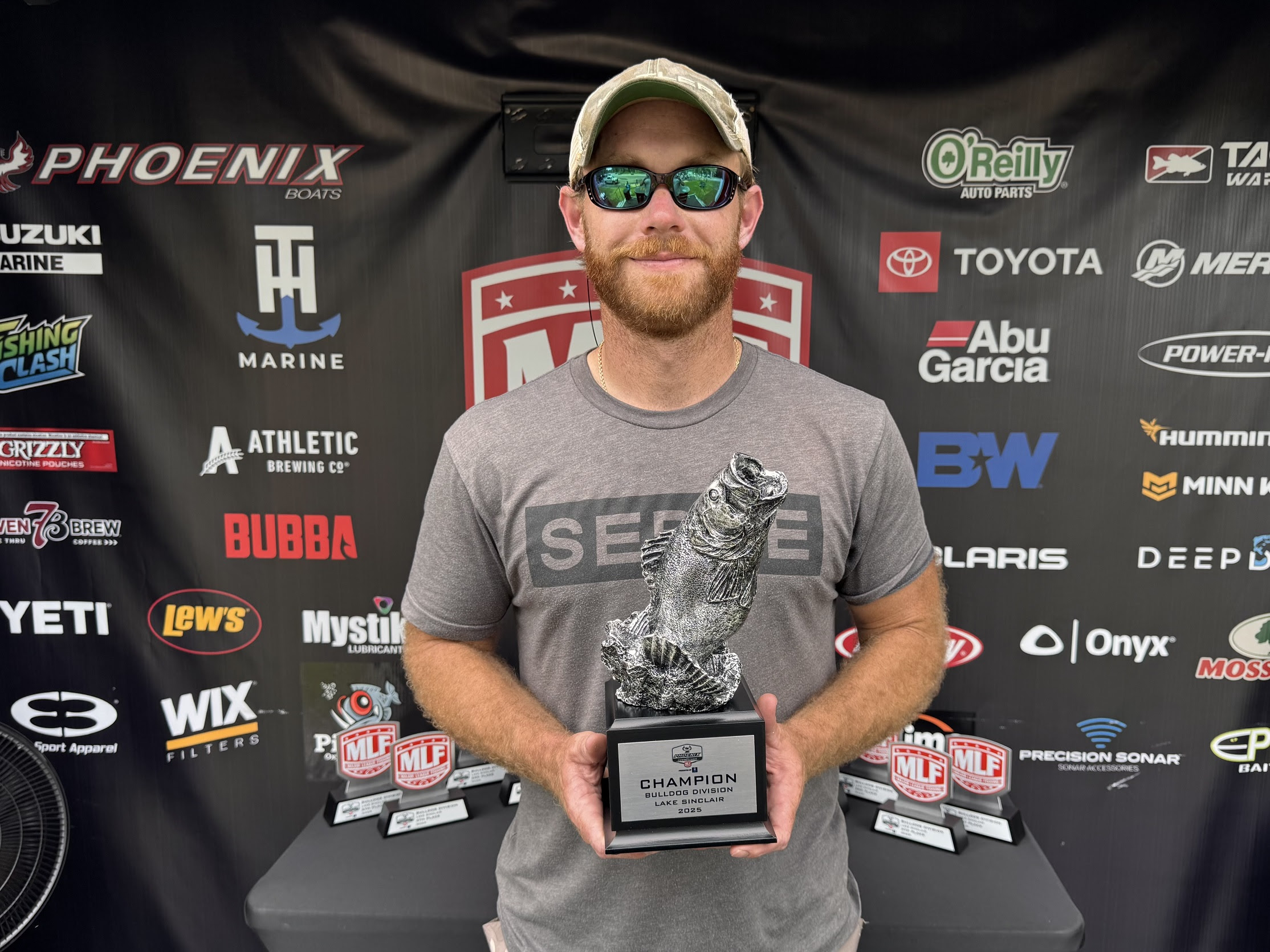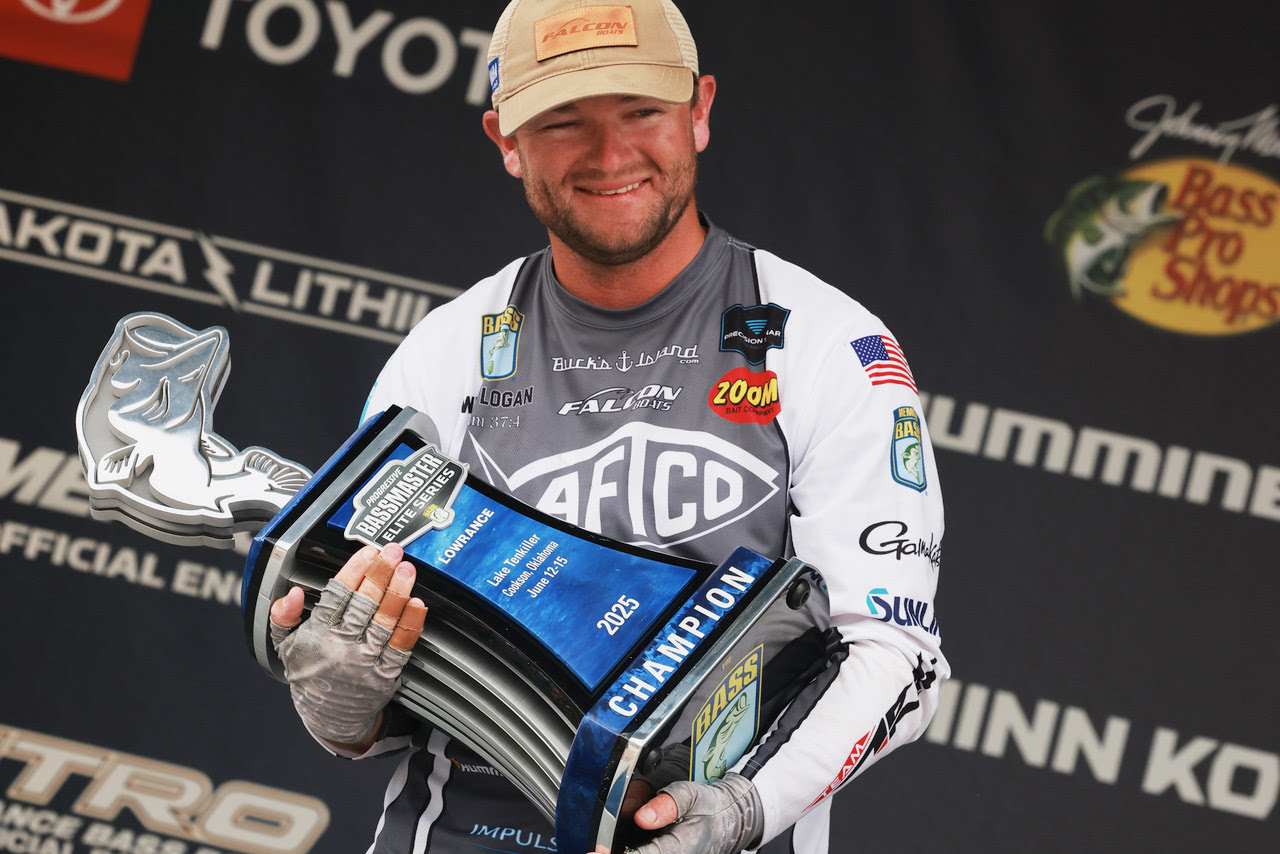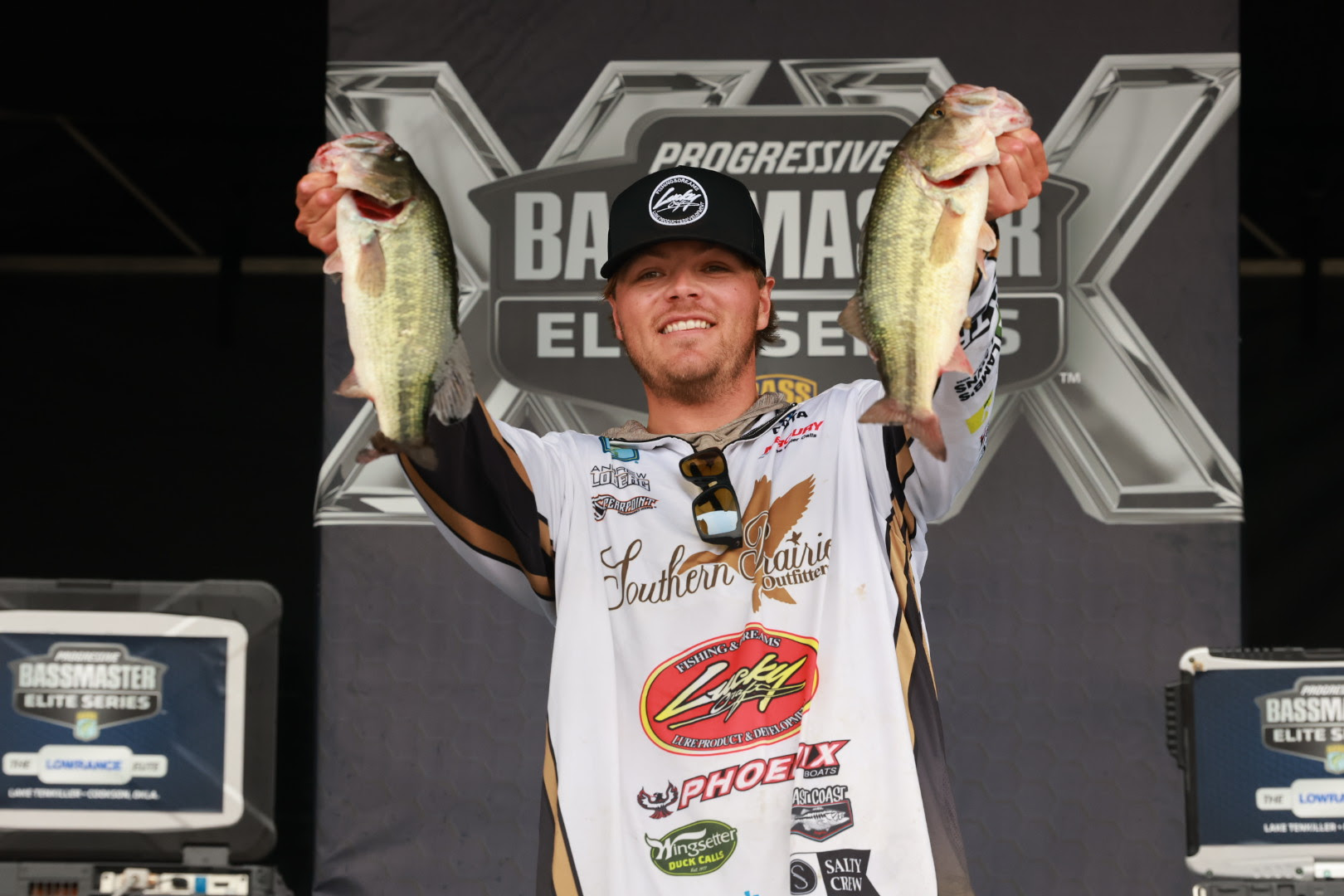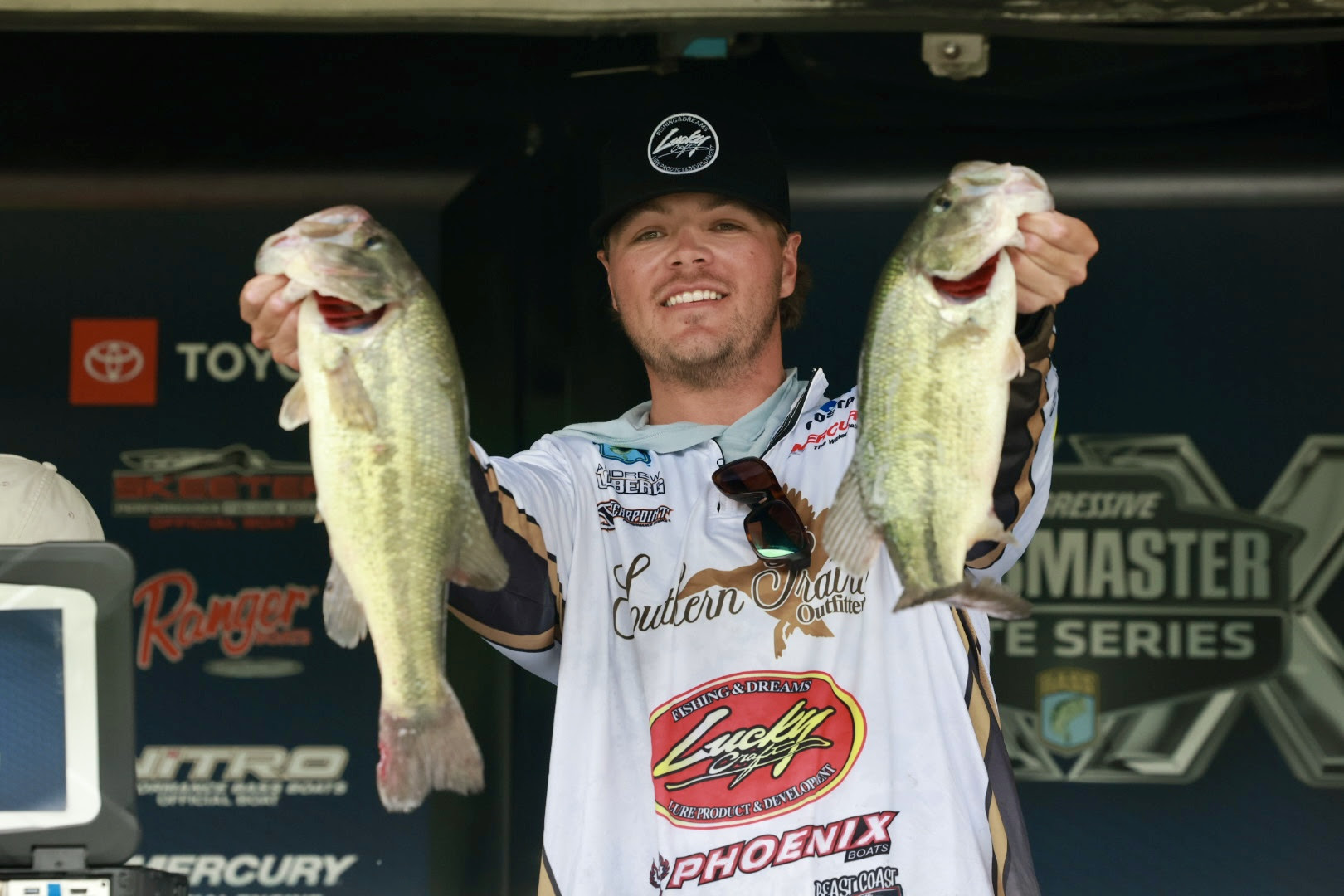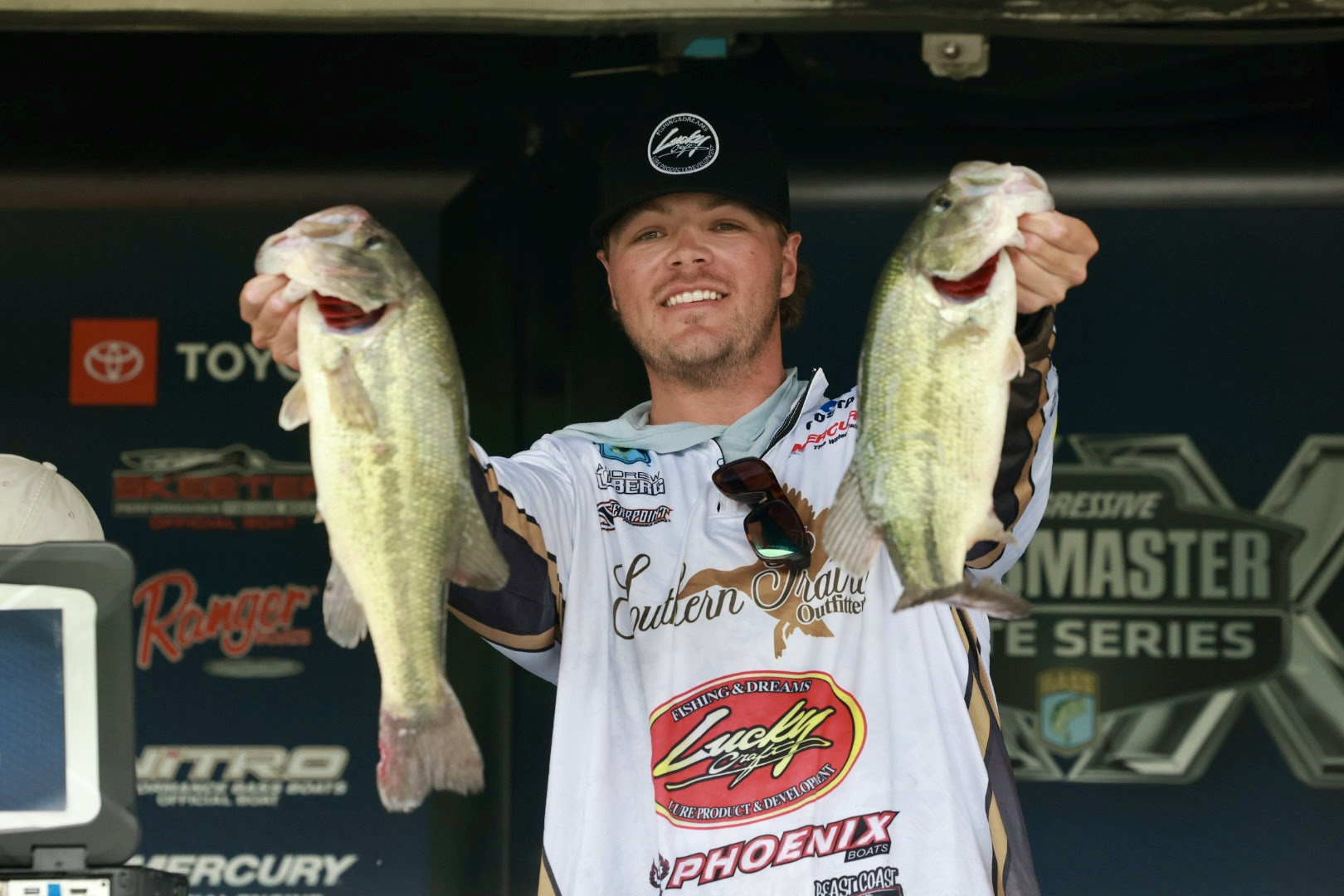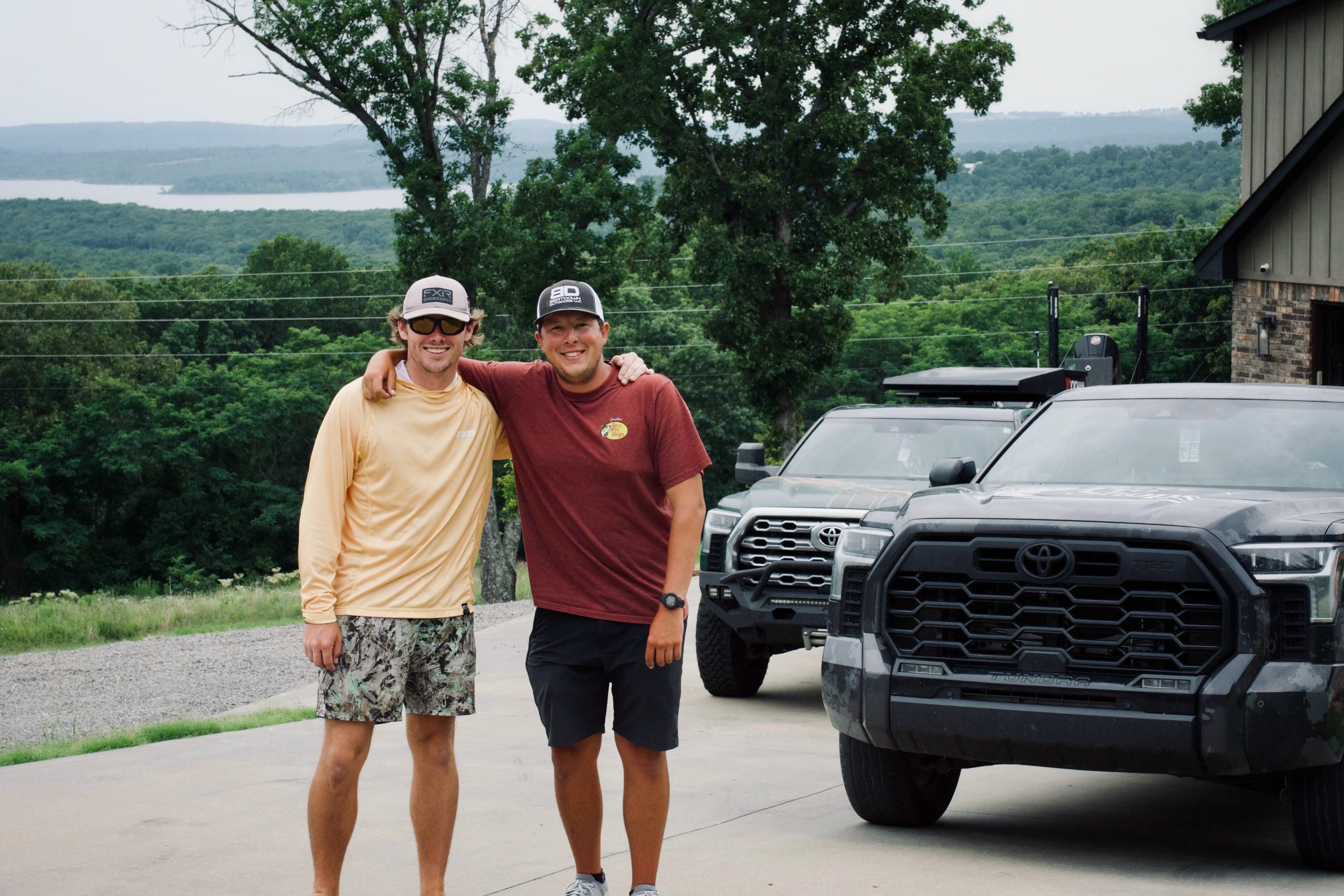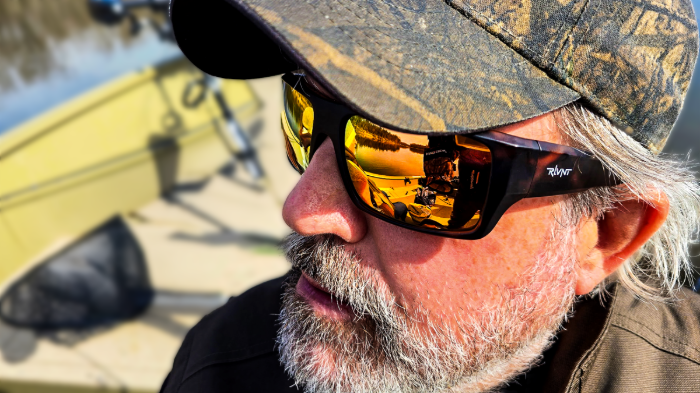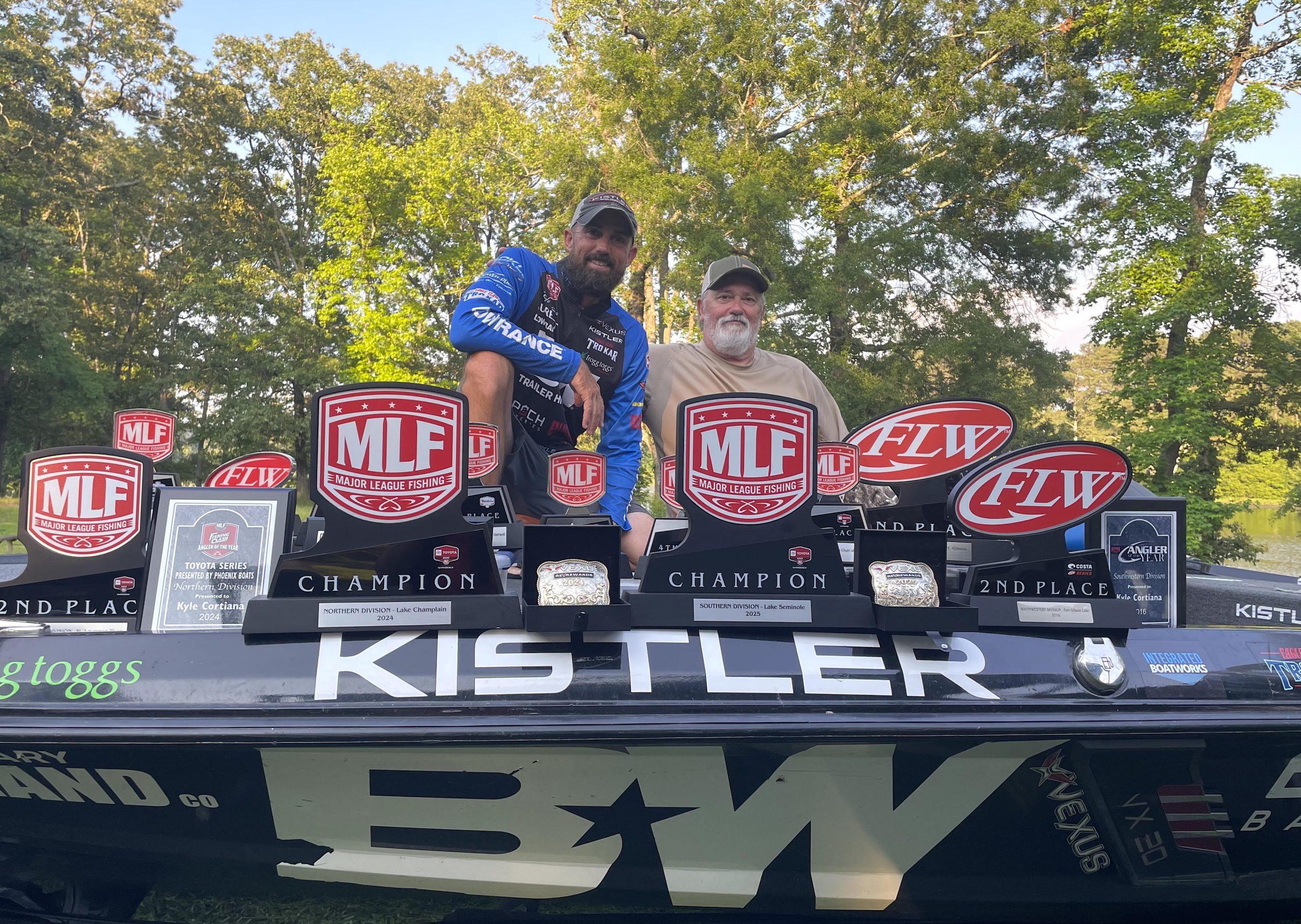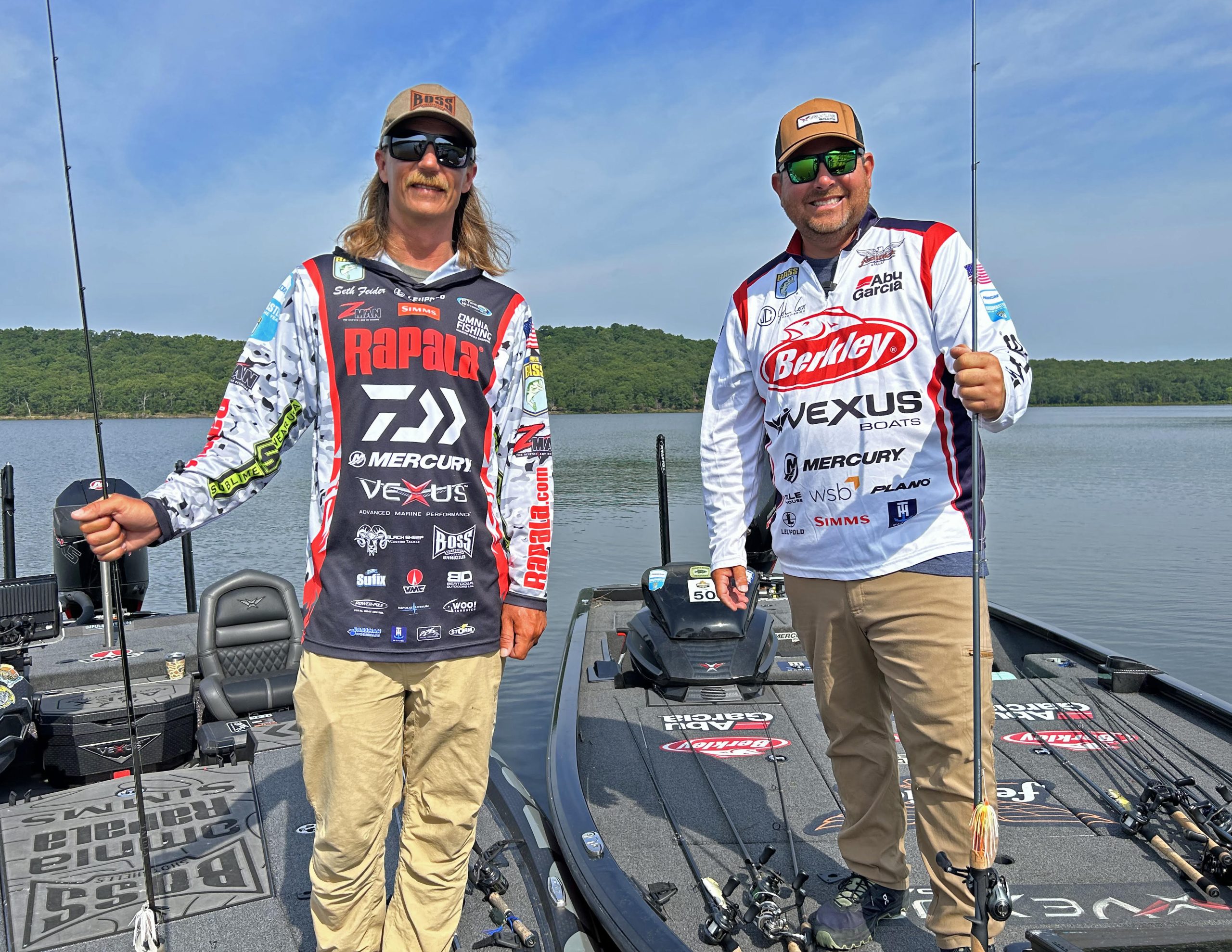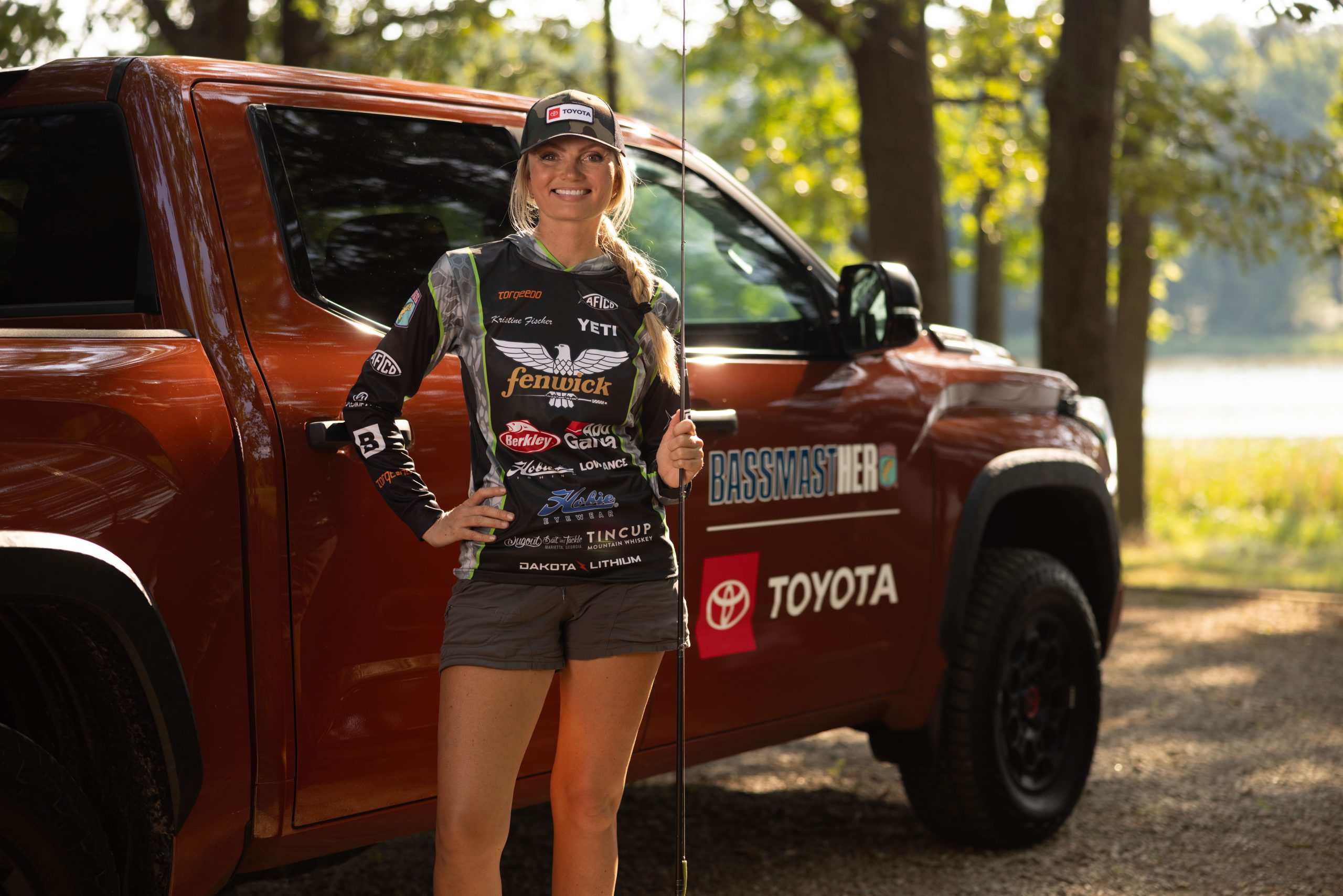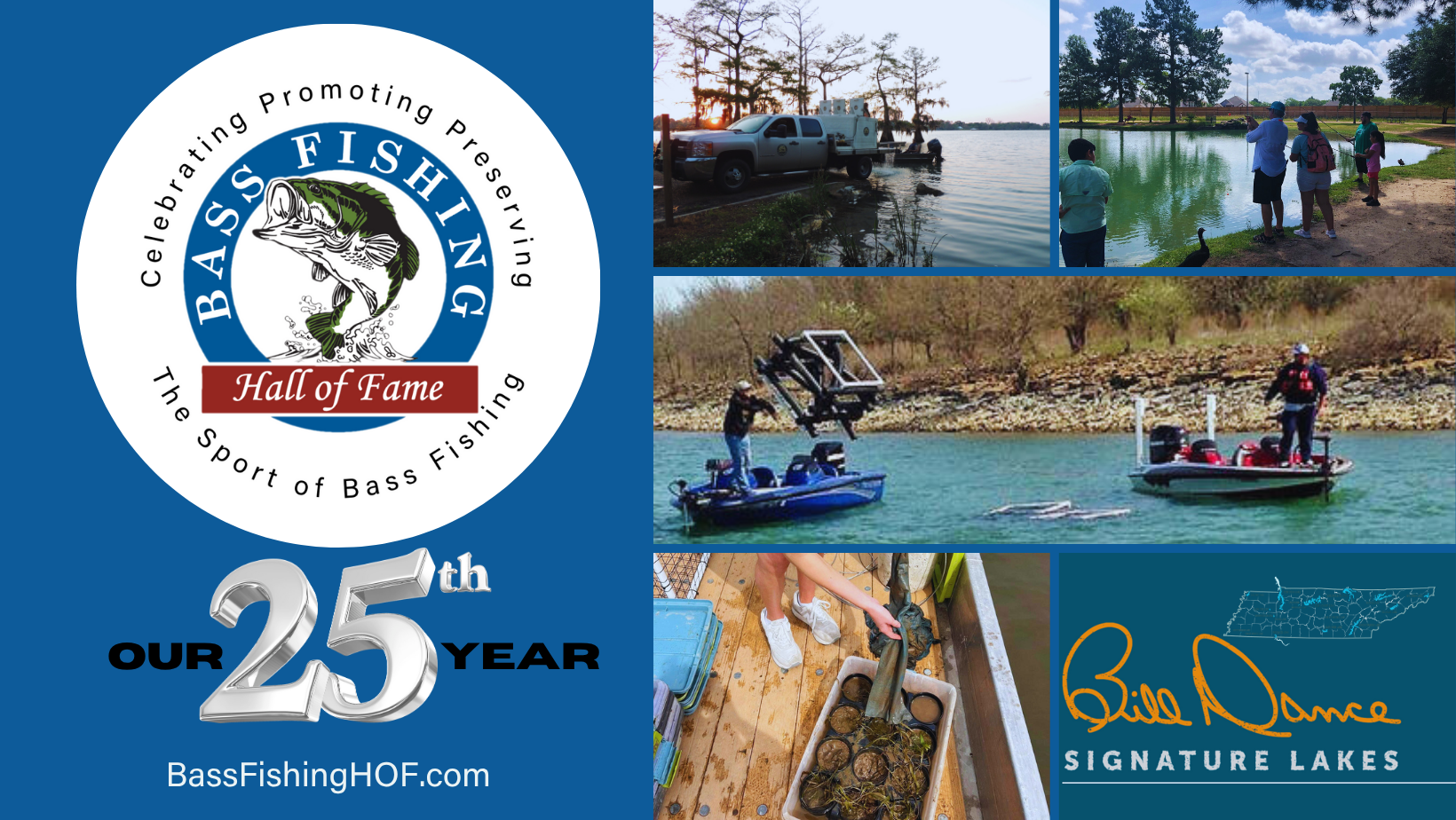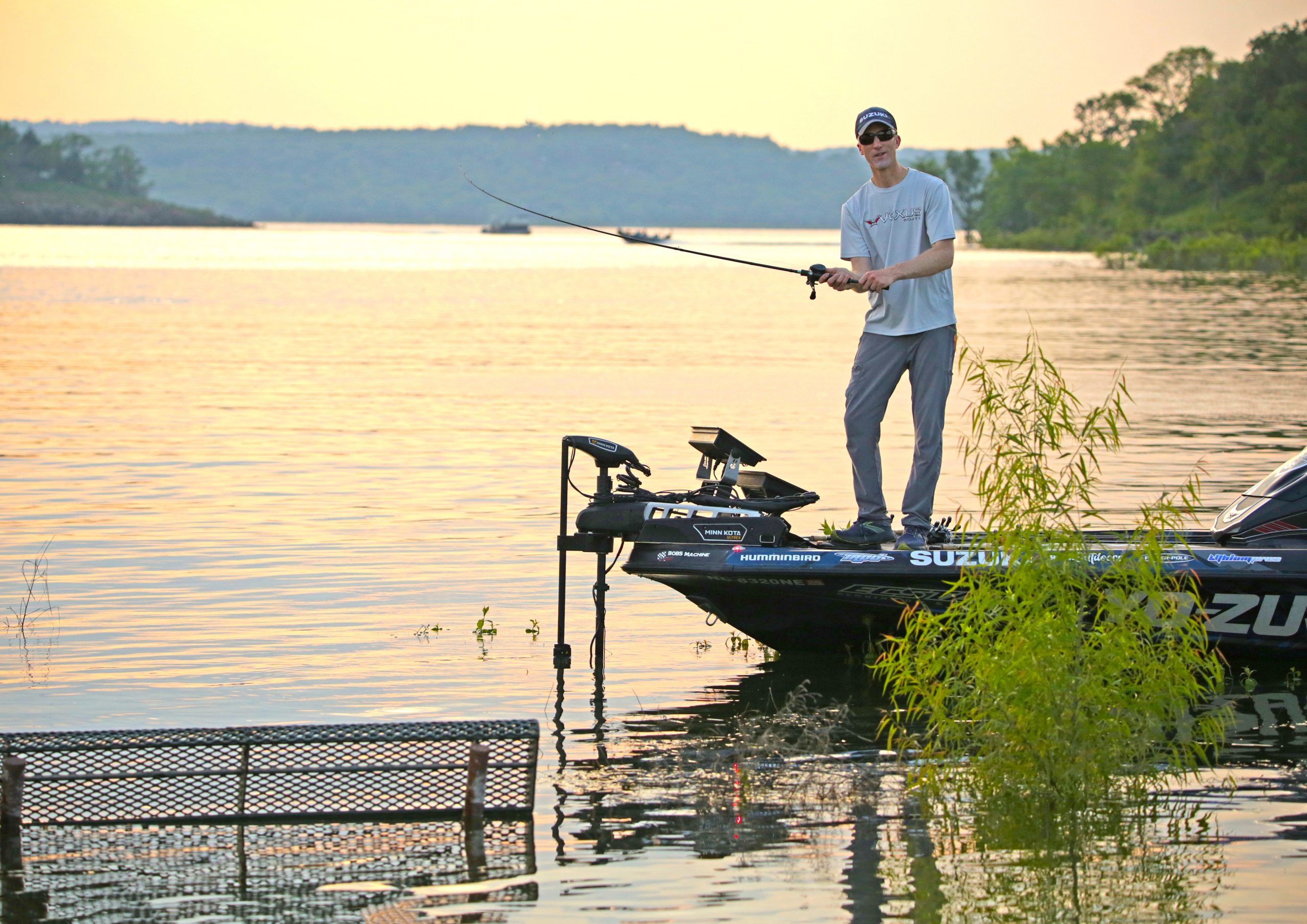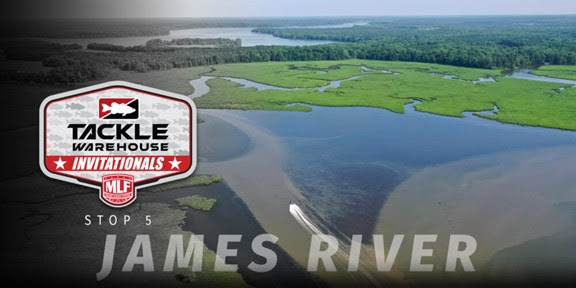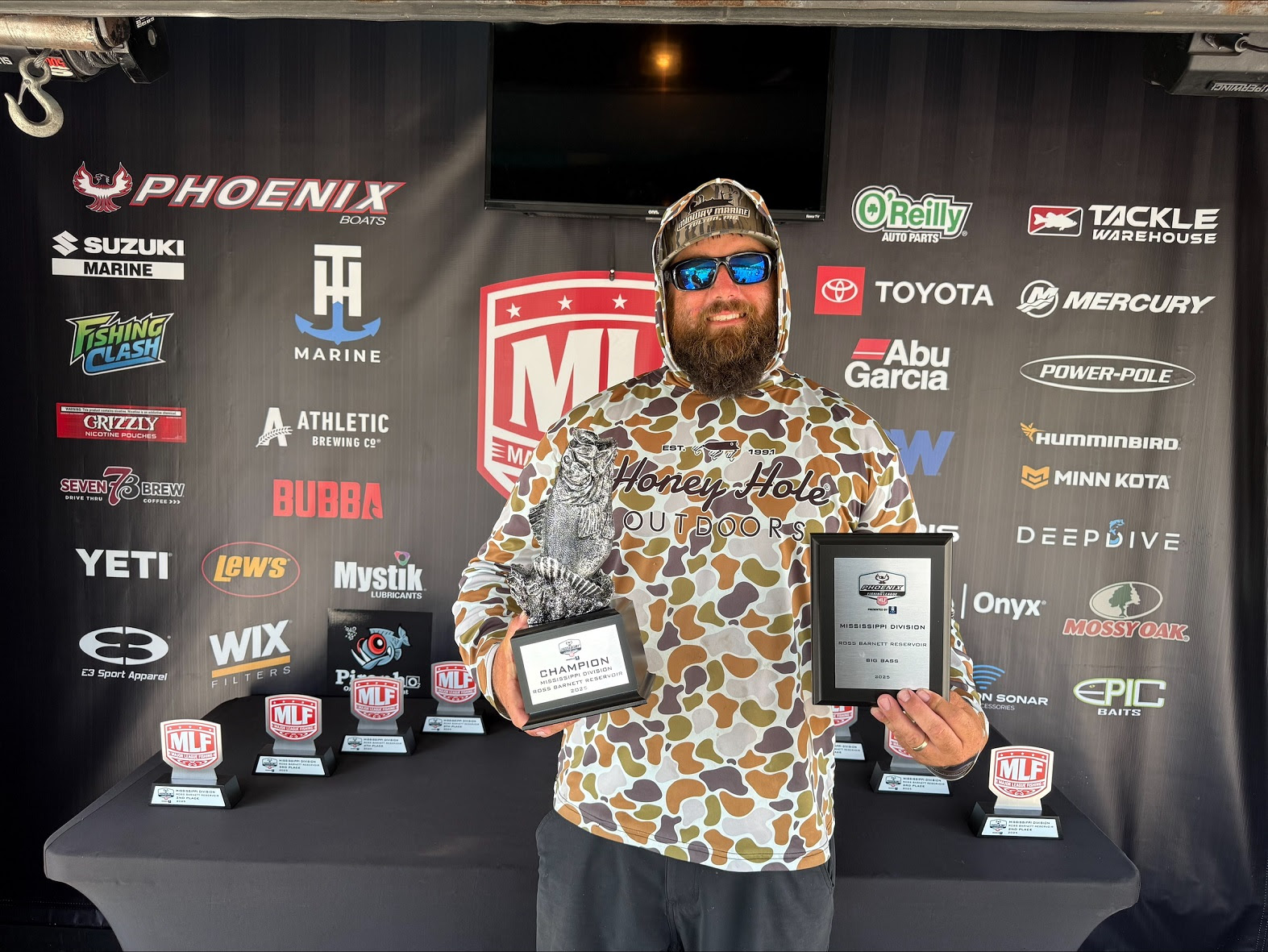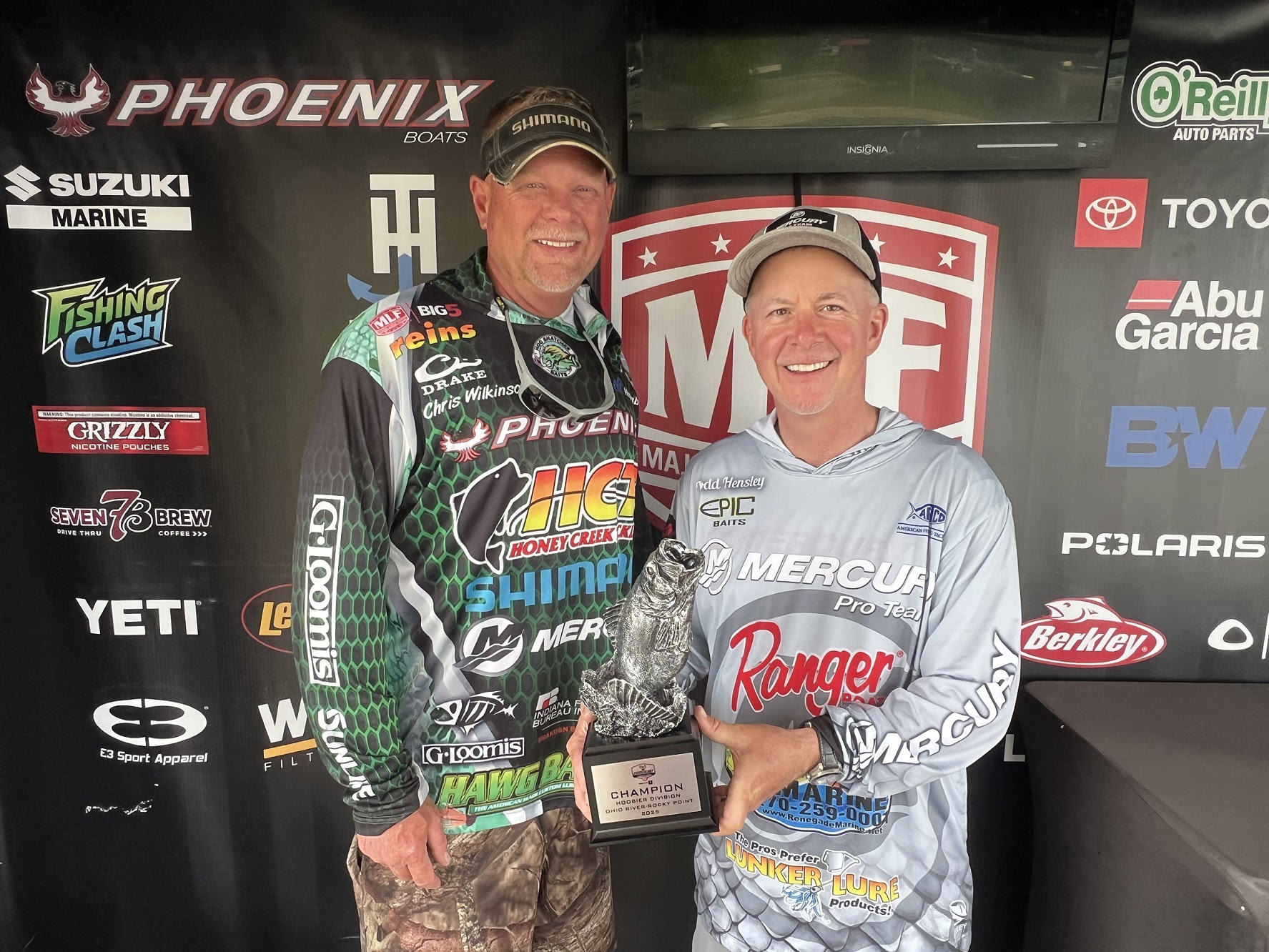Cartersville Fishing Team Goes Wire-to-Wire to Win 16th Annual High School Fishing National Championship on Grand Lake
GROVE, Okla. (June 30, 2025) – In the days leading up to their arrival in Oklahoma for the 2025 Abu Garcia High School Fishing National Championship on Grand Lake, Georgia-based Cartersville Fishing Team teammates Cooper Moon and Carson Holbert thought that their chances of winning the nearly 400-boat tournament were, in their words, “a long shot.”
But within a 30-minute span on Day 1 – after catching 12 quick pounds en route to a tournament best of 15 pounds, 12 ounces – “long shot” turned to “Dude, I think we have a shot at this” for the Cartersville Fishing Team pair.
Two days and 44 pounds later, Moon and Holbert are leaving Grand Lake with a pair of trophies, matching $5,000 checks to spend on college, and the title of 2025 National Champions. The Georgia high school seniors sacked up 13-15 on the final day to finish the three-day event with 44-1 – good enough for a 3-pound win over Dylan Sorrells and Andrew Waters (41-1) of the Texas Highland Park Bass Team.
“We came out here with an open mind, learned as much about the lake as we could in practice, and kind of just worked our way through it, day by day,” Holbert said. “There were almost 400 teams fishing, so we knew it was a little bit of a long shot just because of the numbers. But we figured out a few things that got us onto bigger fish and ran with it.”
Moon and Holbert spent the majority of their tournament fishing what they referred to as “transitional” water – rocky structure in 8 to 12 feet of water that seemed to harbor bigger-than-average fish while remaining impervious to the fluctuating water on Grand Lake. They started the tournament with 15-12 on Day 1 and held onto the lead with 14-6 on Day 2 before finishing with 13-15 on Friday to secure the win.
The teams of Carson Mowdy and Colton Stewart of the Milano Eagles (37-10); Jackson Roumbanis and Lawson Lewis of the Russellville Cyclones (37-4); and Wyatt Woods and Wyatt McBride of Lexington High School (35-5) rounded out the Top 5.
Moon and Holbert were meticulous in their pre-tournament research and invested ample time leading up to the National Championship collecting facts and trends about Grand Lake (which they put to use practicing on a handful of lakes local to them that approximated Grand). They identified the basics of their winning pattern on Day 1 of practice, then spent the rest of practice eliminating water and techniques. The duo started the tournament with a basic plan to fish crankbaits over mid-depth rock while most of the other teams either fished shallow or on main-river offshore spots.
“We weren’t back in the bushes, and we weren’t on the main river ledge stuff that other people found them on – we wanted to stay in that transitional zone where the water would be somewhat more stable and fish didn’t move very much,” Moon said. “If the water came up a few feet, they’d be in maybe 12 feet of water; when it came down, they’d move to 8 feet. They’d only have to move maybe 20 feet. I think it was just the area where they felt safe and could feed.”
Holbert and Moon fished a variety of crankbaits from various manufacturers, almost all in shad colors, each working different depths and retrieves until they found the magic combination that touched off a flurry. They knew they found the right pattern early on Day 1.
“We caught 12 pounds in 30 minutes on our first spot on Day 1 and thought ‘We might be putting ourselves in contention here,’” Holbert said. “We had heard mixed reviews all week about people catching them just OK or not catching them. It didn’t seem that the lake was fishing that great for a lot of the teams, so we felt good about that first day.”
They picked right up in the same area on Day 2, despite being in a late flight and some increased pressure on their main spot. The pressure didn’t seem to affect Moon and Holbert as they plucked 13 pounds from that spot within 15 minutes, setting themselves up for the final day.
“We had some boats fishing around our spot, but they weren’t doing what we were doing,” Holbert said. “Everybody was doing the same thing, but we were working the bait right, hitting the angles right, doing everything efficiently.”
They arrived to a ripping current on their key spot the final morning as water managers pulled water, which played right into Holbert and Moon’s hands.
“They pulled a ton of current Friday, those fish wanted something moving, and fast,” Moon said. “We had lost a big fish on that spot just before weigh-in on Day 2, and when we went back to it on the final day, it was loaded. We caught a 5 and a 4 on one bait and had total chaos for about 10 minutes before the school broke up a little.”
“We knew we were around the fish to win,” Holbert said. “It was just a matter of getting the right bites and getting them at the right times when they were setting up to feed. Getting them in the boat was a big thing, too. We’d get a lot of bites in a flurry, and then it would go pretty dead. We knew we needed to take advantage of every bite, especially on those bigger fish.”
Moon and Holbert’s National Championship partnership will eventually lead them both to Montevallo University in Alabama – both have declared to fish for the College Fishing powerhouse, now with $5,000 apiece to help with expenses.
“We met back in July of 2024 – both of us were looking for a partner who was committed to travel the whole country and be serious about it,” Holbert said. “We’ve fished together very well from the beginning and have some experience fishing giant tournaments. Going into this week, we wanted to look for more sneaky stuff that people hadn’t looked at. It really worked out for us.”
The Top 10 teams at the 2025 Abu Garcia High School Fishing National Championship on Grand Lake finished:
1st: Cartersville Fishing Team – Cooper Moon, White, Ga., and Carson Holbert, Louisville, Tenn., nine bass, 44-1
2nd: Highland Park Bass Team – Dylan Sorrells, Dallas, Texas, and Andrew Waters, Melissa, Texas, nine bass, 41-1
3rd: Milano Eagles – Carson Mowdy and Colton Stewart, both of Milano, Texas, nine bass, 37-10
4th: Russellville Cyclones – Jackson Roumbanis, Russellville, Ark., and Lawson Lewis, Knoxville, Ark., nine bass, 37-4
5th: Lexington High School Bulldogs – Wyatt Woods and Wyatt McBride, both of Lexington, Okla., nine bass, 35-5
6th: Haughton Fishing Team – Carsen Adcock, Haughton, La., and Colton Arnold, Hope, Ark., nine bass, 35-1
7th: SoCal Jr. Bass Anglers – Brenner Lynn, San Diego, Calif., and Bryce Deheyn, San Marcos, Calif., nine bass, 34-14
8th: Saint Xavier High School – Miles Allen, Louisville, Ky., and Ethan Roths, Prospect, Ky., nine bass, 33-12
9th: Track & Channel Youth – Wesson Vint, Syracuse, Ind., and JJ Gruber, Mishawaka, Ind., nine bass, 32-15
10th: Camdenton High School – Corbin Bailey and Kaden Messina, both of Camdenton, Mo., nine bass, 32-0
Complete results for the entire field can be found at HighSchoolFishing.org.
The 2025 Abu Garcia High School Fishing National Championship Presented by Tackle Warehouse on Grand Lake was hosted by the Grove Convention & Tourism Bureau. MLF High School Fishing tournaments are free, two-person (team) events for students in grades 7-12 and are open to any MLF and TBF Student Angler Federation-affiliated high school club. The top 10 percent of teams at each Open event, along with the TBF High School Fishing state championships, advanced to the 2025 High School Fishing National Championship.
In addition to the college scholarships and prizes offered, the 2025 High School Fishing National Champions – Moon and Holbert – will also advance to compete as co-anglers at the 2025 MLF Toyota Series Championship, held Nov. 6-8 on Grand Lake in Grove, Oklahoma, and a shot at the top prize of a new Phoenix 518 Pro boat with a 115-horsepower outboard.
Proud sponsors of the MLF Abu Garcia High School Fishing Presented by Tackle Warehouse include: 7Brew, Abu Garcia, B&W Trailer Hitches, Berkley, BUBBA, Columbia PFG, Deep Dive, E3 Sport Apparel, Epic Baits, Fishing Clash, Humminbird, Lew’s, Mercury, Minn Kota, Mossy Oak, Onyx, O’Reilly Auto Parts, Phoenix Boats, PiranhO2, Polaris, Power-Pole, Precision Sonar, Strike King, Suzuki Marine, Tackle Warehouse, T-H Marine, Toyota, WIX Filters and YETI.
For complete details and updated tournament information, visit HighSchoolFishing.org. For regular High School Fishing updates, photos, tournament news and more, follow High School Fishing on Facebook and on MLF5’s social media outlets at Facebook, Instagram and YouTube.
About Major League Fishing
Major League Fishing (MLF) is the world’s largest tournament-fishing organization, producing more than 250 events annually at some of the most prestigious fisheries in the world, while broadcasting to America’s living rooms on CBS, Discovery Channel, Outdoor Channel, CBS Sports Network, World Fishing Network and on demand on MyOutdoorTV (MOTV). Headquartered in Benton, Kentucky, the MLF roster of bass anglers includes the world’s top pros and more than 30,000 competitors in all 50 states and 20 countries. Since its founding in 2011, MLF has advanced the sport of competitive fishing through its premier television broadcasts and livestreams and is dedicated to improving the quality of life for bass through research, education, fisheries enhancement and fish care.
Drake Sturgill from the University of Montevallo Receives the First Annual Travis Ely Memorial Scholarship
|
|
Ohio’s Fain Gets Career Win No. 2 at Phoenix Bass Fishing League Event at Detroit River Presented by Lew’s
Ypsilanti’s Bucciarelli Tops Co-Angler Division
TRENTON, Mich. (June 30, 2025) – Boater Ty Fain of Springfield, Ohio, caught a five-bass limit weighing 23 pounds, 3 ounces, Saturday to win the MLF Phoenix Bass Fishing League (BFL) Presented by T-H Marine on the Detroit River Presented by Lew’s. The tournament was the first event of the season for the BFL Michigan Division. Fain earned $4,385 for his victory.
“I made a long boat ride all the way out to Pelee (an area on the Canadian side of Lake Erie),” Fain said. “I fished anywhere from 10 to 20 foot of water. I fished a little bit on the north shore of Lake Erie, too, and I caught 20 to 25 fish all on a drop-shot.”
Fain’s decision to run out to the famed Pelee area came down to his history in that part of the lake, and “just being comfortable” in that area. Of course, it helped that the weather was nice enough for him to make it there and back in a reasonable amount of time. The trip left him about 2 1/2 hours to fish around Pelee and a couple more hours on the north shore. His primarily lures included smallmouth staples like a Berkley PowerBait MaxScent Flat Worm and Flatnose Minnow.
“I would say they were decently spread out,” added Fain about the smallmouth bass he was targeting. “It wasn’t like a real tight group of fish or anything like that.”
The top 10 boaters finished the tournament:
1st: Ty Fain, Springfield, Ohio, five bass, 23-3, $4,385
2nd: Cody Kelley, Plainwell, Mich., five bass, 22-10, $2,193
3rd: Aaron Jagdfeld, Rochester, Mich., five bass, 22-9, $2,063 (includes $500 Phoenix MLF Contingency Bonus)
4th: Nolan Mandel, Kimball, Mich., five bass, 22-5, $1,023
5th: Brock Vogel, Perrysburg, Ohio, five bass, 22-2, $877
6th: Lucas Toliver, Paw Paw, Mich., five bass, 21-9, $804
7th: Joshua Barr, Louisville, Ohio, five bass, 20-0, $731
8th: Mike Trombly, Belleville, Mich., five bass, 19-15, $585
8th: Cody Dawson, Mount Vernon, Ohio, five bass, 19-15, $585
8th: Clinton Moring, Fort Wayne, Ind., five bass, 19-15, $585
Complete results can be found at MajorLeagueFishing.com.
Jesse Hickman of Waynesville, Ohio, caught a bass that weighed 6 pounds, 6 ounces, and earned the Berkley Big Bass Boater award of $620.
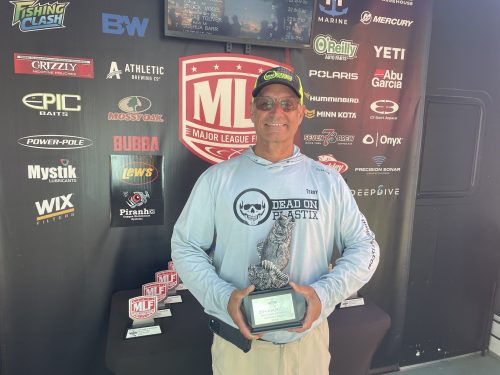
Terry Bucciarelli of Ypsilanti, Michigan, won the co-angler division and $2,593 Saturday, after bringing three bass to the scale that totaled 12 pounds, 15 ounces.
The top 12 co-anglers finished:
1st: Terry Bucciarelli, Ypsilanti, Mich., three bass, 12-15, $2,593
2nd: Brian Ruetz, Toledo, Ohio, three bass, 12-3, $1,096
3rd: Rosario Murello, Greenwood, Ind., three bass, 12-1, $730
4th: Cody Salzmann, Southgate, Mich., three bass, 11-13, $512
5th: Mark Lyons, Marion, Ind., three bass, 11-7, $439
6th: Steve Doak, Sylvania, Ohio, three bass, 11-3, $402
7th: James Welch, Litchfield, Maine, three bass, 10-15, $415
8th: Klaus Kuester, Forest Park, Ill., three bass, 10-14, $329
9th: Philip Castrodale, West Bloomfield, Mich., three bass, 10-11, $292
10th: Scott Sims, Morgantown, Ind., three bass, 10-10, $232
10th: Ryan Legg, Parma, Ohio, three bass, 10-10, $232
10th: Stephen Waggoner, New Whiteland, Ind., three bass, 10-10, $232
Joseph Gnaster of Crown Point, Indiana, earned the Berkley Big Bass co-angler award of $310, catching a bass that weighed in at 4 pounds, 12 ounces – the largest co-angler catch of the day.
In addition to winning the event, Ty Fain of Springfield, Ohio, has the early lead in the Fishing Clash Michigan Division Angler of the Year (AOY) race with 250 points, while Terry Bucciarelli of Ypsilanti, Michigan, leads the Fishing Clash Michigan Division Co-Angler of the Year race with 250 points.
The next event for BFL Michigan Division anglers will be held July 12, at the Detroit River out of Trenton, Michigan. To register for the event as a boater or a co-angler, visit MajorLeagueFishing.com or call (270)-252-1000.
The top 60 boaters and co-anglers in the division based on point standings, along with the five tournament winners of each qualifying event, will qualify for the Oct. 3-4 BFL Regional tournament on Lake Erie in Sandusky, Ohio. Boaters will fish for a top award of a new Phoenix 819 Pro with a 200-horsepower Mercury or Suzuki outboard worth $50,000, while co-anglers will compete for a top award of $20,000.
The 2025 Phoenix BFL Presented by T-H Marine is a 24-division circuit devoted to weekend anglers, with 134 events throughout the season, five qualifying tournaments in each division. The top 60 boaters and co-anglers from each division, along with the five qualifying tournament winners, will advance to one of 12 BFL Regional tournaments where they are competing to finish in the top three, which then qualifies them for one of the longest-running championships in all of competitive bass fishing – the BFL All-American.
Proud sponsors of the 2025 MLF Phoenix Bass Fishing League Presented by T-H Marine include: 7Brew, Abu Garcia, Athletic Brewing, B&W Trailer Hitches, Berkley, BUBBA, Deep Dive App, E3 Sport Apparel, Epic Baits, Fishing Clash, Grizzly, Humminbird, Lew’s, Li Time Batteries, Mercury, Minn Kota, Mossy Oak, Mystik Lubricants, Onyx, O’Reilly Auto Parts, Phoenix Boats, Polaris, Power-Pole, Precision Sonar, Strike King, Suzuki Marine, Tackle Warehouse, T-H Marine, Toyota, WIX Filters and YETI.
For complete details and updated tournament information, visit MajorLeagueFishing.com. For regular Bass Fishing League updates, photos, tournament news and more, follow MLF5’s social media outlets at Facebook, Instagram, and YouTube.
About Major League Fishing
Major League Fishing (MLF) is the world’s largest tournament-fishing organization, producing more than 250 events annually at some of the most prestigious fisheries in the world, while broadcasting to America’s living rooms on CBS, Discovery Channel, Outdoor Channel, CBS Sports Network, World Fishing Network and on demand on MyOutdoorTV (MOTV). Headquartered in Benton, Kentucky, the MLF roster of bass anglers includes the world’s top pros and more than 30,000 competitors in all 50 states and 20 countries. Since its founding in 2011, MLF has advanced the sport of competitive fishing through its premier television broadcasts and livestreams and is dedicated to improving the quality of life for bass through research, education, fisheries enhancement and fish care.
South Carolina’s Wicker Earns First Win at Phoenix Bass Fishing League Event at Clarks Hill Lake
South Carolina’s Chadwick Tops Co-Angler Division
APPLING, Ga. (June 30, 2025) – Boater Andy Wicker of Cayce, South Carolina, caught a five-bass limit weighing 14 pounds, 12 ounces, Saturday to win the MLF Phoenix Bass Fishing League (BFL) Presented by T-H Marine on Clarks Hill Lake. The tournament was the fourth event of the season for the BFL Savannah River Division. Wicker earned $4,259 for his victory.
For Wicker, the shallow bite never really happened. And while he wanted to go chase suspended schoolers, he never really unlocked how to catch big fish using that approach. So, with a three-bass limit in effect for this tournament, he decided to slow down and go fish with confidence for a few good bites using an old-school approach.
“I was basically just throwing a worm around,” he said. “I caught the big one (a 6-pound, 10-ounce bass) out of a brush pile. The other ones were just on stereotypical summer places – rocks and brush mostly. I started dragging a worm around old-school style.
“The three-fish limit I think was pretty key,” he added. “I don’t know that I would’ve done what I did with a five-fish limit. I probably would’ve wanted to chase schooling fish or suspended fish. It (the three-fish limit) makes it easier mentally to just go throw a big worm and get three bites.”
In most brush pile events, Wicker prefers to have a big milk run. But he only had a half-day to practice. So he stuck to one primary area, running from target to target with a Zoom Ol’ Monster.
“I got a fair amount of bites,” he added. “I guess it was tough and it wasn’t. I have a couple brush piles that are really good, but outside of those there’s a lot of dead brush. So you can go a long time in between bites.”
The top 10 boaters finished the tournament:
1st: Andy Wicker, Cayce, S.C., three bass, 14-12, $4,259
2nd: Wesley Sandifer, Chapin, S.C., three bass, 12-9, $1,840
3rd: Dan Geurtsen, Chapin, S.C., three bass, 12-0, $1,225
4th: Eric Allen, Powder Springs, Ga., three bass, 11-10, $859
5th: Lane Parker, Waleska, Ga., three bass, 10-13, $736
6th: Greg Rikard, Leesville, S.C., three bass, 10-10, $1,300 (includes $500 Phoenix MLF Contginency Bonus)
7th: Caleb Sheldon, West Columbia, S.C., three bass, 10-7, $613
8th: Bart Blackburn, North Augusta, S.C., three bass, 10-5, $552
9th: Matt O'Connell, Brooks, Ga., three bass, 9-14, $491
10th: Michael Wilson, Burnsville, N.C., three bass, 9-13, $429
Complete results can be found at MajorLeagueFishing.com.
Wicker caught a bass that weighed 6 pounds, 10 ounces, and earned the Berkley Big Bass Boater award of $480.
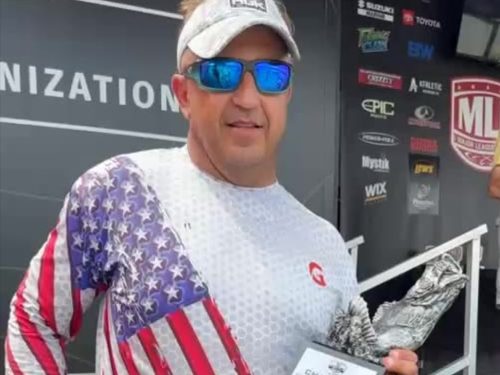
Tim Chadwick of Mount Pleasant, South Carolina, won the co-angler division and $1,840 Saturday, after bringing three bass to the scale that totaled 9 pounds, 6 ounces.
The top 10 co-anglers finished:
1st: Tim Chadwick, Mount Pleasant, S.C., three bass, 9-6, $1,840
2nd: Gibson Huntley, Inman, S.C., three bass, 8-6, $920
3rd: Jeff Rikard, Leesville, S.C., three bass, 7-1, $520
3rd: Dwayne Parton, Anderson, S.C., three bass, 7-1, $520
5th: James Akins, Cumming, Ga., three bass, 6-15, $352
5th: Ashton Mabery, Wellford, S.C., three bass, 6-15, $352
7th: Jason Wood, Windsor, S.C., three bass, 6-10, $307
8th: Chase Gurkin, Simpsonville, S.C., three bass, 6-8, $276
9th: Jackson Williams, Keysville, Ga., three bass, 6-6, $245
10th: Benjie Winkler, Cleveland, Ga., three bass, 5-14, $215
Joe Smith of Sardis, Georgia, earned the Berkley Big Bass co-angler award of $240, catching a bass that weighed in at 4 pounds, 12 ounces – the largest co-angler catch of the day.
After four events, Lane Parker of Waleska, Georgia, now leads the Fishing Clash Savannah River Division Angler of the Year (AOY) race with 963 points, while Rusty Odom of Simpsonville, South Carolina, leads the Fishing Clash Savannah River Division Co-Angler of the Year race with 965 points.
The next event for BFL Savannah River Division anglers will be held Sept. 27-28, at Lake Hartwell in Anderson, South Carolina. To register for the event as a boater or a co-angler, visit MajorLeagueFishing.com or call (270)-252-1000.
The top 60 boaters and co-anglers in the division based on point standings, along with the five tournament winners of each qualifying event, will qualify for the Oct. 10-11 BFL Regional tournament on Lake Murray in Columbia, South Carolina. Boaters will fish for a top award of a new Phoenix 819 Pro with a 200-horsepower Mercury or Suzuki outboard worth $50,000, while co-anglers will compete for a top award of $20,000.
The 2025 Phoenix BFL Presented by T-H Marine is a 24-division circuit devoted to weekend anglers, with 134 events throughout the season, five qualifying tournaments in each division. The top 60 boaters and co-anglers from each division, along with the five qualifying tournament winners, will advance to one of 12 BFL Regional tournaments where they are competing to finish in the top three, which then qualifies them for one of the longest-running championships in all of competitive bass fishing – the BFL All-American.
Proud sponsors of the 2025 MLF Phoenix Bass Fishing League Presented by T-H Marine include: 7Brew, Abu Garcia, Athletic Brewing, B&W Trailer Hitches, Berkley, BUBBA, Deep Dive App, E3 Sport Apparel, Epic Baits, Fishing Clash, Grizzly, Humminbird, Lew’s, Li Time Batteries, Mercury, Minn Kota, Mossy Oak, Mystik Lubricants, Onyx, O’Reilly Auto Parts, Phoenix Boats, Polaris, Power-Pole, Precision Sonar, Strike King, Suzuki Marine, Tackle Warehouse, T-H Marine, Toyota, WIX Filters and YETI.
For complete details and updated tournament information, visit MajorLeagueFishing.com. For regular Bass Fishing League updates, photos, tournament news and more, follow MLF5’s social media outlets at Facebook, Instagram, and YouTube.
About Major League Fishing
Major League Fishing (MLF) is the world’s largest tournament-fishing organization, producing more than 250 events annually at some of the most prestigious fisheries in the world, while broadcasting to America’s living rooms on CBS, Discovery Channel, Outdoor Channel, CBS Sports Network, World Fishing Network and on demand on MyOutdoorTV (MOTV). Headquartered in Benton, Kentucky, the MLF roster of bass anglers includes the world’s top pros and more than 30,000 competitors in all 50 states and 20 countries. Since its founding in 2011, MLF has advanced the sport of competitive fishing through its premier television broadcasts and livestreams and is dedicated to improving the quality of life for bass through research, education, fisheries enhancement and fish care.
Gallatin’s Womack Frogs and Flips for the Win at Phoenix Bass Fishing League Event at Old Hickory Lake
Ashland City’s Pillars Tops Co-Angler Division
GALLATIN, Tenn. (June 30, 2025) – Boater Josh Womack of Gallatin, Tennessee, caught a three-bass limit weighing 11 pounds, 14 ounces, Saturday to win the MLF Phoenix Bass Fishing League (BFL) Presented by T-H Marine on Old Hickory Lake . The tournament was the fourth event of the season for the BFL Music City Division. Womack earned $10,434, including the lucrative $7,000 Phoenix MLF Contingency Bonus, for his victory.
“I started out this morning, just went up shallow and threw a frog around and caught several keepers,” Womack said. “I think maybe one of the fish I weighed in was one of the ones I caught on a frog, but I didn’t have any big ones. The rest of the day I just kind of ran around and flipped shallow wood with a (Zoom) Brush Hog. And that’s how I caught the rest of my fish.”
Womack’s frog bite was primarily around water willow grass. When he switched to wood, Womack flipped targets on the main river in 5 to 6 feet of water – some wood he could see and some that was submerged. He caught 15 to 20 keepers.
The top 11 boaters finished the tournament:
1st: Josh Womack, Gallatin, Tenn., three bass, 11-14, $10,434 (includes $7,000 Phoenix MLF Contingency Bonus)
2nd: Austin True, Dickson, Tenn., three bass, 11-8, $1,802
3rd: Daniel Johnson, Lebanon, Tenn., three bass, 11-3, $830
3rd: Brandon Edel, Hendersonville, Tenn., three bass, 11-3, $830
5th: Hunter Bouldin, McMinnville, Tenn., three bass, 10-12, $587
6th: John Hopkins, Hendersonville, Tenn., three bass, 10-10, $538
7th: Tim Messer, Hendersonville, Tenn., three bass, 10-8, $489
8th: Larry Crisp, Gallatin, Tenn., three bass, 10-7, $440
9th: Christopher Stites Sr., Lebanon, Tenn., three bass, 10-2, $391
10th: Trevor Sanford, Lebanon, Tenn., three bass, 10-0, $325
10th: Corey Steakley, Lebanon, Tenn., three bass, 10-0, $325
Complete results can be found at MajorLeagueFishing.com.
Austin True of Dickson, Tennessee, caught a bass that weighed 5 pounds, 10 ounces, and earned the Berkley Big Bass Boater award of $335.
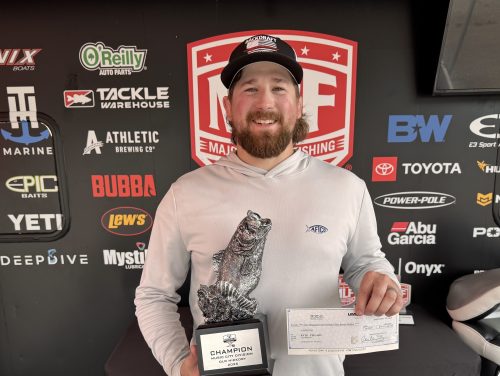
Kyle Pillars of Ashland City, Tennessee, won the co-angler division and $1,467 Saturday, after bringing three bass to the scale that totaled 10 pounds, 5 ounces.
The top 10 co-anglers finished:
1st: Kyle Pillars, Ashland City, Tenn., three bass, 10-5, $1,467
2nd: Chris Seese, Ten Mile, Tenn., three bass, 9-2, $733
3rd: Josh Underhill, Watertown, Tenn., three bass, 8-2, $490
4th: Scott Duncan, Lebanon, Tenn., three bass, 7-14, $317
4th: Trevor Medley, Sparta, Tenn., three bass, 7-14, $317
6th: Tommy Pritchard, Bargersville, Ind., three bass, 7-13, $486
7th: David Marr, Cleveland, Tenn., three bass, 7-9, $232
7th: Wayne Crouch, Jamestown, Tenn., three bass, 7-9, $332
9th: Mark Redman, Scottsville, Ky., three bass, 7-4, $196
10th: Brad Thacher, Murray, Ky., three bass, 7-2, $171
Tommy Pritchard of Bargersville, Indiana, earned the Berkley Big Bass co-angler award of $167, catching a bass that weighed in at 4 pounds, 8 ounces – the largest co-angler catch of the day.
After four events, Hunter Bouldin of McMinnville, Tennessee, now leads the Fishing Clash Music City Division Angler of the Year (AOY) race with 985 points, while Tommy Pritchard of Bargersville, Indiana, leads the Fishing Clash Music City Division Co-Angler of the Year race with 974 points.
The next event for BFL Music City Division anglers will be held Sept. 13-14, at Kentucky Lake out of Buchanan, Tennessee. To register for the event as a boater or a co-angler, visit MajorLeagueFishing.com or call (270)-252-1000.
The top 60 boaters and co-anglers in the division based on point standings, along with the five tournament winners of each qualifying event, will qualify for the Oct. 10-11 BFL Regional tournament on Douglas Lake in Dandridge, Tennessee. Boaters will fish for a top award of a new Phoenix 819 Pro with a 200-horsepower Mercury or Suzuki outboard worth $50,000, while co-anglers will compete for a top award of $20,000.
The 2025 Phoenix BFL Presented by T-H Marine is a 24-division circuit devoted to weekend anglers, with 134 events throughout the season, five qualifying tournaments in each division. The top 60 boaters and co-anglers from each division, along with the five qualifying tournament winners, will advance to one of 12 BFL Regional tournaments where they are competing to finish in the top three, which then qualifies them for one of the longest-running championships in all of competitive bass fishing – the BFL All-American.
Proud sponsors of the 2025 MLF Phoenix Bass Fishing League Presented by T-H Marine include: 7Brew, Abu Garcia, Athletic Brewing, B&W Trailer Hitches, Berkley, BUBBA, Deep Dive App, E3 Sport Apparel, Epic Baits, Fishing Clash, Grizzly, Humminbird, Lew’s, Li Time Batteries, Mercury, Minn Kota, Mossy Oak, Mystik Lubricants, Onyx, O’Reilly Auto Parts, Phoenix Boats, Polaris, Power-Pole, Precision Sonar, Strike King, Suzuki Marine, Tackle Warehouse, T-H Marine, Toyota, WIX Filters and YETI.
For complete details and updated tournament information, visit MajorLeagueFishing.com. For regular Bass Fishing League updates, photos, tournament news and more, follow MLF5’s social media outlets at Facebook, Instagram, and YouTube.
About Major League Fishing
Major League Fishing (MLF) is the world’s largest tournament-fishing organization, producing more than 250 events annually at some of the most prestigious fisheries in the world, while broadcasting to America’s living rooms on CBS, Discovery Channel, Outdoor Channel, CBS Sports Network, World Fishing Network and on demand on MyOutdoorTV (MOTV). Headquartered in Benton, Kentucky, the MLF roster of bass anglers includes the world’s top pros and more than 30,000 competitors in all 50 states and 20 countries. Since its founding in 2011, MLF has advanced the sport of competitive fishing through its premier television broadcasts and livestreams and is dedicated to improving the quality of life for bass through research, education, fisheries enhancement and fish care.
Ott DeFoe Wins MLF Bass Pro Tour Zenni Stage 6 at Potomac River Presented by Athletic Brewing Company
CHARLES COUNTY, Md. (June 29, 2025) – After a week that saw Tennessee pro Ott DeFoe near the top of SCORETRACKER® leaderboard every day he was on the water, the Tennessee pro finally shot to the top when it mattered most, taking down the Zenni Stage 6 Presented by Athletic Brewing Company Championship Round for his fourth Bass Pro Tour regular-season win and fifth BPT win overall.
With a dominant final-day performance, DeFoe stacked up 32 bass for 78 pounds, 11 ounces to beat his closest pursuer in Ron Nelson of Berrien Springs, Michigan by nearly 27 pounds. Nelson finished as the runner-up, his best finish on the Bass Pro Tour since joining the ranks last season.
DeFoe is one of the winningest anglers in Bass Pro Tour history, behind only Jacob Wheeler and Dustin Connell, but this marks his first individual win since Heavy Hitters in 2022. It's his the first regular season win since 2021 on Florida's Harris Chain of Lakes. He did it in typical DeFoe fashion, too, escaping the bulk of the 66-angler field and fishing far up a creek in the Potomac River backwaters.
Kicking off the event, DeFoe found himself in second place behind pro Keith Poche after catching 70-2 during the first day of qualifying, most of it early in the day in what would end being his winning area, the extreme backwaters of Neabsco Creek.
The second day, he didn't catch near as much after abandoning his creek when he saw other competitors heading there ahead of him, qualifying for the Knockout Round in 14th, where he again finished in second place behind Nelson with 54-3. On the final day, he was back in his element and caught them steadily, especially midday during high tide as he began to pull away from the field.
"The place where I caught them today was my first stop on the first day of the tournament,” he said. “I saw them everywhere in practice and knew it had great potential. I had some other places where I could get bites, but with an early boat number on the first day, I had to go and see if I could get there first because it's not a big area."
Fishing the same general area as fellow Championship Round qualifier Keith Carson, both got off to fast starts the first day.
"[Carson] was in there with me as well, fishing a little different section, but it was a blistering start on the first day for both of us," he said. "I had 40 pounds by noon, but I had a later boat draw the second day, and I drove there and could see some other competitors idling back in there. I opted to turn around and leave and really struggled most of the day and barely made it to the Knockout Round."
DeFoe couldn't make any other areas work but caught enough to advance. He was all-in on the area the final two days and took advantage of the tide schedule to get as far back as possible and reach bass in ultra-shallow water during the high tide, catching many of these fish he visually saw cruising due to the clear water.
"In practice, the best bite was mid-to-lower part of the outgoing tide when the water was really moving; kind of that mid-tide zone to the bottom end of the tide,” he said. “That's when the bite made the most sense. We only got that the first day of the tournament, though. The high tide was the best for my deal because I could get so much further back. That was the most productive for me, especially today with how high the tide was during the final days of the tournament."
Getting to ultra-shallow water was helped by the tide schedule, and DeFoe believes the recent excessive heat was also a benefit, pushing bass to the shelter in the cooler creeks.
"All of the major tributaries have a lot cooler water because it's flowing, and then you have big pad flats and cover going in for bass to relate to," he said. "With the extreme heat we had here, I believe it was a driving factor in why so many bass were up there. It also seemed like new fish were coming every day."
Each day was slightly different in terms of DeFoe's lure choice, but a green pumpkin and orange compact 3/8-ounce pitching jig and a wacky rig with a Sooner Run-colored Bass Pro Shops Wacky Stik-O Worm were two staples.
"The jig was a big player every day but the second day, and the wacky rig was the best for me today," he added.
DeFoe is excellent at fishing moving water and getting shallow in creeks and rivers everywhere he goes. He also has plenty of tidal river fishing experience over the years, both on the Potomac and other locations, but this was easily his best result.
"Tidal water, in general, I've cashed a lot of checks, but I don't know that I've ever had a Top 10 on a tidal fishery," he said. "We've come to the Potomac quite a bit over the years, but this was by far my best finish."
As an angler who's frequently won events at all levels, DeFoe admits that his winning drought since 2022 has been on his mind.
"Andy Montgomery and I were able to get a win in the Team Series this last Fall, but it definitely has been weighing on me a little not winning one of these," he admitted. "This also was my first Top 10 of the year. It's been a funky year and not up to my standards, so this one feels really good to get it done."
The top 10 at the Zenni Stage 6 Presented by Athletic Brewing Company on the Potomac River finished:
1st: Ott DeFoe, Blaine, Tenn., 32 bass, 78-11, $150,000
2nd: Ron Nelson, Berrien Springs, Mich., 23 bass, 51-13, $45,000
3rd: Bradley Roy, Lancaster, Ky., 20 bass, 44-11, $35,000
4th: Cole Floyd, Leesburg, Ohio, 21 bass, 43-11, $30,000
5th: Zack Birge, Blanchard, Okla., 20 bass, 41-9, $25,000
6th: Adrian Avena, Vineland, N.J., 20 bass, 40-12, $23,000
7th: James Elam, Tulsa, Okla., 18 bass, 36-7, $22,000
8th: Keith Poche, Pike Road, Ala., 15 bass, 35-7, $21,000
9th: Spencer Shuffield, Hot Springs, Ark., 15 bass, 31-1, $20,500
10th: Keith Carson, DeBary, Fla., 14 bass, 30-1, $20,000
A complete list of results can be found at MajorLeagueFishing.com.
Overall, there were 198 scorable bass caught weighing 434 pounds, 3 ounces, by the final 10 pros on Sunday.
Pro Bradley Roy won Sunday’s $1,000 Berkley Big Bass Award with a 4-pound, 9-ounce largemouth that he caught on a bladed swimjig in Period 2. Berkley awards $1,000 to the angler who weighs the heaviest bass each day.
The four-day Zenni Stage 6 Presented by Athletic Brewing Company at the Potomac River was hosted by the Charles County Government, Dept. of Recreation, Parks, and Tourism, and showcased 66 of the top professional anglers in the world competing for a $150,000 top prize, a share of the $6.49 million season purse, and valuable AOY points in hopes of qualifying for the General Tire Heavy Hitters all-star event and REDCREST 2026, the Bass Pro Tour championship.
Television coverage of the Zenni Stage 6 at the Potomac River Presented by Athletic Brewing Company will premiere as a two-hour episode starting at 7 a.m. ET, on Saturday, Nov. 1 on Discovery, with the Championship Round premiering on Saturday, Nov. 8. New MLF episodes premiere each Saturday morning on Discovery, with re-airings on Outdoor Channel.
The 2025 Bass Pro Tour features a field of 66 of the top professional anglers in the world, competing across seven regular-season tournaments around the country, for millions of dollars and valuable points to qualify for the annual Heavy Hitters all-star event and the REDCREST 2026 championship.
Proud sponsors of the 2025 MLF Bass Pro Tour include: 7Brew Coffee, Abu Garcia, Athletic Brewing, Bass Force, B&W Trailer Hitches, Bass Pro Shops, Berkley, BUBBA, E3 Sport Apparel, Fishing Clash, Grizzly, Lowrance, Mercury, MillerTech, Mossy Oak Fishing, NITRO, O’Reilly Auto Parts, Power-Pole, Rapala, Star brite, Suzuki, Toyota and Zenni.
For complete details and updated information on Major League Fishing and the Bass Pro Tour, visit MajorLeagueFishing.com. For regular updates, photos, tournament news and more, follow MLF’s social media outlets at Facebook, X, Instagram and YouTube.
About Major League Fishing
Major League Fishing (MLF) is the world’s largest tournament-fishing organization, producing more than 250 events annually at some of the most prestigious fisheries in the world, while broadcasting to America’s living rooms on CBS, Discovery Channel, Outdoor Channel, CBS Sports Network, World Fishing Network and on demand on MyOutdoorTV (MOTV). Headquartered in Benton, Kentucky, the MLF roster of bass anglers includes the world’s top pros and more than 30,000 competitors in all 50 states and 20 countries. Since its founding in 2011, MLF has advanced the sport of competitive fishing through its premier television broadcasts and livestreams and is dedicated to improving the quality of life for bass through research, education, fisheries enhancement and fish care.
Ron Nelson Leads After Day 3 Knockout Round at MLF Bass Pro Tour Zenni Stage 6 at Potomac River Presented by Athletic Brewing Company
Final 10 anglers set for Championship Round Sunday, heaviest one-day total earns top prize of $150,000
CHARLES COUNTY, Md. (June 28, 2025) – There are few secrets on a fishery as well known as the Potomac River, and yet, that doesn’t mean it won’t cause pros to scratch their heads now and again.
Take the Knockout Round at Zenni Stage 6 Presented by Athletic Brewing Company on the Potomac River. The leader, pro Ron Nelson of Berrien Springs, Michigan, admits he never got into a good rhythm with the tides. Tennessee pro Ott DeFoe was able to light up SCORETRACKER® the first period with more weight than he had all the day before combined. And Casey Ashley went from catching 35 fish and contending for the lead on Friday to a mere 11 today and missing the cut.
Like the fishery’s infamous tides, it was a day of rising and falling across the board.
While leading today may make it seem like Nelson is in control – he did catch 28 scorable bass weighing 58 pounds, 15 ounces – he admits he was anything but for most of it.
“Really kinda surprised about the whole day, the whole week, really,” Nelson admitted. “I love fishing here, but it’s been a different Potomac for me than usual. I just haven’t gotten into a rhythm. Today, I fished all new water, running up and down the river trying to fish the tides. Fishing all different types of cover. It wasn’t until I switched baits that things clicked a little.”
After a solid first period, Nelson made the switch to a swim jig to start Period 2, which changed everything.
“The tide changed and I picked up that swim jig, and they just went to snapping,” Nelson said. “I went on a little flurry. I had a goal to catch 10 fish a period, and I had nine after the first period. I must’ve caught seven or eight or in that flurry.”
A similar flurry near lines out – admittedly while he was practicing and trying to eliminate water for tomorrow – ultimately placed him in the top spot. But to say he’s still seeking something better is an understatement.
“I usually am able to locate a big group of fish, but I’ve not been able to do that this time yet,” Nelson said. “So, I’m grateful to make it to the Championship round, but I don’t know what’s going to happen tomorrow. It could be horrendous or lights out.”
DeFoe knew all along that he had a good amount of fish in his mid-river area. His 32-fish, second-place showing the first day of the Qualifying Round proving solid evidence.
However, he was also sharing his area with the likes of Keith Carson and a few others. That’s pretty typical on the Potomac, but it still made him second guess himself on Friday and not fish it first thing, causing him to struggle.
He wasn’t about to make that mistake twice.
“Yesterday was just terrible for me,” DeFoe said. “So, today I started where I caught most my fish the first day, and that was definitely the right call with 30-something pounds the first period today.”
What was even better for DeFoe was he did all his damage the first period with a high tide, which usually is anglers’ Achilles heels. And considering the tide looks to be “getting worse” tomorrow (aka. staying at high tide longer), DeFoe still has plenty of confidence he’ll make a run at the win.
Meanwhile, that tide news is only going to make Carson sweat more than he did today.
While DeFoe and Carson are fishing near one another – with DeFoe commenting how incredible the amount of fish the two have pulled from the area – Carson is relying heavily on a low tide to pull fish from cover to the channels. That didn’t happen until near the end of the third period today, which just so happens to be when he made a massive run to grab the final spot in the Championship Round.
“It’s all about the tide,” Carson said. “I just kind of wait, because I know the last hour I’ll catch the most fish, but it’s so stressful. It’s terrible. The whole time I’m thinking I’m not going to make it, and then suddenly I’m in.”
The top nine pros from the Knockout Round that now advance to Championship Sunday on the Potomac River are:
1st: Ron Nelson, Berrien Springs, Mich., 28 bass, 58-15
2nd: Ott DeFoe, Blaine, Tenn., 24 bass, 54-3
3rd: Keith Poche, Pike Road, Ala., 24 bass, 53-6
4th: Cole Floyd, Leesburg, Ohio, 24 bass, 51-15
5th: James Elam, Tulsa, Okla., 20 bass, 46-5
6th: Spencer Shuffield, Hot Springs, Ark., 21 bass, 43-4
7th: Adrian Avena, Vineland, N.J., 17 bass, 43-0
8th: Bradley Roy, Lancaster, Ky., 20 bass, 41-14
9th: Keith Carson, DeBary, Fla., 16 bass, 40-14
*QR Winner: Zack Birge, Blanchard, Okla.
Eliminated from competition are:
11th: Mark Daniels Jr., Tuskegee, Ala., 18 bass, 37-15, $15,900
12th: Mark Davis, Mount Ida, Ark., 17 bass, 35-8, $15,800
13th: Alton Jones Jr., Waco, Texas, 14 bass, 33-12, $15,700
14th: Justin Lucas, Guntersville, Ala., 15 bass, 31-13, $15,600
15th: Takahiro Omori, Tokyo, Japan, 13 bass, 30-8, $15,500
16th: Michael Neal, Dayton, Tenn., 13 bass, 29-11, $15,400
17th: Jesse Wiggins, Addison, Ala., 11 bass, 28-5, $15,300
18th: Casey Ashley, Donalds, S.C.., 11 bass, 25-0, $15,200
19th: David Dudley, Lynchburg, Va., 11 bass, 24-1, $15,100
20th: John Hunter, Shelbyville, Ky., seven bass, 14-2, $15,000
A complete list of results can be found at MajorLeagueFishing.com.
Overall, there were 324 scorable bass caught weighing 724 pounds, 7 ounces, by the 19 pros on Saturday.
Pro Adrian Avena won Saturday’s Berkley Big Bass Award, boating a 4-pound, 5-ounce largemouth in Period 2. Berkley awards $1,000 to the angler who weighs the heaviest bass each day.
Hosted by the Charles County Government, Dept. of Recreation, Parks, and Tourism, the four-day event features 66 of the top professional anglers in the world competing for a $150,000 top prize, a share of the $6.49 million season purse, and valuable AOY points in hopes of qualifying for the General Tire Heavy Hitters all-star event and REDCREST 2026, the Bass Pro Tour championship.
The full field of anglers competed in the two-day Qualifying Round on Thursday and Friday. After the two-day Qualifying Round was complete, leader Zack Birge advanced directly to Sunday’s Championship Round. The anglers that finished 2nd through 20th competed in Saturday’s Knockout Round. In the Knockout Round, weights were zeroed, and the top nine finishers now join Birge in Sunday’s Championship Round. In the Championship Round, weights are zeroed, and the highest one-day total wins the top prize of $150,000.
The final 10 anglers will launch at 7:15 a.m. ET Sunday from Smallwood State Park, located at 2750 Sweden Point Road in Marbury, Maryland. The takeout will be held at the same location beginning at 3:45 p.m. Fans are welcome to attend the launch and takeout events and also encouraged to follow the event online throughout the day on the MLFNOW!® live stream and SCORETRACKER® coverage at MajorLeagueFishing.com.
The MLFNOW!® broadcast team of Chad McKee and J.T. Kenney will break down the extended action live on Championship Sunday from 7:30 a.m. to 4 p.m. ET. MLFNOW!® will be live streamed on MajorLeagueFishing.com, the MyOutdoorTV (MOTV) app and Rumble.
On Sunday, June 29, from 1 p.m. to 6 p.m. MLF welcomes fans of all ages to visit the Village Green Park, located at 100 Walter Thomas Road in Indian Head, Maryland for the Hooked! on the Potomac Festival and MLF Fan Experience & Watch Party. Fans can watch the pros live on the MLFNOW! big screen, enjoy free dessert, enter to win giveaways, listen to live music from country music artist Megan Barker, and cheer on their favorite pros. The first 50 kids 14 and under will receive a free rod and reel. The event also includes a youth casting contest. The Bass Pro Tour anglers, along with the PAW Patrol’s Skye and Marshall, will be on hand to meet and greet fans, sign autographs and take selfies.
The Zenni Stage 6 at the Potomac River Presented by Athletic Brewing features anglers competing with a 1-pound, 8-ounce minimum weight requirement for a bass to be deemed scorable. The MLF Fisheries Management Division determines minimum weights for each body of water that the Bass Pro Tour visits, based on the productivity, bass population and anticipated average size of fish in each fishery.
The 2025 Bass Pro Tour features a field of 66 of the top professional anglers in the world, competing across seven regular-season tournaments around the country, for millions of dollars and valuable points to qualify for the annual Heavy Hitters all-star event and the REDCREST 2026 championship.
Television coverage of the Zenni Stage 6 at the Potomac River Presented by Athletic Brewing Company will premiere as a two-hour episode starting at 7 a.m. ET, on Saturday, Nov. 1 on Discovery, with the Championship Round premiering on Saturday, Nov. 8. New MLF episodes premiere each Saturday morning on Discovery, with re-airings on Outdoor Channel.
Proud sponsors of the 2025 MLF Bass Pro Tour include: 7Brew Coffee, Abu Garcia, Athletic Brewing, Bass Force, B&W Trailer Hitches, Bass Pro Shops, Berkley, BUBBA, E3 Sport Apparel, Fishing Clash, Grizzly, Lowrance, Mercury, MillerTech, Mossy Oak Fishing, NITRO, O’Reilly Auto Parts, Power-Pole, Rapala, Star brite, Suzuki, Toyota and Zenni.
For complete details and updated information on Major League Fishing and the Bass Pro Tour, visit MajorLeagueFishing.com. For regular updates, photos, tournament news and more, follow MLF’s social media outlets at Facebook, X, Instagram and YouTube.
About Major League Fishing
Major League Fishing (MLF) is the world’s largest tournament-fishing organization, producing more than 250 events annually at some of the most prestigious fisheries in the world, while broadcasting to America’s living rooms on CBS, Discovery Channel, Outdoor Channel, CBS Sports Network, World Fishing Network and on demand on MyOutdoorTV (MOTV). Headquartered in Benton, Kentucky, the MLF roster of bass anglers includes the world’s top pros and more than 30,000 competitors in all 50 states and 20 countries. Since its founding in 2011, MLF has advanced the sport of competitive fishing through its premier television broadcasts and livestreams and is dedicated to improving the quality of life for bass through research, education, fisheries enhancement and fish care.
Alabama’s Tucker Smith Wins Weather-Shortened Toyota Series at Lake Champlain
PLATTSBURGH, N.Y. (June 28, 2025) – Due to high winds and the associated waves, Day 3 of the Toyota Series Presented by Phoenix Boats Northern Division opener on Lake Champlain was canceled. With sustained south winds over 20 miles per hour in parts of the lake, it was set to be one of the roughest tournament days on record on the big pond.
The weather put the brakes on what was an outstanding event, with the top seven pros separated by less than a pound heading into the final day, and postspawn smallmouth coming over the gunwales in bunches. Leading after two days, pro Tucker Smith of Birmingham, Alabama, took home the win by 3 ounces over Ethan Fields of Breese, Illinois, with a 40-pound, 4-ounce total. On the co-angler side, Jarvis Ellis of Leesburg, Georgia, wrangled 31-8 over two days for the win and a new Phoenix boat.
Oddly enough, despite a short but very decorated career, the win is the first with MLF for Smith. For it, the young pro banks $40,000, and he’s now qualified for the Toyota Series Championship at Grand Lake, and his presence will strengthen the already impressive field.
Though he admittedly was surrounded by fellow anglers with experience on Champlain, this was Smith’s first time on the big northern lake. Obviously, it suited him, and it didn’t take much practice for him to find the winning zone.
“I tried to stick to certain areas and just figure out that area,” said Smith. “I started off going into the Inland Sea when I first got to practice, and I caught some fish. I found a lot of fish, I also found some bed fish and I was actually able to catch a couple in the tournament. But, I ended up running around and ended up going around the midsection of the lake. I went down below the Inland Sea and ended up starting to catch some better quality smallmouth than I’d caught up the lake.”
Fishing for bass a little farther from the spawn, Smith capitalized on what may be turning into the norm for June events on Champlain. Though the smallmouth spawn has historically been a key player, these days, modern technology allows anglers to pursue fish in all stages very effectively.
“I think where I was at, the water was a little bit warmer, and those fish were a little bit farther along,” Smith outlined. “It seemed like in the Inland Sea, the water was a little bit colder, and they were still in that spawning phase and, you know, postspawn funk. It seemed like where I was at, they were already moving out off the bank chasing bait, alewives, and getting fat again. A lot of them had guts on them, which was key.”
Roaming on flats, the edges of them and the basin associated with them, Smith ran into what would be the winning fish in the afternoon on the first day of the event.
“I found the spot that I caught them off yesterday in the afternoon,” said Smith. “There were probably, you know, 20 smallmouth swimming around, and I ended up catching a few nice ones the first day off of it. I started there in the morning on the second day, and I would say I saw 50 to 75 smallmouth on a 50-yard stretch. And, it seemed like that morning they were biting really good.”
Smith used some smallmouth staples for his catch, namely, a minnow and a Ned rig. For his minnow, he used a 5-inch Yamamoto Shad Shape Worm, with ¼- and 3/16-ounce Picasso heads. He also used a Yamamoto Ned Senko with a Picasso Rhino Ned Head . For his minnow, his setup of choice was a 3000-sized Shimano Vanquish spinning reel and a 6-10, medium light G. Loomis NRX+ spinning rod.
Smith had a few keys to his event, other than finding the fish. One was being able to pick out the smallmouth to be efficient.
“There were smallmouths in all depths,” Smith explained. “There were some swimming as deep as 50 feet coming up onto the flat and shallower, and then there was also some that were in 20 foot on the bottom on top of the flats. And then there were also some that were just swimming on the edge that were suspended. There were even some up near the surface as well, but they were kind of just swimming everywhere in that area in the morning. You had to pick apart which were the smallmouth and which were the walleye, because there were a lot of different trash fish as well, swimming around. After looking at those fish for a while, I was able to really figure out exactly which one was a smallmouth pretty quickly and make as many casts at just smallmouth as I could.”
Smith has been very successful in his young career, and winning a smallmouth tournament up north was meaningful for him.
“It was awesome,” he said. “It is really special to win on a place like this. I’ve never been here before, and I love smallmouth. I really wanted to fish today, but, you know, it was definitely not the conditions to fish. But I had a blast being here, and I’m thankful for the win. This is definitely a good step for the next tournaments this year, and hopefully it gets me back in the groove.”
The top 10 pros at the Toyota Series at Lake Champlain finished:
1st: Tucker Smith, Birmingham, Ala., 10 bass, 40-4, $40,250
2nd: Ethan Fields, Breese, Ill., 10 bass, 40-1, $15,500
3rd: Emil Wagner, Marietta, Ga., 10 bass, 40-0, $13,000
4th: Brody Campbell, Oxford, Ohio, 10 bass, 40-0, $10,000
5th: Dylan Quilatan, Windermere, Fla., 10 bass, 39-7, $9,000
6th: Kurt Mitchell, Milford, Del., 10 bass, 39-6, $8,000
7th: Kyle Patrick, Cooperstown, N.Y., 10 bass, 39-5, $7,000
8th: Riley Harris, Orange, Texas, 10 bass, 38-15, $6,000
9th: Ethan Carr, Massena, N.Y., 10 bass, 38-11, $5,000
10th: Tripp Berlinsky, Florence, Ala., 10 bass, 38-9, $4,000
Complete results can be found at MajorLeagueFishing.com.
Pro David Kranz of Woodstock, Illinois, who also hosts the popular WeFishASA podcast, earned Thursday’s $500 Berkley Big Bass Award with a bass weighing 5 pounds, 4 ounces, while pro Bryan Schmitt of Deale, Maryland, won Friday’s $500 Berkley Big Bass, weighing in a 5-pound, 8-ouncer to earn the $500 award.
Jarvis Ellis of Leesburg, Georgia, won the co-angler division at Lake Champlain with a two-day total of 10 bass weighing 31 pounds, 8 ounces. Ellis earned the top co-angler prize package worth $33,500, including a new Phoenix 518 Pro bass boat with a 115-horsepower outboard motor.
The top 10 co-anglers at the Toyota Series at Lake Champlain finished:
1st: Jarvis Ellis, Leesburg, Ga., 10 bass, 31-8, Phoenix 518 Pro boat w/115-hp Mercury outboard
2nd: Christopher Dam, Staatsburg, N.Y., 10 bass, 31-3, $5,100
3rd: Hunter Tibbetts, Centreville, Va., 10 bass, 31-0, $4,100
4th: Glenn Hall, Wellsville, N.Y., 10 bass, 30-15, $3,500
5th: Michael Luckey, Lynchburg, Va., 10 bass, 30-2, $3,000
6th: Jakob Labelle, Hinesburg, Vt., 10 bass, 30-1, $2,500
7th: Allen Haigh, Prospect Hill, N.C., 10 bass, 29-10, $2,000
8th: David Archibald, Somerset, Mass., 10 bass, 29-9, $1,750
9th: Robert Bruguiere, Roseland, Va., 10 bass, 29-4, $1,500
10th: Haydan Marshall, Quitman, Texas, 10 bass, 29-3, $1,250
Co-angler Braxton Clements of Donalsonville, Georgia, earned the first Berkley Big Bass co-angler award of the event on Thursday with a 5-pound, 4-ounce bass to earn the $150 prize, while Friday’s Day 2 $150 co-angler award went to David Williams of Fredericksburg, Virginia, who weighed in a bass totaling 5 pounds, 5 ounces.
The Toyota Series Presented by Phoenix Boats at Lake Champlain was hosted by the City of Plattsburgh and the Adirondack Coast Visitors Bureau. It was the first of three regular-season tournaments for the Toyota Series Northern Division. The next event for Toyota Series Northern Division anglers will be the Toyota Series at the St. Lawrence River Presented by Suzuki Marine, Aug. 14-16, in Massena, New York. For a complete schedule of events, visit MajorLeagueFishing.com.
The 2025 Toyota Series Presented by Phoenix Boats consists of five divisions – Central, Northern, Plains, Southern and the Southwestern – each holding three regular-season events, along with the International and Wild Card divisions. Anglers who fish in any of the five divisions or the Wild Card division and finish in the top 25 will qualify for the no-entry-fee Toyota Series Championship for a shot at winning up to $235,000 and a qualification to REDCREST 2026. The winning co-angler at the championship earns a new Phoenix 518 Pro bass boat with a 115-horsepower outboard. The 2025 Toyota Series Championship will be held Nov. 6-8 on Grand Lake in Grove, Oklahoma, and is hosted by the City of Grove Convention & Tourism Bureau.
Proud sponsors of the 2025 MLF Toyota Series include: 7Brew, Abu Garcia, Athletic Brewing, B&W Trailer Hitches, Berkley, BUBBA, Deep Dive App, E3 Sport Apparel, Epic Baits, Fishing Clash, Grizzly, Humminbird, Lew’s, Mercury, Minn Kota, Mossy Oak, Onyx, O’Reilly Auto Parts, Phoenix Boats, Polaris, Power-Pole, Precision Sonar, Strike King, Suzuki Marine, Tackle Warehouse, T-H Marine, Toyota, WIX Filters and YETI.
For complete details and updated information visit MajorLeagueFishing.com. For regular Toyota Series updates, photos, tournament news and more, follow the MLF5 social media outlets at Facebook, Instagram and YouTube.
About Major League Fishing
Major League Fishing (MLF) is the world’s largest tournament-fishing organization, producing more than 250 events annually at some of the most prestigious fisheries in the world, while broadcasting to America’s living rooms on CBS, Discovery Channel, Outdoor Channel, CBS Sports Network, World Fishing Network and on demand on MyOutdoorTV (MOTV). Headquartered in Benton, Kentucky, the MLF roster of bass anglers includes the world’s top pros and more than 30,000 competitors in all 50 states and 20 countries. Since its founding in 2011, MLF has advanced the sport of competitive fishing through its premier television broadcasts and livestreams and is dedicated to improving the quality of life for bass through research, education, fisheries enhancement and fish care.
Zack Birge Wins Qualifying Round at MLF Bass Pro Tour Zenni Stage 6 at Potomac River Presented by Athletic Brewing Company
Oklahoma pro advances directly to Championship Sunday with two-day catch of 68 bass weighing 145-8, 2nd through 20th now advance to Saturday’s Knockout Round
CHARLES COUNTY, Md. (June 27, 2025) – The second day of Zenni Stage 6 Presented by Athletic Brewing Company on the Potomac River was the polar opposite of Day 1 in terms of weather as the sweltering heat shifted to much cooler, rainy conditions. The bass bite stayed sizzling, though.
Leading the way and winning the Qualifying Round for an automatic berth to Sunday’s Championship Round was Oklahoma's Zack Birge with a two-day total of 145 pounds, 8 ounces on 68 scorable bass. While SCORETRACKER® saw some wild shifts in some anglers’ weights between the two days, Birge stayed steady. He caught 78-7 Friday (on 34 scorables) compared to his 34 for 67-1 on Thursday – the only angler to surpass 60 pounds and 30 bass both days to help him earn his day off ahead of the Championship Round.
Two other anglers crossed the 70-pound mark Friday, including South Carolina pro Casey Ashley with 76-7 on a day that saw him briefly overtake Birge for the lead in Period 2. Spencer Shuffield of Hot Springs, Arkansas, rose from 39th to seventh after a 71-11 day, with over 50 pounds of that coming in Period 3.
This marks Birge's third time automatically qualifying for the Championship Round on the Bass Pro Tour, but it wasn't even a consideration when the day started. He had a solid first day, finishing in fifth place, but he was over 23 pounds behind Day 1 leader Keith Poche. After a strong morning bite on Day 2, Birge changed his thinking and contemplated gunning for the top position.
"Winning the round wasn't even in my mind; I was just going to go out and try to catch a few and make the Knockout Round," he said. "I started the day catching them pretty well, and I was right there in the lead or close to it. I thought, 'Dang, I better reconsider some things here.' After Period 1, I decided to run back and get to an area where I knew there were a bunch of fish."
The gamble to go for the win was in the back of his mind throughout the mid-morning hours.
"It's a catch-22 situation because, on the one hand, you get to skip tomorrow, but if you don't win, you can end up burning yourself by catching all those fish," he said. "I knew if I could catch enough to advance and have that day off, I wouldn't have to touch those areas again and can let them rest a bit."
This is Birge's third trip to the Potomac River, and things have gotten better every time.
"I came here my rookie year on the FLW Tour and have never been more frustrated after an event because I caught so many fish but never could get a kicker and didn't get a check," he said. "The next time, I was able to figure it out a little more and cash a check, and this time, sitting in this position, it feels really good."
Fishing for bass relating to vegetation, Birge has mixed it up with a vibrating jig and a worm. He reports that the tide hasn’t been to his liking, but any water movement – incoming or outgoing – has been the key.
"I really like it when the tide is low, but it's been high for a long period of the day, so I'm just trying to get around where there's a good population of fish and just fishing what looks good," he said. "I'm fishing my bladed jig on an Alpha Angler Rebound rod with 20-pound Yo-Zuri T7 fluorocarbon and fishing the worm on the same line but on an Alpha Angler ZillaVAAder rod."
Looking ahead, Birge is confident in what he's doing and shares that he isn't fishing around other competitors.
"I haven't seen anybody fishing the same stuff, which is good because, hopefully, those fish will be fresh when I get back out there," he said. "I feel pretty good about my chances because I feel like my fish are not as pressured as some other anglers’ areas, but I know it's going to take some big weight. You'll need to catch at least 80 pounds on the last day to have a good shot to win.”
The top 20 pros that now advance in competition on the Potomac River are:
1st: Zack Birge, Blanchard, Okla., 68 bass, 145-8
2nd: Casey Ashley, Donalds, S.C.., 58 bass, 125-13
3rd: Alton Jones Jr., Waco, Texas, 50 bass, 109-12
4th: Mark Davis, Mount Ida, Ark., 47 bass, 108-0
5th: Mark Daniels Jr., Tuskegee, Ala., 50 bass, 107-0
6th: Keith Carson, DeBary, Fla., 44 bass, 105-13
7th: Spencer Shuffield, Hot Springs, Ark., 52 bass, 105-0
8th: Keith Poche, Pike Road, Ala., Bossier City, La., 48 bass, 104-9
9th: John Hunter, Shelbyville, Ky., 47 bass, 104-3
10th: Takahiro Omori, Tokyo, Japan, 52 bass, 103-3
11th: Adrian Avena, Vineland, N.J., 48 bass, 102-11
12th: Cole Floyd, Leesburg, Ohio, 46 bass, 100-1
13th: James Elam, Tulsa, Okla., 44 bass, 99-5
14th: Ott DeFoe, Blaine, Tenn., 47 bass, 99-5
15th: Justin Lucas, Guntersville, Ala., 44 bass, 97-9
16th: David Dudley, Lynchburg, Va., 42 bass, 97-1
17th: Michael Neal, Dayton, Tenn., 44 bass, 96-7
18th: Bradley Roy, Lancaster, Ky., 45 bass, 96-5
19th: Ron Nelson, Berrien Springs, Mich., 44 bass, 95-7
20th: Jesse Wiggins, Addison, Ala., 42 bass, 93-11
A complete list of results can be found at MajorLeagueFishing.com.
Overall, there were 1,178 scorable bass caught weighing 2,541 pounds, 12 ounces, by the 66 Bass Pro Tour anglers Friday.
The Day 2 Berkley Big Bass Award of $1,000 went to Spokane, Washington pro Luke Clausen, who weighed in a 5-pound, 1-ounce bass during Period 2 that he caught on a Speed Worm. Berkley awards $1,000 to the angler who weighs the heaviest bass each day.
Hosted by the Charles County Government, Dept. of Recreation, Parks, and Tourism, the four-day event features 66 of the top professional anglers in the world competing for a $150,000 top prize, a share of the $6.49 million season purse, and valuable AOY points in hopes of qualifying for the General Tire Heavy Hitters all-star event and REDCREST 2026, the Bass Pro Tour championship.
The full field of anglers competed in the two-day Qualifying Round on Thursday and Friday. With the two-day Qualifying Round now complete, Birge advances directly to Sunday’s Championship Round. The anglers that finished 2nd through 20th advance to Saturday’s Knockout Round. In the Knockout Round, weights are zeroed, and the top nine anglers will join Birge in Sunday’s Championship Round. In the Championship Round, weights are zeroed, and the highest one-day total wins the top prize of $150,000.
Anglers will launch at 7:15 a.m. ET each day from Smallwood State Park, located at 2750 Sweden Point Road in Marbury, Maryland. The takeout will be held at the same location beginning at 3:45 p.m. daily. Fans are welcome to attend all launch and takeout events and also encouraged to follow the event online throughout the day on the MLFNOW!® live stream and SCORETRACKER® coverage at MajorLeagueFishing.com.
The MLFNOW!® broadcast team of Chad McKee and J.T. Kenney will break down the extended action live on all four days of competition from 7:30 a.m. to 4 p.m. ET. MLFNOW!® will be live streamed on MajorLeagueFishing.com, the MyOutdoorTV (MOTV) app and Rumble.
On Saturday and Sunday, June 28-29, from 1 p.m. to 6 p.m. MLF welcomes fans of all ages to visit the Village Green Park, located at 100 Walter Thomas Road in Indian Head, Maryland for the Hooked! on the Potomac Festival and MLF Fan Experience & Watch Party. Fans can watch the pros live on the MLFNOW! big screen, enjoy free dessert, enter to win giveaways, listen to live music from country music artist Megan Barker, and cheer on their favorite pros. The first 50 kids 14 and under will receive a free rod and reel each day. The event also includes a youth casting contest. The Bass Pro Tour anglers, along with the PAW Patrol’s Skye and Marshall, will be on hand both days to meet and greet fans, sign autographs and take selfies.
The Zenni Stage 6 at the Potomac River Presented by Athletic Brewing will feature anglers competing with a 1-pound, 8-ounce minimum weight requirement for a bass to be deemed scorable. The MLF Fisheries Management Division determines minimum weights for each body of water that the Bass Pro Tour visits, based on the productivity, bass population and anticipated average size of fish in each fishery.
The 2025 Bass Pro Tour features a field of 66 of the top professional anglers in the world, competing across seven regular-season tournaments around the country, for millions of dollars and valuable points to qualify for the annual Heavy Hitters all-star event and the REDCREST 2026 championship.
Television coverage of the Zenni Stage 6 at the Potomac River Presented by Athletic Brewing Company will premiere as a two-hour episode starting at 7 a.m. ET, on Saturday, Nov. 1 on Discovery, with the Championship Round premiering on Saturday, Nov. 8. New MLF episodes premiere each Saturday morning on Discovery, with re-airings on Outdoor Channel.
Proud sponsors of the 2025 MLF Bass Pro Tour include: 7Brew Coffee, Abu Garcia, Athletic Brewing, Bass Force, B&W Trailer Hitches, Bass Pro Shops, Berkley, BUBBA, E3 Sport Apparel, Fishing Clash, Grizzly, Lowrance, Mercury, MillerTech, Mossy Oak Fishing, NITRO, O’Reilly Auto Parts, Power-Pole, Rapala, Star brite, Suzuki, Toyota and Zenni.
For complete details and updated information on Major League Fishing and the Bass Pro Tour, visit MajorLeagueFishing.com. For regular updates, photos, tournament news and more, follow MLF’s social media outlets at Facebook, X, Instagram and YouTube.
About Major League Fishing
Major League Fishing (MLF) is the world’s largest tournament-fishing organization, producing more than 250 events annually at some of the most prestigious fisheries in the world, while broadcasting to America’s living rooms on CBS, Discovery Channel, Outdoor Channel, CBS Sports Network, World Fishing Network and on demand on MyOutdoorTV (MOTV). Headquartered in Benton, Kentucky, the MLF roster of bass anglers includes the world’s top pros and more than 30,000 competitors in all 50 states and 20 countries. Since its founding in 2011, MLF has advanced the sport of competitive fishing through its premier television broadcasts and livestreams and is dedicated to improving the quality of life for bass through research, education, fisheries enhancement and fish care.
Inaugural Restock Alabama event seeks to improve Coosa River fishery
LINCOLN, Ala. — Parties from all around the state of Alabama joined at Lincoln’s Landing on Logan Martin Lake today for the inaugural Restock Alabama event where 20,000 largemouth bass were released into the Coosa River system. Municipal leaders, Alabama state representatives, Progressive Bassmaster Elite Series pros Jordan Lee and Will Davis Jr. and representatives from the Alabama Department of Natural Resources all joined to take part in an initiative that over the course of time will make an impact to fisheries across the state of Alabama.
While it has taken an entire support system to make Restock Alabama a reality, one of the most influential individuals of the initiative is Lee Holmes of Sylacauga Marine & ATV. Knowing all the hard work that was put into this program made the day extremely special for Holmes.
“This is close to my heart, and this is just the beginning,” said Holmes. “We’ve had so much help from so many people to make this happen. This is the culmination of two years of really hard work with plenty of hoops to jump through to get to this point.
“I don’t know that I can mention everyone that has been a part of this, but companies like AmFirst Bank, Humminbird, Minn Kota, Davis Bait Co., Burton Advertising, American Sport Fish and the City of Lincoln have all been instrumental throughout this process.”
Considering the group is made of avid anglers and advocates of the sport, the goal of the Restock Alabama program is to give back and make fishing great for future generations to come.
“I just think this is a great thing for the community and the younger generations to be able to enjoy the resource like we’ve done for all these years,” said Holmes. “This is just the starting point. We hope that in years to come we’re stocking over 50,000 fish a year every year and that this stretches to other lakes in the state long term.”
Also on hand for the inaugural stocking was Deputy Commissioner of Conservation for the Alabama Department of Conservation and Natural Resources Ed Poolos.
“Anytime the Department of Conservation gets to come to an event like this and see local partners coming together for the outdoors and fishing it is a win, win, win for generations to come,” said Poolos. “The one thing that comes through about Lee Holmes and everyone involved is the passion for fishing, the bodies of water and doing what’s right for conservation. None of this would be possible without great passion.”
Once the largemouth bass fingerlings were distributed, volunteers, which included local anglers, high school anglers, college anglers and Progressive Bassmaster Elite Series anglers Davis Jr. and Lee, took the fish to strategically chosen destinations for release.
Having the opportunity to give back and be a part of a special program was an opportunity that Lee and Davis Jr. couldn’t pass up.
“I’ve always wanted to be a part of something like this,” said Lee. “The bass fishing in Alabama and the people around here have given me so much over the course of my career. A little bit goes a long way, and this is just the start, and that’s what’s so cool about it. In five to 10 years there’s no telling (what) this can become.”
Spending so much time growing up on Logan Martin Lake made this experience extremely special for Davis Jr.
“It just feels so good to give back to a lake that means so much to you and a sport that you love,” said Davis Jr. “Supplying the resource for younger generations that are growing up in the sport is special.”
To see photos from the inaugural Restock Alabama event click here.
About B.A.S.S.
B.A.S.S., which encompasses the Bassmaster tournament leagues, events and media platforms, is the worldwide authority on bass fishing and keeper of the culture of the sport, providing cutting-edge content on bass fishing whenever, wherever and however bass fishing fans want to use it. Headquartered in Birmingham, Ala., the organization’s fully integrated media platforms include the industry’s leading magazines (Bassmaster and B.A.S.S. Times), website (Bassmaster.com), TV show, radio show, social media programs and events. For more than 50 years, B.A.S.S. has been dedicated to access, conservation and youth fishing.
The Bassmaster Tournament Trail includes the most prestigious events at each level of competition, including the Progressive Bassmaster Elite Series, St. Croix Bassmaster Opens Series presented by SEVIIN, Mercury B.A.S.S. Nation Qualifier Series presented by Lowrance, Strike King Bassmaster College Series presented by Bass Pro Shops, Strike King Bassmaster High School Series, Bassmaster Junior Series, Bassmaster Team Championship, Newport Bassmaster Kayak Series presented by Native Watercraft, Bassmaster College Kayak Series, Yamaha Bassmaster Redfish Cup Championship presented by Skeeter and the ultimate celebration of competitive fishing, the Bass Pro Shops Bassmaster Classic presented by Under Armour.
The Future of Charging is NOW! - The Dual Pro Eagle HF
Big News from our friends at Pro Charging Systems/Dual Pro!
The Eagle Performance Series built a reputation that’s hard to beat—rugged, reliable, easy to use; all while giving you the best in class charge. The next iteration had to include everything our customers have come to expect in our chargers for the past 35+ years and then some!
That’s exactly what we’ve done with the Eagle HF ES800.
This next-level charger brings faster, more efficient charging in a smaller footprint, making it easier to install on your boat, golf cart, or equipment rig. It's also fully waterproof to IP67, so it handles anything the outdoors throws its way! Just like you—no problem!
Inside that durable, aluminum casing is 800 watts of precision power, available for 24V, 36V, and 48V battery systems. And like the Eagle Performance chargers that came before, every ES800 is equipped with PROView Link. That means you get the real time data, over 20 adaptable charge profiles (with more to come), and even free over-the-air updates—all from your phone or smart device.
Whether you fish tournaments, golf religiously, or just appreciate reliable US designed and assembled products in your garage, the ES800 delivers peace of mind with every charge.
Visit our new and improved online store to get your hands on one of the 24V editions TODAY!!
Red-Hot Keith Poche Takes Lead on Day 1 of MLF Bass Pro Tour Zenni Stage 6 at Potomac River Presented by Athletic Brewing
Alabama pro catches 36 largemouth weighing 80-2 to lead Day 1 on historic fishery, full field to complete Qualifying Round Friday
CHARLES COUNTY, Md. (June 26, 2025) – They say that momentum is real in bass fishing, and Pike Road, Alabama, pro Keith Poche proved that point on the Potomac River Thursday on Day 1 of Zenni Stage 6 at the Potomac River Presented by Athletic Brewing.
Less than a week after winning the Tackle Warehouse Invitationals stop just two hours south on the James River, Poche was the only angler to surpass 80 pounds on the Potomac and leads with 36 bass for 80 pounds, 2 ounces. Going into the second day, Poche will enjoy a 10-pound, 1-ounce advantage over pro Ott DeFoe of Blaine, Tennessee, in second place as he looks to win for the second time in as many weeks on a tidal fishery in the Mid-Atlantic.
It wasn't just Poche giving SCORETRACKER® a workout as the 66-angler field caught 1,217 bass weighing 2,572 pounds, 9 ounces, both easily the highest totals of the season. With so many bass biting, things are shaping up for an excellent finish this weekend.
Coming off his victory on the James, Poche certainly felt confident about coming into Stage 6. On the James, he fished in the style he's known for, accessing a shallow water backwater with his 18-foot aluminum boat to go places that heavier fiberglass boats simply can't. That's the same approach he took Thursday on the Potomac, but the results were even better than expected.
"I knew the place I found had some fish and knew the potential was there, but I had no idea it would be this good," Poche said. "I'm just trying to keep this rolling, whatever it is, because it's working."
Poche shared that his best area had all the ingredients to harbor a big population of bass.
"I'm going way back into the creek and fishing shallow, but the water back there is moving, and it's a lot cooler," he said. "It's a sandy creek with some shallow flats and deeper swings; when the tides out, they pull to those little deeper spots. When the water is up, they get up in the pads and grass along the banks. It's been best with the falling tide, but I feel like I can get bit any time of day in there."
While the falling tide has been his best bite, Poche was able to catch bass throughout the day and caught vastly more bass than the 36 that exceeded the 1-8 minimum for the event. His area is full of bass of all sizes, and he discovered it during practice by visually seeing them swimming around at low tide.
"When I went there in practice during a low tide, they were swimming everywhere," Poche said. " I found a few similar areas but didn't hit them at the right tide, so I don't know if they will be as good as this one, but they have potential if I need to try somewhere else."
As for whether he plans to vie for the automatic bid to the Championship Round or to use some of his time to practice, Poche was emphatic with his response.
"One hundred percent I'm going to catch everything I can to try to advance. I'm not going to let up one bit," he said. "You never know what's going to happen during the Knockout Round. I know I have a 10-pound lead, but I'm going to have to do my part again, and I think I'll need to catch at least 60 pounds tomorrow to have a chance to advance to the final day."
Poche is employing a variety of lures to catch his fish, including the same Berkley PowerBait MaxScent The General on a shaky-head rig that accounted for his winning bass on the James River; a Berkley Pit Boss on a Texas Rig; and a Bama bream colored 3/8-ounce Berkley Swim Jig with a green pumpkin Berkley Power Swimmer on the back.
"It's just shallow-water junk fishing," Poche said. "The best bait for me today was that swim jig, that was my bread and butter, throwing it on 30-pound Berkley X5 braid, a 10.1:1 (Abu Garcia) Revo Rocket Reel, and a 7-1 heavy Fenwick World Class rod. That faster reel was a big deal because I'm burning that thing and pulling it through the current. I need to pick up the slack and hit them when it's coming at me."
As time expired on MLFNOW! Poche remarked on the sweltering conditions. The high was 93 degrees with a "feels like" temperature of 106 degrees, and there was hardly a puff of wind.
"The hottest tournament I had ever fished was here on the Potomac back in 2015, and this one blows it out of the water; it was brutal out there," he added.
The top 20 pros in after Day 1 on the Potomac River are:
1st: Keith Poche, Pike Road, Ala., Bossier City, La., 36 bass, 80-2
2nd: Ott DeFoe, Blaine, Tenn., 32 bass, 70-2
3rd: David Dudley, Lynchburg, Va., 29 bass, 68-6
4th: John Hunter, Shelbyville, Ky., 30 bass, 68-4
5th: Zack Birge, Blanchard, Okla., 34 bass, 67-1
6th: Keith Carson, DeBary, Fla., 27 bass, 64-7
7th: Mark Daniels Jr., Tuskegee, Ala., 30 bass, 62-7
8th: Alton Jones Jr., Waco, Texas, 28 bass, 61-7
9th: Adrian Avena, Vineland, N.J., 27 bass, 55-15
10th: Michael Neal, Dayton, Tenn., 25 bass, 55-10
11th: Takahiro Omori, Tokyo, Japan, 26 bass, 52-7
12th: Mark Davis, Mount Ida, Ark., 23 bass, 52-4
13th: Nick LeBrun, Bossier City, La., 26 bass, 50-4
14th: Drew Gill, Mount Carmel, Ill., 25 bass, 50-2
15th: Jake Lawrence, Paris, Tenn., 24 bass, 50-1
16th: Marshall Robinson, Landrum, S.C., 22 bass, 49-7
17th: Casey Ashley, Donalds, S.C.., 23 bass, 49-6
18th: Dustin Connell, Clanton, Ala., 24 bass, 49-6
19th: Jacob Wheeler, Harrison, Tenn., 22 bass, 46-12
20th: Justin Cooper, Zwolle, La., 23 bass, 46-5
A complete list of results can be found at MajorLeagueFishing.com.
Overall, there were 1,217 bass caught weighing 2,572 pounds, 9 ounces, by the 66 Bass Pro Tour anglers on Thursday. Both the number of bass caught and the total weight were new season-high totals for the circuit.
Abu Garcia pro Justin Lucas earned the Day 1 Berkley Big Bass Award Thursday with a chunky 4-pound, 12-ounce largemouth that he caught in Period 3 on a Berkley Slobberknocker. Berkley awards $1,000 to the angler who weighs the heaviest bass each day.
Hosted by the Charles County Government, Dept. of Recreation, Parks, and Tourism, the four-day event features 66 of the top professional anglers in the world competing for a $150,000 top prize, a share of the $6.49 million season purse, and valuable AOY points in hopes of qualifying for the General Tire Heavy Hitters all-star event and REDCREST 2026, the Bass Pro Tour championship.
The full field of anglers compete in the two-day Qualifying Round on Thursday and Friday. After the two-day Qualifying Round is complete, the pro with the heaviest two-day total will advance directly to Sunday’s Championship Round. Anglers that finish 2nd through 20th will advance to Saturday’s Knockout Round. In the Knockout Round, weights are zeroed, and the remaining anglers compete to finish in the top nine to advance to Sunday’s Championship Round. In the final-day Championship Round, weights are zeroed, and the highest one-day total wins the top prize of $150,000.
Anglers will launch at 7:15 a.m. ET each day from Smallwood State Park, located at 2750 Sweden Point Road in Marbury, Maryland. The takeout will be held at the same location beginning at 3:45 p.m. daily. Fans are welcome to attend all launch and takeout events and also encouraged to follow the event online throughout the day on the MLFNOW!® live stream and SCORETRACKER® coverage at MajorLeagueFishing.com.
The MLFNOW!® broadcast team of Chad McKee and J.T. Kenney will break down the extended action live on all four days of competition from 7:30 a.m. to 4 p.m. ET. MLFNOW!® will be live streamed on MajorLeagueFishing.com, the MyOutdoorTV (MOTV) app and Rumble.
On Saturday and Sunday, June 28-29, from 1 p.m. to 6 p.m. MLF welcomes fans of all ages to visit the Village Green Park, located at 100 Walter Thomas Road in Indian Head, Maryland for the Hooked! on the Potomac Festival and MLF Fan Experience & Watch Party. Fans can watch the pros live on the MLFNOW! big screen, enjoy free dessert, enter to win giveaways, listen to live music from country music artist Megan Barker, and cheer on their favorite pros. The first 50 kids 14 and under will receive a free rod and reel each day. The event also includes a youth casting contest. The Bass Pro Tour anglers, along with the PAW Patrol’s Skye and Marshall, will be on hand both days to meet and greet fans, sign autographs and take selfies.
The Zenni Stage 6 at the Potomac River Presented by Athletic Brewing will feature anglers competing with a 1-pound, 8-ounce minimum weight requirement for a bass to be deemed scorable. The MLF Fisheries Management Division determines minimum weights for each body of water that the Bass Pro Tour visits, based on the productivity, bass population and anticipated average size of fish in each fishery.
The 2025 Bass Pro Tour features a field of 66 of the top professional anglers in the world, competing across seven regular-season tournaments around the country, for millions of dollars and valuable points to qualify for the annual Heavy Hitters all-star event and the REDCREST 2026 championship.
Television coverage of the Zenni Stage 6 at the Potomac River Presented by Athletic Brewing will premiere as a two-hour episode starting at 7 a.m. ET, on Saturday, Nov. 1 on Discovery, with the Championship Round premiering on Saturday, Nov. 8. New MLF episodes premiere each Saturday morning on Discovery, with re-airings on Outdoor Channel.
Proud sponsors of the 2025 MLF Bass Pro Tour include: 7Brew Coffee, Abu Garcia, Athletic Brewing, Bass Force, B&W Trailer Hitches, Bass Pro Shops, Berkley, BUBBA, E3 Sport Apparel, Fishing Clash, Grizzly, Lowrance, Mercury, MillerTech, Mossy Oak Fishing, NITRO, O’Reilly Auto Parts, Power-Pole, Rapala, Star brite, Suzuki, Toyota and Zenni.
For complete details and updated information on Major League Fishing and the Bass Pro Tour, visit MajorLeagueFishing.com. For regular updates, photos, tournament news and more, follow MLF’s social media outlets at Facebook, X, Instagram and YouTube.
About Major League Fishing
Major League Fishing (MLF) is the world’s largest tournament-fishing organization, producing more than 250 events annually at some of the most prestigious fisheries in the world, while broadcasting to America’s living rooms on CBS, Discovery Channel, Outdoor Channel, CBS Sports Network, World Fishing Network and on demand on MyOutdoorTV (MOTV). Headquartered in Benton, Kentucky, the MLF roster of bass anglers includes the world’s top pros and more than 30,000 competitors in all 50 states and 20 countries. Since its founding in 2011, MLF has advanced the sport of competitive fishing through its premier television broadcasts and livestreams and is dedicated to improving the quality of life for bass through research, education, fisheries enhancement and fish care.
Win Big Like Ian – The Next Big MLF and Toyota Sweepstakes Starts Thursday
| This Virginia man just won a Toyota 4Runner at REDCREST 2025. Now you can win a Tundra.
BENTON, Ky. (June 25, 2025) – When Ian Cath of Virginia Beach walked into the Major League Fishing (MLF) REDCREST 2025 Outdoor Sports Expo in Huntsville, Alabama, this spring, he was hoping for a good time, maybe a handshake with his old fishing buddy Skeet Reese, and a bit of fresh Alabama air. What he left with? A brand-new 2025 Toyota 4Runner – and a story that’s still making waves. “I told my MLF contact Todd (Hollowell), ‘I didn’t pick the winning box. It picked me,’” Cath said, laughing. “I figured I was going home with a nice memory. I didn’t know I’d be going home with a new car.” Cath, a soft-spoken, saltwater-loving grandfather, was the pre-event finalist in the 2025 MLF Toyota Road to REDCREST Sweepstakes. He traveled down to Lake Guntersville and Huntsville from Virginia, made a quick detour to Chattanooga to visit some friends, and showed up at the Von Braun Center ready to take his shot at the big prize. He was also kind enough to lend a hand. “I found Todd and said, ‘Anything I can help with?’ Next thing I knew I was helping to direct foot traffic near the fishing rod giveaway,” Cath said. “I figured if I was going to win a car, I might as well earn it!” Then came the big moment – the Grand Prize Game. Three contestants. Fifteen boxes. One hidden key. “I ended up drawing the last pick, so I was third to go. And wouldn’t you know it – every box got opened but mine,” he said. “The crowd was buzzing… then the other guy opened his box and it was empty. I just raised my hands in the air. Winner by default!” |
|
| After a few days with his new 4Runner, Cath has been appreciating all the smart features that come standard.
“It’s like a spaceship,” he said. “It does just about everything except catch the fish for me.” But beneath the jokes is real gratitude. “I’ve never owned a vehicle this nice. I’m really thankful to Major League Fishing and Toyota. This has been a highlight of my life.” Your Turn to Ride Major League Fishing and Toyota are proud to announce the MLF Toyota Tundra & More Sweepstakes, launching June 26, 2025. One lucky winner will take home the ultimate outdoor adventure machine – a 2025 Toyota Tundra Limited i-FORCE MAX, a truck built for both the workweek and the weekend outdoors. And that’s not all:
Fans can enter daily at majorleaguefishing.com/promos from June 26 through October 3, 2025. If Ian Cath’s story proves anything, it’s that these sweepstakes are real, winnable, and potentially life-changing – whether you’re a bass fishing fanatic or just someone who could use a little luck and a lot more horsepower. So what are you waiting for? “Go for it,” Cath said. “Somebody’s got to win. It might as well be you!” For complete details and updated information on MLF and their promotional sweepstakes, visit MajorLeagueFishing.com. For regular updates, photos, tournament news and more, follow MLF’s social media outlets at Facebook, X , Instagram and YouTube. About Major League Fishing |
Beyond Polarization
|
Hi-tech design, manufacturing, and performance define RLVNT eyewear as the leader in outdoors optics |
|
FINLAYSON, MN (June 24, 2025) – The origins of RLVNT sunglasses stem from the state-of-the-art sister company of U.S. Navy and civilian optics manufacturing industry veteran, Founder/CEO Norm Kester’s Quantum Innovations. Kester took decades of experience in the field and started his own sunglasses company to “reinvent the way we see and are seen in the outdoors”, solving problems for the outdoors crowd, specifically anglers and hunters. “RLVNT is a company by and for outdoors enthusiasts. We say we exist to give enthusiasts the edge, so we’re trying to take some of the technological know-how I’ve gained through years with my other optics company, Quantum Innovations, and bring that to the outdoors space,” said Kester. “What RLVNT brings to the eyewear game is new, exciting, and offers numerous advantages over competitive products,” added Kester.
|
Georgia’s Miller Finds Redemption with First Career Win at Phoenix Bass Fishing League Event at Clarks Hill Lake
| North Carolina’s Scott McKay and Georgia’s John Long Tie to Top Co-Angler Division
APPLING, Ga. (June 23, 2025) – Boater Donald Miller of Harlem, Georgia, caught a three-bass limit weighing 15 pounds, 9 ounces Saturday to win the Major League Fishing (MLF) Phoenix Bass Fishing League (BFL) Presented by T-H Marine on Clarks Hill Lake . The tournament was the fourth event of the season for the BFL South Carolina Division. Miller earned $3,747 for his victory. The Georgia boater said he was excited to be fishing on his home lake again, and to secure his first career win targeting storm-downed trees with a shallow-water game plan. "We had a storm come through in October, and it knocked down a lot of trees around the bank," Miller explained. "I practiced a couple days before the tournament and found some fish in those blowdowns.” Despite the promising practice, Miller said the competition day started slow. "I thought I'd get some bites early on, but I didn't have a single fish at 10 a.m.,” he said. “I reckon they didn't move in until after 10 that morning.” Once the bite turned on, however, Miller was in it for the win. "I was fishing swim jigs, Rebel Pop-R’s, and jerkbaits around those blowdowns,” he added. “That's where I caught my biggest two – both six-pounders – and I caught one off of a rock bank. I had six keepers, but the league changed the limit to three fish due to the excessive heat, so that made it better." The win was especially meaningful for the Clarks Hill local. “This is my first career win, although I came in second on Clarks Hill Lake two years ago,” Miller said. “I had two dead fish and lost that event by one ounce. So, this definitely feels like redemption." The top 10 boaters finished the tournament: 1st: Donald Miller, Harlem, Ga., three bass, 15-9, $3,747 Complete results can be found at MajorLeagueFishing.com. Miller caught a bass that weighed 6 pounds even to earn the Berkley Big Bass Boater award of $410.
Scott McKay of New London, North Carolina, and John Long of Grovetown, Georgia, tied for the win in the co-angler division to take home $1,251 each on Saturday, after bringing three bass to the scale that totaled 7 pounds, 10 ounces. The top 10 co-anglers finished: 1st: Scott McKay, New London, N.C., three bass, 7-10, $1,251 Devall earned the Berkley Big Bass co-angler award of $205, catching a bass that weighed in at 5 pounds, 3 ounces – the largest co-angler catch of the day. After four events, Lucas Murphy of West Columbia, South Carolina, now leads the Fishing Clash South Carolina Division Angler of the Year (AOY) race with 966 points, while Thomas Pennell III of Boiling Springs, South Carolina, leads the Fishing Clash South Carolina Division Co-Angler of the Year race with 943 points. The next event for BFL South Carolina Division anglers will be held Sept. 6-7 – the Phoenix BFL Super Tournament at Lake Murray in Prosperity, South Carolina. To register for the event as a boater or a co-angler, visit MajorLeagueFishing.com The top 60 boaters and co-anglers in the division based on point standings, along with the five tournament winners of each qualifying event, will qualify for the Oct. 3-4 BFL Regional tournament on Lake Norman in Huntersville, North Carolina. Boaters will fish for a top award of a new Phoenix 819 Pro with a 200-horsepower Mercury or Suzuki outboard worth $50,000, while co-anglers will compete for a top award of $20,000. The 2025 Phoenix BFL Presented by T-H Marine is a 24-division circuit devoted to weekend anglers, with 134 events throughout the season, five qualifying tournaments in each division. The top 60 boaters and co-anglers from each division, along with the five qualifying tournament winners, will advance to one of 12 BFL Regional tournaments where they are competing to finish in the top three, which then qualifies them for one of the longest-running championships in all of competitive bass fishing – the BFL All-American. Proud sponsors of the 2025 MLF Phoenix Bass Fishing League Presented by T-H Marine include: 7Brew, Abu Garcia, Athletic Brewing, B&W Trailer Hitches, Berkley, BUBBA, Deep Dive App, E3 Sport Apparel, Epic Baits, Fishing Clash, Grizzly, Humminbird, Lew’s, Li Time Batteries, Mercury, Minn Kota, Mossy Oak, Mystik Lubricants, Onyx, O’Reilly Auto Parts, Phoenix Boats, Polaris, Power-Pole, Precision Sonar, Strike King, Suzuki Marine, Tackle Warehouse, T-H Marine, Toyota, WIX Filters and YETI. For complete details and updated tournament information, visit MajorLeagueFishing.com. For regular Bass Fishing League updates, photos, tournament news and more, follow MLF5’s social media outlets at Facebook, Instagram and YouTube. |
| About Major League Fishing |
Major League Fishing (MLF) is the world’s largest tournament-fishing organization, producing more than 250 events annually at some of the most prestigious fisheries in the world, while broadcasting to America’s living rooms on CBS, Discovery Channel, Outdoor Channel, CBS Sports Network, World Fishing Network and on demand on MyOutdoorTV (MOTV). Headquartered in Benton, Kentucky, the MLF roster of bass anglers includes the world’s top pros and more than 30,000 competitors in all 50 states and 20 countries. Since its founding in 2011, MLF has advanced the sport of competitive fishing through its premier television broadcasts and livestreams and is dedicated to improving the quality of life for bass through research, education, fisheries enhancement and fish care.
Mull Picks Up Fourth Career Victory at Phoenix Bass Fishing League Event at Lake Shelbyville
Swansea’s Ken Landreth Tops Co-Angler Division
SHELBYVILLE, Ill. (June 23, 2025) – Boater Jeremy Mull of Pawnee, Illinois, caught a five-bass limit weighing 14 pounds, 8 ounces Saturday to win the Major League Fishing (MLF) Phoenix Bass Fishing League (BFL) Presented by T-H Marine on Lake Shelbyville. The tournament was the third event of the season for the BFL Illini Division. Mull earned $5,203, including a lucrative $2,500 Phoenix MLF Bonus contingency award, for his victory.
Mull leaned into his offshore roots to take home the win on Lake Shelbyville, putting together a methodical approach that relied on his electronics, confidence in a handful of spots, and a 1–2 punch of a jig and Carolina rig.
“I actually started the morning with a bit of a different plan,” he said. “I was heading toward a shoreline I’d marked, but I called an audible and pulled off before I got there. I ended up backing out and targeting offshore wood – stumps, laydowns, that sort of thing. Most of the fish I caught were sitting in about six to eight feet of water.”
Jeremy utilized forward-facing sonar to pick apart his areas, dialing in isolated pieces of cover and slowly working his baits to provoke bites. His winning fish came on a green pumpkin jig and matching Strike King Rage Bug trailer, as well as a Carolina rig, which helped him feel out the bottom and stay locked into the strike zone.
“It was probably fifty-fifty between the jig and the Carolina rig,” he added. “I think I ended up with eight keepers total. Nothing crazy, just slow and steady. I wasn’t around a lot of people – I just covered water, stayed patient, and picked off the better bites when they showed up.”
Though he didn’t bring in a giant bag, every bite mattered, and his consistency ultimately gave him the edge. His win at Shelbyville was especially meaningful, given the proximity to home – just an hour away – and the fact that offshore fishing is squarely in his comfort zone.
“Shelbyville’s close, so I know it pretty well, but I hadn’t really fished it much lately. I’ve been spending more time on smaller lakes,” Jeremy said. “But this kind of offshore stuff — that’s really my style.”
With the Illini Division headed to Rend Lake and Kentucky Lake next, Jeremy’s sights are set on qualifying for the regional at the Quad Cities. Despite a slow start to the season, he’s got momentum now, and a fresh trophy to prove it.
The top 10 boaters finished the tournament:
1st: Jeremy Mull, Pawnee, Ill., five bass, 14-8, $5,203 (included $2,500 Phoenix MLF Bonus)
2nd: Andrew Harper, Shelbyville, Ill., five bass, 13-5, $1,702
3rd: Todd Blakeman, Chatham, Ill., five bass, 13-3, $1,026
4th: Garrett McDowell, Windsor, Ill., five bass, 12-5, $631
5th: Hunter Russell, Salem, Ill., five bass, 12-3, $541
6th: Corey Bohlmann, Le Roy, Ill., five bass, 12-2, $496
7th: Joshua Tyner, Spencer, Ind., five bass, 12-1, $451
8th: Robert Davis, Bethalto, Ill., five bass, 11-13, $405
9th: Bobby McMullin, Pevely, Mo., five bass, 11-12, $360
10th: Greg James, Carterville, Ill., five bass, 11-6, $299
10th: Chase Johnson, Quincy, Ill., five bass, 11-6, $299
Complete results can be found at MajorLeagueFishing.com.
James Jones of Bumpus Mills, Tennessee, caught a bass that weighed 5 pounds, 14 ounces, and earned the Berkley Big Bass Boater award of $300.
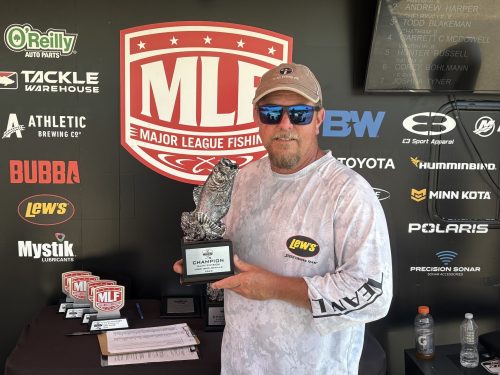
Ken Landreth of Swansea, Illinois, won the co-angler division and $1,352 Saturday, after bringing three bass to the scale that totaled 7 pounds, 6 ounces.
The top 10 co-anglers finished:
1st: Ken Landreth, Swansea, Ill., three bass, 7-6, $1,352
2nd: Ryan Murphy, Paris, Ill., three bass, 6-14, $726
3rd: Arthur Brown, Jefferson City, Mo., three bass, 6-13, $450
4th: Dan Brown, Glenarm, Ill., one bass, 6-10, $442
4th: Brandon Depew, Odin, Ill., three bass, 6-10, $292
6th: Wayde Fehr, Fairbury, Ill., three bass, 6-7, $248
7th: Austin Bloemer, Effingham, Ill., three bass, 6-4, $225
8th: Gary Huber II, Saint Charles, Mo., three bass, 6-3, $203
9th: Nathan Hunhoff, Jasper, Ind., three bass, 6-2, $180
10th: Dale Renth, Macoutah, Ill., three bass, 6-1, $150
10th: Matt Chumbler, Carbondale, Ill., three bass, 6-1, $150
Dan Brown of Glenarm, Illinois, earned the Berkley Big Bass co-angler award of $150, catching a bass that weighed in at 6 pounds, 10 ounces – the largest co-angler catch of the day.
After three events, Andrew Harper of Shelbyville, Illinois, now leads the Fishing Clash LBL Division Angler of the Year (AOY) race with 730 points, while Matt Chumbler of Carbondale, Illinois, leads the Fishing Clash LBL Division Co-Angler of the Year race with 723 points.
The next event for BFL Illini Division anglers will be held June 21 – the Phoenix BFL at Rend Lake Presented by Suzuki Marine in Whittington, Illinois. To register for the event as a boater or a co-angler, visit MajorLeagueFishing.com or call (270)-252-1000.
The top 60 boaters and co-anglers in the division based on point standings, along with the five tournament winners of each qualifying event, will qualify for the Oct. 3-4BFL Regional tournament on the Mississippi River in Quad Cities, Illinois. Boaters will fish for a top award of a new Phoenix 819 Pro with a 200-horsepower Mercury or Suzuki outboard worth $50,000, while co-anglers will compete for a top award of $20,000.
The 2025 Phoenix BFL Presented by T-H Marine is a 24-division circuit devoted to weekend anglers, with 134 events throughout the season, five qualifying tournaments in each division. The top 60 boaters and co-anglers from each division, along with the five qualifying tournament winners, will advance to one of 12 BFL Regional tournaments where they are competing to finish in the top three, which then qualifies them for one of the longest-running championships in all of competitive bass fishing – the BFL All-American.
Proud sponsors of the 2025 MLF Phoenix Bass Fishing League Presented by T-H Marine include: 7Brew, Abu Garcia, Athletic Brewing, B&W Trailer Hitches, Berkley, BUBBA, Deep Dive App, E3 Sport Apparel, Epic Baits, Fishing Clash, Grizzly, Humminbird, Lew’s, Li Time Batteries, Mercury, Minn Kota, Mossy Oak, Mystik Lubricants, Onyx, O’Reilly Auto Parts, Phoenix Boats, Polaris, Power-Pole, Precision Sonar, Strike King, Suzuki Marine, Tackle Warehouse, T-H Marine, Toyota, WIX Filters and YETI.
For complete details and updated tournament information, visit MajorLeagueFishing.com. For regular Bass Fishing League updates, photos, tournament news and more, follow MLF5’s social media outlets at Facebook, Instagram, and YouTube.
About Major League Fishing
Major League Fishing (MLF) is the world’s largest tournament-fishing organization, producing more than 250 events annually at some of the most prestigious fisheries in the world, while broadcasting to America’s living rooms on CBS, Discovery Channel, Outdoor Channel, CBS Sports Network, World Fishing Network and on demand on MyOutdoorTV (MOTV). Headquartered in Benton, Kentucky, the MLF roster of bass anglers includes the world’s top pros and more than 30,000 competitors in all 50 states and 20 countries. Since its founding in 2011, MLF has advanced the sport of competitive fishing through its premier television broadcasts and livestreams and is dedicated to improving the quality of life for bass through research, education, fisheries enhancement and fish care.
Hitting a Lick: Terry Scroggins’ Unshakable Grit on the Bass Pro Tour
Written by Walker Smith, Courtesy of Dynamic Sponsorships
Terry “Big Show” Scroggins has been slinging baits and towing bass boats across the country for nearly two decades, racking up well over $2 million in tournament winnings and cementing his name as one of professional bass fishing’s most respected veterans.
With five professional wins, nearly 50 top 10 finishes and 13 season Championship appearances, the Palatka, Fla., native has seen it all — the highs of hoisting trophies and the lows of poor finishes. Yet, as he navigates the 2025 Major League Fishing Bass Pro Tour season, Scroggins remains unfazed by recent lackluster tournament, leaning on a veteran mentality and a timeless Southern saying.
“Hitting a lick.”
In the world of professional fishing, “hitting a lick” means seizing that perfect moment when everything clicks — the fish are biting, the pattern is dialed, and the leaderboard reflects your name at the top. It’s a phrase rooted in Southern vernacular, often tied to striking it big or catching a break.
For Scroggins, it’s more than just a saying; it’s a philosophy that defines his approach to the sport.
“When it’s your time, ain’t nothing stopping you,” he said with a grin. “And when it ain’t, you can’t do a darn thing about it. That’s part of fishing.”
The veteran’s perspective
Scroggins is no stranger to the rollercoaster of competitive fishing. His career, spanning hundreds of tournaments, has been a masterclass in resilience. From his first Bassmaster win in 2001 on his home waters in Palatka to his role as a Team Toyota stalwart, Scroggins has weathered every storm the sport can throw — from cold fronts to mechanical failures to the unpredictable whims of largemouth bass.
Scroggins’ ability to stay grounded comes from a deep well of experience. He’s learned that fishing is as much about mental fortitude as it is about technique.
“You can’t let a bad day — or a bad season — define you,” he explained. “I’ve had stretches where I couldn’t buy a bite and then, boom, you hit a lick; and it’s like you never missed a cast.”
The slump: Just another day on the water
A couple solid showings at the Harris Chain and Lake Murray was tempered by less-than-stellar finishes at Lake Chickamauga and Kentucky Lakes, where he noted the fisheries’ potential but struggled to convert quantity into quality.
“The Tennessee River is good, but you gotta find the big ones,” he said. “I was close, but close don’t cut it.”
Despite these setbacks, Scroggins’ optimism is infectious. He’s not one to dwell on missed opportunities or curse the fish gods. Instead, he leans on a mantra that’s carried him through 18 years of professional fishing.
“Treat others how you want to be treated, keep smiling and showing up.”
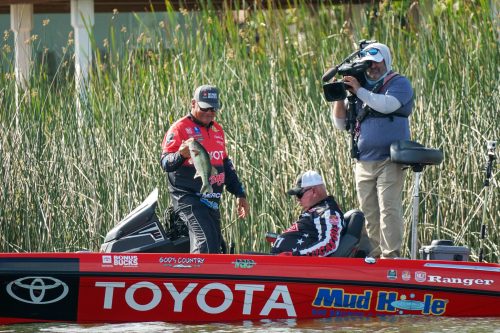
Hitting a lick: The art of patience
For Scroggins, “hitting a lick” isn’t about forcing the issue. It’s about preparation, patience and trusting that the moment will come.
These moments, he says, are what keep him grinding.
“When it’s your time, the fish find you,” he said. “You just gotta be out there, doing the work.”
His approach to slumps reflects this same patience. Scroggins doesn’t panic when the bites don’t come. Instead, he doubles down on preparation.
“Preparation is everything,” he said. “You control what you can — your tackle, your rig, your mindset — and let the rest fall into place.”
A Southern soul on the national stage
Scroggins’ Southern roots run deep and his love for the sport is matched only by his love for the lifestyle that comes with it. When he’s not competing, he’s grilling rib-eye steaks for friends, blasting old-school country music or tinkering with custom rods and baits.
His nickname, “Big Show,” isn’t just about his on-the-water performance; it’s about the larger-than-life personality that makes him a fan favorite. Whether he’s joking with anglers at the Toyota Owners Tournament or helping a competitor troubleshoot equipment, Scroggins embodies the camaraderie that defines bass fishing.
Looking ahead: The next big lick
For Scroggins, the key to overcoming slumps is simple: keep fishing, keep smiling and keep believing.
“Every angler hits a rough patch,” he said. “But I’ve been doing this long enough to know that your time comes around. You just gotta be there when it does.”
His veteran mentality — equal parts grit, patience and Southern charm — ensures that he’s always ready for the next lick. And when it happens, you can bet he’ll be wearing that Toyota hat, flashing a grin and reminding everyone why they call him “Big Show."
Poche Leads Wire-to-Wire, Wins Tackle Warehouse Invitational Stop 5 at the James River Presented by 7Brew Coffee
Alabama pro holds on with 12-15 limit on final day to win by 4 ounces and earn $80,000 payday
RICHMOND, Va. (June 22, 2025) – Pro Keith Poche of Pike Road, Alabama, has a sterling record when it comes to riverine fisheries, with a bevy of Top 10s and wins on rivers proper plus high finishes plucked from the upper reaches of reservoirs. At Stop 5 Presented by 7Brew Coffee on the James River, Poche led the Tackle Warehouse Invitationals event from the start after catching the biggest bag of the event on Day 1 – 23 pounds, 15 ounces. On Day 3, he tallied 12-15 for an even 53-pound total and the win, surviving 20-pound charges from Chad Mrazek and Dustin Smith and staying well clear of his closest competition at the start of the day.
The win is Poche’s third with MLF and his first at the Invitationals level, and he pocketed $80,000 for his efforts. It also sends him into next week’s Bass Pro Tour Zenni Stage 6 Presented by Athletic Brewing Company at the Potomac River (just up the Chesapeake Bay) with some prime time tidal momentum.
Famous for running a Gator Trax aluminum boat with a 150-horsepower Mercury, Poche is a master when it comes to getting where others can’t. This week, he caught all but one of his weigh fish out of a hard-to-reach creek off the James, which he could access at any water level – a feat that others in larger tin rigs and standard fiberglass boats couldn’t accomplish.
“That was the X-factor in the whole deal, my boat and motor,” said Poche. “I mean, having that Gator Trax with a Mercury allowed me to win. I could get there. No nobody else could. It doesn't matter how many fish are in there if you can't get there. That was the difference.”
In practice, Poche scouted the area, which he’s leaned on before in James events, and he immediately liked his chances.
“I went in there first thing, and it was tough to get in there,” he said. “There's trees down everywhere in there, it's just nasty. Looking at the tide, there were some boats, I think, that went in there. I could tell stuff was disturbed. But, the first day of the tournament, I knew it was going to be low tide. Ain't nobody gonna get in there. Like, they could try, but they ain't gonna get there. So, I felt good about it, knowing that at least I can get there before anybody else – even if I had to pass them in the ditch, because I knew they could not make it all the way.”
As it happened, Poche was the first in the area and made hay, blasting nearly 24 pounds right out of the gate. In the creek, which led into a backwater pond, he did his damage in two key areas – one deeper section as well as the mouth of the pond.
“It's really two key spots in there,” he explained. “A little hole halfway back or three-quarters way back. It has steep banks, and it was just a little dip. They stay there waiting for the water to go back and forth. And early morning, the tide was coming out, the water was clean, and they would feed. And then, of course, the other spot was right there at the pond.
“I think that each day catching fish in those small little areas, there’s just only so many that live there,” he said. “But, I did all I could. I cleaned house.”
This week, the fishing in the creek was a little different than Poche has experienced before, but it didn’t slow him down.
“That water's going back and forth. Before, typically, when it's going in the pond, that's when I caught them,” he said. “But this time, it had to be coming out. And I don't know why, but I think it was the water color. I think the river got dingy, and then when that mud pushed in there from the river, the fish aren’t used to that in there.
“They’re used to that clean water in there, and it would scatter them. But when it turned and it would start sucking that clean pond water out, they'd set up and feed.”
Across the event, Poche didn’t need anything super fancy to get the job done. He used a 5/16-ounce shaky head with a Berkley PowerBait MaxScent The General for a lot of his fish, as well as a crankbait and vibrating jig. For the shaky head, he used 15-pound Berkley Trilene 100% Fluorocarbon, an Abu Garcia Zenon reel and a 7-1, heavy, Fenwick baitcaster.
On stage, Poche was emotional as always.
“I was worried all day,” he said. “I felt like I needed more. I couldn't hold it back, I couldn't hold it back, man. It feels good to get it done.”
The top 30 pros at the Invitationals Stop 5 at the James River Presented by 7Brew Coffee finished:
1st: Keith Poche, Pike Road, Ala., 15 bass, 53-0, $80,000
2nd: Chad Mrazek, Montgomery, Texas, 15 bass, 52-12, $30,000
3rd: Dustin Smith, Trussville, Ala., 15 bass, 51-13, $20,000
4th: Banks Shaw, Harrison, Tenn., 15 bass, 51-12, $18,000
5th: Britt Myers Jr., Lake Wylie, S.C., 15 bass, 47-12, $17,000
6th: Mitch Crane, Columbus, Miss., 15 bass, 47-6, $16,000
7th: Keith Carson, DeBary, Fla., 15 bass, 46-1, $15,000
8th: Cal Lane, Grant, Ala., 14 bass, 45-15, $14,000
9th: Bobby Lane, Lakeland, Fla., 15 bass, 45-14, $13,000
10th: Blake Hall, Rogersville, Ala., 15 bass, 45-3, $12,000
11th: Ron Nelson, Berrien Springs, Mich., 15 bass, 44-0, $10,000
12th: Jacob Walker, Springville, Ala., 15 bass, 44-0, $10,750
13th: Chaz Carrington, Suffolk, Va., 15 bass, 43-1, $10,000
14th: Matt Baty, Bainbridge, Ga., 15 bass, 42-10, $10,000
15th: Justin Cooper, Zwolle, La., 15 bass, 42-9, $10,000
16th: Kyle Cortiana, Broken Arrow, Okla., 15 bass, 42-1, $10,000
17th: Blake Smith, Lakeland, Fla., 15 bass, 41-15, $10,000
18th: Cole Breeden, Lebanon, Mo., 15 bass, 41-13, $10,000
19th: Cody Petit, Arundel, Maine, 15 bass, 41-13, $10,000
20th: Jimmy Washam, Stantonville, Tenn., 15 bass, 40-4, $10,000
21st: Brody Campbell, Oxford, Ohio, 15 bass, 40-4, $9,000
22nd: Chris Lane, Guntersville, Ala., 15 bass, 40-3, $9,000
23rd: Kyle Goldstein, Paso Robles, Calif., 15 bass, 40-1, $9,000
24th: Alex Davis, Albertville, Ala., 15 bass, 39-11, $9,000
25th: Nick LeBrun, Bossier City, La., 13 bass, 39-10, $9,000
26th: Martin Villa, Charlottesville, Va., 15 bass, 38-8, $9,000
27th: Robby Lefere, Jackson, Mich., 15 bass, 38-1, $9,000
28th: Colby Schrumpf, Highland, Ill., 15 bass, 37-13, $9,000
29th: Christian Greico, New Bern, N.C., 15 bass, 36-13, $9,000
30th: Ken Thompson, Roaring Springs, Pa., 15 bass, 34-6, $9,000
Complete results for the entire field can be found at MajorLeagueFishing.com.
Overall, there were 149 bass weighing 404 pounds 14 ounces caught by the final 30 pros on Sunday. The catch included 29 five-bass limits.
The three-day MLF Tackle Warehouse Invitationals Stop 5 at the James River Presented by 7Brew Coffee was hosted by Richmond Region Tourism and featured professional bass anglers competing for a top prize of up to $115,000 and valuable points to qualify for the 2025 Tackle Warehouse Invitationals Championship in September. The full field of anglers competed in the two-day opening round on Friday and Saturday in a five-fish, weigh-in format. Only the top 30 pros, based on their two-day cumulative weight, advanced to the final round on Championship Sunday.
Television coverage of the MLF Tackle Warehouse Invitationals Stop 5 at the James River Presented by 7Brew Coffee will air as a two-hour episode, premiering at 9 a.m. ET, on Saturday, Oct. 25 on CBS Sports Network.
The next event on the schedule for Invitationals anglers is the MLF Tackle Warehouse Invitationals Stop 6 at the St. Lawrence River Presented by B&W Trailer Hitches, set for July 25-27 in Massena, New York.
Proud sponsors of the 2025 MLF Tackle Warehouse Invitationals include: 7Brew Coffee, Abu Garcia, Athletic Brewing, B&W Trailer Hitches, Berkley, Bubba, Deep Dive, E3 Sport Apparel, Epic Baits, Fishing Clash, Grizzly, Humminbird, Lew’s, Mercury, Minn Kota, Mossy Oak, Onyx, O’Reilly Auto Parts, Phoenix Boats, PirahnO2, Polaris, Power-Pole, Precision Sonar, Strike King, Suzuki Marine, Tackle Warehouse, T-H Marine, Toyota, VOSKER, WIX Filters and YETI.
For complete details and updated information visit MajorLeagueFishing.com. For regular Tackle Warehouse Invitationals updates, photos, tournament news and more, follow the MLF5 social media outlets at Facebook, Instagram and YouTube.
About Major League Fishing
Major League Fishing (MLF) is the world’s largest tournament-fishing organization, producing more than 250 events annually at some of the most prestigious fisheries in the world, while broadcasting to America’s living rooms on CBS, Discovery Channel, Outdoor Channel, CBS Sports Network, World Fishing Network and on demand on MyOutdoorTV (MOTV). Headquartered in Benton, Kentucky, the MLF roster of bass anglers includes the world’s top pros and more than 30,000 competitors in all 50 states and 20 countries. Since its founding in 2011, MLF has advanced the sport of competitive fishing through its premier television broadcasts and livestreams and is dedicated to improving the quality of life for bass through research, education, fisheries enhancement and fish care.
Catch the 2025 Minn Kota and Humminbird Owners Tournament on the Anglers Channel Bass Wrap Up Show on Pursuit Channel
Columbia, SC (June 23, 2025) – The Anglers Channel Bass Wrap Up Show was recently in Eufaula, Alabama to cover the third annual Minn Kota and Humminbird Owners Tournament. Although only in its third year, the Big Bass format and HUGE payout has become a big hit, with over 700 anglers participating for their shot at over $200,000 in cash and prizes!
Big Bass of the event earns a fully rigged Nitro® Z20 XL, LOADED with Minn Kota and Humminbird products, as well as a Mercury 250 Pro XS, all valued at over $80,000! The Anglers Channel crew was there to capture the excitement, and now fans can tune in to Pursuit to see how big of a bass it takes to win a new boat! The Anglers Channel Bass Wrap Up Show airs on Pursuit Channel Tuesday, June 24th at 5:00 am, with additional airings June 25th at 7:00 pm, as well as June 26th at 7:00 am, with all times being CST.
According to Anglers Channel’s Danny Blandford, “Having attended all three Owners events, I must say Eufaula was a great choice! It was a homecoming for the Humminbird team, the community rolled out the red carpet, and the fish cooperated too! It was a three-day parade of really nice catches crossing the scales.”
Blandford went on to add, “We’re excited to take this event to Pursuit for a dedicated episode of the Anglers Channel Bass Wrap Up Show. Their television platform allows us to highlight the event for millions of fishing fans and bring even more awareness to this awesome event open to all Minn Kota and Humminbird Owners.”
Since 2008 Pursuit has been delivering extensive high-quality outdoor content to millions of viewers unserved by any other full-time outdoor network. The unique basic tier package delivery with the major satellite distributors, plus major recent additions in the cable sector, provides access to an audience that is ripe with outdoorsmen and women for its content partners. Additional episodes of the Anglers Channel Bass Wrap Up Show can be found online via the Pursuit UP streaming channel available to over 100 million users, or available 24/7 on Pursuit UP’s VOD/App platforms.
About Johnson Outdoors
JOHNSON OUTDOORS FISHING is comprised of the Humminbird®, Minn Kota® and Cannon® brands. Humminbird is a leading global innovator and manufacturer of marine electronics products including fish finders, multifunction displays, autopilots, ice flashers, and premium cartography products. Minn Kota is the world’s leading manufacturer of electric trolling motors, as well as a complete line of shallow water anchors, battery chargers and marine accessories. Cannon is the leader in controlled-depth fishing and includes a full line of downrigger products and accessories. Visit Humminbird at www.humminbird.com Visit Minn Kota at www.minnkotamotors.com Visit Cannon at www.cannondownriggers.com
About AnglersChannel.com
AnglersChannel.com multimedia platform combines the web, social media platforms, on-site event coverage and The Anglers Channel Bass Wrap Up Show on Pursuit to bring you the No. 1 resource in tournament bass fishing. Anglers Channel features the web’s most robust tournament database, used by thousands of anglers daily, including schedules, results and searchable details by body of water. Anglers Channel also delivers industry news as it happens, along with coverage of all tournament bass fishing, from BASS and Major League Fishing to the weekend warriors. Visit Anglers Channel via the web, Facebook, Instagram, Twitter and TikTok.
For more information about Angler’s Channel, contact Danny Blandford at Danny@anglerschannel.com
About Pursuit
Pursuit Media is the industry leader in outdoor lifestyle programming, delivering hunting, fishing, shooting, and adventure content to over 22 million homes via linear TV and 100+ million users through its Pursuit UP digital platform. Based in Glenwood, Alabama, Pursuit Media, LLC, is majority-owned by The Bordelon Group and remains dedicated to promoting the outdoors lifestyle and supporting the rights of enthusiasts nationwide.
Reach out today for more about Pursuit, and to learn how Pursuit can help your business! #wearepursuit
Pursuit Media TV, LLC – 334.544.0701 – media@pursuitchannel.com
NPFL - Marler Seals the Deal on Eufaula
Big kicker anchors comeback win for Alabama angler
After a storm-delayed start, the 2025 NPFL Stop Four ended with fireworks. Texas pro Chad Marlor stole the show on Finale Friday with a clutch 17-pound, 11-ounce bag, anchored by a jaw-dropping 8-1 largemouth that rocketed him into first place. His two-day total of 33-12 was enough to hold off Alabama’s Gerald Swindle, who nearly pulled off a comeback of his own with a two-day total of 31-11.
The final day proved tougher for much of the field—big bags were harder to come by, but the shallow bite held strong. Anglers sticking with bushes and flipping or burning spinnerbaits were still able to grind out solid weights. Marlor made the winning move by abandoning his day-one area and trusting a new stretch of water he hadn’t touched since practice—a gamble that paid off big with the day’s biggest bass.
Rounding out the top five: Mike Quinlin finished third with 30-9, KJ Queen in fourth with 30-4, and Greg Hackney just two ounces back in fifth at 30-2.
Spinnerbait Pays Big for Marlor
Texas pro Chad Marlor came to Eufaula with redemption on his mind. His last trip was a tough one—but this week, he got his revenge. Armed with two versions of a custom-built Hilandero Blades Spinnerbait, Marlor committed to burning it through the bushes and triggering reaction bites.
“I was 4x4 with that bait, just crashing it through the cover,” he said. “I settled into a tight little area on day one, caught a good one early, and just leaned on it. There were other guys around, but I stuck it out and made it work.”
On Finale Friday, he called an audible. Instead of returning to his day-one zone, Marlor ran to a new stretch of water he hadn’t touched since practice.
“I left that area alone during the last day of practice, just in case I needed it,” he said. “I didn’t know if it’d be clean or dirty, but I had a feeling. The water was a little clearer, and those big girls were ready to eat that spinnerbait.”
His timing proved perfect. Another angler was on the stretch he wanted, so Marlor gave them space and kept grinding until they moved off.
“I slid in and on the third cast, she ate it—an 8-pounder,” he said. “When she jumped, I just started praying she’d stay buttoned up. Got her in the livewell and had to take a minute to process it. I was blessed today, plain and simple.”
Marlor had a quick limit and that giant kicker sealed it. On a day when many of the leaders struggled, he made every bite count.
“If you didn’t have your fish by 10:30, you were in trouble,” he added. “I caught the right ones at the right time, and it all worked out.”
Swindle Swings to Second with Bush-Flipping Gameplan
Alabama pro Gerald Swindle made a hard charge on Finale Friday, nearly pulling off the comeback—if not for Chad Marlor’s Oklahoma giant. Swindle committed his two practice days to fishing flooded bushes and split time between a lower creek arm and one further upriver, ultimately deciding which to focus on for the tournament.
“On the first morning, I was headed to my area, and I wish I could say it was the plan, but I looked over and saw a bunch of white birds in the trees,” Swindle said. “I pulled in and started catching them instantly.”
With a Buckeye spinnerbait in hand, Swindle worked the area efficiently. His plan was to stay in a single creek, adjust as needed, and avoid running around. That extra fishing time paid off.
“The only real run I made was late this afternoon,” he said. “I told the camera guy we had ten minutes left, slid into a little protected pocket, and flipped up a 4.5-pounder. I needed every one of those minutes.”
On Day One, Swindle keyed in on the outer edges of the bushes—where other anglers were flipping the visible ones, he targeted the hidden stuff.
“Every good bite came from those out-of-sight bushes. Whenever that Buckeye bumped one, they’d crush it,” he said.
But Day Two started off weird. His first bites were small, and he missed a better fish. Knowing something had changed, Swindle adjusted—but didn’t abandon the spinnerbait entirely.
“I picked up a Zoom Brush Hog and started flipping,” he said. “You usually don’t connect right away with a switch like that, and I lost a couple in the bushes. But the next bite was a 4.5—and that one really helped.”
Water clarity wasn’t a major factor. Swindle fished the Dutch Creek area, which had slightly cleaner water than surrounding zones.
“I could see about ten inches,” he laughed. “But the fish bit, and I love fishing this kind of stuff. The mud actually rolled in heavier today, but I think it helped more than hurt.”
Top Ten:
Chad Marler 33-12
Gerald Swindle 31-11
Mike Quinlin 30-9
KJ Queen 30-4
Greg Hackney 30-2
Buddy Gross 29-10
Brandon Cobb 29-2
Tommy Biffle 29-2
John Cox 28-9
Hunter Baughman 28-2
Swindle’s Tenkiller Turnaround
Courtesy of Dynamic Sponsorships
When the scales closed after day one at the Lowrance Bassmaster Elite on Lake Tenkiller it looked as though perpetual fan favorite Gerald Swindle was on his way to a disappointing finish. But the two-time Angler of the Year dug deep, dusted off his rally cap and hit ‘em with the Tenkiller turnaround on day two, weighing in one of the biggest bags of the tournament to jump from 77th place to 10th.
Swindle referred to Lake Tenkiller as a “heart monitor tournament”, meaning he had dramatic spikes in the positive direction followed by some big downturns, like the reading on a heart monitor.
“I had the bites to be leading that event after day one,” Swindle admitted. “I was really disheartened to be honest. I had bad breaks in both the last two tournaments (Fork and Sabine) that the world will never see. I was determined to turn it around in Oklahoma and after day one I had the bites to lead the son of a gun and there I am in 77th.”
Swindle is not usually one to talk about missed or lost fish. The Team Toyota pro lives by the mantra positive-mental-attitude (PMA) and doesn’t dwell on spilt milk. He knows every angler on the Elite field has a story about ‘almost’ nearly every tournament day, and ultimately his fans want to see “G” the entertainer, not G the complainer.
“When I go on stage people don’t want to hear shoulda, coulda, woulda,” Swindle said. “But I’ll be honest with you, I felt like I was gut-punched on day one. I weighed my 11-pounds and then had to sit with my wife and try to figure out why. Why am I losing these fish? I know I wasn’t doing anything wrong, just like at Sabine, it just happened that way. And now I’ve got less than 12-hours to pick up the pieces before blast-off on day two. It’s in those moments that you really gotta dig deep.”
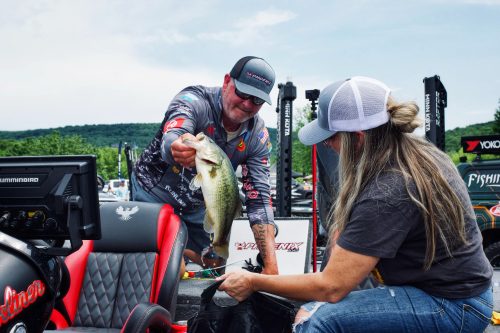
The 30-year tournament veteran did just that on day two, leveraging a stellar bite around marina docks coupled with a pattern around flooded bushes to mount his comeback. Swindle is one of the most accomplished “junk fishermen” in bass fishing and said this tournament fit right into his wheelhouse. He fished what was in front of him while trying to adapt with the volatile weather conditions anglers were dealt at Tenkiller.
“It’s like I was a basketball player and went from not being able to make a layup to draining every shot I took,” Swindle said. “I was flowing and, man, it felt good.”
Employing old-school staples of a white 3/8-ounce Buckeye swimjig tipped with a Zoom Z-Craw Jr and a Texas-rigged Zoom Brush Hawg in watermelon red around flooded bushes, Swindle continued to climb the leaderboard on day three. He caught a few key marina fish on a topwater popper, including one viral four-pound catch that you couldn’t help but smile watching.
The 56-year-old former Alabama carpenter was quick on his toes but even faster with his commentary, making fans laugh and cheer.
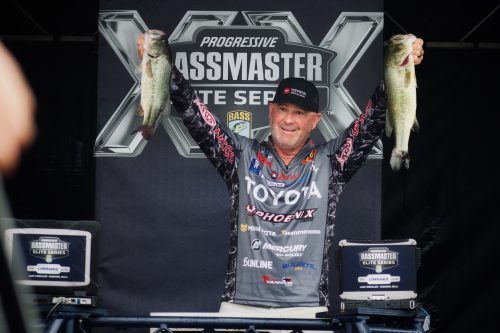
Unfortunately, the same excitement that makes “G-man” a fan favorite cost him on day three, as he unintentionally made a cast with six fish in his livewell after failing to cull his smallest fish. Swindle realized his mistake almost immediately and called the tournament director to turn himself in. He was assessed a two-pound penalty.
“I wish I had a better excuse, but I just had a momentary brain fart, which happens to us old guys sometimes,” Swindle said with a wry smile. “Hopefully anglers watching can learn from my mistake and from how it was handled. I don’t care if you fish the Elite Series or a Tuesday night jackpot; if you break a rule, you owe it to your competitors, to yourself, and to the sport to report yourself. Integrity is everything in life and it’s even more important when no one is watching.”
That two-pound penalty cost Swindle from making Championship Sunday. He ultimately finished in 14th, missing the top ten by one pound. But Swindle didn’t hang his head, his glass was half-full after an up and down three days on Lake Tenkiller.
“Whether it’s fishing or really anything in life, there will always be times when you question yourself,” Swindle offered. “It’s natural. It’s going to happen. I’ll be honest enough to say after debacles at Fork, Sabine, and day one at Tenkiller I was right there. I was fighting demons in my head.
“But you know what, you can’t do that. Don’t doubt the process. Don’t doubt yourself. Always learn from mistakes or near misses, but you gotta believe even when it ain’t going right.”
Cox rooming with legends, but loses sandals in a beaver dam
Florida’s John Cox has been in Oklahoma for two weeks competing in pro-level tournaments. Last week, at Lake Tenkiller, and this week at the NPFL event on Lake Eufaula.
Eufaula is very muddy, lake levels are nearly 8-feet above normal, and Day 1’s competition on Wednesday at the NPFL event was canceled due to … you guessed it …. the threat of harsh lightning storms. However, Cox’s endless enthusiasm remains firmly in-tact despite constantly changing conditions and losing his shoes in a beaver dam.
Rooming with legends
Cox was invited to stay with two Bass Fishing Hall of Famers this week. Tommy Biffle and David Fritts, at Biffle’s home, about an hour from Eufaula.
“I started rooming with those two legends at NPFL events last season, and I love it. They were two of my heroes growing up,” says the 39-year old Vexus pro.
“I play them You Tube videos of some of their career highlights. Stuff they’ve never seen. And I swear to you they narrate every minute like it happened yesterday, and they get tears in their eyes watching some of the best days of their lives,” smiles Cox.
So how did Cox lose his flip flops?
“No surprise I tried to drive my 21-foot aluminum Vexus over a beaver dam to get into a backwater pond. But I got stuck on top of the beaver dam. The whole boat was high centered on top of the beaver dam, so I had to get out and push,” grins Cox.
“I would have spent the night there stranded, had I not got out and pushed. But when I planted my feet to push the boat, one of my flip-fops got stuck in the dam and never re-surfaced. So then, I was down to one flip-flop, and that one broke. So I finally got un-stuck, but had no shoes, and only caught two non-keeper bass,” says Cox.
What to expect at Eufaula, OK
Cox admits that dealing with two solid weeks of constantly changing water levels has become mentally exhausting, but physically he feels fine, and remains excited for what will now be a 2-day shootout.
“Somebody’s going to find a magical stretch or two, but I don’t think it will be dirt shallow, but instead on the deeper flooded bushes, or from one magical laydown or small boulder. That’s how I caught them in the NPFL the last time we were at Eufaula. I had a magical rock that produced close to half the fish I weighed-in. I would think 30-pounds for two days will win.”
Let’s just hope Cox finds a magical piece of habitat Thursday and Friday, and that perhaps Biffle or Fritts will loan him a new pair of flip-flops.
Plattsburgh Set for MLF Toyota Series at Lake Champlain
PLATTSBURGH, N.Y. (June 18, 2025) –The Major League Fishing (MLF) Toyota Series Presented by Phoenix Boats is set to visit Plattsburgh, New York, next week, June 26-28, for the first event of the Northern division – the Toyota Series Presented by Phoenix Boats at Lake Champlain.
The three-day tournament, hosted by the City of Plattsburgh and the Adirondack Coast Visitors Bureau, will feature a roster of the region’s best bass-fishing pros and co-anglers competing for a top prize of up to $100,000 in the pro division and a new Phoenix 518 Pro boat with a 115-horsepower outboard motor plus $5,000 in the co-angler division.
Pro Bryan LaBelle of Hinesburg, Vermont, is one of the best anglers on Lake Champlain and said he expects bedding smallmouth to be in play.
“I think with the cold season, the smallmouth are going to be the way to go,” he said. “That’s what I’m seeing right now. I think the green fish will probably be in a funk, and they’ll be thinned out. Definitely a lot of smallmouth are going to spawn out too, but I think there will be enough big ones around that guys will find them and the tournament will likely be won that way.”
LaBelle said he anticipates the winning weight will be about 61 pounds over the three-day event. Champlain veteran Brett Carnright of Plattsburgh, New York, figures on something in the same ballpark – he predicted that it would take 60-12 to win and thinks it will take 13 smallmouth and two largemouth.
If Carnright and LaBelle are correct, fans and anglers are in for an event along the lines of some of the late 20-teen barnburners that were seen on Champlain, which were highlight-reel Toyota Series events. Regardless, anglers will be fishing on one of the premier lakes in the country at a prime time.
Anglers will begin each day at 6 a.m. ET, launching from Plattsburgh City Marina at 5 Dock St. in Plattsburgh. Weigh-ins will take place at the same location, starting at 2 p.m. daily. Fans are invited to attend in person and can also stay connected by following the “MLF Live” weigh-in broadcasts and daily updates on MajorLeagueFishing.com.
In Toyota Series regular-season competition, payouts are based on the number of participants competing in the event, scaling up for every 20 boats over 160 and scaling down for every boat below 160. With a 160-boat field, pros fish for a top prize of up to $75,000, if Phoenix MLF Bonus qualified. Co-anglers cast for the top prize of a new Phoenix 518 Pro bass boat with a 115-horsepower Mercury or Suzuki outboard (valued at $33,500). With a 260-boat field, pros fish for a top award of up to $100,000, if Phoenix MLF Bonus qualified. Strike King co-anglers cast for the top prize of a new Phoenix 518 Pro bass boat with a 115-horsepower Mercury or Suzuki outboard plus $5,000 cash.
The 2025 Toyota Series Presented by Phoenix Boats consists of five divisions – Central, Northern, Plains, Southern and Southwestern – each holding three regular-season events, along with the International and Wild Card divisions. Anglers who fish in any of the five divisions or the Wild Card division and finish in the top 25 will qualify for the no-entry-fee Toyota Series Championship for a shot at winning up to $235,000 and a qualification to REDCREST 2026. The winning co-angler at the championship earns a new Phoenix 518 Pro bass boat with a 115-horsepower outboard. The 2025 Toyota Series Championship will be held Nov. 6-8 on Grand Lake in Grove, Oklahoma, and is hosted by the City of Grove Convention & Tourism Bureau.
Proud sponsors of the 2025 MLF Toyota Series include: 7Brew Coffee, Abu Garcia, Athletic Brewing, B&W Trailer Hitches, Berkley, BUBBA, Deep Dive App, E3 Sport Apparel, Epic Baits, Fishing Clash, Grizzly, Humminbird, Lew’s, Mercury, Minn Kota, Mossy Oak, Onyx, O’Reilly Auto Parts, Phoenix Boats, PirahnO2, Polaris, Power-Pole, Precision Sonar, Strike King, Suzuki Marine, Tackle Warehouse, T-H Marine, Toyota, WIX Filters and YETI.
For complete details and updated information visit MajorLeagueFishing.com. For regular Toyota Series updates, photos, tournament news and more, follow the MLF5 social media outlets at Facebook, Instagram and YouTube.
About Major League Fishing
Major League Fishing (MLF) is the world’s largest tournament-fishing organization, producing more than 250 events annually at some of the most prestigious fisheries in the world, while broadcasting to America’s living rooms on CBS, Discovery Channel, Outdoor Channel, CBS Sports Network, World Fishing Network and on demand on MyOutdoorTV (MOTV). Headquartered in Benton, Kentucky, the MLF roster of bass anglers includes the world’s top pros and more than 30,000 competitors in all 50 states and 20 countries. Since its founding in 2011, MLF has advanced the sport of competitive fishing through its premier television broadcasts and livestreams and is dedicated to improving the quality of life for bass through research, education, fisheries enhancement and fish care.
NPFL Postpones Day 1 at Lake Eufaula
EUFAULA, OKLA. — The National Professional Fishing League has postponed Day 1 of NPFL Stop 4 at Lake Eufaula due to unsafe weather conditions. The bass tournament will now start on Thursday, June 19, and end on Friday, June 20.
The decision was made after tournament officials reviewed reports from the National Weather Service and other sources calling for high winds and lightning, making for unsafe fishing and boating conditions.
“Our commitment is to the safety and well-being of our anglers,” said NPFL president Brad Fuller. “We will not subject our anglers to unsafe conditions. The tournament will begin on Thursday and end on Friday. It will be a two-day event.”
Livestream coverage of the event with Luke Dunkin and Fat Cat Newton will be available on Thursday and Friday from 8:00 a.m. to 1:00 p.m. on the NPFL website (TheNationalProfessionalFishingLeague.com) and on YouTube.
Weigh-ins will begin at 2:00 p.m. CT at Nichols Point on Thursday and Friday and can be viewed online via the same outlets.
About the National Professional Fishing League
The National Professional Fishing League (NPFL) was founded to bring competitive fishing to a broader audience and offer anglers a platform to compete at the highest level. The NPFL is committed to fostering integrity, competition, and innovation in the sport, providing anglers and fans alike with an exciting and unique experience.
Media Contact: Ken Duke — (407) 574-1898 or ken@tnpfl.com.
T-H Marine to Continue Supporting Association of Collegiate Anglers for 2025 Season
SAN ANTONIO, TX (June 17, 2025) – The Association of Collegiate Anglers, in partnership with T-H Marine, announces support of college anglers for the 2025 season of the Collegiate Bass Fishing Series. T-H Marine will continue to provide college anglers with a discount on the full lineup of products, as well as support college anglers in a multitude of ways, including at the Collegiate Bass Fishing Championship presented by Bass Pro Shops. All ACA events in 2025 will be eligible for T-H Marine Atlas Awards.
“We are proud to continue our partnership with the Association of Collegiate Anglers and provide support to the next generation of competitive anglers,” said Shana Christie, Brand Marketing Director of T-H Marine. “Our mission has always been to support anglers of all levels, and by offering discounts, contingency, and event support, we aim to improve the collegiate fishing experience and help these young athletes succeed both on and off the water. We look forward to another exciting year of competition and growth in collegiate bass fishing.”
T-H Marine offers an extensive product line to cover anglers from transom to trolling motor. Those products include G-Juice, HydroWave, Atlas Jack Plates, G-Force products, and so much more.
T-H Marine supports collegiate anglers in a variety of ways and routinely provides support on site at various events, as well as offers a well-established discount program to college anglers. To find out more information about discount opportunities offered through the Association of Collegiate Anglers to outfit your boat with T-H Marine’s acclaimed products, visit the Discount & Incentives page.
“These college anglers benefit greatly from the support provided from T-H Marine,” said Wade Middleton, ACA Director and President of CarecoTV. “From the discount program to Atlas Awards, and the support at School-Run events…T-H Marine goes above and beyond to support college anglers.”
In 2025 college anglers competing in Association of Collegiate Anglers events will again be able to participate in the T-H Marine Atlas Awards tournament contingency program. Anglers competing in ACA events that are registered for Atlas Awards will be eligible to earn $200 at regular season events, and $500 at the Collegiate Bass Fishing Championship presented by Bass Pro Shops. Register for Atlas Awards here.
T-H Marine is again partnering with the ACA to help support School-Run events for the Bass Pro Shops School of the Year presented by Abu Garcia. Select School-Run events will be chosen by ACA staff to participate in this promotion with T-H Marine. Selected events will be required to promote T-H Marine per the program guidelines, and in return the host school will receive a lucrative T-H Marine prize package to include in the payout of their respective event. Apply to be selected as a T-H Marine featured School-Run event on the ACA website.
Logan Locks up Win and Yamaha Power Pay at Lake Tenkiller
Courtesy of Dynamic Sponsorships
Yamaha Pro Wes Logan leveraged a clutch final day comeback to win the Lowrance BassmasterÒ Elite on Lake Tenkiller. Logan caught just under 17-lbs on Sunday, the biggest bag of the final day, which was enough to propel the 30-year-old to his second Elite Series title by a margin of one ounce.
Logan’s first Elite Series win in 2021 coincidentally fell on Mother’s Day, after the Alabama native out fished his peers on his home lake of Neely Henry. Four years later, almost as if scripted after several trials and triumphs in his career, Logan’s second Bassmaster win came on Father’s Day.
“To win on Father’s Day fishing the way I grew up fishing around the house with my dad is unbelievable,” Logan said with emotion overflowing. “My dad taught me how to flip bushes when I was a kid and it’s been one of my absolute favorite ways to catch ‘em ever since. To win a tournament flipping bushes in this day and age, man, it was truly meant to be.”
Mother Nature was an active participant in this tournament, as eastern Oklahoma was already experiencing a wetter than normal June and then heavy rains plagued all four days of the event. This played directly into Logan’s strengths of flipping and pitching shallow cover.
After capitalizing on an early morning shad spawn around floating marina docks, Logan targeted flooded bushes and “trash mats” formed by debris deposited from the high water with a flipping jig to catch his fish. With this being his first time on Lake Tenkiller, Logan kept his tactics simple and tried to make as many pitches as possible each day.
This plan worked masterfully and helped Logan steadily climb the leaderboard. After finishing the first day in 11th, Logan moved up to 5th heading into Saturday and then improved to 3rd to start Championship Sunday. His final day rally ultimately propelled him to the top spot.
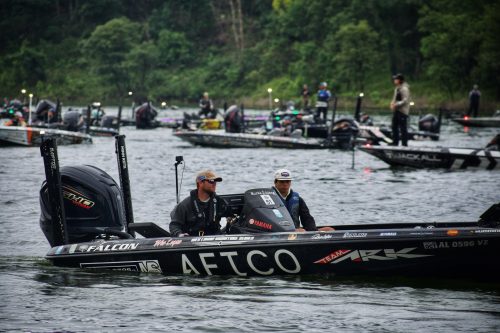
According to Logan, every flip proved crucial, and the trust he had in his Yamaha 250hp V MAX SHOÒ allowed him to stretch his fishing time to the final minute each day.
“I can’t overstate the importance of my Yamaha SHO’s reliability and the peace of mind that gives me as a professional angler,” Logan said. “Whether we’re on massive bodies of water like the Great Lakes or on smaller places like Lake Tenkiller, I have the confidence to squeeze in every last cast because I know that Yamaha is going to get me back to the ramp on time. It’s a huge factor for me and how I fish.”
To the victor, go the spoils. Logan earned an additional $4,000 bonus from Yamaha Power Pay on top of his tournament winnings for being the highest finishing angler running a Yamaha motor purchased within the last 60-months.
This popular contingency isn’t exclusive to pros like Logan; Power Pay supports over 600 fresh and saltwater tournaments, rewarding anglers of all levels for owning an eligible Yamaha motor.
“You should be running a Yamaha and registered for Power Pay whether you fish in high school, college, or team tournaments on the weekends,” Logan said. “It’s free to sign up and you can win bonus money if you beat the other Yamaha owners. I’ve made a lot of money through Power Pay and you can, too. And I’m talking about real money, thousands of dollars depending on the tournament. You can’t beat that.”
For more information, a full list of supported events, or to get registered today, follow this link: https://yamahapowerpay.com/.
16th Annual High School Fishing National Championship and World Finals Set to Take Place Next Week on Grand Lake
Prestigious High School Fishing National Championship to offer more than $3.8M in scholarships and prizes to student anglers
GROVE, Okla. (June 17, 2025) – The 16th Annual High School Fishing World Finals and National Championship – the world’s premier high school fishing event – is set to take place at Grand Lake in Grove, Oklahoma, next week, June 25-27. Teams from nearly every U.S. state and multiple foreign countries are set to compete for a share of the record-setting prize pool in high school bass fishing, with the total amount of scholarships and prizes totaling over $3.8 million dollars, according to The Bass Federation (TBF) Student Angler Federation (SAF).
Each High School team consists of three people to a boat – two High School Fishing anglers and their adult boat captain or coach. The 2025 High School Fishing World Finals and National Championship, hosted by the Grove Convention & Tourism Bureau , are set to bring an estimated 3,000 people to Grand Lake and Grove, Oklahoma, for the week-long event.
“We live and breathe fishing in Grove, Oklahoma, and to host a world-class championship of this caliber with student anglers from around the world is an honor,” said Brent Malone, Grove Convention & Tourism Director. “Our town is super excited for the 2025 High School World Final Championship that will be held at Wolf Creek Park. We have hosted thousands of tournaments in past years, but when you get to showcase our lake and community to families from all over the country you get excited to roll out the red carpet. We will be ready and prepared to make these student anglers feel at home in our wonderful community.”
Student anglers will launch each day at 5:30 a.m. CT (or first safe light) from Wolf Creek Park, located at 963 N. 16th St. in Grove. Weigh-ins will also be held at Wolf Creek Park and will begin at 1:30 p.m. each day. Fans are welcome to attend and encouraged to follow the event live online through weigh-in broadcasts and daily coverage at HighSchoolFishing.org .
The event is held in conjunction with the High School Fishing World Finals – open to all Student Angler Federation (SAF) members worldwide – the largest and most competitive tournament in high school fishing. At the same time, on the dual-stage, the top 10% of teams from all SAF-sanctioned events over the past year – including the MLF Abu Garcia High School Fishing Opens Presented by Tackle Warehouse – will also battle it out in the prestigious High School Fishing National Championship, boasting its own set of prizes and scholarships that top more than $500,000. These qualified teams are automatically entered into both events, giving them double the opportunity to win from a combined prize pool in a single trip.
In addition to the college scholarships and prizes offered, the High School Fishing National Champions will also advance to compete as co-anglers at the 2025 MLF Toyota Series Championship, held Nov. 6-8 on Grand Lake in Grove, Oklahoma, and a shot at the top prize of a new Phoenix 518 Pro boat with a 115-horsepower outboard.
Proud sponsors of the MLF Abu Garcia High School Fishing Presented by Tackle Warehouse include: 7Brew, Abu Garcia, B&W Trailer Hitches, Berkley, BUBBA, Columbia PFG, Deep Dive, E3 Sport Apparel, Epic Baits, Fishing Clash, Humminbird, Lew’s, Mercury, Minn Kota, Mossy Oak, Onyx, O’Reilly Auto Parts, Phoenix Boats, PiranhO2, Polaris, Power-Pole, Precision Sonar, Strike King, Suzuki Marine, Tackle Warehouse, T-H Marine, Toyota, WIX Filters and YETI.
For complete details and updated tournament information, visit HighSchoolFishing.org. For regular High School Fishing updates, photos, tournament news and more, follow High School Fishing on Facebook and on MLF5’s social media outlets at Facebook, Instagram and YouTube.
About Major League Fishing
Major League Fishing (MLF) is the world’s largest tournament-fishing organization, producing more than 250 events annually at some of the most prestigious fisheries in the world, while broadcasting to America’s living rooms on CBS, Discovery Channel, Outdoor Channel, CBS Sports Network, World Fishing Network and on demand on MyOutdoorTV (MOTV). Headquartered in Benton, Kentucky, the MLF roster of bass anglers includes the world’s top pros and more than 30,000 competitors in all 50 states and 20 countries. Since its founding in 2011, MLF has advanced the sport of competitive fishing through its premier television broadcasts and livestreams and is dedicated to improving the quality of life for bass through research, education, fisheries enhancement and fish care.
Potomac River Set to Host MLF Bass Pro Tour Zenni Stage 6 Presented by Athletic Brewing
A stacked field of 66 top pro anglers to compete for top prize of $150,000, all four days of competition live streamed at MajorLeagueFishing.com
CHARLES COUNTY, Md. (June 17, 2025) – The Major League Fishing (MLF) Bass Pro Tour (BPT) is set to continue its season next week, June 26-29, in Marbury, Maryland, with the sixth regular-season tournament of the year – the Zenni Stage 6 at the Potomac River Presented by Athletic Brewing .
Hosted by the Charles County Government, Dept. of Recreation, Parks, and Tourism, the four-day event will feature 66 of the top professional anglers in the world competing for a $150,000 top prize, a share of the $6.49 million season purse, and valuable AOY points in hopes of qualifying for the General Tire Heavy Hitters all-star event and REDCREST 2026, the Bass Pro Tour championship.
The tournament will feature numerous top pros and fan favorites, including reigning Fishing Clash Angler of the Year (AOY) and nine-time BPT champion Jacob Wheeler, back-to-back REDCREST 2024 & 2025 Champion Dustin Connell, Ott DeFoe, Skeet Reese, Edwin Evers and more. The tournament will feature the MLF catch, weigh, immediate-release format, in which anglers catch as much weight as they can each day, while also feeling the pressure and intensity of the SCORETRACKER® leaderboard. The tournament is being filmed for broadcast later this year on Discovery.
Although the Potomac River has long played host to numerous MLF events across different circuits, this event will mark the first time that the MLF’s top circuit, the Bass Pro Tour, has visited the historic fishery. Few anglers in the 66-angler field know the historic tidal fishery better than Abu Garcia pro Justin Lucas. The Alabama pro owns a previous Tour-level victory on the Potomac in 2016 and he fully expects the river to showcase its classic early-summer form.
“I think this one is going to be standard postspawn Potomac River grass fishing,” Lucas said. “Everything’s going to be related to grass, whether it’s low tide or high tide. Docks and wood might play a little bit, but to catch numbers like our format calls for, you’re going to have to find the biggest populations on the grass flats.”
With fewer boats in the BPT format than previous major events on the Potomac, Lucas hopes the fishery may feel a bit more open.
“I’m hoping with 66 people it’ll fish a little bigger than it normally does with 100-plus boat fields. But the reality is, it’s still a place where it’s hard to hide,” he said. “If you see someone catch one in practice, you instantly know there’s fish there, and that draws guys to the same areas. Some anglers might find something in the back of a creek where they’re a little more hidden, but the question is whether that can hold up over four days.”
When it comes to baits, Lucas is leaning into tried-and-true grass weapons.
“I’ll definitely have a wacky-rigged (Berkley PowerBait) MaxScent 5-inch General tied on – no doubt that’s going to play,” he said. “I’ll also have a Berkley Swamp Lord frog, and then you’ll see some topwater, soft plastics, and probably a few vibrating jigs or swimjigs mixed in.”
As for weights, Lucas predicts plenty of fish catches – and some strong totals. He added that the timing of the event may benefit the field.
“I think a solid day will be somewhere around 20 to 40 fish,” he said. “I’d guess something like 40 pounds a day will be pretty solid, and maybe 70 or 80 pounds leading. There haven’t been any really big tournaments here yet this year. It hasn’t been hammered yet, so that should help the fishing.”
Ultimately, Lucas believes success next week will come down to managing tides and timing.
“Maximizing your time on the tides will be key,” he said. “When your window’s gone, you’re going to have to move more than you might in a five-fish format. You’re not going to be able to afford to just wait them out in this one.”
Anglers will launch at 7:15 a.m. ET each day from Smallwood State Park, located at 2750 Sweden Point Road in Marbury, Maryland. The takeout will be held at the same location beginning at 3:45 p.m. daily. Fans are welcome to attend all launch and takeout events and also encouraged to follow the event online throughout the day on the MLFNOW!® live stream and SCORETRACKER® coverage at MajorLeagueFishing.com.
"The Charles County Department of Recreation, Parks and Tourism is excited to welcome Major League Fishing back to our county for the 2025 Bass Pro Tour", said Ashley Chenault, Chief of Tourism for the Charles County Government, Dept. of Recreation, Parks, and Tourism. "This year, we are partnering with Major League Fishing on a family-friendly event, which will provide a fantastic opportunity for anglers and guests to explore our beautiful local parks, shop at our unique businesses, and experience the charm of our community."
On Saturday and Sunday, June 28-29, from 1 p.m. to 6 p.m. MLF welcomes fans of all ages to visit the Village Green Park, located at 100 Walter Thomas Road in Indian Head, Maryland for the Hooked! on the Potomac Festival and MLF Fan Experience & Watch Party. Fans can watch the pros live on the MLFNOW! big screen, enjoy free dessert, enter to win giveaways, listen to live music from country music artist Megan Barker, and cheer on their favorite pros. The first 50 kids 14 and under will receive a free rod and reel each day. The event also includes a youth casting contest. The Bass Pro Tour anglers, along with the PAW Patrol’s Skye and Marshall, will be on hand both days to meet and greet fans, sign autographs and take selfies.
The Zenni Stage 6 at the Potomac River Presented by Athletic Brewing will feature anglers competing with a 1-pound, 8-ounce minimum weight requirement for a bass to be deemed scorable. The MLF Fisheries Management Division determines minimum weights for each body of water that the Bass Pro Tour visits, based on the productivity, bass population and anticipated average size of fish in each fishery.
The 2025 Bass Pro Tour features a field of 66 of the top professional anglers in the world, competing across seven regular-season tournaments around the country, for millions of dollars and valuable points to qualify for the annual Heavy Hitters all-star event and the REDCREST 2026 championship.
The full field of anglers will compete in the two-day Qualifying Round on Thursday and Friday. After the two-day Qualifying Round is complete, the pro with the heaviest two-day total will advance directly to Sunday’s Championship Round. Anglers that finish 2nd through 20th will advance to Saturday’s Knockout Round. In the Knockout Round, weights are zeroed, and the remaining anglers compete to finish in the top nine to advance to Sunday’s Championship Round. In the final-day Championship Round, weights are zeroed, and the highest one-day total wins the top prize of $150,000.
The MLFNOW!® broadcast team of Chad McKee and J.T. Kenney will break down the extended action live on all four days of competition from 7:30 a.m. to 4 p.m. ET. MLFNOW!® will be live streamed on MajorLeagueFishing.com, the MyOutdoorTV (MOTV) app and Rumble.
Television coverage of the Zenni Stage 6 at the Potomac River Presented by Athletic Brewing will premiere as a two-hour episode starting at 7 a.m. ET, on Saturday, Nov. 1 on Discovery, with the Championship Round premiering on Saturday, Nov. 8. New MLF episodes premiere each Saturday morning on Discovery, with re-airings on Outdoor Channel.
Proud sponsors of the 2025 MLF Bass Pro Tour include: 7Brew Coffee, Abu Garcia, Athletic Brewing, Bass Force, B&W Trailer Hitches, Bass Pro Shops, Berkley, BUBBA, E3 Sport Apparel, Fishing Clash, Grizzly, Lowrance, Mercury, MillerTech, Mossy Oak Fishing, NITRO, O’Reilly Auto Parts, Power-Pole, Rapala, Star brite, Suzuki, Toyota and Zenni.
For complete details and updated information on Major League Fishing and the Bass Pro Tour, visit MajorLeagueFishing.com. For regular updates, photos, tournament news and more, follow MLF’s social media outlets at Facebook, X, Instagram and YouTube.
About Major League Fishing
Major League Fishing (MLF) is the world’s largest tournament-fishing organization, producing more than 250 events annually at some of the most prestigious fisheries in the world, while broadcasting to America’s living rooms on CBS, Discovery Channel, Outdoor Channel, CBS Sports Network, World Fishing Network and on demand on MyOutdoorTV (MOTV). Headquartered in Benton, Kentucky, the MLF roster of bass anglers includes the world’s top pros and more than 30,000 competitors in all 50 states and 20 countries. Since its founding in 2011, MLF has advanced the sport of competitive fishing through its premier television broadcasts and livestreams and is dedicated to improving the quality of life for bass through research, education, fisheries enhancement and fish care.
The NPFL Announces Military Classic: A Tournament by Veterans, for Veterans
WILKESVILLE, OHIO–The National Professional Fishing League (NPFL) is honored to announce the upcoming NPFL Military Classic, a tournament designed by veterans, for veterans. This event embodies the "NPFL Way"—a commitment to excellence, community, and giving back.
The Military Classic is purpose-built to serve those who have served our nation. It offers a platform for veterans and active-duty service members to connect, compete, and find camaraderie through the shared passion of bass fishing.
"This tournament is more than a competition; it's our way of honoring the sacrifices made by our military brothers and sisters," said NPFL President Brad Fuller. "We're excited for the opportunity to give back and provide an environment where veterans can thrive."
Adding to the excitement, the NPFL is proud to announce a commitment from Lew's American Hero® Program as a supporting partner. The American Hero® Program pledges a portion of profits from the sale of every American Hero® rod, reel, and combo to support programs that benefit military veterans in their return to enjoying recreational opportunities outdoors, such as fishing. For more, visit lews.com.
The NPFL is currently coordinating with additional sponsors and partners to bring this vision to life. Full event details, including location, format and registration, will be released in the near future.
The Military Classic will be 100% centered around bringing back a meaningful, impactful experience for our veteran and active-duty community through the sport of bass fishing.
About the National Professional Fishing League
The National Professional Fishing League was founded to bring competitive fishing to a broader audience and offer anglers a platform to compete at the highest level. The NPFL is committed to fostering integrity, competition, and innovation in the sport, providing anglers and fans alike with an exciting and unique experience.
For sponsorship or involvement inquiries, please contact Brad Fuller at brad@tnpfl.com.
Malvern’s Huneycutt Earns First Career Win at Phoenix Bass Fishing League Event at Lake Dardanelle
Waldron’s Defoor Tops Co-Angler Division
RUSSELLVILLE, Ark. (June 16, 2025) – Boater Kyle Huneycutt of Malvern, Arkansas, caught a five-bass limit weighing 19 pounds, 4 ounces, Saturday to win the MLF Phoenix Bass Fishing League (BFL) Presented by T-H Marine on Lake Dardanelle. The tournament, hosted by Russellville Tourism, was the fourth event of the season for the BFL Arkie Division. Huneycutt earned $4,642 for his victory.
Huneycutt, who drives a train for a living, describes himself as “just a country boy that loves to fish.” He’s had a passion for fishing for years, but as sometimes happens in life, he wasn’t always able to pursue it the way he wanted.
“I’ve only been doing this for two years as a boater,” he said. “I didn’t own a fishing pole for 15 years.”
Now, he’s making up for lost time. Huneycutt caught all his fish on an awesome frog bite.
“I’m not gonna lie to you, I should’ve had about 22 or 23 (pounds). I lost some big ones,” he said. “The place I was at, if you go back over there right now, you could catch another 20 pounds off of it.”
He found the spot on Friday in practice, after two long and mostly fruitless days leading up to it. The key stretch was about 30 yards long, with emergent grass out in front of some flooded timber. He said the grass grew up out of the water, tumbled over and created a sort of canopy that in some areas kept his frog from even splashing the surface of the water. But that didn’t keep the bass from finding it.
“I was throwing a Booyah popping frog in brown,” he said. “It (the grass) was about a boat-length all the way around the bank. I was having to throw the frog up on top of that. Half of my fish came on bites when the frog wasn’t even in the water. It was unbelievable.”
Working back and forth in circles, Huneycutt had no reason to leave. He knew there were more fish moving in because he could hear them busting back in the timber. Because he couldn’t get to the timber, he stayed patient and let the fish work their way out to him. The only thing that kept him from catching a real mega-bag was losing a pair of 5-pound-class fish. Even still, it was such an incredible bite that Huneycutt was ecstatic about his day.
“It was so awesome, man. It was so awesome.”
The top 10 boaters finished the tournament:
1st: Kyle Huneycutt, Malvern, Ark., five bass, 19-4, $4,642
2nd: Brandon Lee, Ratcliff, Ark., five bass, 18-3, $2,041
3th: Bobby Ammons, Waldron, Ark., five bass, 17-11, $1,362
4th: Justin Howard, Austin, Ark., five bass, 16-13, $952
5th: Bryan Hunt, Water Valley, Miss., five bass, 16-2, $816
6th: Mike Rhinehart, Pottsville, Ark., five bass, 16-1, $748
7th: Matt Tucker, Pottsville, Ark., five bass, 15-15, $680
8th: Leland Nixon, Bee Branch, Ark., five bass, 15-14, $612
9th: Zach King, Clarksville, Ark., five bass, 15-13, $544
10th: Cody McEntire, Walnut Ridge, Ark, five bass, 15-12, $476
Complete results can be found at MajorLeagueFishing.com.
Huneycutt caught a bass that weighed 5 pounds, 11 ounces, and earned the Berkley Big Bass Boater award of $560.
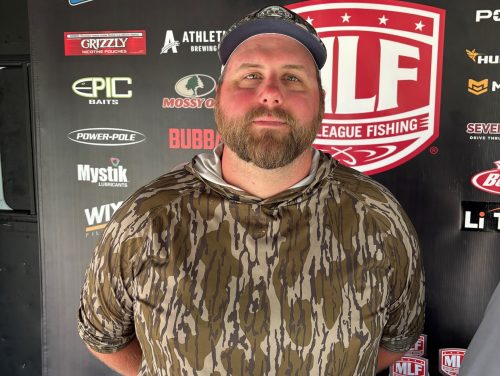
Blake Defoor of Waldron, Arkansas, won the co-angler division and $2,041 Saturday, after bringing three bass to the scale that totaled 9 pounds, 1 ounce.
The top 10 co-anglers finished:
1st: Blake Defoor, Waldron, Ark., three bass, 9-1, $2,041
2nd: Stephen Simms, Hot Springs, Ark., three bass, 8-15, $1,021
3rd: Michael Brown, Arkadelphia, Ark., three bass, 8-6, $683
4th: Eli Garrison, Ward, Ark., three bass, 8-0, $476
5th: Mark King, Gurdon, Ark., three bass, 7-13, $408
6th: Dustin Schluterman, Alexander, Ark., two bass, 7-11, $374
7th: Zach Oliver, Coal Hill, Ark., two bass, 7-10, $340
8th: Koby Gooden, North Little Rock, Ark., three bass, 7-0, $306
9th: Rick Habarka, Conway, Ark., three bass, 6-14, $272
10th: Marlin Tice, Jonesboro, Ark., three bass, 6-12, $238
Chad Nolan of Muldrow, Oklahoma, earned the Berkley Big Bass co-angler award of $280, catching a bass that weighed in at 4 pounds, 15 ounces – the largest co-angler catch of the day.
After four events, Brian Bean of Hot Springs, Arkansas, now leads the Fishing Clash Arkie Division Angler of the Year (AOY) race with 947 points, while Michael Brown of Arkadelphia, Arkansas, leads the Fishing Clash Arkie Division Co-Angler of the Year race with 951 points.
The fifth and final regular-season event for BFL Arkie Division anglers will be held Sept. 20-21, at Lake Hamilton out of Hot Springs, Arkansas. To register for the event as a boater or a co-angler, visit MajorLeagueFishing.com or call (270)-252-1000.
The top 60 boaters and co-anglers in the division based on point standings, along with the five tournament winners of each qualifying event, will qualify for the Oct. 24-25 BFL Regional tournament on Lake Eufaula in Eufaula, Oklahoma. Boaters will fish for a top award of a new Phoenix 819 Pro with a 200-horsepower Mercury or Suzuki outboard worth $50,000, while co-anglers will compete for a top award of $20,000.
The 2025 Phoenix BFL Presented by T-H Marine is a 24-division circuit devoted to weekend anglers, with 134 events throughout the season, five qualifying tournaments in each division. The top 60 boaters and co-anglers from each division, along with the five qualifying tournament winners, will advance to one of 12 BFL Regional tournaments where they are competing to finish in the top three, which then qualifies them for one of the longest-running championships in all of competitive bass fishing – the BFL All-American.
Proud sponsors of the 2025 MLF Phoenix Bass Fishing League Presented by T-H Marine include: 7Brew, Abu Garcia, Athletic Brewing, B&W Trailer Hitches, Berkley, BUBBA, Deep Dive App, E3 Sport Apparel, Epic Baits, Fishing Clash, Grizzly, Humminbird, Lew’s, Li Time Batteries, Mercury, Minn Kota, Mossy Oak, Mystik Lubricants, Onyx, O’Reilly Auto Parts, Phoenix Boats, Polaris, Power-Pole, Precision Sonar, Strike King, Suzuki Marine, Tackle Warehouse, T-H Marine, Toyota, WIX Filters and YETI.
For complete details and updated tournament information, visit MajorLeagueFishing.com. For regular Bass Fishing League updates, photos, tournament news and more, follow MLF5’s social media outlets at Facebook, Instagram, and YouTube.
About Major League Fishing
Major League Fishing (MLF) is the world’s largest tournament-fishing organization, producing more than 250 events annually at some of the most prestigious fisheries in the world, while broadcasting to America’s living rooms on CBS, Discovery Channel, Outdoor Channel, CBS Sports Network, World Fishing Network and on demand on MyOutdoorTV (MOTV). Headquartered in Benton, Kentucky, the MLF roster of bass anglers includes the world’s top pros and more than 30,000 competitors in all 50 states and 20 countries. Since its founding in 2011, MLF has advanced the sport of competitive fishing through its premier television broadcasts and livestreams and is dedicated to improving the quality of life for bass through research, education, fisheries enhancement and fish care.
Iowa’s Dvorak Earns First Career Win at Phoenix Bass Fishing League Event at Mississippi River Presented by Lew’s
La Crosse’s McKittrick Tops Co-Angler Division
PRAIRIE DU CHIEN, Wis. (June 16, 2025) – Boater Devon Dvorak of Keystone, Iowa, caught a five-bass limit weighing 17 pounds even Saturday to win the MLF Phoenix Bass Fishing League (BFL) Presented by T-H Marine on the Mississippi River in Prairie du Chien Presented by Lew’s. The tournament was the third event of the season for the BFL Great Lakes Division. Dvorak earned $3,553 for his victory.
Having to turn to Plan B right away wound up being a pretty good way to start the day for Dvorak.
“I had planned on locking down to Pool 11, and I ran down to the bottom of 10 and there was a barge sitting in the lock,” he said. “So I slid off the side of the channel and fished a spot that we had some fish last week. I never got a bite in the whole area. Then I got down to a part that we hadn’t fished last week and caught a 3-pounder, 3 1/2 and 4 out of one little spot.”
Dvorak added another around 2 1/2, giving him close to 14 pounds by the time the barge cleared the lock. From there, he locked through to 11 and caught a good one on a SPRO Bronzeye Frog right off the bat. He was able to cull the 2 1/2 out for a 3-pound smallmouth, which he caught on a Z-Man ChatterBait Jack Hammer, and that got him to his final weight. He caught more fish throughout the day, but nothing that helped.
The top 10 boaters finished the tournament:
1st: Devon Dvorak, Keystone, Iowa, five bass, 17-0, $3,553
2nd: Ryan Doty, Galena, Ill., five bass, 16-13, $2,232
3rd: Adam Crigger, Le Claire, Iowa, five bass, 16-4, $1,185
4th: Clayton Reitz, Morton, Ill., five bass, 16-1, $829
5th: Maddox Cejka, Prairie Du Chien, Wis., five bass, 15-14, $711
6th: Hunter Litchfield, Macomb, Ill., five bass, 15-13, $651
7th: Wyatt Becker, West Salem, Wis., five bass, 15-10, $592
8th: Austin Brimeyer, Dubuque, Iowa, five bass, 15-9, $533
9th: Rob Leidholdt, Milton, Wis., five bass, 15-5, $474
10th: Derek Ehrhardt, Elkader, Iowa, five bass, 15-1, $415
Complete results can be found at MajorLeagueFishing.com.
Ryan Doty of Galena, Illinois, caught a bass that weighed 5 pounds, 10 ounces, and earned the Berkley Big Bass Boater award of $455.
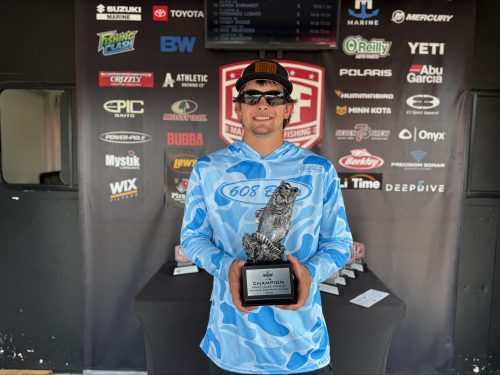
Nolan McKittrick of La Crosse, Wisconsin, won the co-angler division and $1,777 Saturday, after bringing three bass to the scale that totaled 10 pounds, 5 ounces.
The top 10 co-anglers finished:
1st: Nolan McKittrick, La Crosse, Wis., three bass, 10-5, $1,777
2nd: Thomas Bridges, Kankakee, Ill., three bass, 9-12, $938
3rd: Jeff Ripp, Sparta, Wis., three bass, 9-4, $592
4th: Blake Miller, Cedar Falls, Iowa, three bass, 9-2, $415
5th: Wil Plank, Holmen, Wis., three bass, 8-15, $355
6th: Danny Mancini, Necedah, Wis., three bass, 8-14, $326
7th: Timothy Wittren, Ontario, Wis., three bass, 8-12, $266
7th: Mark Folsom, Waterville, Iowa, three bass, 8-12, $266
7th: Sean Ricker, Springfield, Ill., three bass, 8-12, $266
10th: Art Gneuhs, Plainfield, Ill., three bass, 8-9, $207
Brad Parent of Oakdale, Minnesota, earned the Berkley Big Bass co-angler award of $227, catching a bass that weighed in at 4 pounds – the largest co-angler catch of the day.
After three events, Wyatt Becker of West Salem, Wisconsin, now leads the Fishing Clash Great Lakes Division Angler of the Year (AOY) race with 734 points, while Timothy Wittren of Ontario, Wisconsin, leads the Fishing Clash Great Lakes Division Co-Angler of the Year race with 714 points.
The next event for BFL Great Lakes Division anglers will be held Sept. 22, on the Wolf River Chain of Lakes out of Winneconne, Wisconsin. To register for the event as a boater or a co-angler, visit MajorLeagueFishing.com or call (270)-252-1000.
The top 60 boaters and co-anglers in the division based on point standings, along with the five tournament winners of each qualifying event, will qualify for the Oct. 3-4 BFL Regional tournament on the Mississippi River out of Quad Cities, Illinois. Boaters will fish for a top award of a new Phoenix 819 Pro with a 200-horsepower Mercury or Suzuki outboard worth $50,000, while co-anglers will compete for a top award of $20,000.
The 2025 Phoenix BFL Presented by T-H Marine is a 24-division circuit devoted to weekend anglers, with 134 events throughout the season, five qualifying tournaments in each division. The top 60 boaters and co-anglers from each division, along with the five qualifying tournament winners, will advance to one of 12 BFL Regional tournaments where they are competing to finish in the top three, which then qualifies them for one of the longest-running championships in all of competitive bass fishing – the BFL All-American.
Proud sponsors of the 2025 MLF Phoenix Bass Fishing League Presented by T-H Marine include: 7Brew, Abu Garcia, Athletic Brewing, B&W Trailer Hitches, Berkley, BUBBA, Deep Dive App, E3 Sport Apparel, Epic Baits, Fishing Clash, Grizzly, Humminbird, Lew’s, Li Time Batteries, Mercury, Minn Kota, Mossy Oak, Mystik Lubricants, Onyx, O’Reilly Auto Parts, Phoenix Boats, Polaris, Power-Pole, Precision Sonar, Strike King, Suzuki Marine, Tackle Warehouse, T-H Marine, Toyota, WIX Filters and YETI.
For complete details and updated tournament information, visit MajorLeagueFishing.com. For regular Bass Fishing League updates, photos, tournament news and more, follow MLF5’s social media outlets at Facebook, Instagram, and YouTube.
About Major League Fishing
Major League Fishing (MLF) is the world’s largest tournament-fishing organization, producing more than 250 events annually at some of the most prestigious fisheries in the world, while broadcasting to America’s living rooms on CBS, Discovery Channel, Outdoor Channel, CBS Sports Network, World Fishing Network and on demand on MyOutdoorTV (MOTV). Headquartered in Benton, Kentucky, the MLF roster of bass anglers includes the world’s top pros and more than 30,000 competitors in all 50 states and 20 countries. Since its founding in 2011, MLF has advanced the sport of competitive fishing through its premier television broadcasts and livestreams and is dedicated to improving the quality of life for bass through research, education, fisheries enhancement and fish care.
Kansan Sloan Flips Bushes to Win Phoenix Bass Fishing League Event at Truman Lake Presented by Witch Doctor Tackle
Kansan Lay Tops Co-Angler Division
WARSAW, Mo. (June 16, 2025) – Boater Kenny Sloan of Gaylord, Kansas, caught a five-bass limit weighing 17 pounds, 12 ounces, Saturday to win the MLF Phoenix Bass Fishing League (BFL) Presented by T-H Marine on Truman Lake Presented by Witch Doctor Tackle. The tournament was the fourth event of the season for the BFL Ozark Division. Sloan earned $3,979 for his victory.
Sloan recently relocated to north-central Kansas to train bird dogs and spend his fall hunting quail, but he’s fished Truman Lake his entire life. His experienced helped him deal with pressured fish and water that is around 9 feet high.
“It was really good today,” he said. “I had eight keepers. I culled twice. I stayed in the Grand River arm, which is what I usually fish, for the most part. I have my whole life.”
He kept his presentation simple, flipping Texas-rigged soft plastics around flooded bushes.
“I’ve got points and spots that I typically fish, and I just kind of went over that stuff and moved around. The pressure was real bad today with all the people. I went up the Grand River arm quite a ways to get away from all the pressure, and that’s where I caught several of my fish.”
The top 10 boaters finished the tournament:
1st: Kenny Sloan, Gaylord, Kan., five bass, 17-12, $3,979
2nd: Oliver Siebert, Fenton, Mo., five bass, 16-0, $1,940
3rd: Marcus Sykora, Osage Beach, Mo., five bass, 15-10, $1,793 (includes $500 Phoenix MLF Contingency Bonus)
4th: Nathan Portell, Festus, Mo., five bass, 15-5, $1,162
5th: Roger Fitzpatrick, Eldon, Mo., five bass, 14-15, $776
6th: Brock Reinkemeyer, Warsaw, Mo., five bass, 14-5, $711
7th: Andres Jackson, Crystal City, Mo., five bass, 13-8, $647
8th: Lance Williams, Billings, Mo., five bass, 13-7, $582
9th: Shane Long, Willard, Mo., five bass, 13-3, $517
10th: Kyle Alsop, Overland Park, Kan., five bass, 13-0, $453
Complete results can be found at MajorLeagueFishing.com.
Nathan Portell of Festus, Missouri, and Alex Avery of West Plains, Missouri, each caught a bass that weighed 4 pounds, 11 ounces, earning them a tie for the Berkley Big Bass Boater award. They each took home $257 for their share of the prize.
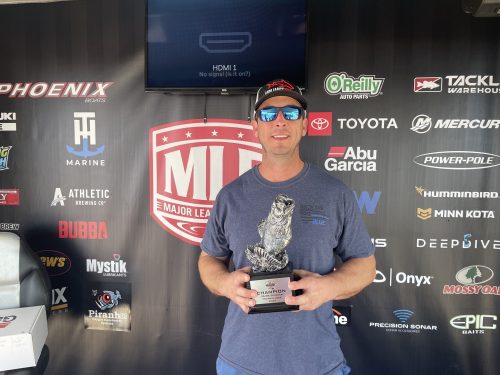
Joseph Lay of Gardner, Kansas, won the co-angler division and $1,940 Saturday, after bringing three bass to the scale that totaled 9 pounds, 6 ounces.
The top 10 co-anglers finished:
1st: Joseph Lay, Gardner, Kan., three bass, 9-6, $1,940
2nd: Matt Zimmerly, Hillsboro, Mo., two bass, 9-0, $1,227
3rd: Dennis Spell, Bonne Terre, Mo., three bass, 8-15, $696
4th: Thad Hewitt, Delaware, Okla., three bass, 8-10, $520
4th: Ryan Doel, Springfield, Mo., three bass, 8-10, $420
6th: Roy Bradford, Ashland, Mo., three bass, 8-9, $356
7th: Donald Pailer, Arnold, Mo., three bass, 8-3, $291
7th: Bobbie Green, Greenwood, Mo., three bass 8-3, , $291
7th: Stephen Babcock, Belton, Mo., three bass, 8-3, $291
10th: Jeff Moss, Oronogo, Mo., three bass, 8-2, $226
Matt Zimmerly of Hillsboro, Missouri, earned the Berkley Big Bass co-angler award of $257, catching a bass that weighed in at 6 pounds, 1 ounce – the largest co-angler catch of the day.
After four events, Eric Olliverson of Shell Knob, Missouri, now leads the Fishing Clash Ozark Division Angler of the Year (AOY) race with 976 points, while Dennis Spell of Bonne Terre, Missouri, leads the Fishing Clash Ozark Division Co-Angler of the Year race with 956 points.
The fifth and final regular-season event for BFL Ozark Division anglers will be held Sept. 13-14, at Lake of the Ozarks in Osage Beach, Missouri. To register for the event as a boater or a co-angler, visit MajorLeagueFishing.com or call (270)-252-1000.
The top 60 boaters and co-anglers in the division based on point standings, along with the five tournament winners of each qualifying event, will qualify for the Oct. 10-11 BFL Regional tournament on Grand Lake in Grove, Oklahoma. Boaters will fish for a top award of a new Phoenix 819 Pro with a 200-horsepower Mercury or Suzuki outboard worth $50,000, while co-anglers will compete for a top award of $20,000.
The 2025 Phoenix BFL Presented by T-H Marine is a 24-division circuit devoted to weekend anglers, with 134 events throughout the season, five qualifying tournaments in each division. The top 60 boaters and co-anglers from each division, along with the five qualifying tournament winners, will advance to one of 12 BFL Regional tournaments where they are competing to finish in the top three, which then qualifies them for one of the longest-running championships in all of competitive bass fishing – the BFL All-American.
Proud sponsors of the 2025 MLF Phoenix Bass Fishing League Presented by T-H Marine include: 7Brew, Abu Garcia, Athletic Brewing, B&W Trailer Hitches, Berkley, BUBBA, Deep Dive App, E3 Sport Apparel, Epic Baits, Fishing Clash, Grizzly, Humminbird, Lew’s, Li Time Batteries, Mercury, Minn Kota, Mossy Oak, Mystik Lubricants, Onyx, O’Reilly Auto Parts, Phoenix Boats, Polaris, Power-Pole, Precision Sonar, Strike King, Suzuki Marine, Tackle Warehouse, T-H Marine, Toyota, WIX Filters and YETI.
For complete details and updated tournament information, visit MajorLeagueFishing.com. For regular Bass Fishing League updates, photos, tournament news and more, follow MLF5’s social media outlets at Facebook, Instagram, and YouTube.
About Major League Fishing
Major League Fishing (MLF) is the world’s largest tournament-fishing organization, producing more than 250 events annually at some of the most prestigious fisheries in the world, while broadcasting to America’s living rooms on CBS, Discovery Channel, Outdoor Channel, CBS Sports Network, World Fishing Network and on demand on MyOutdoorTV (MOTV). Headquartered in Benton, Kentucky, the MLF roster of bass anglers includes the world’s top pros and more than 30,000 competitors in all 50 states and 20 countries. Since its founding in 2011, MLF has advanced the sport of competitive fishing through its premier television broadcasts and livestreams and is dedicated to improving the quality of life for bass through research, education, fisheries enhancement and fish care.
Norton’s Oldham Gets the Win at Phoenix Bass Fishing League Event at Mosquito Lake Presented by Lew’s
Troy’s Blinn Tops Co-Angler Division
CORTLAND, Ohio. (June 16, 2025) – Boater Trevor Oldham of Norton, Ohio, caught a five-bass limit weighing 16 pounds, 4 ounces, Saturday to win the MLF Phoenix Bass Fishing League (BFL) Presented by T-H Marine on Mosquito Lake Presented by Lew’s . The tournament was the second event of the season for the BFL Buckeye Division. Oldham earned $11,456, including the lucrative $7,000 Phoenix MLF Contingency Bonus, for his victory.
Oldham estimates that he and his co-angler partner, Vernell Day, combined to catch about 60 fish, but they had to sort through a bunch of shorts to find the better-quality bites. They rotated through 15 or so areas throughout the day.
“I know the lake pretty darn well, so we kind of were running and gunning for the first bit in the morning, just trying to get a feel for the day,” Oldham said. “Then I kind of settled in and rotated like four different areas where we were getting a little better bites.”
His best area wound up being a 200-yard stretch of stumps in 8 to 12 feet of water where he’d fished during a local tournament the week before.
“Basically, we found one area that had hard bottom and stumps and pretty much caught three good fish there,” he said. “I caught a 5-7 there, a 4-pounder and a high 3, and that was pretty much the anchor of the bag.
“For me, the stump bite doesn’t really get going ’til a little bit later in the morning. So we actually started fishing on some bluegills beds and some hard spots, more shallow grass line kind of stuff (in the morning).”
Oldham relied on a pair of jigs. He used a 1/2-ounce football head and a 1/2-ounce pitching jig. He also caught one key fish on a minnow bait.
“That was about it,” he added. “I keep it pretty simple out there.”
The top 10 boaters finished the tournament:
1st: Trevor Oldham, Norton, Ohio, five bass, 16-4, $11,456 (includes $7,000 Phoenix MLF COntingency Bonus)
2nd: Pat Upthagrove, Monroe, Mich., five bass, 14-5, $1,963
3th: Larry Freeman, Waynesburg, Pa., five bass, 12-15, $1,309
4th: Corey Johnson, Tipp City, Ohio, five bass, 12-8, $916
5th: Jack Dalzell, Elyria, Ohio, five bass, 11-15, $752
5th: Seth Fricke, Oxford, Ohio, five bass, 11-15, $852
7th: Joel Berelsman, Minster, Ohio, five bass, 11-12, $654
8th: Travis Millard, Carlisle, Ohio, five bass, 11-8, $589
9th: Roy Lester, Hamilton, Ohio, five bass, 11-7, $523
10th: David Hoheisel, Westerville, Ohio, five bass, 10-12, $458
Complete results can be found at MajorLeagueFishing.com.
Oldham caught a bass that weighed 5 pounds, 7 ounces, and earned the Berkley Big Bass Boater award of $530.
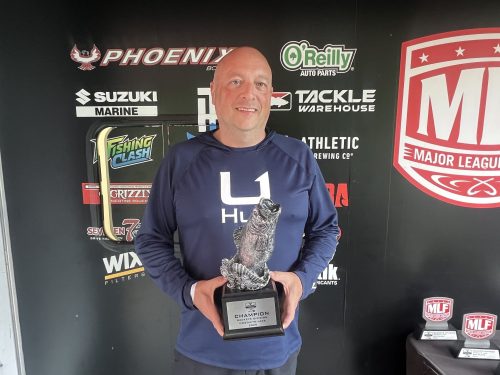
Brian Blinn of Troy, Ohio, won the co-angler division and $1,963 Saturday, after bringing three bass to the scale that totaled 9 pounds, 3 ounces.
The top 10 co-anglers finished:
1st: Brian Blinn, Troy, Ohio, three bass, 9-3, $1,963
2nd: Mark Conner, North Canton, Ohio, three bass, 7-15, $1,246
3rd: Austin Brock, West Chester, Ohio, three bass, 7-13, $655
4th: Eric McKean, New Philadelphia, Ohio, three bass, 7-10, $458
5th: Ryan Sykes, Hamilton, Ohio, three bass, 7-9, $526
5th: Kenneth Ritchie, Trenton, Ohio, three bass, 7-9, $376
7th: Edward Seiler, Lancaster, Ohio, three bass, 7-7, $327
8th: David Prater, Franklin, Ohio, three bass, 7-5, $278
8th: Thomas (Tom) Illar Jr., Hyde Park, Pa., three bass, 7-5, $278
10th: Ryan Rich, Eaton, Ohio, three bass, 7-1, $229
Mark Conner of North Canton, Ohio, earned the Berkley Big Bass co-angler award of $265, catching a bass that weighed in at 4 pounds, 11 ounces – the largest co-angler catch of the day.
After two events, Seth Fricke of Oxford, Ohio, now leads the Fishing Clash Buckeye Division Angler of the Year (AOY) race with 479 points, while Jesse Foster of Franklin, Ohio, leads the Fishing Clash Buckeye Division Co-Angler of the Year race with 470 points.
The next event for BFL Buckeye Division anglers will be held July 19, at the Ohio River-Tanners Creek out of Lawrenceburg, Indiana. To register for the event as a boater or a co-angler, visit MajorLeagueFishing.com or call (270)-252-1000.
The top 60 boaters and co-anglers in the division based on point standings, along with the five tournament winners of each qualifying event, will qualify for the Oct. 3-4 BFL Regional tournament on Lake Erie out of Sandusky, Ohio. Boaters will fish for a top award of a new Phoenix 819 Pro with a 200-horsepower Mercury or Suzuki outboard worth $50,000, while co-anglers will compete for a top award of $20,000.
The 2025 Phoenix BFL Presented by T-H Marine is a 24-division circuit devoted to weekend anglers, with 134 events throughout the season, five qualifying tournaments in each division. The top 60 boaters and co-anglers from each division, along with the five qualifying tournament winners, will advance to one of 12 BFL Regional tournaments where they are competing to finish in the top three, which then qualifies them for one of the longest-running championships in all of competitive bass fishing – the BFL All-American.
Proud sponsors of the 2025 MLF Phoenix Bass Fishing League Presented by T-H Marine include: 7Brew, Abu Garcia, Athletic Brewing, B&W Trailer Hitches, Berkley, BUBBA, Deep Dive App, E3 Sport Apparel, Epic Baits, Fishing Clash, Grizzly, Humminbird, Lew’s, Li Time Batteries, Mercury, Minn Kota, Mossy Oak, Mystik Lubricants, Onyx, O’Reilly Auto Parts, Phoenix Boats, Polaris, Power-Pole, Precision Sonar, Strike King, Suzuki Marine, Tackle Warehouse, T-H Marine, Toyota, WIX Filters and YETI.
For complete details and updated tournament information, visit MajorLeagueFishing.com. For regular Bass Fishing League updates, photos, tournament news and more, follow MLF5’s social media outlets at Facebook, Instagram, and YouTube.
About Major League Fishing
Major League Fishing (MLF) is the world’s largest tournament-fishing organization, producing more than 250 events annually at some of the most prestigious fisheries in the world, while broadcasting to America’s living rooms on CBS, Discovery Channel, Outdoor Channel, CBS Sports Network, World Fishing Network and on demand on MyOutdoorTV (MOTV). Headquartered in Benton, Kentucky, the MLF roster of bass anglers includes the world’s top pros and more than 30,000 competitors in all 50 states and 20 countries. Since its founding in 2011, MLF has advanced the sport of competitive fishing through its premier television broadcasts and livestreams and is dedicated to improving the quality of life for bass through research, education, fisheries enhancement and fish care.
27-Year-Old Knight Wins His First at Phoenix Bass Fishing League Event at Kentucky-Barkley Lakes
Tennessee’s Nolen Tops Co-Angler Division
GILBERTSVILLE, Ky. (June 16, 2025) – Boater Clint Knight of Russellville, Kentucky, caught a three-bass limit weighing 15 pounds Saturday to win the MLF Phoenix Bass Fishing League (BFL) Presented by T-H Marine on Kentucky-Barkley Lakes . The tournament, hosted by Kentucky Lake Convention & Visitors Bureau, was the third event of the season for the BFL LBL Division. Knight earned $3,794 for his victory.
Knight used an old-school Kentucky Lake ledge fishing practice strategy to prepare for this tournament. The key: not actually fishing.
“I idled for almost about 14 hours,” he said. “I found 31 schools, and I just tried to be as productive as I could. I didn’t really waste that much time on them. Especially with this being a three-fish tournament (anglers were limited to three bass in their limit), I tried to target 4-plus-pounders. I’ve been so close so many times. I’ve been second through 10th, and I really just wanted to win one so bad.”
The preparation paid off. Knight targeted most of his schools in 15 to 25 feet of water. He started right outside the takeoff around Moors resort, then ran to the dam. By the time he was done, he’d fished all the way to Paris, Tennessee. In between, he caught enough good ones, he figures, that his best five would’ve surpassed 24 pounds. The three he brought to weigh-in included a 4 1/2-pound smallmouth – the only smallie he caught all day.
“Where I started it helped because I did catch a 5-pounder early,” Knight added. “I had 11-something off my first stop, and throughout the day I kept hitting as many spots as I could. Then about 1 o’clock I had 13 1/2, and I knew I was probably one bite away. I actually found a new school today during the tournament. I was so focused on trying to find a school that was set up correctly. A lot of people had already busted them up. When they’re not set up correctly, it’s very hard to catch a big one.”
The new school produced in a big way. Knight landed a 5-plus-pounder, which culled out a 3 1/2, earning him the win by 10 ounces.
“I cycled through baits,” he said. “It was kind of a typical ledge deal. I started off with a (Strike King) 8XD, and just watching the Major League Fishing (Bass Pro Tour) last week, seeing how productive a Carolina rig was, I threw that in. And I threw a minnow bait in there, and a big spoon, too. Once I knew they’d seen my bait, if they didn’t bite it the first time, I just tried to keep a good cycle.”
For a guy that didn’t even have a true fishing boat until a few years ago, Knight is off to a heck of a start as a tournament angler. The 27-year-old, who works for a masonry company, has earned 16 top-10 finishes across MLF circuits since 2022. That includes finishing fourth in the 2025 BFL All-American just a couple weeks ago.
The top 10 boaters finished the tournament:
1st: Clint Knight, Russellville, Ky., three bass, 15-0, $3,794
2nd: Levi Kohl, Edinburg, Ill., three bass, 14-6, $1,897
3rd: Jeff DeFew, Benton, Ky., three bass, 13-11, $1,265
4th: Harlan Thomas, Paducah, Ky., three bass, 13-10, $885
5th: Ryan Kirkpatrick, Benton, Ky., three bass, 13-9, $1,254
6th: Brad Hutcheson, Hornbeak, Tenn., three bass, 13-6, $696
7th: Harbor Lovin, New Concord, Ky., three bass, 13-2, $732
8th: Chase Dempsey, Marion, Ky., three bass, 13-0, $569
9th: Micah Mulvany, Salem, Ill., three bass, 12-11, $506
10th: Sam Boss, Paducah, Ky., three bass, 12-10, $443
Complete results can be found at MajorLeagueFishing.com.
Ryan Kirkpatrick of Benton, Kentucky, caught a bass that weighed 6 pounds, 6 ounces, and earned the Berkley Big Bass Boater award of $495.
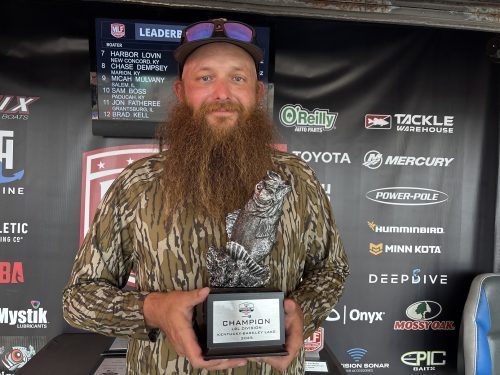
Daniel Nolen of Lexington, Tennessee, won the co-angler division and $2,144 Saturday, after bringing three bass to the scale that totaled 11 pounds, 3 ounces.
The top 10 co-anglers finished:
1st: Daniel Nolen, Lexington, Tenn., three bass, 11-3, $2,144
2nd: Carson Fitzgerald, Whitesville, Ky., three bass, 11-2, $949
3rd: Josh Mileur, Murphysboro, Ill., three bass, 10-13, $633
4th: Mitchell Adams Sr., Smyrna, Tenn., three bass, 9-11, $443
5th: Javon Booker, Beaver Dam, Ky., three bass, 9-6, $379
6th: Adam Lucas, Cape Girardeau, Mo., three bass, 8-15, $348
7th: Hunter Holguin, Knoxville, Tenn., three bass, 8-3, $300
7th: Jeff Johnston, Nashville, Tenn., three bass, 8-3, $300
9th: Jim Elmore, Independence, Ky., three bass, 8-1, $237
9th: Tim Burke, Burlington, Ky., three bass, 8-1, $237
Daniel Nolen of Lexington, Tennessee, earned the Berkley Big Bass co-angler award of $247, catching a bass that weighed in at 5 pounds, 5 ounces – the largest co-angler catch of the day.
After three events, Levi Kohl of Edinburg, Illinois, now leads the Fishing Clash LBL Division Angler of the Year (AOY) race with 747 points, while Daniel Nolen of Lexington, Tennessee, leads the Fishing Clash LBL Division Co-Angler of the Year race with 744 points.
The next event for BFL LBL Division anglers will be held July 12, at Kentucky-Barkley Lakes in Gilbertsville, Kentucky. To register for the event as a boater or a co-angler, visit MajorLeagueFishing.com or call (270)-252-1000.
The top 60 boaters and co-anglers in the division based on point standings, along with the five tournament winners of each qualifying event, will qualify for the Oct. 24-25 BFL Regional tournament on Dale Hollow Lake in Byrdstown, Tennessee. Boaters will fish for a top award of a new Phoenix 819 Pro with a 200-horsepower Mercury or Suzuki outboard worth $50,000, while co-anglers will compete for a top award of $20,000.
The 2025 Phoenix BFL Presented by T-H Marine is a 24-division circuit devoted to weekend anglers, with 134 events throughout the season, five qualifying tournaments in each division. The top 60 boaters and co-anglers from each division, along with the five qualifying tournament winners, will advance to one of 12 BFL Regional tournaments where they are competing to finish in the top three, which then qualifies them for one of the longest-running championships in all of competitive bass fishing – the BFL All-American.
Proud sponsors of the 2025 MLF Phoenix Bass Fishing League Presented by T-H Marine include: 7Brew, Abu Garcia, Athletic Brewing, B&W Trailer Hitches, Berkley, BUBBA, Deep Dive App, E3 Sport Apparel, Epic Baits, Fishing Clash, Grizzly, Humminbird, Lew’s, Li Time Batteries, Mercury, Minn Kota, Mossy Oak, Mystik Lubricants, Onyx, O’Reilly Auto Parts, Phoenix Boats, Polaris, Power-Pole, Precision Sonar, Strike King, Suzuki Marine, Tackle Warehouse, T-H Marine, Toyota, WIX Filters and YETI.
For complete details and updated tournament information, visit MajorLeagueFishing.com. For regular Bass Fishing League updates, photos, tournament news and more, follow MLF5’s social media outlets at Facebook, Instagram, and YouTube.
About Major League Fishing
Major League Fishing (MLF) is the world’s largest tournament-fishing organization, producing more than 250 events annually at some of the most prestigious fisheries in the world, while broadcasting to America’s living rooms on CBS, Discovery Channel, Outdoor Channel, CBS Sports Network, World Fishing Network and on demand on MyOutdoorTV (MOTV). Headquartered in Benton, Kentucky, the MLF roster of bass anglers includes the world’s top pros and more than 30,000 competitors in all 50 states and 20 countries. Since its founding in 2011, MLF has advanced the sport of competitive fishing through its premier television broadcasts and livestreams and is dedicated to improving the quality of life for bass through research, education, fisheries enhancement and fish care.
Monticello’s Kenney Posts Fourth Career Win at Phoenix Bass Fishing League Event at Lake Sinclair Presented by Suzuki Marine
Covington’s Chandler Tops Co-Angler Division
MILLEDGEVILLE, Ga. (June 16, 2025) – Boater Byron Kenney of Monticello, Georgia, caught a five-bass limit weighing 17 pounds, 10 ounces, Saturday to win the MLF Phoenix Bass Fishing League (BFL) Presented by T-H Marine on Lake Sinclair Presented by Suzuki Marine. The tournament was the fourth event of the season for the BFL Bulldog Division. Kenney earned $3,641 for his victory.
Kenny experienced a slow start. In fact, fishing was much tougher than he expected, considering how well Sinclair has fished recently. But he scrapped around, kept his head down and eventually righted the ship, catching his first keeper at around 9 a.m.
“I started fishing docks with a jig, and the Lord just blessed me with the good ones, I guess,” he said. “I didn’t catch a lot of fish. I caught eight or nine. I wish I could say there was some rhyme or reason (to where he caught them), but really it was just covering as much water as possible.
“Normally, the morning bite is really crucial,” Kenny added. “But I didn’t catch another good one until about 10:40, and then I caught back-to-back 4s. It was just tough. I just grinded around. I fished the rest of the day, and it probably wasn’t until around 2 o’clock that I caught another good one. I had four good ones and just a 2-pounder.”
Kenny caught his winning fish on a 1/2-ounce “nothing special” jig.
“I was just my faith and just fishing hard, and the Lord just blessed me,” he said.
The top 10 boaters finished the tournament:
1st: Byron Kenney, Monticello, Ga., five bass, 17-10, $3,641
2nd: John Pearson, Perry, Ga., five bass, 15-8, $1,820
3rd: Ryan Thomas, Madison, Ga., five bass, 15-3, $1,214
4th: Jamie M. Fountain, East Dublin, Ga., five bass, 15-2, $950
5th: David Millsaps, Ranger, Ga., five bass, 13-14, $1,228
6th: Travis Clay, Jackson, Ga., five bass, 13-9, $668
7th: Matt O'Connell, Brooks, Ga., five bass, 13-6, $1,232 (includes $500 Phoenix MLF Contingency Bonus)
8th: Callaway Robinson, Conyers, Ga., five bass, 13-5, $546
9th: John Duvall, Madison, Ga., five bass, 12-14, $485
10th: Brooks Anderson, Marietta, Ga., five bass, 12-12, $425
Complete results can be found at MajorLeagueFishing.com.
Michael Dike III of Acworth, Georgia, caught a bass that weighed 6 pounds, 6 ounces, and earned the Berkley Big Bass Boater award of $475.
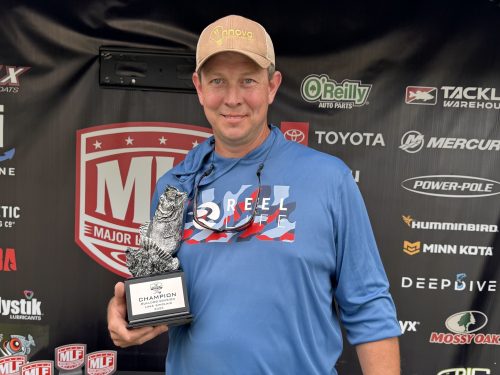
Jacob Chandler of Covington, Georgia, won the co-angler division and $1,820 Saturday, after bringing three bass to the scale that totaled 9 pounds, 15 ounces.
The top 10 co-anglers finished:
1st: Jacob Chandler, Covington, Ga., three bass, 9-15, $1,820
2nd: Harold Grizzle, Gainesville, Ga., three bass, 9-10, $910
3rd: Jackson Ford, Loganville, Ga., three bass, 9-5, $607
4th: Clayton Faircloth, Milledgeville, Ga., three bass, 8-3, $425
5th: William Thomas Cowart, Danielsville, Ga., three bass, 8-2, $364
6th: Timothy Stone, Conyers, Ga., three bass, 7-15, $571
7th: Bryan Burch, Climax, Ga., three bass, 7-10, $303
8th: Jeff Stone, Jackson, Ga., three bass, 7-4, $273
9th: Michael O’Neal, Cleveland, Ga., three bass, 7-0, $243
10th: Conery Williams, Macon, Ga., three bass, 6-14, $212
Timothy Stone of Conyers, Georgia, earned the Berkley Big Bass co-angler award of $237, catching a bass that weighed in at 5 pounds, 13 ounces – the largest co-angler catch of the day.
After four events, Michael Wilder of Lizella, Georgia, now leads the Fishing Clash Bulldog Division Angler of the Year (AOY) race with 947 points, while Daniel Arnberg of Auburn, Alabama, leads the Fishing Clash Bulldog Division Co-Angler of the Year race with 942 points.
The fifth and final regular-season event for BFL Bulldog Division anglers will be held Aug. 23-24, at Lake Lanier in Gainesville, Georgia. To register for the event as a boater or a co-angler, visit MajorLeagueFishing.com or call (270)-252-1000.
The top 60 boaters and co-anglers in the division based on point standings, along with the five tournament winners of each qualifying event, will qualify for the Oct. 17-18 BFL Regional tournament on Lake Seminole in Bainbridge, Georgia. Boaters will fish for a top award of a new Phoenix 819 Pro with a 200-horsepower Mercury or Suzuki outboard worth $50,000, while co-anglers will compete for a top award of $20,000.
The 2025 Phoenix BFL Presented by T-H Marine is a 24-division circuit devoted to weekend anglers, with 134 events throughout the season, five qualifying tournaments in each division. The top 60 boaters and co-anglers from each division, along with the five qualifying tournament winners, will advance to one of 12 BFL Regional tournaments where they are competing to finish in the top three, which then qualifies them for one of the longest-running championships in all of competitive bass fishing – the BFL All-American.
Proud sponsors of the 2025 MLF Phoenix Bass Fishing League Presented by T-H Marine include: 7Brew, Abu Garcia, Athletic Brewing, B&W Trailer Hitches, Berkley, BUBBA, Deep Dive App, E3 Sport Apparel, Epic Baits, Fishing Clash, Grizzly, Humminbird, Lew’s, Li Time Batteries, Mercury, Minn Kota, Mossy Oak, Mystik Lubricants, Onyx, O’Reilly Auto Parts, Phoenix Boats, Polaris, Power-Pole, Precision Sonar, Strike King, Suzuki Marine, Tackle Warehouse, T-H Marine, Toyota, WIX Filters and YETI.
For complete details and updated tournament information, visit MajorLeagueFishing.com. For regular Bass Fishing League updates, photos, tournament news and more, follow MLF5’s social media outlets at Facebook, Instagram, and YouTube.
About Major League Fishing
Major League Fishing (MLF) is the world’s largest tournament-fishing organization, producing more than 250 events annually at some of the most prestigious fisheries in the world, while broadcasting to America’s living rooms on CBS, Discovery Channel, Outdoor Channel, CBS Sports Network, World Fishing Network and on demand on MyOutdoorTV (MOTV). Headquartered in Benton, Kentucky, the MLF roster of bass anglers includes the world’s top pros and more than 30,000 competitors in all 50 states and 20 countries. Since its founding in 2011, MLF has advanced the sport of competitive fishing through its premier television broadcasts and livestreams and is dedicated to improving the quality of life for bass through research, education, fisheries enhancement and fish care.
Logan’s consistency pays off with victory at Lake Tenkiller

TAHLEQUAH, Okla. — Ten months ago, Wes Logan found himself in a hospital bed with a gash across his head and a set of broken bones after hitting an unknown object on Day 2 at the Bassmaster Elite at Lake Champlain. Logan knows how fortunate he is to even still be alive, making his second Progressive Bassmaster Elite Series trophy all the more meaningful.
“I could be dead. That is the reality of it,” Logan said. “The good Lord wants me here for some reason. I’m truly blessed to be here.”
Arguably the most consistent angler all week, Logan won the Lowrance Bassmaster Elite at Lake Tenkiller with a four-day total of 63 pounds, a Father’s Day gift for his father Doug. It is the second win of Logan’s five-year career, the first coming at the 2021 Bassmaster Elite at Neely Henry Lake on Mother’s Day.
“I don’t deserve this,” the Springville, Ala., native said. “I got to fish how I wanted to. I got to pitch a jig like how I grew up with my dad.”
Opening the tournament in 11th place with 14-12, Logan climbed to fifth on Day 2 with 15-13 before jumping into third on Semifinal Saturday with 15-9. He then landed the biggest bag of Championship Sunday, a 16-14 limit anchored by a 5-1 largemouth, edging out fellow Elite Series pro Andrew Loberg, who had led the first three days, by 1 ounce.
This victory couldn’t have come at a better time for the “Little Ball of Hate.” After two good tournaments to start the 2025 season, Logan has struggled outside of the state of Florida, so much so that he questioned if he still belonged on the Elite Series stage. He entered Lake Tenkiller in 40th place in Progressive Bassmaster Angler of the Year standings.
“This year has not been easy. I hit a wall and didn’t even know my last name,” Logan said. “After Lake Hartwell, I sat in Bill Lowen’s boat and cried my eyes out because I wanted to quit. I didn’t know if I was good enough to be here.
“Practice wasn’t that great for this tournament, but I got a few bites doing what I like to do, and I ran with it.”
Fluctuating water levels at Lake Tenkiller challenged the 101 Elite Series anglers all week long. Waters rose dramatically during the first half of official practice before falling several feet between the Wednesday off-day and Thursday’s opening round. More water entered the lake as multiple rounds of strong storms and heavy rains moved through the second and third tournament days.
All of this set up in Logan’s favor. Many of the similar scenarios he faced this week at Tenkiller he has seen on his home lake of Neely Henry, including where the bass tended to set up.
“For some reason, the little area I found, the bass just kept coming to it. I don’t really know why,” he said. “Six of the Top 10 were fishing this stretch, and I would pull in behind them and catch a 3-pounder.”
Logan mainly fished the upper end of Lake Tenkiller, focusing on flooded bushes and cover in shallow water. One particular laydown, Logan said, produced 12 of his keeper bites and dozens of other bass that didn’t make his team.
“It was on a straight bank. It was just a laydown with some limbs coming off of it,” he explained. “Every time I went to it, I caught one. It was just on a flat, nothing bank. I never saw any bream around it, but it seemed like there might be something like that going on. It’s a good tree. Best tree on the lake.”
A 1/2-ounce green pumpkin Ark Randall Tharp Signature Flipping Jig paired with a Zoom Salty Chunk produced several of his biggest bites around the flooded cover. On the final day, he received key bites around debris mats with a punch rig he built with a 1/2-ounce Ark tungsten weight, a green pumpkin punch skirt and a green pumpkin Zoom Z Hog.
He pitched both of those baits with a 7-foot-6 heavy Ark Wes Logan Signature Series FAFO Flipping Stick and 22-pound Sunline Shooter fluorocarbon.
Each morning, however, Logan started in a marina where he fished around the remnants of a shad spawn. He filled in a limit using a 1/2-ounce Z-Man JackHammer in the spot remover color paired with a ghost shad colored Zoom Shimmer Shad.
Logan started Championship Sunday by filling out an 11-pound limit in a new marina in a 45-minute flurry before heading to his best stretches of flooded cover. That initial limit included a 3-pound smallmouth. The water rose noticeably on Day 4, but Logan was able to trigger key bites throughout the day, including that 5-1 that earned Phoenix Boats Big Bass of the Day honors.
His one miss came around 11:30 a.m., when Logan hooked into a 4-pound largemouth that spit his jig after coming over a log. At that point, he was convinced he had lost the tournament.
“When it came off, I laid on the front deck of the boat and thought I lost 100 grand again,” Logan said. “Hardly ever do you lose a bass that big on a fishery like this and it doesn’t cost you.”
Later in the afternoon, Logan returned to his favorite tree and landed a 3-8, the bites he needed to get his head back in the game. Then, with minutes to go before check-in, Logan pitched his jig again to the magic tree and saw a bass miss his bait. He spun around, made several pitches to the tree, and got that bass to bite.
“I had a 2-11 and this bass weighed 2-13,” Logan said. “When it is meant to be, it is meant to be. Hats off to Andrew. He is a heck of a fisherman. He is going to win plenty.”
After leading the first three days of the tournament, Loberg fell to second with a total of 62-15.
“I’m just ready for the next one,” Loberg said.
Loberg took the Day 1 lead with a limit of largemouth weighing 17-9, backing it up with limits of 118-4 and 15-9 the next two days. On the final day, the California native only landed 11-9 and missed his biggest bite, which allowed Logan to overtake him.
“The water came up and we had sort of a post-front deal going on,” Loberg said. “My areas kind of dried up on me.”
The 31-year-old rookie employed a similar strategy as Logan, starting the morning in a marina before fishing around shallow cover the rest of the day. A Strike King Rage Bug on a 1/2-ounce weight was his best producing bait around wood while the marina fish fell for a ChatterBait and a Lucky Craft 1.5 squarebill.
Opelika, Ala., pro Kyle Welcher climbed into third place, collecting limits weighing 15-15, 12-13, 16-13 and 14-12 for a total of 60-5. Welcher’s best area was one of the major creeks on the lake's northern end, which was clear enough to sight fish a bedding smallmouth on Day 2, but turned dirty with heavy current by the final day.
The 2023 Progressive Bassmaster Angler of the Year felt right at home in that current though, catching quality smallmouth and largemouth off the current seams and current breaks. A Rapala CrushCity Bronco Bug, a Rapala CrushCity The Mayor and a vibrating jig all played into Welcher’s strategy.
“Today was kind of crazy,” he said. “I started on a shad spawn and caught one big one. I got into my best area and pushed up into some heavy current. All heck broke loose for a little while there. I caught two 3 1/2’s within five minutes and another nice one. But I couldn’t build on it the rest of the day.”
Logan’s 5-1 largemouth from Championship Sunday and Bryan New’s 5-1 from Day 2 split the Phoenix Boats Big Bass of the Tournament honors. Each angler earned a $1,000 bonus.
Huntington, Texas pro Keith Combs claimed the $2,000 Rapala CrushCity Monster Bag of the Tournament award with his 19-2 Day 2 limit while Virginia’s John Crews earned the $1,000 BassTrakk Contingency bonus for reporting accurate weights.
Not only did Logan with the $100,000 first-place prize, he also claimed $3,000 through Toyota Bonus Bucks and $4,000 through Yamaha Power Pay. Welcher earned a $2,000 Toyota Bonus Bucks bonus while Combs earned $2,500 through Yamaha Power Pay.
Wisconsin pro Jay Przekurat leads the Progressive Bassmaster Angler of the Year race with 598 points, but a lead that was over 40 points entering the Lake Tenkiller event has shrunk. Canadian pro Chris Johnston is second with 595 points, only 3 points behind Przekurat. Illinois pro Trey McKinney is third with 586 points, South Carolina’s Patrick Walters is fourth with 553 points followed by Indiana’s Bill Lowen in fifth with 547 points. Kyoya Fujita, Will Davis Jr., Taku Ito, Shane LeHew and Paul Marks round out the Top 10.
Marks leads the Dakota Lithium Bassmaster Rookie of the Year race with 514 points followed by Alabama’s Tucker Smith in second with 451 points and Easton Fothergill in third with 435 points.
The Lowrance Bassmaster Elite at Lake Tenkiller was hosted by the Oklahoma Ozarks Tourism Association.
2025 Bassmaster Elite Series Platinum Sponsor: Progressive, Toyota
2025 Bassmaster Elite Series Premier Sponsors: Bass Pro Shops, Dakota Lithium, Humminbird, Mercury, Minn Kota, Nitro Boats, Power-Pole, Progressive Insurance, Ranger Boats, Rapala, Skeeter Boats, Yamaha
2025 Bassmaster Elite Series Supporting Sponsors: AFTCO, Daiwa, Garmin, Lew's, Lowrance, Triton Boats, VMC, Yokohama
About B.A.S.S.
B.A.S.S., which encompasses the Bassmaster tournament leagues, events and media platforms, is the worldwide authority on bass fishing and keeper of the culture of the sport, providing cutting-edge content on bass fishing whenever, wherever and however bass fishing fans want to use it. Headquartered in Birmingham, Ala., the organization’s fully integrated media platforms include the industry’s leading magazines (Bassmaster and B.A.S.S. Times), website (Bassmaster.com), TV show, radio show, social media programs and events. For more than 50 years, B.A.S.S. has been dedicated to access, conservation and youth fishing.
The Bassmaster Tournament Trail includes the most prestigious events at each level of competition, including the Progressive Bassmaster Elite Series, St. Croix Bassmaster Opens Series presented by SEVIIN, Mercury B.A.S.S. Nation Qualifier Series presented by Lowrance, Strike King Bassmaster College Series presented by Bass Pro Shops, Strike King Bassmaster High School Series, Bassmaster Junior Series, Bassmaster Team Championship, Newport Bassmaster Kayak Series presented by Native Watercraft, Bassmaster College Kayak Series, Yamaha Bassmaster Redfish Cup Championship presented by Skeeter and the ultimate celebration of competitive fishing, the Bass Pro Shops Bassmaster Classic presented by Under Armour.
-30-
Connect with #Bassmaster on Facebook, Instagram, Twitte
Media Contact: Mandy Pascal, Communications Manager, 334-414-8677, mpascal@bassmaster.com
2025 Lowrance Bassmaster Elite at Lake Tenkiller 6/12-6/15
Tenkiller Lake, Cookson OK.
(PROFESSIONAL) Standings Day 4
Angler Hometown No./lbs-oz Pts Total $$$
1. Wes Logan Springville, AL 20 63-00 104 $102,000.00
Day 1: 5 14-12 Day 2: 5 15-13 Day 3: 5 15-09 Day 4: 5 16-14
2. Andrew Loberg Guntersville, AL 20 62-15 103 $20,000.00
Day 1: 5 17-09 Day 2: 5 18-04 Day 3: 5 15-09 Day 4: 5 11-09
3. Kyle Welcher Valley, AL 20 60-05 102 $16,000.00
Day 1: 5 15-15 Day 2: 5 12-13 Day 3: 5 16-13 Day 4: 5 14-12
4. Brandon Card Salisbury, NC 20 59-00 101 $12,500.00
Day 1: 5 14-10 Day 2: 5 11-15 Day 3: 5 15-10 Day 4: 5 16-13
5. Bob Downey Detroit Lakes, MN 20 56-09 100 $11,750.00
Day 1: 5 16-02 Day 2: 5 14-10 Day 3: 5 14-00 Day 4: 5 11-13
6. Trey McKinney Carbondale, IL 20 56-01 99 $11,000.00
Day 1: 5 17-01 Day 2: 5 13-08 Day 3: 5 11-13 Day 4: 5 13-11
7. Keith Combs Huntington, TX 20 55-15 98 $12,500.00
Day 1: 5 15-15 Day 2: 5 19-02 Day 3: 5 12-08 Day 4: 5 08-06
8. KJ Queen Catawba, NC 20 54-07 97 $10,300.00
Day 1: 5 10-14 Day 2: 5 15-02 Day 3: 5 16-05 Day 4: 5 12-02
9. Logan Latuso Gonzales, LA 20 54-04 96 $11,200.00
Day 1: 5 12-08 Day 2: 5 13-09 Day 3: 5 16-07 Day 4: 5 11-12
10. Jordan Lee Cullman, AL 20 52-09 95 $10,000.00
Day 1: 5 16-01 Day 2: 5 12-12 Day 3: 5 13-05 Day 4: 5 10-07
------------------------------
PHOENIX BOATS BIG BASS
Day
1 Kyle Welcher Valley, AL 04-10 $1,000.00
2 Bryan New Leesville, SC 05-01 $1,000.00
3 Logan Latuso Gonzales, LA 04-10 $1,000.00
4 Wes Logan Springville, AL 05-01 $1,000.00
------------------------------
PHOENIX BOATS BIG BASS
Bryan New Leesville, SC 05-01 $1,000.00
Wes Logan Springville, AL 05-01 $1,000.00
RAPALA CRUSHCITY MONSTER BAG
Keith Combs Huntington, TX 19-02 $2,000.00
------------------------------
Totals
Day #Limits #Fish Weight
1 101 505 1260-12
2 101 505 1257-11
3 49 249 612-15
4 10 50 128-03
------------------------------
261 1309 3259-09
Loberg increases lead on Day 3 at Lake Tenkiller

TAHLEQUAH, Okla. — There have been very few constants during this week’s Lowrance Bassmaster Elite Series at Lake Tenkiller, but Progressive Bassmaster Elite Series rookie Andrew Loberg continues to make all of the right moves.
The California native landed 15 pounds, 9 ounces on Semifinal Saturday, increasing his three-day total to 51-6. Loberg has never trailed this week, opening the tournament with a 17-9 limit of largemouth before catching 18-4 on the second day. After only being separated by ounces after Friday’s weigh-in, the gap between him and second-place Keith Combs is now 3-13.
“It has been a really cool week. Nothing has set in,” Loberg said. “I’m just fishing the way I like to fish. It’s not like I have one hole I’m sitting on. I just wake up in the morning, launch the boat, buzz around and hope for the best.”
If he can hold the lead, Loberg will become the third rookie to claim an Elite Series trophy this season. Two of his roommates, Paul Marks and Tucker Smith, are responsible for those wins. The winning recipe in the house, he remarked, includes Cheez-Its, Pop-Tarts and fruit snacks.
Loberg has won two Toyota Series events in his West Coast career, but an Elite Series win would be the top accomplishment of his young career.
“I’m still in grind mode,” Loberg said. “All I’m thinking about is catching five more good ones.”
The weather continues to be unpredictable in eastern Oklahoma. Several rounds of thunderstorms moved through Friday night, bringing the lake levels up several inches in the process. Then, an intense line of storms moved through late Saturday morning and hung around during the early afternoon hours.
While earlier forecasts indicated a quieter Sunday, more inclement weather is now expected to impact the region overnight and into official tournament hours. The conditions, however, have played into the hands of the anglers fishing in shallow water, including Loberg who has spent most of his tournament fishing in less than 6 feet of water.
“It went up a quarter of a foot from yesterday at least,” Loberg said. “You run down the lake and there are waterfalls everywhere. So, it will probably be a lot higher (tomorrow).
“In practice, there was so much water, and you had to find certain banks that didn’t have water behind them. Now I’m finding water that has flatter and shallower pockets that the fish can move into.”
The 31-year-old, who now calls Grant, Ala., home, started the tournament with around 30 rods on the deck expecting to mix in shallow and deeper patterns. As the tournament has progressed, he has whittled it down to five or six rods. A Texas-rigged flipping bait was his go-to on Semifinal Saturday, but moving baits like a ChatterBait, a swim jig and Lucky Craft 1.5 crankbait have also come into play.
The upper section of the lake has produced the bulk of his weight, and while he has a seven-mile region of the lake dialed in, Loberg has been fishing new stretches of flooded bushes every day. In fact, several of his best bites from Day 3 all came from cover he had not yet fished this week. He has noticed the baitfish have been moving around and the bass seem to be moving out of the thickest cover.
“It is a pattern and something I can run, but the sketchy part is, it’s not like I have one (confidence) hole,” he explained. “I just launch the boat and have to figure it out.”
Loberg repeated his morning routine on Semifinal Saturday, opening the day by landing a limit around marina slips that were harboring a shad spawn. Moving baits have been key to triggering those bites.
“I didn’t get that one bonus fish there this morning,” Loberg said. “I scratched out a pretty small limit and then had to fish a bunch of new water.”
From there, Loberg moved around the upper end of the lake fishing flooded bushes with his flipping bait.
After those hefty storms moved over the lake in the early afternoon, Loberg caught two 3-pound largemouth in a 15-minute span just after 1:15 p.m., bolstering his bag and increasing his lead over the field. His final upgrade, a 2-10 according to BassTrakk, came with just 15 minutes before check-in time.
“I went to a stretch where I lost a big one this morning and got those two key bites flipping,” Loberg said. “It is good to know there are more fish moving up into those areas. But there was definitely a little window in the afternoon.”
After landing bags of 15-15 and 19-2 the first two days, Combs suffered his worst day so far on Day 3, landing a limit weighing 12-8. Still, the Huntington, Texas pro remains in second place with a three-day total of 47-9. The three-time Bassmaster champion has landed mostly largemouth, but several smallmouth have entered his livewell too.
“Andrew has a good lead,” Combs said. “Each day (of this tournament) is a different day, and totally different than practice. Today, the lake came back up and things I was really excited about after yesterday’s big bag just never materialized. You would think with all this weather they would just choke a bait, but they were barely getting it.
“The guy who reads the conditions the best and makes the best decisions is going to win this tournament.”
Combs started on a shallow offshore area and landed several smaller keepers before moving to a rock point. There, he caught a 2 1/2-pounder and filled out his limit, but also lost a 4-pound largemouth that would have bolstered his bag.
“I thought it was going to be a really good day,” Combs said. “After that, it stopped. I couldn’t get anything going anywhere I went. I probably caught 30 2-pounders yesterday. Today I wasn’t even getting bit.”
Watching the water go up, Combs decided to flip for a while, but did not find much success. As the afternoon wore on, he moved back to some of his better rock stretches and landed four quality bass in the last hour of the day.
“It is random,” he explained “I noticed there are times I can go down a good bank and not catch them and then come back an hour or two later and catch four or five nice fish. There’s a lot of small shad where I’m fishing, but I’ve been picking crawfish out of my livewell.”
Springville, Ala., pro Wes Logan jumped into third with a three-day total of 46-2. The Elite Series champion opened the tournament with 14-12 before landing 15-13 and 15-9 the next two days. Logan has also been fishing in shallow water, landing a mix of spotted bass and largemouth.
“When it started raining, I ran to where I thought the better-quality bass were. They were biting when I got there. I caught two nice ones right when I started fishing there,” he said. “I didn’t realize how many people were fishing in the same general area. I went up there earlier today and saw a bunch of people running around.”
Logan added that some of his better bites came around “off the wall stuff,” a product of trying to avoid areas his fellow competitors had just picked apart.
“I was watching where people weren't fishing,” he said. “I go over there and see if there would be anything a bass would be on. It has worked so far. But I’m going to have to have two 5-pounders to have a chance tomorrow.”
Louisiana’s Logan Latuso anchored his 16-7 Day 3 limit with a 4-10 largemouth, claiming Phoenix Boats Big Bass of the Day honors and launching him into the Top 10. South Carolina’s Bryan New leads the overall Phoenix Boats Big Bass of the Tournament race with a 5-1 largemouth he landed on Day 2.
Combs holds the Rapala CrushCity Monster Bag of the Tournament with his 19-2 Day 2 limit.
Wisconsin pro Jay Przekurat leads the Progressive Bassmaster Angler of the Year race with 598 points, but he leads second-place Chris Johnston by only 3 points. Neither angler made the final day cut at Lake Tenkiller. Illinois pro Trey McKinney is third with 585 points, but could make the gap tighter if he moves up from seventh place on the final day. South Carolina’s Patrick Walters is fourth with 553 points followed by Indiana's Bill Lowen in fifth with 547 points.
Marks currently leads the Dakota Lithium Bassmaster Rookie of the Year race with 514 points followed by Smith in second with 451 points and Easton Fothergill in third with 435 points.
The Top 10 anglers will launch from Chicken Creek Boat Ramp beginning at 6:30 a.m. CT tomorrow morning and check-in at 2:30 p.m. Weigh-in will begin at 3 p.m. at the Cherokee Casino in Tahlequah. The winner will earn the $100,000 first-place prize and a coveted blue trophy.
Bassmaster LIVE coverage of Championship Sunday at the Lowrance Bassmaster Elite at Lake Tenkiller will be available on FS1 from 8 a.m.-Noon with afternoon action to follow on FOX from Noon-3 p.m.
The Lowrance Bassmaster Elite at Lake Tenkiller is being hosted by the Oklahoma Ozarks Tourism Association.
2025 Bassmaster Elite Series Platinum Sponsor: Progressive, Toyota
2025 Bassmaster Elite Series Premier Sponsors: Bass Pro Shops, Dakota Lithium, Humminbird, Mercury, Minn Kota, Nitro Boats, Power-Pole, Progressive Insurance, Ranger Boats, Rapala, Skeeter Boats, Yamaha
2025 Bassmaster Elite Series Supporting Sponsors: AFTCO, Daiwa, Garmin, Lew's, Lowrance, Triton Boats, VMC, Yokohama
About B.A.S.S.
B.A.S.S., which encompasses the Bassmaster tournament leagues, events and media platforms, is the worldwide authority on bass fishing and keeper of the culture of the sport, providing cutting-edge content on bass fishing whenever, wherever and however bass fishing fans want to use it. Headquartered in Birmingham, Ala., the organization’s fully integrated media platforms include the industry’s leading magazines (Bassmaster and B.A.S.S. Times), website (Bassmaster.com), TV show, radio show, social media programs and events. For more than 50 years, B.A.S.S. has been dedicated to access, conservation and youth fishing.
The Bassmaster Tournament Trail includes the most prestigious events at each level of competition, including the Progressive Bassmaster Elite Series, St. Croix Bassmaster Opens Series presented by SEVIIN, Mercury B.A.S.S. Nation Qualifier Series presented by Lowrance, Strike King Bassmaster College Series presented by Bass Pro Shops, Strike King Bassmaster High School Series, Bassmaster Junior Series, Bassmaster Team Championship, Newport Bassmaster Kayak Series presented by Native Watercraft, Bassmaster College Kayak Series, Yamaha Bassmaster Redfish Cup Championship presented by Skeeter and the ultimate celebration of competitive fishing, the Bass Pro Shops Bassmaster Classic presented by Under Armour.
-30-
Connect with #Bassmaster on Facebook, Instagram, Twitte
Media Contact: Mandy Pascal, Communications Manager, 334-414-8677, mpascal@bassmaster.com
2025 Lowrance Bassmaster Elite at Lake Tenkiller 6/12-6/15
Tenkiller Lake, Cookson OK.
(PROFESSIONAL) Standings Day 3
Angler Hometown No./lbs-oz Pts Total $$$
1. Andrew Loberg Guntersville, AL 15 51-06 104
Day 1: 5 17-09 Day 2: 5 18-04 Day 3: 5 15-09
2. Keith Combs Huntington, TX 15 47-09 103
Day 1: 5 15-15 Day 2: 5 19-02 Day 3: 5 12-08
3. Wes Logan Springville, AL 15 46-02 102
Day 1: 5 14-12 Day 2: 5 15-13 Day 3: 5 15-09
4. Kyle Welcher Valley, AL 15 45-09 101 $1,000.00
Day 1: 5 15-15 Day 2: 5 12-13 Day 3: 5 16-13
5. Bob Downey Detroit Lakes, MN 15 44-12 100
Day 1: 5 16-02 Day 2: 5 14-10 Day 3: 5 14-00
6. Logan Latuso Gonzales, LA 15 42-08 99 $1,000.00
Day 1: 5 12-08 Day 2: 5 13-09 Day 3: 5 16-07
7. Trey McKinney Carbondale, IL 15 42-06 98
Day 1: 5 17-01 Day 2: 5 13-08 Day 3: 5 11-13
8. KJ Queen Catawba, NC 15 42-05 97
Day 1: 5 10-14 Day 2: 5 15-02 Day 3: 5 16-05
9. Brandon Card Salisbury, NC 15 42-03 96
Day 1: 5 14-10 Day 2: 5 11-15 Day 3: 5 15-10
10. Jordan Lee Cullman, AL 15 42-02 95
Day 1: 5 16-01 Day 2: 5 12-12 Day 3: 5 13-05
11. Brock Mosley Collinsville, MS 15 42-02 94 $7,000.00
Day 1: 5 12-10 Day 2: 5 15-06 Day 3: 5 14-02
12. Chris Johnston Otonabee Ontario CANADA 15 41-05 93 $7,000.00
Day 1: 5 15-15 Day 2: 5 13-03 Day 3: 5 12-03
13. Taku Ito Dalton GA JAPAN 15 41-04 92 $7,000.00
Day 1: 5 12-07 Day 2: 5 13-05 Day 3: 5 15-08
14. Gerald Swindle Guntersville, AL 15 41-02 91 $7,000.00
Day 1: 5 11-00 Day 2: 5 17-11 Day 3: 5 12-07
15. Kyle Patrick Cooperstown, NY 15 41-02 90 $7,000.00
Day 1: 5 14-05 Day 2: 5 13-05 Day 3: 5 13-08
16. Greg Hackney Gonzales, LA 15 41-01 89 $6,500.00
Day 1: 5 15-02 Day 2: 5 13-03 Day 3: 5 12-12
17. Dakota Ebare Brookeland, TX 15 40-14 88 $6,500.00
Day 1: 5 12-08 Day 2: 5 13-09 Day 3: 5 14-13
18. Timothy Dube Nashua , NH 15 40-13 87 $6,500.00
Day 1: 5 13-09 Day 2: 5 14-14 Day 3: 5 12-06
19. Justin Atkins Florence, AL 15 40-11 86 $6,500.00
Day 1: 5 12-10 Day 2: 5 14-07 Day 3: 5 13-10
20. Gregory DiPalma Millville, NJ 15 40-03 85 $6,500.00
Day 1: 5 14-01 Day 2: 5 14-07 Day 3: 5 11-11
21. Shane LeHew Catawba, NC 15 40-02 84 $6,000.00
Day 1: 5 14-09 Day 2: 5 11-15 Day 3: 5 13-10
22. Brandon Cobb Greenwood, SC 15 39-15 83 $6,000.00
Day 1: 5 12-09 Day 2: 5 12-15 Day 3: 5 14-07
23. Carl Jocumsen Queensland TN AUSTRALIA 15 39-10 82 $6,000.00
Day 1: 5 14-11 Day 2: 5 13-03 Day 3: 5 11-12
24. Tyler Williams Belgrade, ME 15 39-07 81 $6,000.00
Day 1: 5 14-04 Day 2: 5 12-11 Day 3: 5 12-08
25. Bill Lowen Brookville, IN 15 39-06 80 $6,000.00
Day 1: 5 12-14 Day 2: 5 14-07 Day 3: 5 12-01
26. Paul Marks Cumming, GA 15 39-06 79 $5,500.00
Day 1: 5 12-14 Day 2: 5 13-00 Day 3: 5 13-08
27. Ben Milliken Omaha, NE 15 39-05 78 $5,500.00
Day 1: 5 10-02 Day 2: 5 16-06 Day 3: 5 12-13
28. Caleb Kuphall Mukwonago, WI 15 39-00 77 $5,500.00
Day 1: 5 14-09 Day 2: 5 12-01 Day 3: 5 12-06
29. Brandon Lester Fayetteville, TN 15 38-15 76 $5,500.00
Day 1: 5 11-15 Day 2: 5 15-01 Day 3: 5 11-15
30. Evan Kung Pickering Ontario CANAD 15 38-10 75 $5,500.00
Day 1: 5 13-01 Day 2: 5 15-02 Day 3: 5 10-07
31. Patrick Walters Eutawville, SC 15 38-02 74 $5,500.00
Day 1: 5 13-15 Day 2: 5 11-03 Day 3: 5 13-00
32. Tyler Rivet Raceland, LA 15 38-01 73 $5,500.00
Day 1: 5 14-06 Day 2: 5 13-00 Day 3: 5 10-11
33. Cole Sands Johnson City, TN 15 38-01 72 $5,500.00
Day 1: 5 14-02 Day 2: 5 11-13 Day 3: 5 12-02
34. Matt Arey Shelby, NC 15 38-00 71 $5,500.00
Day 1: 5 13-10 Day 2: 5 13-01 Day 3: 5 11-05
35. Bryant Smith Roseville, CA 15 37-15 70 $5,500.00
Day 1: 5 12-09 Day 2: 5 13-15 Day 3: 5 11-07
36. Cody Meyer Eagle, ID 15 37-14 69 $5,500.00
Day 1: 5 14-05 Day 2: 5 11-08 Day 3: 5 12-01
37. Pat Schlapper Eleva, WI 15 37-09 68 $5,500.00
Day 1: 5 16-01 Day 2: 5 09-11 Day 3: 5 11-13
38. Bryan New Leesville, SC 15 37-08 67 $6,500.00
Day 1: 5 12-02 Day 2: 5 13-12 Day 3: 5 11-10
39. Logan Parks Auburn, AL 15 37-07 66 $5,500.00
Day 1: 5 13-14 Day 2: 5 12-10 Day 3: 5 10-15
40. Chris Zaldain Boyd, TX 15 37-06 65 $5,500.00
Day 1: 5 12-09 Day 2: 5 13-02 Day 3: 5 11-11
41. Justin Hamner Northport, AL 15 37-01 64 $5,500.00
Day 1: 5 11-06 Day 2: 5 14-06 Day 3: 5 11-05
42. Will Davis Jr Sylacauga, AL 15 36-14 63 $5,500.00
Day 1: 5 12-02 Day 2: 5 13-04 Day 3: 5 11-08
43. Jeff Gustafson Kenora, ON Ontario CANA 15 36-13 62 $5,500.00
Day 1: 5 13-10 Day 2: 5 11-09 Day 3: 5 11-10
44. Cory Johnston Otonabee CANADA 15 36-11 61 $5,500.00
Day 1: 5 15-15 Day 2: 5 12-15 Day 3: 5 07-13
45. Scott Canterbury Odenville, AL 15 36-08 60 $5,500.00
Day 1: 5 13-10 Day 2: 5 13-09 Day 3: 5 09-05
46. Brad Whatley Bivins, TX 15 36-05 59 $5,500.00
Day 1: 5 11-04 Day 2: 5 14-08 Day 3: 5 10-09
47. Paul Mueller Naugatuck, CT 15 35-10 58 $5,500.00
Day 1: 5 12-08 Day 2: 5 12-13 Day 3: 5 10-05
48. Cooper Gallant Bowmanville Ontario CAN 14 35-06 57 $5,500.00
Day 1: 5 14-01 Day 2: 5 13-03 Day 3: 4 08-02
49. Austin Felix Eden Prairie, MN 15 33-14 56 $5,500.00
Day 1: 5 13-12 Day 2: 5 13-07 Day 3: 5 06-11
50. Randy Howell Guntersville, AL 15 28-03 55 $5,500.00
Day 1: 5 14-05 Day 2: 5 11-04 Day 3: 5 02-10
------------------------------
PHOENIX BOATS BIG BASS
Day
1 Kyle Welcher Valley, AL 04-10 $1,000.00
2 Bryan New Leesville, SC 05-01 $1,000.00
3 Logan Latuso Gonzales, LA 04-10 $1,000.00
------------------------------
Totals
Day #Limits #Fish Weight
1 101 505 1260-12
2 101 505 1257-11
3 49 249 612-15
------------------------------
251 1259 3131-06
Loberg dials in shallow largemouth bite, continues to lead at Lake Tenkiller

TAHLEQUAH, Okla. — Growing up on the California Delta, Andrew Loberg is plenty comfortable fishing shallow, and that has been on full display so far this week at the Lowrance Bassmaster Elite at Lake Tenkiller.
With a total of 35 pounds, 13 ounces, the 31-year-old pro leads the 101 boat field after two days of competition. Loberg backed up his 17-9 Day 1 bag with 18-4 on Friday, giving him a 12-ounce advantage over Texas pro Keith Combs. The gap between Combs and third-place Bob Downey is over 4 pounds.
“Fishing the Delta, you have to run a tide and most of the time you have to have a big flipping stick,” Loberg said. “The water fluctuation on Tenkiller correlates to the tide a little bit. It makes sense to me and I can run around and see what looks good.”
The style of fishing in Oklahoma has suited Loberg in his first two trips to the Sooner State. He claimed a second-place finish at Lake Eufaula last year during the 2024 St. Croix Bassmaster Opens presented by SEVIIN throwing a square-bill and a jig.
“There are big largemouth and they like to stay shallow,” Loberg said. “Even offshore fishing, they stay in 10 to 15 feet of water and that’s still shallow. I feel comfortable doing a lot of that type of stuff. The reservoirs aren’t gin clear. I don’t know, there’s something about these lakes I get honed in on.”
While the lake level stabilized some, falling at a slower rate than it did between the day off and Day 1, the Progressive Bassmaster Elite Series pros battled heavy rains and thunderstorms the majority of Friday morning. Despite the adverse conditions, the entire field caught a five-bass limit for the second day in a row.
Building off of his Day 1 performance, Loberg power fished in the shallows the entire day. Along with a flipping bait, moving baits like ChatterBaits, swim jigs and squarebills also produced key bites. Loberg even caught a bass on a buzzbait and a frog.
His best areas have had a shad present.
“I’ve been just rolling into a stretch, seeing what it looks like and then throwing whatever I think will work,” he said. “When something looks good, there is more bait than in other places.”
The water has dropped out of some of Loberg’s areas between Day 1 and Day 2, and the water has cleared up. He doesn’t know, however, how Friday’s heavy rainfall will impact the lake.
Loberg started the morning fishing a shad spawn around a marina, and lost a 4-pounder early in the morning, a fish Davy Hite speculated was caught by fellow Elite Series pro Chris Johnston several hours later. Despite the missed opportunity, he was able to fill out a limit quickly.
From there, he fished stretches of shallow bushes and flooded cover hunting for bigger bites. “Yesterday, I ran the whole lake. Today I only ran half of it,” Loberg said. “I feel like I have a better zone to go to now. I just dunked around, caught a few here and there and dodged a few thunderstorms.”
His biggest bite came around 11 a.m., a 4-pound largemouth he landed on a ChatterBait.
“I was running around that area, and I saw something that looked good,” he said. “When something sets up right, you are going to get a bite. I got fortunate with a good bite. I’ve been fortunate to get into the right rotation.”
If the lake continues to fall, Loberg has a feeling he will have to adjust his strategy. He said he had a fairly productive bite offshore during practice, giving him confidence that he can continue to manufacture bites.
“So if the shallow thing is a total bust, I will go out deep. I do have a lot of stuff marked that I haven't touched yet,” Loberg said.
Combs, meanwhile, has been mixing up offshore and shallow patterns. After landing 15-15 on Day 1, the Texan landed 19-2 on Friday, the Rapala CrushCity Monster Bag of the Tournament thus far.
In 2019, the three-time Bassmaster champion notched a 7th-place finish at Lake Tenkiller. While fishing is much better this time around, he said, a lot of the same concepts are coming into play this time around.
“I did the same thing in 2019. I would fish places I never fished and catch one,” he explained. “It seems like the lake is set up to do that. If you see something you think a fish should be on, better check it out.”
Early in the morning, Combs landed 13 pounds around a shad spawn, including a 4-pound smallmouth to start the day. From there, he evaluated the conditions and pieced together quality bites. His best bite, a 5-pound largemouth, came flipping.
“After that, I started mixing it up on some mid depth, offshore holes and hopefully found a little something for tomorrow.”
Downey remains in third place with a two-day total of 30-12. The Detroit Lakes, Minn., pro has caught a mixed bag each day, backing up his 16-2 Day 1 performance with 14-10 on Day 2. The three-time Bass Pro Shops Bassmaster Classic presented by Under Armour qualifier landed his initial Day 2 limit at 8 a.m., fishing around shallow cover with a swim jig and a flipping bait.
When the heavy rains moved into his areas, the bite turned on, and he landed a 4-pound smallmouth and a 3-pound largemouth. Both of those baits came on a specific winding bait, but Downey is unsure that pattern will continue.
“That is really what made my bag,” he said. “That’s what happened yesterday too. I don’t know if we are going to have that tomorrow, so it has me a little concerned. If the water stabilizes or even comes up a little I think I can flip all day long. I have been catching some nicer ones winding a bait and without that rain, I don’t know if that will happen.”
Leesville, S.C. pro Bryan New landed the Phoenix Boats Big Bass of the Day, a 5-1 largemouth that also controls the overall Phoenix Boats Big Bass of the Tournament.
Canadian pro Chris Johnston leads the Progressive Bassmaster Angler of the Year standings with 601 points, a three point advantage over second-place Jay Przekurat, who missed the Day 3 cut in 51st place. Illinois pro Trey McKinney is third with 588 points followed by Bill Lowen in fourth with 553 points and Kyoya Fujita in fifth with 547 points.
Georgia’s Paul Marks leads the Dakota Lithium Bassmaster Rookie of the Year race with 502 points followed Tucker Smith in second with 451 points and Easton Fothergill in third with 435 points.
The Top 50 anglers will launch from Chicken Creek Boat Ramp beginning at 6:30 a.m. CT and check-in at 2:30 p.m. Weigh-in will begin at 3 p.m. at the Cherokee Casino in Tahlequah. The Top 10 at the conclusion of Saturday’s weigh-in will advance to Championship Sunday.
Bassmaster LIVE coverage of the Lowrance Bassmaster Elite at Lake Tenkiller will be available on FS1 from 8 a.m. to 11:30 a.m. before heading to Bassmaster.com in the afternoon. Day 4 can be seen on FS1 from 8 a.m.-Noon with afternoon action to follow on FOX from Noon-3 p.m.
The Lowrance Bassmaster Elite at Lake Tenkiller is being hosted by the Oklahoma Ozarks Tourism Association.
2025 Bassmaster Elite Series Platinum Sponsor: Progressive, Toyota
2025 Bassmaster Elite Series Premier Sponsors: Bass Pro Shops, Dakota Lithium, Humminbird, Mercury, Minn Kota, Nitro Boats, Power-Pole, Progressive Insurance, Ranger Boats, Rapala, Skeeter Boats, Yamaha
2025 Bassmaster Elite Series Supporting Sponsors: AFTCO, Daiwa, Garmin, Lew's, Lowrance, Triton Boats, VMC, Yokohama
About B.A.S.S.
B.A.S.S., which encompasses the Bassmaster tournament leagues, events and media platforms, is the worldwide authority on bass fishing and keeper of the culture of the sport, providing cutting-edge content on bass fishing whenever, wherever and however bass fishing fans want to use it. Headquartered in Birmingham, Ala., the organization’s fully integrated media platforms include the industry’s leading magazines (Bassmaster and B.A.S.S. Times), website (Bassmaster.com), TV show, radio show, social media programs and events. For more than 50 years, B.A.S.S. has been dedicated to access, conservation and youth fishing.
The Bassmaster Tournament Trail includes the most prestigious events at each level of competition, including the Progressive Bassmaster Elite Series, St. Croix Bassmaster Opens Series presented by SEVIIN, Mercury B.A.S.S. Nation Qualifier Series presented by Lowrance, Strike King Bassmaster College Series presented by Bass Pro Shops, Strike King Bassmaster High School Series, Bassmaster Junior Series, Bassmaster Team Championship, Newport Bassmaster Kayak Series presented by Native Watercraft, Bassmaster College Kayak Series, Yamaha Bassmaster Redfish Cup Championship presented by Skeeter and the ultimate celebration of competitive fishing, the Bass Pro Shops Bassmaster Classic presented by Under Armour.
-30-
Connect with #Bassmaster on Facebook, Instagram, Twitte
Media Contact: Mandy Pascal, Communications Manager, 334-414-8677, mpascal@bassmaster.com
2025 Lowrance Bassmaster Elite at Lake Tenkiller 6/12-6/15
Tenkiller Lake, Cookson OK.
(PROFESSIONAL) Standings Day 2
Angler Hometown No./lbs-oz Pts Total $$$
1. Andrew Loberg Guntersville, AL 10 35-13 104
Day 1: 5 17-09 Day 2: 5 18-04
2. Keith Combs Huntington, TX 10 35-01 103
Day 1: 5 15-15 Day 2: 5 19-02
3. Bob Downey Detroit Lakes, MN 10 30-12 102
Day 1: 5 16-02 Day 2: 5 14-10
4. Trey McKinney Carbondale, IL 10 30-09 101
Day 1: 5 17-01 Day 2: 5 13-08
5. Wes Logan Springville, AL 10 30-09 100
Day 1: 5 14-12 Day 2: 5 15-13
6. Chris Johnston Otonabee Ontario CANADA 10 29-02 99
Day 1: 5 15-15 Day 2: 5 13-03
7. Cory Johnston Otonabee CANADA 10 28-14 98
Day 1: 5 15-15 Day 2: 5 12-15
8. Jordan Lee Cullman, AL 10 28-13 97
Day 1: 5 16-01 Day 2: 5 12-12
9. Kyle Welcher Valley, AL 10 28-12 96 $1,000.00
Day 1: 5 15-15 Day 2: 5 12-13
10. Gerald Swindle Guntersville, AL 10 28-11 95
Day 1: 5 11-00 Day 2: 5 17-11
11. Gregory DiPalma Millville, NJ 10 28-08 94
Day 1: 5 14-01 Day 2: 5 14-07
12. Timothy Dube Nashua , NH 10 28-07 93
Day 1: 5 13-09 Day 2: 5 14-14
13. Greg Hackney Gonzales, LA 10 28-05 92
Day 1: 5 15-02 Day 2: 5 13-03
14. Evan Kung Pickering Ontario CANAD 10 28-03 91
Day 1: 5 13-01 Day 2: 5 15-02
15. Brock Mosley Collinsville, MS 10 28-00 90
Day 1: 5 12-10 Day 2: 5 15-06
16. Carl Jocumsen Queensland TN AUSTRALIA 10 27-14 89
Day 1: 5 14-11 Day 2: 5 13-03
17. Kyle Patrick Cooperstown, NY 10 27-10 88
Day 1: 5 14-05 Day 2: 5 13-05
18. Tyler Rivet Raceland, LA 10 27-06 87
Day 1: 5 14-06 Day 2: 5 13-00
19. Bill Lowen Brookville, IN 10 27-05 86
Day 1: 5 12-14 Day 2: 5 14-07
20. Cooper Gallant Bowmanville Ontario CAN 10 27-04 85
Day 1: 5 14-01 Day 2: 5 13-03
21. Austin Felix Eden Prairie, MN 10 27-03 84
Day 1: 5 13-12 Day 2: 5 13-07
22. Scott Canterbury Odenville, AL 10 27-03 83
Day 1: 5 13-10 Day 2: 5 13-09
23. Justin Atkins Florence, AL 10 27-01 82
Day 1: 5 12-10 Day 2: 5 14-07
24. Brandon Lester Fayetteville, TN 10 27-00 81
Day 1: 5 11-15 Day 2: 5 15-01
25. Tyler Williams Belgrade, ME 10 26-15 80
Day 1: 5 14-04 Day 2: 5 12-11
26. Matt Arey Shelby, NC 10 26-11 79
Day 1: 5 13-10 Day 2: 5 13-01
27. Caleb Kuphall Mukwonago, WI 10 26-10 78
Day 1: 5 14-09 Day 2: 5 12-01
28. Brandon Card Salisbury, NC 10 26-09 77
Day 1: 5 14-10 Day 2: 5 11-15
29. Ben Milliken Omaha, NE 10 26-08 76
Day 1: 5 10-02 Day 2: 5 16-06
30. Shane LeHew Catawba, NC 10 26-08 75
Day 1: 5 14-09 Day 2: 5 11-15
31. Bryant Smith Roseville, CA 10 26-08 74
Day 1: 5 12-09 Day 2: 5 13-15
32. Logan Parks Auburn, AL 10 26-08 73
Day 1: 5 13-14 Day 2: 5 12-10
33. Dakota Ebare Brookeland, TX 10 26-01 72
Day 1: 5 12-08 Day 2: 5 13-09
33. Logan Latuso Gonzales, LA 10 26-01 72
Day 1: 5 12-08 Day 2: 5 13-09
35. KJ Queen Catawba, NC 10 26-00 70
Day 1: 5 10-14 Day 2: 5 15-02
36. Cole Sands Johnson City, TN 10 25-15 69
Day 1: 5 14-02 Day 2: 5 11-13
37. Bryan New Leesville, SC 10 25-14 68 $1,000.00
Day 1: 5 12-02 Day 2: 5 13-12
38. Paul Marks Cumming, GA 10 25-14 67
Day 1: 5 12-14 Day 2: 5 13-00
39. Cody Meyer Eagle, ID 10 25-13 66
Day 1: 5 14-05 Day 2: 5 11-08
40. Pat Schlapper Eleva, WI 10 25-12 65
Day 1: 5 16-01 Day 2: 5 09-11
41. Brad Whatley Bivins, TX 10 25-12 64
Day 1: 5 11-04 Day 2: 5 14-08
42. Justin Hamner Northport, AL 10 25-12 63
Day 1: 5 11-06 Day 2: 5 14-06
43. Taku Ito Dalton GA JAPAN 10 25-12 62
Day 1: 5 12-07 Day 2: 5 13-05
44. Chris Zaldain Boyd, TX 10 25-11 61
Day 1: 5 12-09 Day 2: 5 13-02
45. Randy Howell Guntersville, AL 10 25-09 60
Day 1: 5 14-05 Day 2: 5 11-04
46. Brandon Cobb Greenwood, SC 10 25-08 59
Day 1: 5 12-09 Day 2: 5 12-15
47. Will Davis Jr Sylacauga, AL 10 25-06 58
Day 1: 5 12-02 Day 2: 5 13-04
48. Paul Mueller Naugatuck, CT 10 25-05 57
Day 1: 5 12-08 Day 2: 5 12-13
49. Jeff Gustafson Kenora, ON Ontario CANA 10 25-03 56
Day 1: 5 13-10 Day 2: 5 11-09
50. Patrick Walters Eutawville, SC 10 25-02 55
Day 1: 5 13-15 Day 2: 5 11-03
51. Jay Przekurat Plover, WI 10 25-01 54
Day 1: 5 14-09 Day 2: 5 10-08
52. Kyoya Fujita Yamanashi CA JAPAN 10 25-00 53
Day 1: 5 12-09 Day 2: 5 12-07
53. John Cox Debary, FL 10 24-14 52
Day 1: 5 10-02 Day 2: 5 14-12
54. Seth Feider Elko New Market, MN 10 24-13 51
Day 1: 5 11-09 Day 2: 5 13-04
55. Wesley Gore Clanton, AL 10 24-12 50
Day 1: 5 10-10 Day 2: 5 14-02
56. Cody Huff Ava, MO 10 24-11 49
Day 1: 5 14-07 Day 2: 5 10-04
57. Kyle Norsetter Cottage Grove, WI 10 24-10 48
Day 1: 5 11-05 Day 2: 5 13-05
58. Blake Capps Muskogee, OK 10 24-06 47
Day 1: 5 14-10 Day 2: 5 09-12
59. Luke Palmer Coalgate, OK 10 24-05 46
Day 1: 5 13-09 Day 2: 5 10-12
60. Hank Cherry Jr Lincolnton, NC 10 24-04 45
Day 1: 5 14-07 Day 2: 5 09-13
61. Emil Wagner Marietta, GA 10 24-04 44
Day 1: 5 12-14 Day 2: 5 11-06
62. Robert Gee Knoxville, TN 10 24-03 43
Day 1: 5 11-00 Day 2: 5 13-03
63. Ed Loughran III Richmond, VA 10 24-03 42
Day 1: 5 11-06 Day 2: 5 12-13
64. Ray Hanselman Jr Del Rio, TX 10 24-00 41
Day 1: 5 11-11 Day 2: 5 12-05
65. JT Thompkins Myrtle Beach, SC 10 24-00 40
Day 1: 5 12-01 Day 2: 5 11-15
66. Steve Kennedy Auburn, AL 10 23-15 39
Day 1: 5 10-14 Day 2: 5 13-01
67. Hunter Shryock Ooltewah, TN 10 23-15 38
Day 1: 5 12-04 Day 2: 5 11-11
68. Drew Benton Panama City, FL 10 23-13 37
Day 1: 5 08-10 Day 2: 5 15-03
69. Matt Robertson Kuttawa, KY 10 23-13 36
Day 1: 5 12-09 Day 2: 5 11-04
70. Jake Whitaker Hendersonville, NC 10 23-13 35
Day 1: 5 12-07 Day 2: 5 11-06
71. Jamie Hartman Newport, NY 10 23-12 34
Day 1: 5 12-05 Day 2: 5 11-07
72. Tucker Smith Birmingham, AL 10 23-11 33
Day 1: 5 11-06 Day 2: 5 12-05
73. Easton Fothergill Grand Rapids , MN 10 23-07 32
Day 1: 5 11-01 Day 2: 5 12-06
74. John Garrett Union City, TN 10 23-06 31
Day 1: 5 12-00 Day 2: 5 11-06
75. Alex Redwine Blue Ash, OH 10 23-04 30
Day 1: 5 10-03 Day 2: 5 13-01
76. Drew Cook Cairo, GA 10 23-02 29
Day 1: 5 10-08 Day 2: 5 12-10
77. Caleb Sumrall New Iberia, LA 10 22-15 28
Day 1: 5 11-01 Day 2: 5 11-14
78. Alex Wetherell Middletown, CT 10 22-11 27
Day 1: 5 09-03 Day 2: 5 13-08
79. David Gaston Sylacauga, AL 10 22-08 26
Day 1: 5 10-14 Day 2: 5 11-10
80. Jacob Foutz Charleston, TN 10 22-06 25
Day 1: 5 11-08 Day 2: 5 10-14
81. Stetson Blaylock Benton, AR 10 22-06 24
Day 1: 5 11-00 Day 2: 5 11-06
82. Brandon Palaniuk Rathdrum, ID 10 22-05 23
Day 1: 5 10-10 Day 2: 5 11-11
83. David Mullins Mt Carmel, TN 10 21-15 22
Day 1: 5 12-07 Day 2: 5 09-08
84. Kenta Kimura Osaka OK JAPAN 10 21-11 21
Day 1: 5 09-05 Day 2: 5 12-06
85. Matty Wong Honolulu, HI 10 21-09 20
Day 1: 5 10-13 Day 2: 5 10-12
86. Beau Browning Hot Springs National Pa 10 21-08 19
Day 1: 5 11-13 Day 2: 5 09-11
87. Lee Livesay Longview, TX 10 21-07 18
Day 1: 5 11-08 Day 2: 5 09-15
88. Jacob Powroznik North Prince George, VA 10 21-03 17
Day 1: 5 09-09 Day 2: 5 11-10
89. Mark Menendez Paducah, KY 10 21-02 16
Day 1: 5 09-15 Day 2: 5 11-03
90. Joey Cifuentes III Clinton, AR 10 21-00 15
Day 1: 5 12-01 Day 2: 5 08-15
91. Jason Christie Dry Creek, OK 10 21-00 14
Day 1: 5 10-07 Day 2: 5 10-09
92. Cliff Pace Ovett, MS 10 20-09 13
Day 1: 5 09-13 Day 2: 5 10-12
93. Bryan Schmitt Deale, MD 10 20-06 12
Day 1: 5 10-08 Day 2: 5 09-14
94. John Crews Jr Salem, VA 10 20-03 11
Day 1: 5 09-02 Day 2: 5 11-01
95. Jason Williamson Aiken, SC 10 20-02 10
Day 1: 5 10-06 Day 2: 5 09-12
96. Jonathan Kelley Old Forge, PA 10 19-14 9
Day 1: 5 11-06 Day 2: 5 08-08
97. Bernie Schultz Gainesville, FL 10 19-13 8
Day 1: 5 09-05 Day 2: 5 10-08
98. Clifford Pirch Payson, AZ 10 19-08 7
Day 1: 5 11-01 Day 2: 5 08-07
99. Marc Frazier Newnan, GA 10 19-04 6
Day 1: 5 11-09 Day 2: 5 07-11
100. Chad Pipkens Dewitt, MI 10 18-12 5
Day 1: 5 08-09 Day 2: 5 10-03
101. Buddy Gross Chattanooga, TN 10 15-09 4
Day 1: 5 08-11 Day 2: 5 06-14
------------------------------
PHOENIX BOATS BIG BASS
Day
1 Kyle Welcher Valley, AL 04-10 $1,000.00
2 Bryan New Leesville, SC 05-01 $1,000.00
------------------------------
Totals
Day #Limits #Fish Weight
1 101 505 1260-12
2 101 505 1257-11
------------------------------
202 1010 2518-07
The Thrilla at Lake Tenkilla
Courtesy of Dynamic Sponsorships
We’re less than halfway through the Lowrance Bassmaster Elite at Lake Tenkiller and this fishery nestled into the western edge of the Ozark mountains in eastern Oklahoma is proving to be an excellent playing field for Elite Series competition. If you took a scroll through social media following the pros’ official practice, you would have seen plenty of Elites being critical of this ~13,000 reservoir.
Most of the criticism surrounded Tenkiller’s size, as this is the smallest body of water the Elite’s will visit in 2025. Anglers also bemoaned the fluctuations of both water level and water clarity on Tenkiller right now.
This lake was constructed for flood control back in 1953 and this part of the country has had a lot of rain recently. It’s not abnormal for Tenkiller to fluctuate 20-feet or more in the spring, but Elite pros have dealt with water levels ranging from eight feet to just under four feet above normal pool this week.
While there are certainly factors to critique, I’d propose Tenkiller is as close to a perfect host for an Elite Series tournament that you’ll find.
First off, every single competitor weighed in a limit on day one of the tournament. In and of itself, that is impressive. To be fair, there is usually at least one derby per season where this happens; these guys are the best in the world after all.
But Tenkiller offers the opportunity at the trifecta of keeper bass; meaning there is a healthy population of largemouth, smallmouth and spots. That’s another plus in favor of Tenkiller Ferry.
Standing behind the weigh-in stage yesterday, there was plenty of lamenting on the lack of size of their limits, but what stood out to me was the numbers of keepers many anglers caught, and the variety of patterns employed to catch them.
Bass were caught from six inches to forty feet deep on everything from topwaters to finesse FFS techniques. Marina docks, flooded bushes, offshore brush piles and points, suspended bass roaming the depths, willow trees, and bluff walls were all included in the mix.
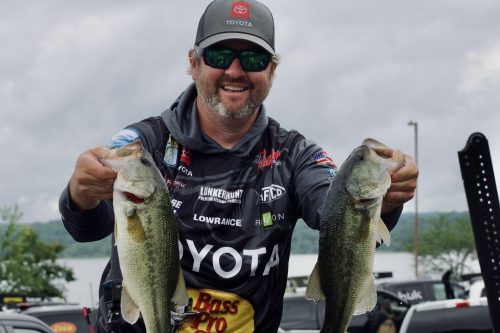
Team Toyota pro Matt Arey was one such pro who caught dozens of fish enroute to his 13-10-lb. bag of fish that had him sitting in 31st place.
“I never got a big bite but man I caught a lot of fish today,” Arey said. “I flipped bushes most all of day one and probably boated close to 30 keepers. All three species, too. You can’t beat flipping into a bush and catching a smallmouth… sure, this lake is small, comparatively, but it’s a lot of fun and full of fish.”
Limits across the board, fish of all three species, a variety of patterns, and super tight weights keeping anglers from 1st to 101st within striking range. Sounds like a pretty good lake to have a tournament.
Another redeeming quality of this fishery that can’t be overstated is the stunning beauty of Tenkiller and the rolling hills that surround it. Even with rainy, inclement weather the first two days this area has impressed with its picturesque aesthetic.
Remarking on the main criticism of Tenkiller, it’s smaller than usual size, I would argue that this is actually a good thing for bass fishing fans watching this event. It’s common for this fishery to host 100 to 200 boat local tournaments, much like many major bass fisheries in the south.
These regional and local anglers have to deal with fishing pressure and a plethora of boats every time they jump into a weekend tournament. They know all-too-well the negatives of getting in a bad rotation when fishing shallow or having to wait for another boat to vacate an offshore spot before slipping in to make a cast.
Managing a myriad of boats and fishing pressure is a reality of most club tournaments. Elite pros should have to grapple with these same elements. It’s relatable and refreshing to see from a fans’ standpoint.
“I think whoever wins this tournament had no idea going into day one,” Toyota Bonus Bucks pro Cody Huff offered. “You can learn a lot in practice, but fishing pressure is something that has to play out during the tournament.
“Not to mention, with the fluctuating water levels we’re faced with this week, the leading pattern is likely going to change. Heck, if you’re fishing shallow to start the event, the cover you’re casting at is likely going to be dry by the weekend.”
To excel in this tournament anglers will have to adapt every single day, adjusting in real time to stay with groups of fish and outmaneuver their peers. All these factors and nuances have set this weekend up to be The Thrilla at Lake Tenkilla, a heavyweight battle of changing conditions and decision making. May the best man win.
Loberg junk fishes his way to Day 1 lead at Lake Tenkiller

TAHLEQUAH, Okla. — On a lake where the only constant seems to be change, Andrew Loberg took advantage of the conditions on Day 1 of the Lowrance Bassmaster Elite at Lake Tenkiller.
The California native caught a five-bass limit weighing 17 pounds, 9 ounces to lead the field after one day of competition on the eastern Oklahoma reservoir. He holds an 8-ounce advantage over second-place Trey McKinney. Wisconsin’s Bob Downey is third with 16-2.
Lake Tenkiller has fluctuated greatly thanks to heavy rains that spread over the area ahead of official practice. From the final day of practice on Tuesday to the start of Day 1, the water fell several feet and anglers were forced to scramble to adjust.
The field of 101 anglers adjusted well, however, as each pro landed a limit, with 90 of those limits weighing over 10 pounds. Mixed bags of smallmouth and largemouth crossed the scales, but it was Loberg's bag of largemouth that led the way.
“I think the conditions played really well for me,” he said. “I think the low pressure system helped the big largemouth eat a little bit better than other stuff going on.”
While this is his first tournament at Lake Tenkiller, Loberg has shown early in his Bassmaster career he’s comfortable in Oklahoma. During the 2024 St. Croix Bassmaster Opens presented by SEVIIN season, Loberg notched a second-place finish down the road at Lake Eufaula.
Loberg isn’t dialed in necessarily. He has 30 rods on the front deck of his bass boat and is testing both offshore and shallow patterns. On Day 1, the shallows won out as he caught all largemouth.
“It was 50/50 between shallow and deep,” he said. “It is a timing thing, for sure. There are so many boats hitting the same stuff and I think I got lucky and pulled up on the right stretch at the right time. There were boats all over the place.”
The day didn’t start particularly quickly for Loberg as he felt out the lake in the morning. But as the morning progressed, he discovered a productive pattern that produced most of his final tally.
“I ran with it until I reached my limit,” Loberg said. “Honestly, all day I was really trying new stuff and seeing what was going on. With how much things are changing, I want to eliminate water and see what’s happening.”
With how much the lake is changing, Loberg said he isn’t set on doing one thing.
“I’m going to keep an open mind like I did today,” Loberg said. “This place is just changing so much. You have to have a couple things going on, because I don’t think one thing can take you four days.”
McKinney finished Day 1 with a mixed bag weighing 17-1, which included four largemouth and a smallmouth. The Carbondale, Ill., Progressive Bassmaster Elite Series pro started the morning shallow, but did the majority of his damage on two or three offshore areas. In about a 30 minute flurry, McKinney caught his initial limit which weighed about 15 pounds.
After testing more shallow cover, McKinney went back offshore and culled up to his final weight.
“I really didn’t even hit some of my good stuff today,” he said. “I still have some tricks up my sleeve. I left them about half way through the day. I didn’t want to be greedy. This place is tough and small, I didn’t want to catch fish I would need tomorrow. I played a little defense.”
Conditions changed around McKinney several times throughout the day. When the lake got choppy, he saw the bite improve. Thunderstorms moved through late morning, which shut down his bite for a while. Only one other angler shared water with McKinney on Day 1.
“Overall, I had a lot of stuff to myself,” he explained. “A lot of people probably fished it, but not at the same time as I did. A lot of stuff I’m fishing isn’t getting as pressured as I thought.”
On Day 2, McKinney plans on leaning on his areas a little bit harder than he did on the first day. As the tournament progresses, he believes the more consistent bite will be the offshore bite, but the shallows may produce the bigger bites.
Opelika, Ala., pro Kyle Welcher landed a 4-10 on Day 1, claiming Phoenix Boats Big Bass of the Day honors.
The full field of anglers will launch from Chicken Creek Boat Ramp beginning at 6:30 a.m. CT and will return for weigh-in at 2:30 p.m. The Top 50 anglers after Day 2 will advance to Semifinal Saturday in hopes of cracking the Top 10 and qualifying for Championship Sunday. Day 3 and 4 weigh-ins will be held at Cherokee Casino in Tahlequah.
Bassmaster LIVE coverage of the Lowrance Bassmaster Elite at Lake Tenkiller will be available on Bassmaster.com Days 1 and 2 starting at 8 a.m. ET and ending at 3 p.m. FS1 will carry the morning action on Day 3 from 8 a.m. to 11:30 a.m. before heading over to Bassmaster.com in the afternoon. Day 4 can be seen on FS1 from 8 a.m.-Noon with afternoon action to follow on FOX from Noon-3 p.m.
The Lowrance Bassmaster Elite at Lake Tenkiller is being hosted by the Oklahoma Ozarks Tourism Association.
2025 Bassmaster Elite Series Platinum Sponsor: Progressive, Toyota
2025 Bassmaster Elite Series Premier Sponsors: Bass Pro Shops, Dakota Lithium, Humminbird, Mercury, Minn Kota, Nitro Boats, Power-Pole, Progressive Insurance, Ranger Boats, Rapala, Skeeter Boats, Yamaha
2025 Bassmaster Elite Series Supporting Sponsors: AFTCO, Daiwa, Garmin, Lew's, Lowrance, Triton Boats, VMC, Yokohama
About B.A.S.S.
B.A.S.S., which encompasses the Bassmaster tournament leagues, events and media platforms, is the worldwide authority on bass fishing and keeper of the culture of the sport, providing cutting-edge content on bass fishing whenever, wherever and however bass fishing fans want to use it. Headquartered in Birmingham, Ala., the organization’s fully integrated media platforms include the industry’s leading magazines (Bassmaster and B.A.S.S. Times), website (Bassmaster.com), TV show, radio show, social media programs and events. For more than 50 years, B.A.S.S. has been dedicated to access, conservation and youth fishing.
The Bassmaster Tournament Trail includes the most prestigious events at each level of competition, including the Progressive Bassmaster Elite Series, St. Croix Bassmaster Opens Series presented by SEVIIN, Mercury B.A.S.S. Nation Qualifier Series presented by Lowrance, Strike King Bassmaster College Series presented by Bass Pro Shops, Strike King Bassmaster High School Series, Bassmaster Junior Series, Bassmaster Team Championship, Newport Bassmaster Kayak Series presented by Native Watercraft, Bassmaster College Kayak Series, Yamaha Bassmaster Redfish Cup Championship presented by Skeeter and the ultimate celebration of competitive fishing, the Bass Pro Shops Bassmaster Classic presented by Under Armour.
MLF Unveils Dates for 2025 Team Series, Teams for Challenge Cup and Heritage Cup Events
Like 2024, the 2025 MLF Team Series Presented by Bass Pro Shops is comprised of four Cup events, each featuring two-man teams of Bass Pro Tour anglers competing from the same boat and working together to claim part of a season purse of more than a half of a million dollars.
Each minute of competition from the 2025 MLF Team Series will be livestreamed daily, meaning every cast and every catch will be covered live and fans can watch as teammates work together to break down a brand new body of water in real time.
Each MLF Team Series Cup event will feature 12 two-man teams, divided into three groups as they enter the one-day Elimination Rounds. The top two teams from each of the three Elimination Rounds will advance to the Knockout Rounds on Days 4 and 5. The top two teams from each Knockout Round will then move on to the Championship Round on Day 6, where the final four teams compete for the Cup Championship.
In keeping with traditional MLF Cup protocols, the host city is not revealed to Team Series anglers until one month prior to each event. All fishable waters within 60 miles of that city then become off limits to anglers, and the competitors will discover where they’re competing only after arriving at the boat ramp on the morning of competition. Fans watching the MLFNOW! livestream will find out the fishery right along with the anglers and watch all the action unfold live as teams work together and share their knowledge to break down each fishery in real time.
The dates for the 2025 MLF Team Series are:
- Challenge Cup: Aug. 24-29, 2025
- Heritage Cup: Sept. 14-19, 2025
- Patriot Cup: Oct. 22-27, 2025
- Summit Cup: Nov. 16-21, 2025
The first MLF Team Series draft of 2025 took place last week in conjunction with the Bass Pro Tour Lowrance Stage 5 Presented by Mercury at Kentucky Lake, where 24 team captains – based on the 2025 Fishing Clash Angler of the Year (AOY) standings after the first three Bass Pro Tour events – drafted a teammate. Those 24 teams will compete in the first two events, the Challenge Cup (Aug. 24-29) and the Heritage Cup (Sept. 14-19).
The 12 teams that will compete in the Challenge Cup, Aug. 24-29 are:
Jeff Sprague, Wills Point, Texas
Bryan Thrift, Shelby, N.C.
Team #2:
Jacob Wall, New Hope, Ala.
Bobby Lane, Lakeland, Fla.
Team #3:
Alton Jones Jr., Waco, Texas
Alton Jones, Lorena, Texas
Team #4:
Michael Neal, Dayton, Tenn.
Andy Morgan, Dayton, Tenn.
Team #5:
Brent Ehrler, Redlands, Calif.
Justin Lucas, Guntersville, Ala.
Team #6:
Mark Davis, Mount Ida, Ark.
Gary Klein, Mingus, Texas
Team #7:
Keith Carson, DeBary, Fla.
Luke Clausen, Spokane, Wash.
Team #8:
Dean Rojas, Lake Havasu City, Ariz.
Josh Bertrand, Queen Creek, Ariz.
Team #9:
Jake Lawrence, Paris, Tenn.
Colby Miller, Elmer, La.
Team #10:
Adrian Avena, Vineland, N.J.
Dustin Connell, Clanton, Ala.
Team #11:
Anthony Gagliardi, Prosperity, S.C.
Jeremy Lawyer, Sarcoxie, Mo.
Team #12:
Edwin Evers, Talala, Okla.
Skeet Reese, Auburn, Calif.
Ron Nelson, Berrien Springs, Mich.
Martin Villa, Charlottesville, Va.
Team #2:
Justin Cooper, Zwolle, La.
John Hunter, Shelbyville, Ky.
Team #3:
Nick LeBrun, Bossier City, La.
Marty Robinson, Lyman, S.C
Team #4:
James Elam, Tulsa, Okla.
Gerald Spohrer, St. Francisville, La.
Team #5:
Drew Gill, Mount Carmel, Ill.
Marshall Robinson, Landrum, S.C.
Team #6:
Matt Becker, Ten Mile, Tenn.
Spencer Shuffield, Hot Springs, Ark.
Team #7:
Cole Floyd, Leesburg, Ohio
Nick Hatfield, Greeneville, Tenn.
Team #8:
Ott DeFoe, Blaine, Tenn.
Andy Montgomery, Blacksburg, S.C.
Team #9:
Jacob Wheeler, Harrison, Tenn.
Mark Daniels Jr., Tuskegee, Ala.
Team #10:
Terry Scroggins, San Mateo, Fla.
Casey Ashley, Donalds, S.C.
Team #11:
Zack Birge, Blanchard, Okla.
Keith Poche, Pike Road, Ala.
Team #12:
Todd Faircloth, Jasper, Texas
Jared Lintner, Covington, Ga.
At Stage 7, 24 new team captains, based on AOY rankings from Stages 4-6, will draft a teammate for the final two Team Series events, the Patriot Cup (Oct. 22-27), and the Summit Cup (Nov. 16-21).
The MLFNOW!® broadcast team of Chad McKee and J.T. Kenney will break down the extended action live every day of competition during the 2025 MLF Team Series. MLFNOW!® is livestreamed on MajorLeagueFishing.com, the MLF and MyOutdoorTV (MOTV) apps and on Rumble.
Each MLF Team Series episode will air on Outdoor Channel as six two-hour original episodes each Saturday afternoon starting in Q1 of 2026. The complete television schedule will be posted at MajorLeagueFishing.com.
Proud sponsors of the 2025 MLF Team Series include: Abu Garcia, B&W Trailer Hitches, Barbasol, Bass Boat Technologies, Bass Pro Shops, Berkley, E3 Sport Apparel, Epic Baits, Ferguson, Knighten Industries, Kubota, Lowrance, Lucas Oil, Mercury, NITRO Boats, Onyx, Power-Pole, Ranger Boats, Rapala, Smokey Mountain Herbal Snuff, Star brite, Toyota, YETI and Zenni.
For complete details and updated information on the MLF Team Series visit MajorLeagueF
About Major League Fishing
Major League Fishing (MLF) is the world’s largest tournament-fishing organization, producing more than 250 events annually at some of the most prestigious fisheries in the world, while broadcasting to America’s living rooms on CBS, Discovery Channel, Outdoor Channel, CBS Sports Network, World Fishing Network and on demand on MyOutdoorTV (MOTV). Headquartered in Benton, Kentucky, the MLF roster of bass anglers includes the world’s top pros and more than 30,000 competitors in all 50 states and 20 countries. Since its founding in 2011, MLF has advanced the sport of competitive fishing through its premier television broadcasts and livestreams and is dedicated to improving the quality of life for bass through research, education, fisheries enhancement and fish care.
Tenkiller Expectations with Logan Parks and Cody Huff
Courtesy of Dynamic Sponsorships/Photos: Bassmaster
Prior to starting practice this week for the 2025 Lowrance Bassmaster Elite at Lake Tenkiller, the last time Cody Huff and Logan Parks saw this pond was for the 2018 Bassmaster College Series National Championship. Huff and his partner Garrett Enders, who attended the collegiate fishing powerhouse Bethel University, won that event with a three-day total of 41-6.
Parks and his partner, fishing for another college fishing staple of Auburn University, had a tough day one but bounced back on day two, ultimately finishing in the top 30. That tournament proved pivotal for both future Elite Series pros, as it helped to lay the groundwork that would one day propel them to compete at the highest level of the sport.
“What I remember most about that tournament was how hot it was,” Huff recalled, and Parks agreed. “It was late July, there was no wind, and I think the real feel was 112 degrees. It was brutal.”
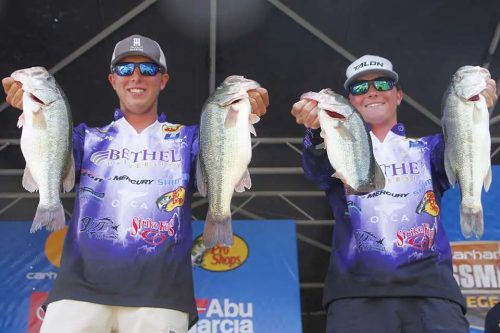
Huff and Enders capitalized on a similarly hot marina bite during that tournament while Parks targeted schooling fish to success on day two. Lake Tenkiller is proving to be a whole different can of worms this time around for Huff, Parks, and the rest of the Elite Series field.
It’s been a prolonged spring in eastern Oklahoma this year and the past few weeks there has been a lot of rain in the Tahlequah area. This added inflow has caused flooded conditions on Tenkiller and surrounding fisheries, while the Army Core of Engineers continues to pull water as fast as possible, creating a literal ebb and flow on this fishery right now.
Water level was at the front of the Elite Series fields’ mind before competition began this morning as the fluctuation can throw both fishermen and the fish a curveball.
We will see anglers have to adapt with the conditions this week, changing their techniques and presentations as the tournament unfolds. Parks and Huff agreed as they looked out over Lake Tenkiller from their Air BnB perched in the Ozark Mountains.
We caught up with the former college fishing standouts and Toyota Bonus Bucks members for their expectations on Lake Tenkiller for the seventh stop of the 2025 season.
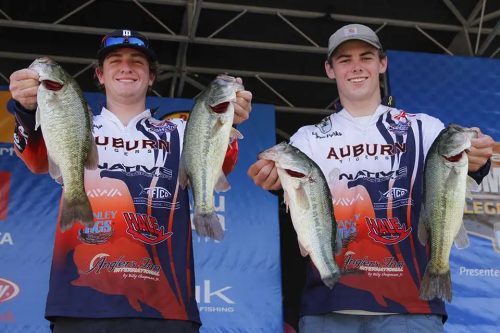
Q - With water level fluctuations being a main talking point, what percentage of the fish weighed in this week will be caught shallow vs offshore?
Huff – “I’d would say 60% shallow and 40% deep. The shallow bite should be strong to start but if they keep pulling water I think the offshore bite will start to shine.”
Parks – “I think it’ll be a solid mix. Probably like 60% shallow and 40% offshore, but the deep fish will be better quality.”
Q – What are three lures or techniques you believe will play a major role on Lake Tenkiller this week?
Huff – “There is a lot going on right now, both shallow and deep. I’d say the three main deals will be flipping flooded cover, using FFS with a minnow, and my wildcard would be a spinnerbait.”
Parks – “I think a jig will play a big role, flipping bushes and docks and what not. A drop shot and then some kind of topwater, like a Berkley Bullet Pop.”
Q – Grammy award winning country music superstar Carrie Underwood’s alma mater is Northeastern State University in Tahlequah, Oklahoma, where the Bassmaster Expo will be held this week. If you had to characterize your practice and tournament expectations for Lake Tenkiller using a Carrie Underwood song title, which song would you choose?
Huff – “Logan took the only other song I know, so I’m going to say Before he Cheats. And thankfully that’s not really something I have to worry about because of B.A.S.S.’s increased polygraphs.”
Parks – “No doubt Jesus, Take the Wheel, except I’m changing it to Jesus, Take the Reel.”
Q – How much weight per day do you expect it to take to make Championship Sunday this week?
Huff – “I think fourteen and change will get you a top 10. Fourteen pounds per day.”
Parks – “Fifteen pounds per day should be strong.”
RLVNT Adds Frame to Hi-Tech Fishing/Hunting Sunglasses Family
|
Designed to cover more of the face while still looking good, anglers and hunters are hot for BUCK |
|
FINLAYSON, MN (June 11, 2025) – True to their name which means “Solving Real Life Vexes with New Technology,” Minnesota-based hi-tech sunglasses manufacturer, RVLNT, is proud to introduce another frame style to its current collection of 13 unique frames. RVLNT’s BUCK is a sturdy, hardworking frame with maximum coverage. Sitting snugly on the wearer’s face, this dynamic frame will block sunlight from all angles. With its thick, durable arms and large wrap lenses, BUCK is sure to be your new favorite sunglasses for all your outdoor adventures. |
|
BLACK FRAME (Shown with Concealment Lens Technology) |
|
BIRCH FRAME (Shown with Concealment Lens Technology) |
|
TORTOISE FRAME (Shown with Concealment Lens Technology) |
|
“We’ve had stellar feedback on this new frame style,” said RLVNT Sales Director, Pat Kalmerton. “It’s designed to keep out light from all angles but still look good on the face. For fishing or hunting, the beta versions we sent out prior to full launch were well received for sharpening up the fishing and hunting experiences while maintaining a fresh, cool look.” “Plus, our glasses are way more than polarized. All lenses are made of Trivex, as opposed to the scratch collecting properties of polycarbonate. Trivex has the same optical clarity as the human eye, significantly lighter, and shatter-resistant.” Originally developed for the military, Trivex is a stronger, lighter, clearer, and overall, far superior lens material to polycarbonate. Trivex is also resistant to chemicals and offers better light refraction than polycarbonate. While Trivex lenses may be more expensive, the clarity, safety features, and built-in UV protection make RLVNT’s sunglasses a worthwhile investment. Kalmerton concluded: “At the end of the day, BUCK caters to those who want a bigger, somewhat boxier frame that doesn’t let in sunlight from the sides and creates a large viewing area when worn. It fits in nicely with our other frames, offering something a lot of anglers and hunters want – basically bigger wrapping lenses and wider, taller, and comfortable arms.” BUCK is available in three frame colors: Grey, Birch, and Tortoise, as well as Brown, Grey, or Chameleon lenses with ScreenVu™, the latter which not only adjusts in shade to light intensity, but provides the wearer with crisp, crystal-clear views of today’s sophisticated fishing electronics or your cell phone while maintaining the benefits of a polarized lens for seeing into the water. |
|
|
RLVNT’s Chameleon lenses with ScreenVu™ provides crisp, crystal-clear views of today’s sophisticated fishing electronics or your cell phone while maintaining the benefits of a polarized lens for seeing into the water. |
|
How do you pick the best BUCK version for your situation and use? First, you need to choose your base lens color, which can be Brown, optimized for enhancing warm colors in low light, cloudy or shady environments. Grey is great for bright sunshine and reducing brightness without affecting the color balance. The third option is the company’s most popular—Chameleon, which is light adapting for all-day adventures and features ScreenVu™ for clearly and crisply representing digital device screens. |
|
SUNFIRE MIRROR Lens Technology |
|
SMOKE MIRROR Lens Technology |
|
CONCEALMENT Lens Technology |
|
Second, it’s time to pick the mirror style that meets your adventure. BUCK is currently available in eight finishes.
BUCK is also available in Single Vision or Progressive digital prescription types. TAKE HOME So RLVNT has done it again with BUCK, and just in time for showing off at ICAST 2025 in Orlando, Florida, where they will be exhibiting at Booth 4438. Sign up here now to set a time to see the entire RLVNT lineup and talk with the tech-heads whose goal is to give all outdoors enthusiasts an edge! Try on a pair and we know you’ll be impressed! |
|
|
RLVNT’s Chameleon lenses with ScreenVu™ self-adjust shading to the available ambient light. As a result, the lenses also perform at dawn, dusk, and during overcast conditions. |
|
ABOUT RLVNT was founded by Norm and Adam in 2018, two friends from the optical industry who loved the outdoors and wanted sunglasses tailormade for their environments. The problem? That technology didn’t exist. And what’s more, other outdoor enthusiasts had great ideas but weren’t being heard. RLVNT became the solution to these problems as a company committed to listening to the community and solving Real-Life Vexes with New Technology. From inception to becoming a leading outdoor brand, RLVNT’s commitment to quality and science-based solutions shines through. |
Vexus® pro Kyle Cortiana: “I’m living my dad’s dream.”
Carl Cortiana is about to turn 70, but he still remembers the days four decades ago when he’d cast a practice plug across the living room floor and his toddler son, Kyle, now a highly accomplished Vexus pro on the MLF Toyota Series, would pounce on it like a feisty largemouth.
“Much like Kyle, I too dreamed of being a professional bass fisherman when I was a young man, but like a lot of guys, fatherhood, work, and home life took a more important precedence than being gone from home and spending money I didn’t have to chase a dream,” says the always joyful and perspective-rich Cortiana.
With zero bitterness, Carl made sure to provide young Kyle the chance to be a seasoned pond hopper on every small accessible body of water they could explore around Tulsa and Broken Arrow, OK, long before he went to kindergarten.
“I don’t think Kyle was even 3-years old when he caught his first bass on a Texas-rigged worm, and we’ve been chasing fish together ever since,” smiled Carl while sharing a day on Lake Guntersville recently in Kyle’s Vexus.
As a 2-time Toyota Series Angler of the Year, a 2-time Toyota Series tournament champion, with several Top 10 finishes in the 100 MLF events he’s competed in, it’s fair to say the 42-year old former pond hopper was destined to catch fish for a living, despite having a civil engineering degree in his hip pocket from Oklahoma State University.
“Kyle’s obviously turned out to be one heck of an angler, he’s indeed living the dream I once had, but first and foremost I’m most proud of the fact he’s a kind, thoughtful, super determined, young man. I’m proud to be his dad,” reflects the elder Cortiana, a mostly retired machinist, who travels from Oklahoma to join Kyle and Miranda somewhere ‘on tour’ each year.
Sometimes it’s Guntersville, on other occasions it’s been the St. Lawrence River, NY. He’d like to make it to more events in the future, but they’re always sure to talk on the phone at least three times a week.
“I’ve been a bad fisherman my whole life,” laughs Carl. “But I’ve learned a lot from my son – especially how effective the drop shot rig is.”
Perhaps no catch was more meaningful however than a 10-pounder Kyle guided his dad to in 2014 back home in Oklahoma. “My mom had just died, and Kyle and Miranda weren’t about to let me spend Thanksgiving alone. So, we went to dinner at Miranda’s family’s home near Ardmore, and that afternoon we went fishing. That 10-pound 12 ounce fish proved to be the biggest bass of my nearly 70-years on earth, and I’m convinced it was Heaven-sent as a sign from Mom to keep living life,” reflects Cortiana.
Carl Cortiana has kept living life indeed. His cup is full these days, having a cushy front row seat in his son’s Vexus to vicariously live-out the dreams he had in the 1980s of catching bass for a living.
The numerous trophies prove Kyle Coritana’s success, but perhaps more importantly is the fact he had a dad who was wise enough to know he might be starting something awfully special when Kyle first pounced on that rubber practice casting plug in the family living room.
Feider and Cox: bologna sandwiches and minimal FFS at Tenkiller
Vexus pros Seth Feider and John Cox call Minnesota and Florida home. But both love the shallow water fishing in Oklahoma, especially this week with the high-water flooding lots of shoreline habitat at the Bassmaster Elite Series event on Lake Tenkiller. Oh, and the BBQ and bologna sandwiches are pretty good too.
We caught up with the two highly accomplished, down-to-earth pros, for a fast Q & A, on the eve of competition.
Q: Are you excited about Tenkiller’s lake level being 5+ higher than normal?
Feider: Absolutely! If it were at normal pool it would be a totally offshore deal, but I truly believe this derby can be won shallow.
Cox: Yes! If the water level was low, it’d be way tougher on me.
Q: What percentage of the time do you anticipate using forward-facing sonar in this event?
Feider: If the water stays in the bushes – 0%. If it falls drastically, then maybe 20% at the most.
Cox: 0%
Q: What’s the best meal you’ve had since arriving at Tenkiller?
Feider: I’m still waiting on it, because we tried to eat at Roxie’s BBQ, but they had just run out of meat. It smelled so good! So, we’re definitely going back to try again.
Cox: Oh my gosh! The bologna, cheese, mustard and pickle sandwich my roommate Brandon Lester made us for lunch was amazing! I told my mom it took me right back to memories of elementary school.
Q: What do you love most about being part of Team Vexus?
Feider: The people. Everybody I’ve met has been so cool, and they build a phenomenal boat, man.
Cox: Being able to talk to the factory leaders as though they’re my best buddies.
Q: What will your average daily weight need to be to score a Top 10 at Tenkiller?
Feider: 16 or 17 pounds
Cox: 17 pounds
Kristine Fischer Previews Lake Tenkiller Elite
Courtesy of Dynamic Sponsorships / Photos: Bassmaster
Kristine Fischer added to her impressive kayak fishing accomplishments when she won the Newport Bassmaster Kayak Series at Lake Tenkiller presented by Native Watercraft last week. Fischer now has victories in three different national kayak tournament trails and has helped to make kayak fishing cool, amassing a huge following on social media and beyond in the process.
Fischer is one of the most decorated kayak anglers in the country but this year she’s stepped out of her comfort zone, competing in Bassmaster Opens and Lady Bass Angler Association (LBAA) tournaments out of her Ranger boat. The Team Toyota pro already notched an LBAA win out of her bass boat on Lake Seminole earlier in the year and now has her first Bassmaster Kayak Series title.
“It was such a whirlwind and I couldn’t be more grateful for my first Bassmaster win,” Fischer beamed. “I am not anti-FFS at all, but this win was extra special because I fished the way I love to. Skipping docks, flipping bushes and never having to even turn my electronics on. It was so much fun and definitely felt meant to be.”
Fischer is a BassmastHER ambassador and as good as she is on the water, perhaps her best work is done in supporting and inspiring women or inexperienced anglers to get outside and get their feet wet. Fishing, especially tournament fishing, can be intimidating but anglers like Fischer have done a great deal to help bust down barriers for folks who aspire to try their hand.
“It is my biggest dream that every single other woman out there can see this and believe that they can do this, too,” Fischer said. “I just want more story to help pave the way for future female Bassmaster Elite & Classic qualifiers.”
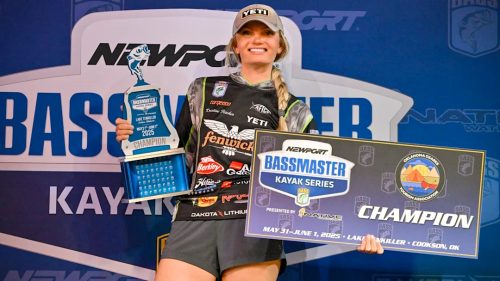
With the seventh stop of the Bassmaster Elite Series set to kick off tomorrow on Lake Tenkiller less than two weeks after Kristine’s big win, who better to preview this event and talk current conditions? According to Fischer, water level fluctuations will have a big impact on this tournament.
“The lake levels have been all over the place at Tenkiller the past few weeks,” Fischer explained. “When we started practice water was 8+ feet high, but by the end of the tournament it was only three feet high. I’ve kept my eye on the lake level this week and the Elites are going to experience similar conditions.
“The water was 7-feet high and rising to start practice for the Elites and they are pulling water again. It was just over 5-feet high the last time I looked. Because of these fluctuations I purposely stayed away from the backs of creeks and tried to focus on the mouths of creeks and steeper banks. It’s looking like the Elite guys might have to do the same.”
Fischer explained that she found a solid offshore bite in practice, catching fish at depths all the way down to 40+ feet, but she decided to fish her strengths and left the offshore bite to others. That decision proved fruitful as she used a variety of swimbaits like a Berkley Cull Shad to catch quality keepers around floating docks and then had a strong flipping bite around bushes and willow trees using a Texas-rigged Berkley Crud Craw on a 5/8-ounce weight.
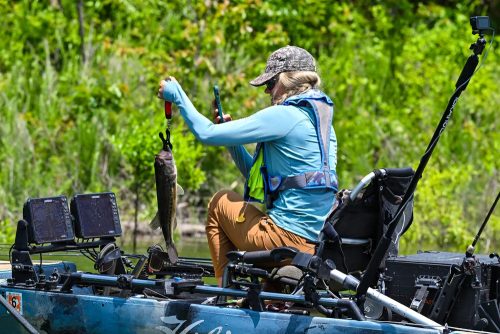
This one-two punch was enough to propel Fischer from second place on day one to the top spot by the end of day two. While Fischer believes Elite Series anglers will continue to capitalize on the shallow bite, she knows things are changing fast and expects to see a different side of Tenkiller shine.
“I expect the Elites to show out the deep bite on Tenkiller this weekend,” Fischer said. “The water has a lot of color to it but it’s mid-June, it’s hot, and a big population of fish will be offshore or moving offshore during the tournament. I think we’ll see a lot of 15-16-lb mixed bags of both largemouth and smallies. That makes for a fun tournament for the anglers and an exciting show for the fans!”
At just under 13,000 acres, Lake Tenkiller is on the small side in terms of Elite Series venues, but as Fischer alluded to, there are a myriad of ways to catch bass in this eastern Oklahoma reservoir. What Tenkiller lacks in size, it makes up for in number of fish and beauty.
Perched in the rolling hills and scenic bluffs near the western edge of the Ozark Mountains, this fishery is full of bass. Despite curveball conditions with regional flooding and lots of debris in the water, Fischer believes Tenkiller is poised to show out once again for the 2025 Lowrance Bassmaster Elite.
Bass Fishing Hall of Fame Announces Support for Eight Conservation Projects Across U.S.
SPRINGFIELD, Mo. – For Immediate Release – June 11, 2025 - The Bass Fishing Hall of Fame continues to prove its commitment to conservation by again granting a total of $40,000 to be dispersed among eight different bass fishing-related conservation projects. The efforts range from building live release boats for use at tournaments, to enhancing black bass habitat across the United States. When paired with additional funds raised by these recipients, the Hall of Fame grants will greatly enhance the likelihood of these projects being completed.
“With these latest grants, we’ll exceed $200,000 given in support of fishery enhancement projects over the past six years,” said BFHOF conservation committee chair Gene Gilliland. “These bass clubs have boots-on-the-ground members who donate their sweat equity to these projects, while the Hall of Fame’s Board provides financial support for building live release tournament boats, conservation-based youth fishing camps, fish stocking projects, habitat enhancement, and other needed gear to help make the projects a reality.”
The eight grantees receiving financial assistance from the Bass Fishing Hall of Fame under these most recent grants are:
- Bill Dance Signature Lakes Trail – an ongoing joint effort between the Tennessee Wildlife Resource Agency and the Tennessee B.A.S.S. Nation, along with help from high school anglers to continue enhancing habitat at select lakes across Tennessee.
- Fishing’s Future – Bass Anglers Start Early Family Fish Camp – (Texas and Indiana) – educational camps in both Texas and Indiana that emphasize environmental stewardship, including the establishment of fishing line recycling stations.
- Kansas B.A.S.S. Nation – to enhance habitat quality at Wilson Reservoir by building and submerging both natural and artificial habitat.
- Louisiana Fellowship of Christian Athletes Outdoors – hosting day camps for middle and high school anglers to teach ethical bass tournament competition behavior and environmental stewardship.
- New Mexico B.A.S.S. Nation Youth & Conservation – in cooperation with the New Mexico Dept. of Game and Fish, this group plans to purchase and stock bass at Ute Lake, NM, with post-stocking evaluation to follow in subsequent years.
- Northwest Arkansas Fish Habitat Alliance – a joint effort among high school students, the City of Fort Smith, Arkansas Game and Fish Foundation and MossBack Fish Habitat to build and deploy fish habitat in Lake Fort Smith.
- Ohio B.A.S.S. Nation – purchase and customize a tournament Live Release boat to be used at both youth and adult bass tournaments across Ohio for improved post-tournament survival and redistribution of tournament caught bass.
- Texas B.A.S.S. Nation Youth – improvements to current tournament Live Release trailer to give special attention to bass that appear compromised, and a roof to shade the primary holding tank, to keep it cooler.
“Between our conservation grants and scholarship program for students pursuing fishery management careers, the BFHOF Board-designated financial support we’ve provided to other fishing clubs and organizations over the past six years, and the recent enhancements we’ve made to the Hall’s venue within Johnny Morris’ Wonders of Wildlife Museum & Aquarium, we’ve contributed nearly $500,000 to support the Board’s mission of celebrating, promoting, and preserving the sport of bass fishing,” said BHFOF Board president John Mazurkiewicz. “We could not have done it without the support we receive from so many leading brands in the bass fishing industry, along with support from the many B.A.S.S. and MLF pro anglers who contribute to our fundraising efforts. We can’t thank them enough for the crucial role they play in the Hall’s mission.”
The Bass Fishing Hall of Fame will hold its annual induction ceremony and dinner on Thursday, Sept. 25, 2025 at Johnny Morris’ Wonders of Wildlife Museum and Aquarium in Springfield, Mo. It’s the culmination of ‘Celebrate Bass Fishing Week’ which also includes the Hall’s online silent auction (visit www.BassFishingHOF.com for details) to assist the Hall of Fame in funding its operations and future conservations projects such as these and other worthy endeavors benefiting the sport of bass fishing.
###
About the BFHOF -- The Bass Fishing Hall of Fame is a nonprofit organization led by a volunteer board of directors and is dedicated to celebrating, promoting and preserving the sport of bass fishing. Since 2017, the Hall’s inductees and memorabilia representing the history of bass fishing is showcased in Johnny Morris’ Wonders of Wildlife Museum and Aquarium in Springfield, Missouri, where it has rapidly become a popular destination. For more information about the Hall, its mission, and to become a supporting member, visit www.BassFishingHOF.com, or contact BFHOF executive director Barbara Bowman at bbowman@bassfishinghof.com.
Card hopes Tenkiller’s high water will turn his season around
Over the past 13 years, Vexus® Boats pro Brandon Card, has qualified for the Bassmaster Classic seven times. However, this year has been one of his most frustrating. Still, he was kind enough at the end of three long days of practice for the Lake Tenkiller Bassmaster Elite Series event to talk about why he’s struggled, and if the high-water levels might help turn his season around.
Q: The lake has risen roughly three feet since you guys started practice Sunday. It’s now 5+ feet above normal, to the point shoreline bushes, benches, grills, and campsites are flooded. Is that a good thing or a bad thing?
Card: It’s a good thing for shallow water anglers, and I’m in that category this week.
Q: You started this season with a great event on the St. Johns River in Florida, but you’ve had an atypically tough year since then. Why do you think that is?
Card: I don’t know. It’s a head scratcher. The only explanation is that I’m still trying to refine my forward-facing sonar skills. I do well with the technology on smallmouth, but largemouth are a different animal. At Hartwell and Fork I found myself with one foot on the shallow bite, and one foot on FFS, and you have to fully commit one way or the other.
Q: There’s an old saying in relation to the economy that ‘a rising tide lifts all boats.’ Will Tenkiller’s high water lift your Vexus to a Top 10 this weekend?
Card: Heck yea! My confidence is still good. I know where they’re living. I just have to adjust as the water level falls throughout this event.
Q: How many pounds will you have to average each day to score a Top 10?
Card: I’ll say 13 to 14-pounds a day will do really well here.
Q: What keeps a smile on Brandon Card’s face amid a tough season?
Card: I’m just blessed. The Lord has been so good to me. I have a great wife, a cool little boy named Davis, and a baby girl due in October. I see life’s bigger picture way better than I did early in my career when a bad tournament would devastate me.
James River Readies for Tackle Warehouse Invitational Stop 5 Presented by 7Brew Coffee
RICHMOND, Va. (June 10, 2025) – The fifth Major League Fishing (MLF) Tackle Warehouse Invitational event of the season is set to visit Richmond, Virginia, next week, June 20-22, on the James River – the Tackle Warehouse Invitational Stop 5 Presented by 7Brew Coffee.
The three-day Invitational tournament, hosted by Richmond Region Tourism, will feature professional bass anglers competing for a top prize of up to $115,000. Anglers will take to the river to catch their five biggest bass each day, and the winner will be determined by the heaviest three-day cumulative total.
“We’re proud to welcome Major League Fishing, their anglers and fans back to the Richmond Region for the upcoming Tackle Warehouse Invitational,” said Jerrine Lee, Vice President of Sales at Richmond Region Tourism. “Osborne Landing and the James River offer some of the best bass fishing in the country, and we’re excited for participants to experience everything that makes our outdoor scene so special. We look forward to a fantastic weekend on the water.”
Although MLF history on the James River was mainly limited to one-day Phoenix Bass Fishing League tournaments in the past, the last two pro-level events were a great example of what the river can produce over multiple days. Pro Nick LeBrun won the June 2022 Pro Circuit event with 17 pounds, 9 ounces on the final day, and he had 47-11 on the scale through three days. Last year, Skeet Reese won the Bass Pro Tour (BPT) event on the James, held in late June. The Bass Fishing Hall of Famer put up 23 bass for 54-3 on the final day to add another trophy to his already-packed trophy case.
In the Pro Circuit event, LeBrun did almost all his damage in the Chickahominy, though that event saw anglers utilize a lot of the river. Reese used the Chickahominy as well, but did most of his damage on the final day in the Appomattox, which is quite close to takeoff at Osborne Landing compared to the Chick.
Between the James and its tributaries, there are tons of options for the field in next week’s event. Expansive fields of spatterdock, cypress trees, docks, rip rap, brush and some submerged vegetation give anglers and bass plenty of choice. Given the time of year, fish should be postspawn and in summer patterns, and the fishing should be pretty good.
“The key is going to be finding where those big ones are,” said Jason Tibbetts of Centreville, Virginia, a second-year pro on the Invitationals and a local to the James. “The James has a lot of sneaky little areas, we have plenty of fishing area. It’s that guy that’s going to find that bigger than 2-pound average fish and really capitalize on that and possibly have a kicker – if you can go 18, 20 pounds each day, I think you’re going to do very well, if not win it.”
One of the big decisions on the James is where to fish, or, if you’re going to attempt to fish everywhere. Running the tide and hitting many areas on a long stretch of river is a tactic that local anglers tend to have a huge edge with. Alternatively, there are plenty of creeks and sections of the fishery where an angler could stay all day. But, the James is not the easiest fishery to navigate, and it is very spread out.
“It used to be the Chick was where you would go run,” Tibbetts said. “There were big fish, but with years and years and years of tournament fishing, they’ve kind of transported a lot of those big fish up to Osborne Landing. So now in that area you have a good chance of catching some big fish, but they are scattered, and they’ve got a lot of places to go.”
Last year, the Appomattox was key in the BPT event, and Tibbetts thinks it could play well again this time.
“The Chick will have the grass and the pads, but the Appomattox, which isn’t anywhere near the run to get to the Chick, is starting to get a lot of grass and pads in it as well. So that may be a big player,” he said. “People might overlook that. They’re thinking, ‘Oh, I’m going to run all the way down to the Chick.’ You run all the way down to the Chick, you don’t really have a lot of time to come back and hit the Appomattox. So, if you find fish in the Appomattox and they’re good fish, you’ve got a lot of fishing time.”
Anglers will launch at 6:30 a.m. ET each day from Osborne Landing, located at 9530 Osborne Turnpike in Richmond, Virginia. Weigh-ins will be held at the landing and will begin at 2:30 p.m. Fans are welcome to attend all launch and weigh-in events and also encouraged to follow the event online throughout the day on the MLFNOW!® live stream and coverage at MajorLeagueFishing.com.
The 2025 Tackle Warehouse Invitationals feature a field of professional anglers competing across six invitational tournaments around the country, for a total purse of $4.3 million and valuable Fishing Clash Angler of the Year (AOY) points to qualify for the Invitationals Championship, set for Sept. 5-7 on the Mississippi River in La Crosse, and a coveted spot on the MLF Bass Pro Tour – the sport’s premier circuit.
In Tackle Warehouse Invitationals competition, the full field competes in the two-day opening round on Friday and Saturday in a five-fish, weigh-in format. Only the top 30 pros, based on their two-day cumulative weight, advance to the final round on Championship Sunday, where they will compete for the grand prize of up to $115,000.
Forward-facing and/or 360-degree sonar is limited to only days 1 and 3 of competition. No forward-facing and/or 360-degree sonar will be allowed on day 2 of competition.
The MLFNOW! broadcast team of Chad McKee and Rob Newell will break down the extended action live all three days of competition from 7 a.m. to 2:15 p.m. ET. MLFNOW! will be live streamed on MajorLeagueFishing.com, the MyOutdoorTV (MOTV) app and Rumble.
Television coverage of the MLF Tackle Warehouse Invitationals Stop 5 at the James River Presented by 7Brew Coffee will air as a two-hour episode, premiering at 9 a.m. ET, on Saturday, Oct. 25 on CBS Sports Network.
Proud sponsors of the 2025 MLF Tackle Warehouse Invitationals include: 7Brew Coffee, Abu Garcia, Athletic Brewing, B&W Trailer Hitches, Berkley, Bubba, Deep Dive, E3 Sport Apparel, Epic Baits, Fishing Clash, Grizzly, Humminbird, Lew’s, Mercury, Minn Kota, Mossy Oak, Onyx, O’Reilly Auto Parts, Phoenix Boats, PirahnO2, Polaris, Power-Pole, Precision Sonar, Strike King, Suzuki Marine, Tackle Warehouse, T-H Marine, Toyota, VOSKER, WIX Filters and YETI.
For complete details and updated information visit MajorLeagueFishing.com. For regular Tackle Warehouse Invitationals updates, photos, tournament news and more, follow the MLF5 social media outlets at Facebook, Instagram and YouTube.
About Major League Fishing
Major League Fishing (MLF) is the world’s largest tournament-fishing organization, producing more than 250 events annually at some of the most prestigious fisheries in the world, while broadcasting to America’s living rooms on CBS, Discovery Channel, Outdoor Channel, CBS Sports Network, World Fishing Network and on demand on MyOutdoorTV (MOTV). Headquartered in Benton, Kentucky, the MLF roster of bass anglers includes the world’s top pros and more than 30,000 competitors in all 50 states and 20 countries. Since its founding in 2011, MLF has advanced the sport of competitive fishing through its premier television broadcasts and livestreams and is dedicated to improving the quality of life for bass through research, education, fisheries enhancement and fish care.
Anderson Fishes Shallow Grass for Win at Phoenix Bass Fishing League Event at Ross Barnett Reservoir
Madison’s Hendry Tops Co-Angler Division
BRANDON, Miss. (June 9, 2025) – Boater John Anderson of Bay Springs, Mississippi, caught a five-bass limit weighing 17 pounds, 3 ounces, Saturday to win the MLF Phoenix Bass Fishing League (BFL) Presented by T-H Marine on Ross Barnett Reservoir. The tournament, hosted by Visit Ridgeland, was the fourth event of the season for the BFL Mississippi Division. Anderson earned $3,531 for his victory.
This is Anderson’s second BFL win in as many seasons. And like last year, when he got the W on Lake Ferguson, Anderson gave his outboard a workout.
“I burned a lot of gas,” he said. “The last time I won, I did a whole bunch of running that day, too. I ran all over the lake.”
He kicked things off running far up the river to get away from the crowd.
“I caught a bunch of fish just fishing anything that looked good in front of me,” Anderson said. “Then later on in the day, I went out in the main lake to two known community holes and started throwing a frog in some windblown lily pads. I was able to secure two quality fish and didn’t think I had enough because I lost several big ones doing that.”
Anderson’s fears were nearly right, as he wound up getting the win by just 3 ounces over John Berry. He says not hooking fish in practice was an important strategy on a lake where “you can’t catch ’em two days in a row.” Instead, Anderson ran around listening for bluegills in grass, marking those areas to fish in the tournament.
“I keep it pretty simple up there,” he added. “I was throwing a frog and a swim jig on anything that was green touching the water.”
The top 10 boaters finished the tournament:
1st: John Anderson, Bay Springs, Miss., five bass, 17-3, $3,531
2nd: John Berry, Mt. Olive, Miss., five bass, 17-0, $1,535
3rd: Alfred Williams, Jackson, Miss., five bass, 15-13, $1,024
4th: Roger Stegall, Iuka, Miss., five bass, 15-10, $716
5th: Charles Watts, Corinth, Miss., five bass, 14-14, $614
6th: Hunter Briles, Russellville, Ala., five bass, 14-13, $563
7th: Blake Daugherty, Pope, Miss., five bass, 14-12, $512
8th: Shannon Denson, Brandon, Miss., five bass, 13-10, $461
9th: Timmy Ming, Louisville, Miss., five bass, 13-6, $409
10th: Barrett Saunders Hammond, La., five bass, 13-0, $858 (includes $500 Phoenix MLF Contingency Bonus)
Complete results can be found at MajorLeagueFishing.com.
Anderson caught a bass that weighed 6 pounds, 6 ounces, and earned the Berkley Big Bass Boater award of $360.
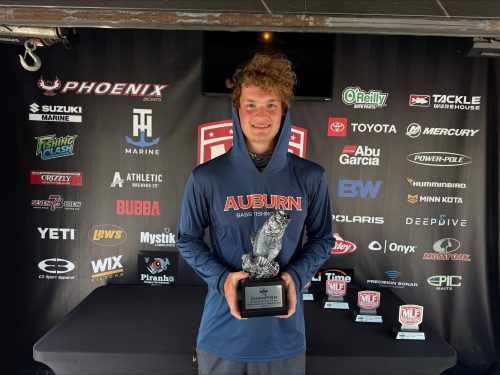
Davis Hendry of Madison, Mississippi, won the co-angler division and $1,535 Saturday, after bringing three bass to the scale that totaled 7 pounds, 11 ounces.
The top 10 co-anglers finished:
1st: Davis Hendry, Madison, Miss., three bass, 7-11, $1,535
2nd: Ryan Lecompte, Picayune, Miss., three bass, 7-8, $640
2nd: Lance Jackson, Starkville, Miss., three bass, 7-8, $640
4th: Finn Norsworthy, Brandon, Miss., three bass, 7-5, $358
5th: Cy Matlock, Crump, Tenn., three bass, 7-4, $307
6th: Thomas Russell, Clarksdale, Miss., two bass, 7-1, $281
7th: Daryl Powell, Leesville, La., three bass, 7-0, $243
7th: Isiah Kelly, Memphis, Tenn., three bass, 7-0, $243
9th: Reggie Thornton, Columbus, Miss., three bass, 6-15, $205
10th: Will Herrington, Brandon, Miss., three bass, 6-14, $229
Chris Mitchell of Millport, Alabama, earned the Berkley Big Bass co-angler award of $180, catching a bass that weighed in at 4 pounds, 8 ounces – the largest co-angler catch of the day.
After four events, Luke Glasgow of Guin, Alabama, now leads the Fishing Clash Mississippi Division Angler of the Year (AOY) race with 950 points, while Steve Hammack of Caledonia, Mississippi, leads the Fishing Clash Mississippi Division Co-Angler of the Year race with 909 points.
The fifth and final regular-season event for BFL Mississippi Division anglers will be held Sept. 27-28, at Pickwick Lake in Iuka, Mississippi. To register for the event as a boater or a co-angler, visit MajorLeagueFishing.com or call (270)-252-1000.
The top 60 boaters and co-anglers in the division based on point standings, along with the five tournament winners of each qualifying event, will qualify for the Oct. 10-12 BFL Regional tournament on Kentucky-Barkley Lakes out of Paris, Tennessee. Boaters will fish for a top award of a new Phoenix 819 Pro with a 200-horsepower Mercury or Suzuki outboard worth $50,000, while co-anglers will compete for a top award of $20,000.
The 2025 Phoenix BFL Presented by T-H Marine is a 24-division circuit devoted to weekend anglers, with 134 events throughout the season, five qualifying tournaments in each division. The top 60 boaters and co-anglers from each division, along with the five qualifying tournament winners, will advance to one of 12 BFL Regional tournaments where they are competing to finish in the top three, which then qualifies them for one of the longest-running championships in all of competitive bass fishing – the BFL All-American. The 2025 BFL All-American will take place May 29-31, 2025, at Lake Hamilton in Hot Springs, Arkansas, and is hosted by hosted by Visit Hot Springs and the Arkansas Department of Parks and Tourism.
Proud sponsors of the 2025 MLF Phoenix Bass Fishing League Presented by T-H Marine include: 7Brew, Abu Garcia, Athletic Brewing, B&W Trailer Hitches, Berkley, BUBBA, Deep Dive App, E3 Sport Apparel, Epic Baits, Fishing Clash, Grizzly, Humminbird, Lew’s, Li Time Batteries, Mercury, Minn Kota, Mossy Oak, Mystik Lubricants, Onyx, O’Reilly Auto Parts, Phoenix Boats, Polaris, Power-Pole, Precision Sonar, Strike King, Suzuki Marine, Tackle Warehouse, T-H Marine, Toyota, WIX Filters and YETI.
For complete details and updated tournament information, visit MajorLeagueFishing.com. For regular Bass Fishing League updates, photos, tournament news and more, follow MLF5’s social media outlets at Facebook, Instagram, and YouTube.
About Major League Fishing
Major League Fishing (MLF) is the world’s largest tournament-fishing organization, producing more than 250 events annually at some of the most prestigious fisheries in the world, while broadcasting to America’s living rooms on CBS, Discovery Channel, Outdoor Channel, CBS Sports Network, World Fishing Network and on demand on MyOutdoorTV (MOTV). Headquartered in Benton, Kentucky, the MLF roster of bass anglers includes the world’s top pros and more than 30,000 competitors in all 50 states and 20 countries. Since its founding in 2011, MLF has advanced the sport of competitive fishing through its premier television broadcasts and livestreams and is dedicated to improving the quality of life for bass through research, education, fisheries enhancement and fish care.
Hensley, Wilkinson Tie for Win at Phoenix Bass Fishing League Event on Ohio River at Rocky Point
Brownsburg’s Troyer Tops Co-Angler Division
CANNELTON, Ind. (June 9, 2025) – Boaters Todd Hensley of New Albany, Indiana, and Chris Wilkinson of Farmersburg, Indiana, each caught a five-bass limit weighing 11 pounds, 1 ounce, Saturday to tie for the win at the MLF Phoenix Bass Fishing League (BFL) Presented by T-H Marine on the Ohio River at Rocky Point. The tournament was the second event of the season for the BFL Hoosier Division. Hensley earned $3,416, which includes contingency prizes, while Wilkinson earned $2,916.
A couple heavy storms the day before the tournament had a big impact on both winners, muddying up waters and limiting where they could get bit.
“I didn’t fish the main Ohio River,” Hensley said. “I fished in the creeks, and I was just targeting large stumps that the bass are spawning on.”
In practice, Hensley located three creeks where he could get bit. He fished his primary area in the morning and caught all his keepers on a tube.
“After that, about noon, I went to other areas and they were just so blown out by the rain, there was just nothing to catch there,” he added.
For Wilkinson, it was basically the same.
“Everything I was wanting to do kind of went to the wayside and muddied up,” he said. “This morning I just kind of went fishing. I went to an area where I did have one or two bites in practice, and I caught one there pretty early and just kind of stuck it out through the day.
“All my fish came off of wood, either laydowns or stumps,” he added. “I caught two early on a Hook Some Bass spinnerbait. And the rest came on a Natural Forage Flapper Hog.”
This makes 52 top-10 finishes and 11 wins for Wilkinson in a BFL career spawning two decades.
“It took me 10 years to figure it out though,” he joked. “The first 10 didn’t count. It (winning) just makes me want to keep going for more. Whenever it’s not special is when I’ll be done. I don’t see that happening anytime in the near future.”
For Hensley, this is BFL win No. 4 and his 38th top-10 finish.
The top 10 boaters finished the tournament:
1st: Todd Hensley, New Albany, Ind., five bass, 11-1, $3,416
1st: Chris Wilkinson, Farmersburg, Ind., five bass, 11-1, $2,916
3rd: Jeffery Johnson, Austin, Ind., five bass, 9-8, $1,897 (includes $500 Phoenix MLF Contingency Bonus)
4th: Justin Berger, Murray, Ky., five bass, 9-3, $907
5th: Chris Leclere, Cannelton, Ind., five bass, 9-1, $778
6th: Kenny Hornsby, Goshen, Ohio, five bass, 9-0, $713
7th: Brandon Barker, Magnet, Ind., five bass, 8-6, $648
8th: Stacey Edwards, Milton, Ky., five bass, 8-4, $583
9th: Kevin Meunier, Lamar, Ind., five bass, 8-3, $519
10th: Brad Hostetler Jr., Franklin, Ind., five bass, 8-1, $454
Complete results can be found at MajorLeagueFishing.com.
Jeremy Johnson of Austin, Indiana, caught a bass that weighed 5 pounds, 2 ounces, and earned the Berkley Big Bass Boater award of $525.
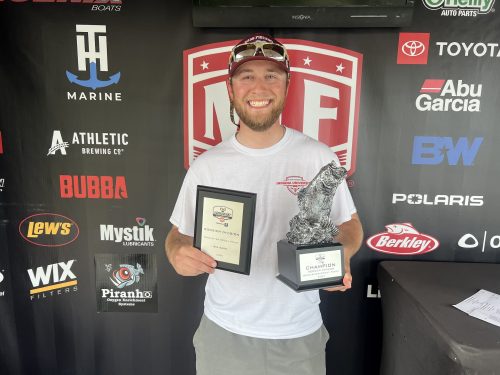
Adam Troyer of Brownsburg, Indiana, won the co-angler division and $2,206 Saturday, after bringing three bass to the scale that totaled 7 pounds, 13 ounces.
The top 10 co-anglers finished:
1st: Adam Troyer, Brownsburg, Ind., three bass, 7-13, $2,206
2nd: Mason Bohland, Noblesville, Ind., three bass, 5-14, $972
3rd: Martin Bryant, North Vernon, Ind., three bass, 5-8, $699
4th: Aaron Powell, Leitchfield, Ky., three bass, 5-6, $454
5th: Adam Lohr, Boonville, Ind., three bass, 5-5, $389
6th: Daniel Fromme, Jasper, Ind., three bass, 5-0, $356
7th: David Prater, Franklin, Ohio, three bass, 4-11, $324
8th: Charlie Kuebler, Jasper, Ind., three bass, 4-10, $292
9th: Stu Laughead, Vine Grove, Ky., three bass, 4-9, $243
9th: Dan Pardue, Morgantown, Ind., three bass, 4-9, $243
Troyer also earned the Berkley Big Bass co-angler award of $262, catching a bass that weighed in at 4 pounds, 11 ounces – the largest co-angler catch of the day.
After two events, Jamil Abdullah of Indianapolis, Indiana, now leads the Fishing Clash Hoosier Division Angler of the Year (AOY) race with 485 points, while Martin Bryant of North Vernon, Indiana, leads the Fishing Clash Hoosier Division Co-Angler of the Year race with 489 points.
The next event for BFL Hoosier Division anglers will be held June 28, at Lake Monroe in Bloomington, Indiana. To register for the event as a boater or a co-angler, visit MajorLeagueFishing.com or call (270)-252-1000.
The top 60 boaters and co-anglers in the division based on point standings, along with the five tournament winners of each qualifying event, will qualify for the Oct. 10-11 BFL Regional tournament on Kentucky-Barkley Lakes out of Paris, Tennessee. Boaters will fish for a top award of a new Phoenix 819 Pro with a 200-horsepower Mercury or Suzuki outboard worth $50,000, while co-anglers will compete for a top award of $20,000.
The 2025 Phoenix BFL Presented by T-H Marine is a 24-division circuit devoted to weekend anglers, with 134 events throughout the season, five qualifying tournaments in each division. The top 60 boaters and co-anglers from each division, along with the five qualifying tournament winners, will advance to one of 12 BFL Regional tournaments where they are competing to finish in the top three, which then qualifies them for one of the longest-running championships in all of competitive bass fishing – the BFL All-American. The 2025 BFL All-American will take place May 29-31, 2025, at Lake Hamilton in Hot Springs, Arkansas, and is hosted by hosted by Visit Hot Springs and the Arkansas Department of Parks and Tourism.
Proud sponsors of the 2025 MLF Phoenix Bass Fishing League Presented by T-H Marine include: 7Brew, Abu Garcia, Athletic Brewing, B&W Trailer Hitches, Berkley, BUBBA, Deep Dive App, E3 Sport Apparel, Epic Baits, Fishing Clash, Grizzly, Humminbird, Lew’s, Li Time Batteries, Mercury, Minn Kota, Mossy Oak, Mystik Lubricants, Onyx, O’Reilly Auto Parts, Phoenix Boats, Polaris, Power-Pole, Precision Sonar, Strike King, Suzuki Marine, Tackle Warehouse, T-H Marine, Toyota, WIX Filters and YETI.
For complete details and updated tournament information, visit MajorLeagueFishing.com. For regular Bass Fishing League updates, photos, tournament news and more, follow MLF5’s social media outlets at Facebook, Instagram, and YouTube.
About Major League Fishing
Major League Fishing (MLF) is the world’s largest tournament-fishing organization, producing more than 250 events annually at some of the most prestigious fisheries in the world, while broadcasting to America’s living rooms on CBS, Discovery Channel, Outdoor Channel, CBS Sports Network, World Fishing Network and on demand on MyOutdoorTV (MOTV). Headquartered in Benton, Kentucky, the MLF roster of bass anglers includes the world’s top pros and more than 30,000 competitors in all 50 states and 20 countries. Since its founding in 2011, MLF has advanced the sport of competitive fishing through its premier television broadcasts and livestreams and is dedicated to improving the quality of life for bass through research, education, fisheries enhancement and fish care.











